Eskişehir, Türkiye
Wednesday 17 July 2024

“When you have a cause, the best way to express yourself is artistically.“
Hani Abbas
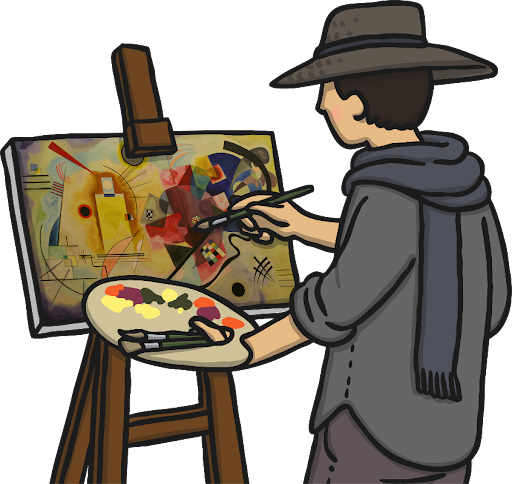
Art is the process or product of deliberately arranging elements in a way that appeals to intellect, sense or emotion.
It encompasses a diverse range of human activities, creations and modes of expression, including music and literature.
The meaning of art is explored in a branch of philosophy known as aesthetics.
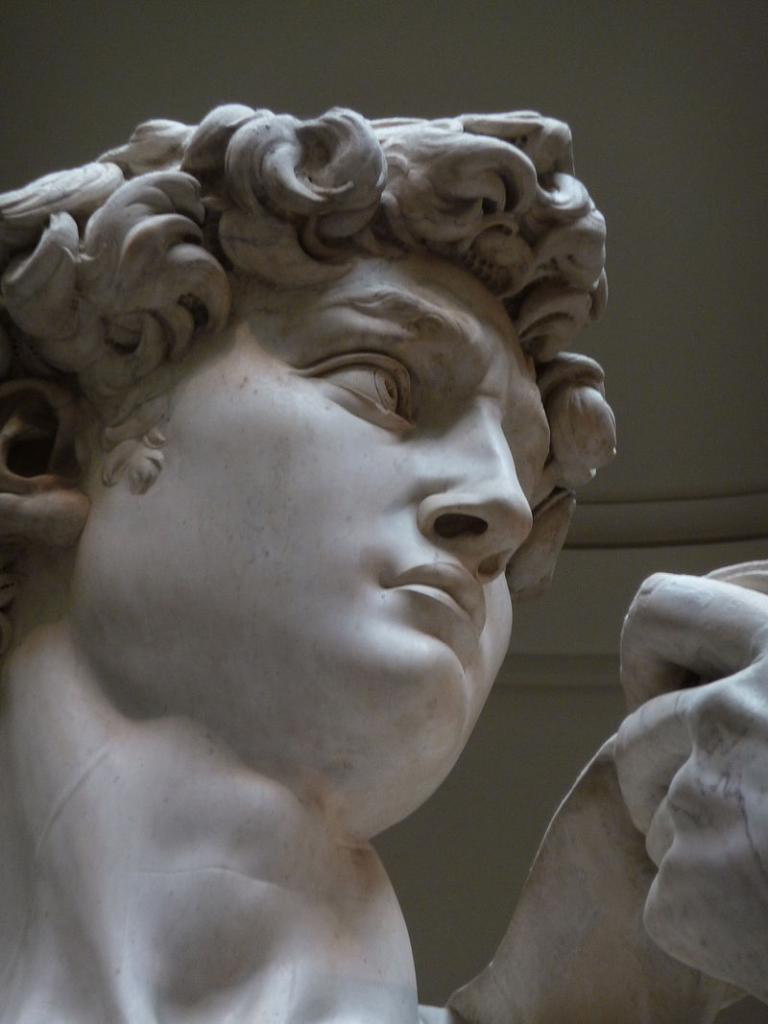
Above: Michelangelo’s David
“The arts are a wonderful medicine for the soul.”
Alfredo Arreguin
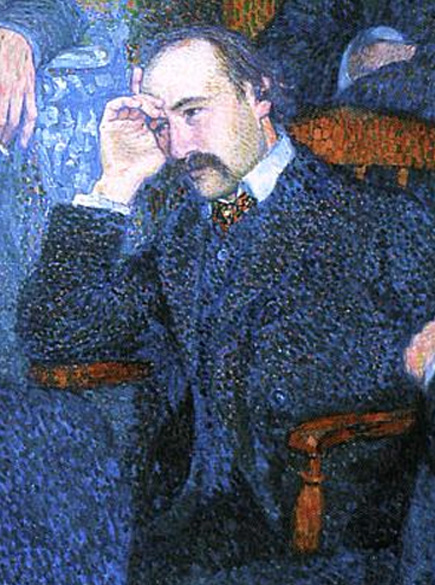
Above: Théo van Rysselberghe (1862 – 1926) painting
Ian Breakwell (1943 – 2005) was a world-renowned British fine artist.
He was a prolific artist who took a multimedia approach to his observation of society.
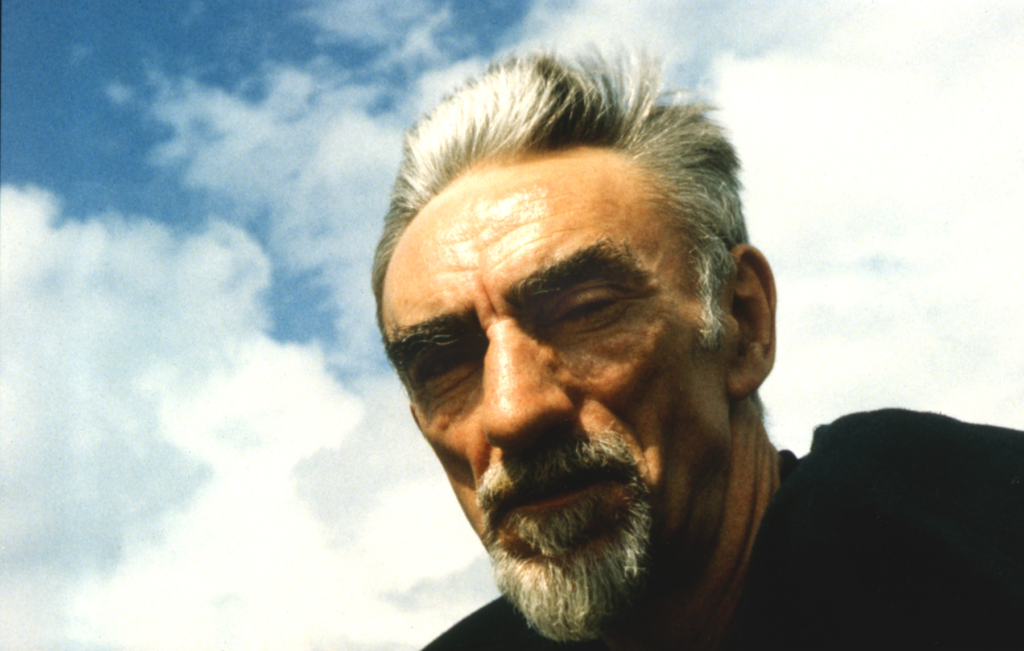
Above: Ian Breakwell
During the 1970s Breakwell worked with the Artist Placement Group (APG), a pioneering artists’ organisation founded in 1966.
It was a milestone in conceptual art in Britain, reinventing the means of making and disseminating art.
Ian Breakwell was represented by Angela Flowers Gallery from the early 70s to 1983.
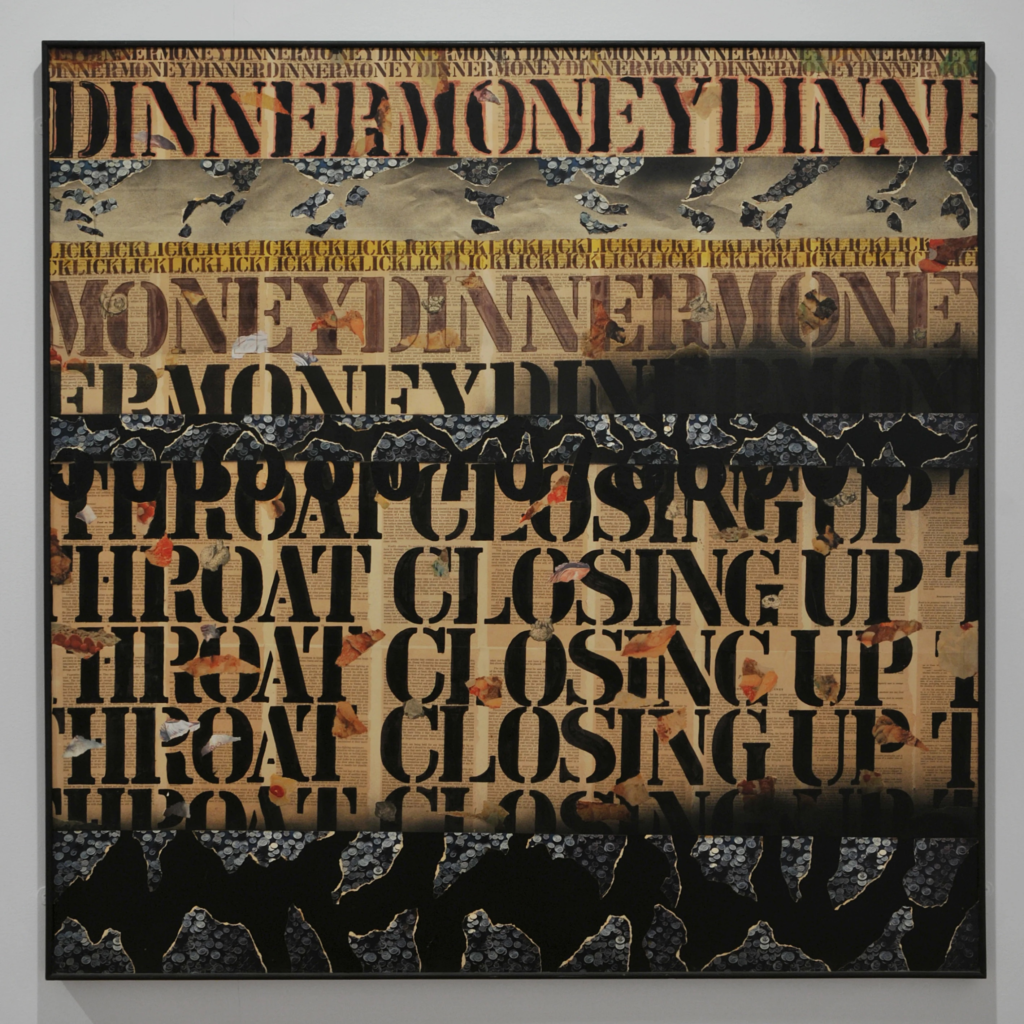
Above: Visual Text #2 (Dinner Money), Ian Breakwell (1969)
Three major solo exhibitions were displayed in 1974, 1977 and 1979, ‘The Diary and Related Works‘, ‘Beaten‘ and ‘The Walking Man Diary‘ respectively.
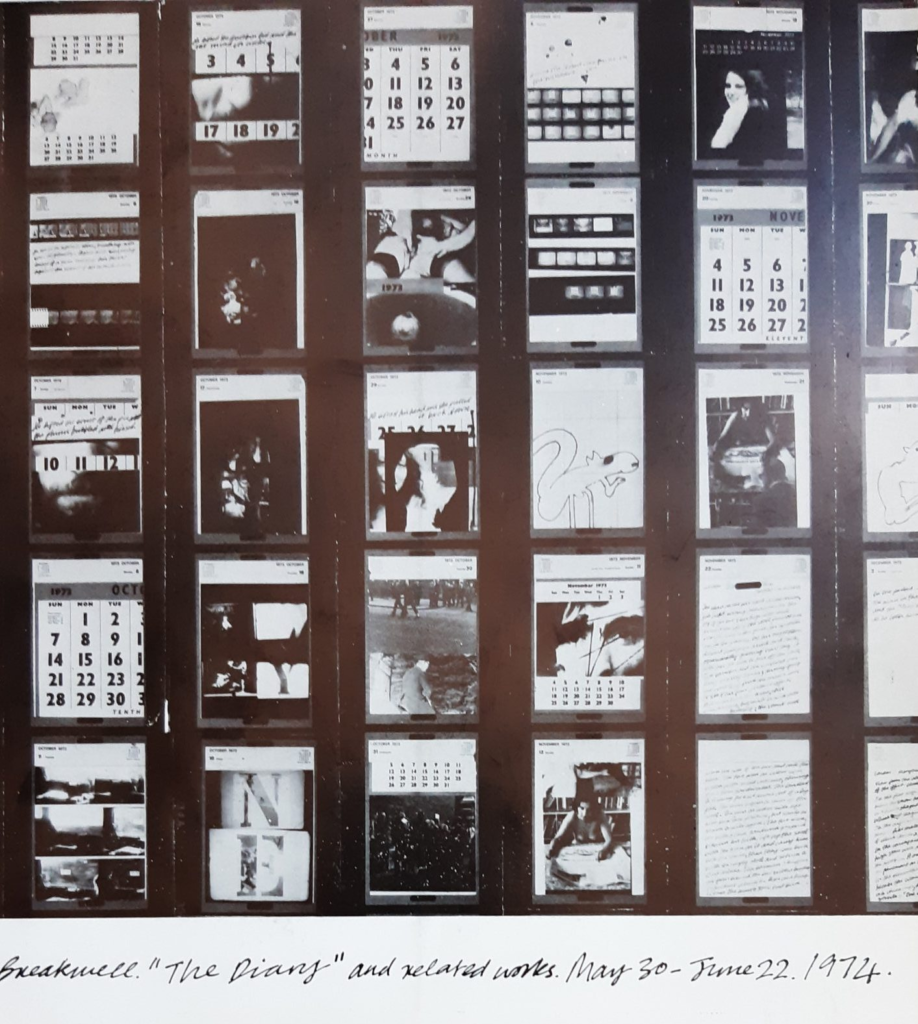
Above: “The Diary and related works“, Ian Breakwell (1974)
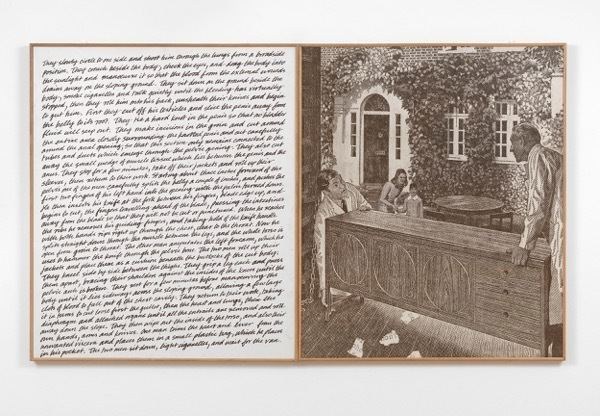
Above: “Beaten“, Ian Breakwell (1977)
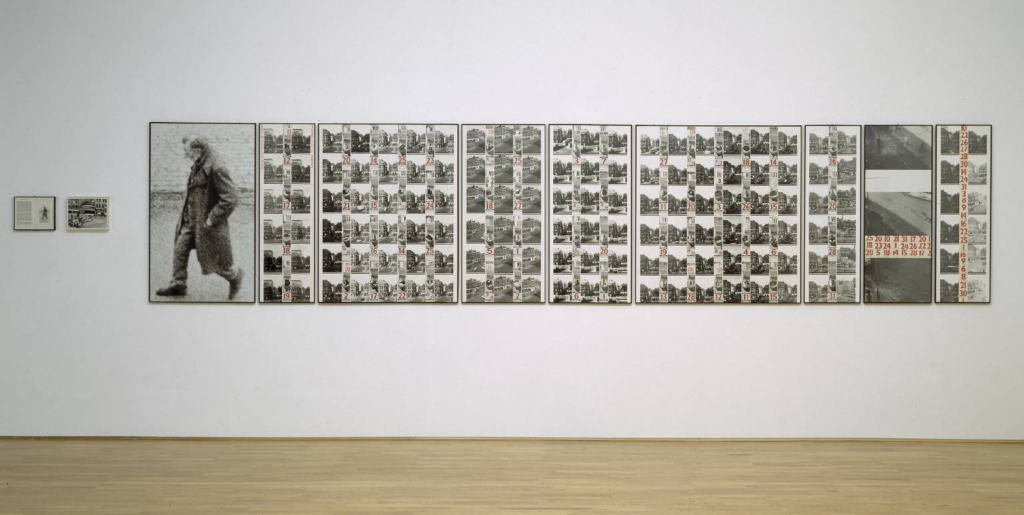
Above: “The Walking Man Diary“, Ian Breakwell (1979)
He was included in several group shows at Flowers Gallery, such as ‘Contemporary Portraits‘, in 1988 on the occasion of the opening of Flowers East, the Gallery’s second premises located on Richmond Road in East London.
Breakwell was also part of the exhibition ‘The Self Portrait: A Modern View‘, curated by Edward Lucie-Smith and Sean Kelly, which toured in nine British venues after its initial display at Artsite Gallery (Bath) and featured over 60 artists.
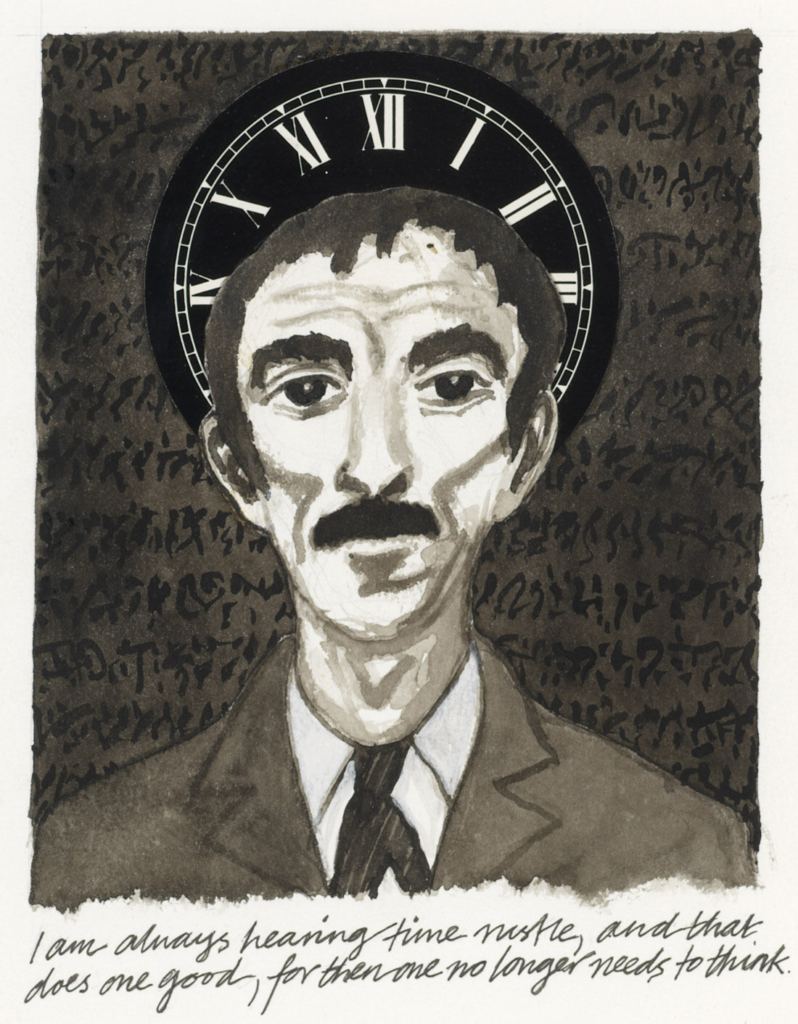
Above: Self portrait, Ian Breakwell
APG set out to place artists in the wider social context beyond galleries, museums and the art market by establishing relationships with companies and government departments.
The process of a working relationship would be the prime objective, not artwork production.
Breakwell’s placements included the Department of Health and Social Security (1968 – 1988).
Under its auspices, he worked in Broadmoor and Rampton Hospitals.
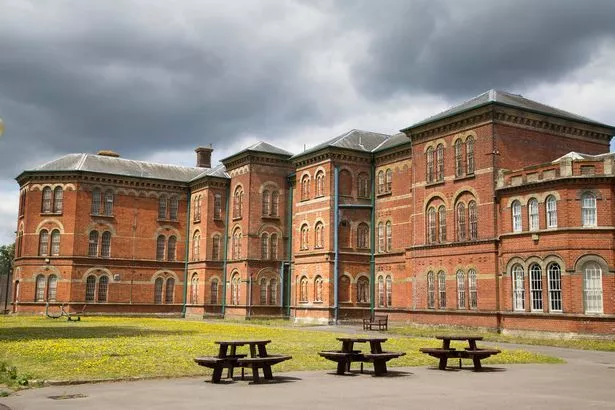
Above: High security psychiatric facility Broadmoor Hospital, Crowthorne, Berkshire, England
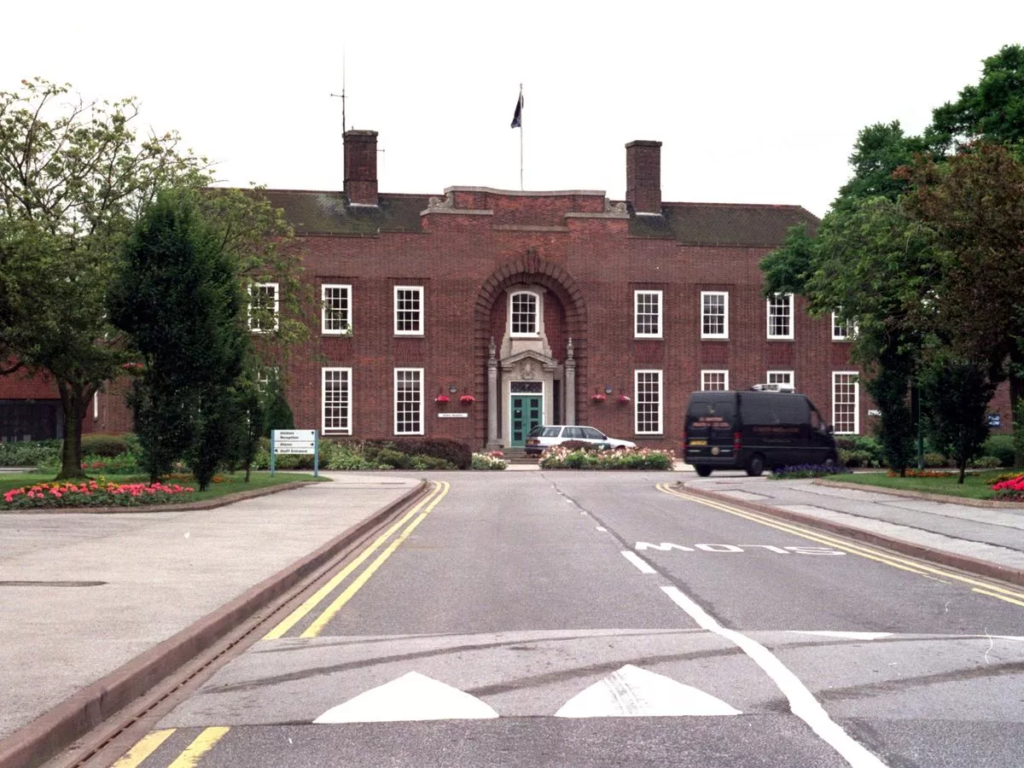
Above: Entrance to the high security psychiatric facility Rampton Hospital, Woodbeck, Nottinghamshire, England
The results included a report, co-written with a group of architects, recommending top-to-bottom changes at Rampton, and a film, The Institution (1978), made with the singer-songwriter and artist Kevin Coyne.
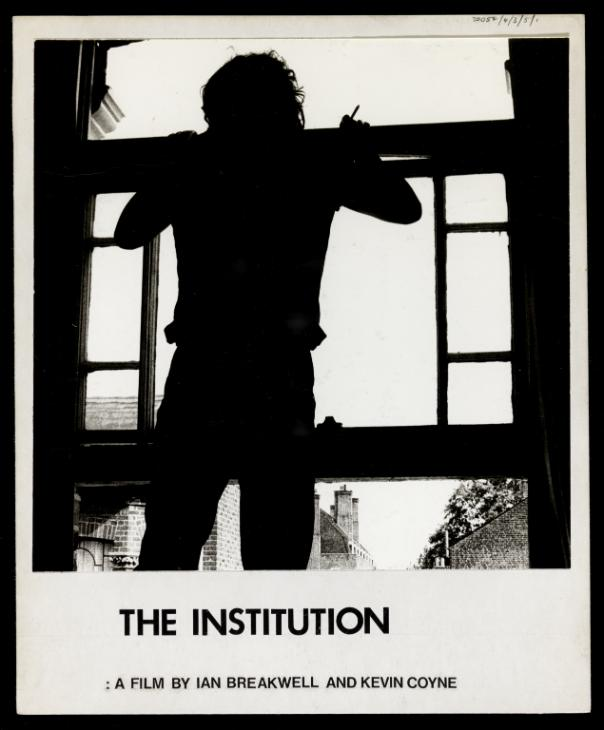
A diary entry recalls Breakwell’s first APG visit to Rampton, which immediately stirred memories of performing there as a child-conjuror:
The incongruous juxtaposition is entirely characteristic.
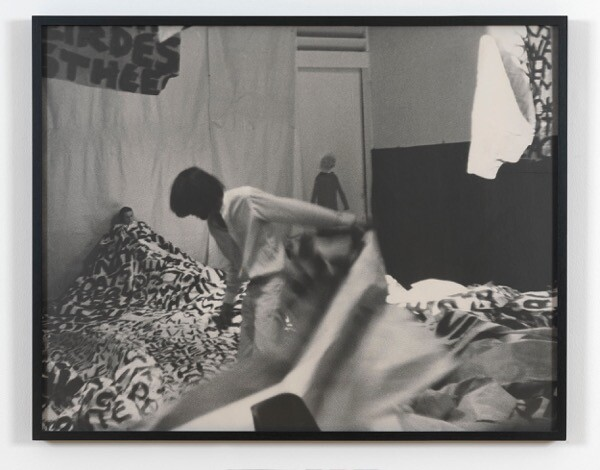
Above: Scene from The Institution (1978)
“Art would not be important if life were not important, and life is important.“
James Baldwin
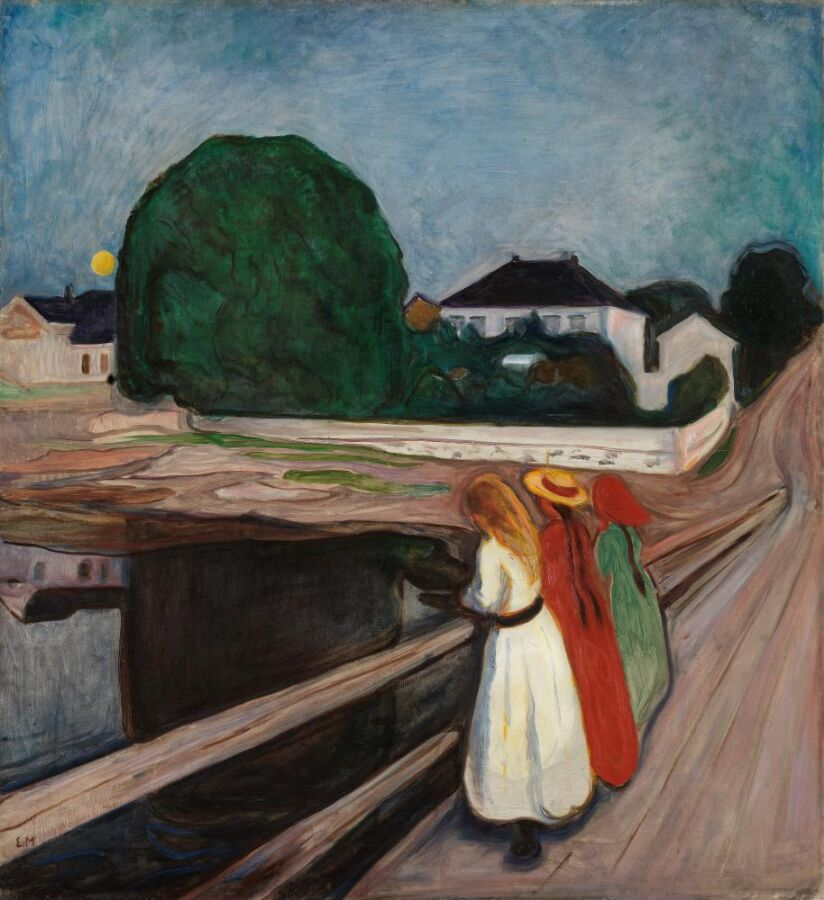
Above: The Girls on the Bridge, Edvard Munch (1901)
Ian Breakwell was as much a verbal as a visual artist and a large part of his creative life was taken up with the diary he kept for more than 40 years, a mere fraction of which has been published.
He sought an art of recurring epiphany, to be captured either visually or verbally.
A diary entry dated 8 July 1973 gives the flavour:
“The 1830 train from London to Plymouth.
In the dining car the fat businessman farts loudly and unexpectedly, and simultaneously by the side of the railway track, a racehorse falls down.“
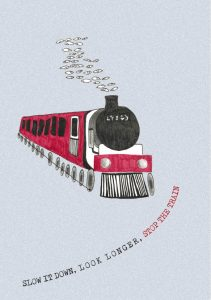
Above: Slow It Down, Look Longer, Stop the Train, Ian Breakwell
English multimedia artist Ian Breakwell worked in almost every conceivable medium, with painting and sculpture relegated to a very minor role in favour of documentation.
His own wide-ranging list mentions collage, texts, theatre performances, illustrations, video and audio installations.
At the centre of his work was his Continuous Diary (1965 – 1985), which chronicled the everyday details of life and The Walking Man Diary (1975 – 1978) that features shadowy photographs and written observations about a man who seemed to drift in and out of the Smithfield area of London where Breakwell lived, which he turned into an 11-panel collage.
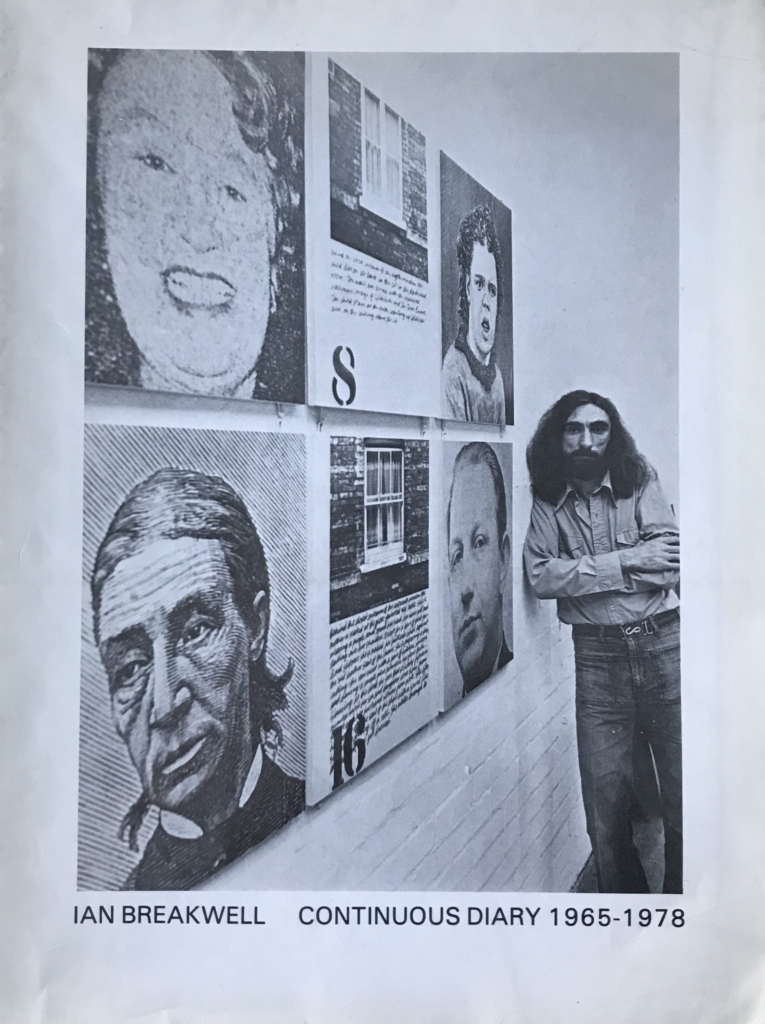
In 1986 Pluto Press published Ian Breakwell’s Diary 1964 – 1985, his idiosyncratic journal, observing fine details of modern society typically overlooked by most people.
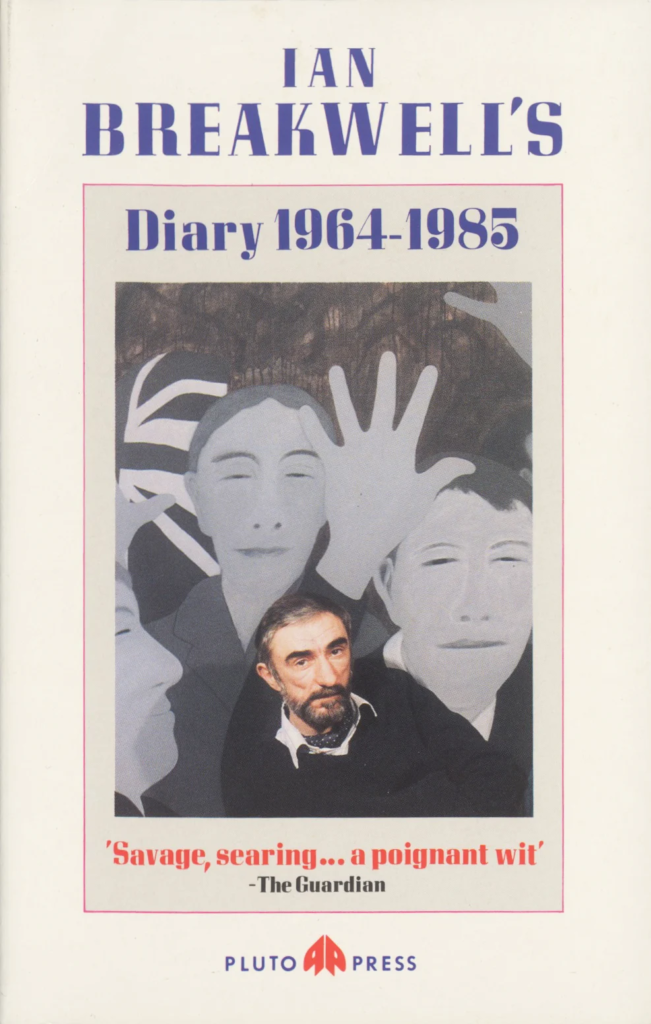
In the 1980s and 1990s, he made over 21 adaptations of his diary for Channel 4, as Ian Breakwell’s Continuous Diaries, produced by Anna Ridley (Analogue Productions).
Later he co-edited (with Paul Hammond) two important anthologies, akin to the work of Mass Observation:
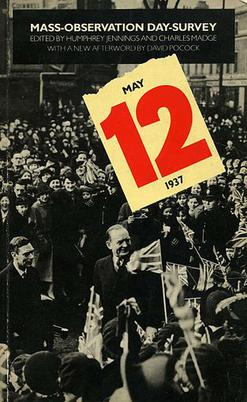
- Seeing in the Dark (1990), an assemblage of hundreds of accounts of cinema-going
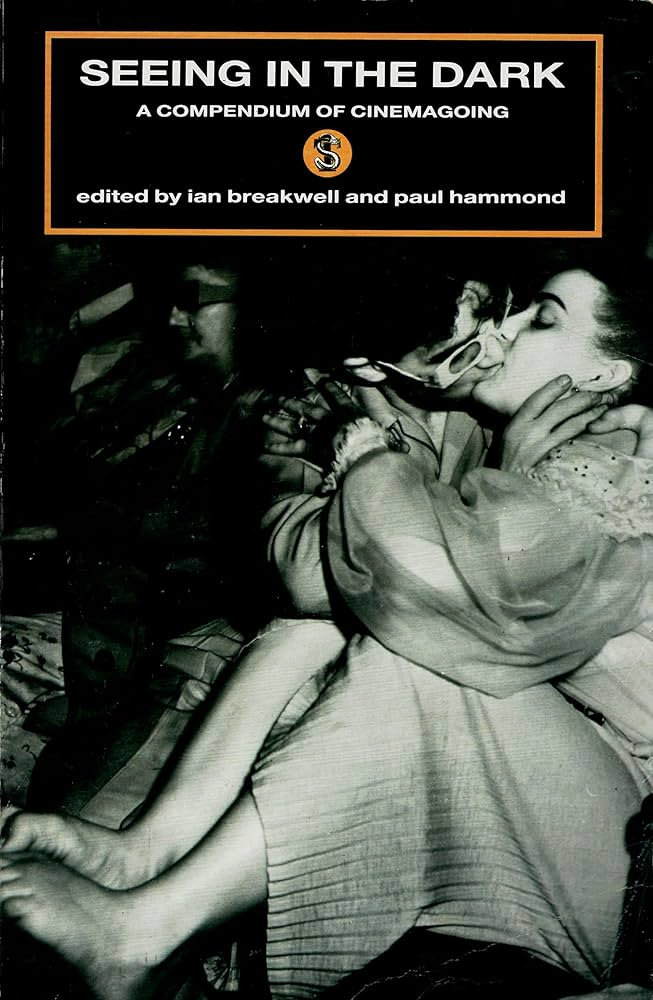
- Brought to Book (1994), which documented the myriad forms of bibliophiliac obsession.
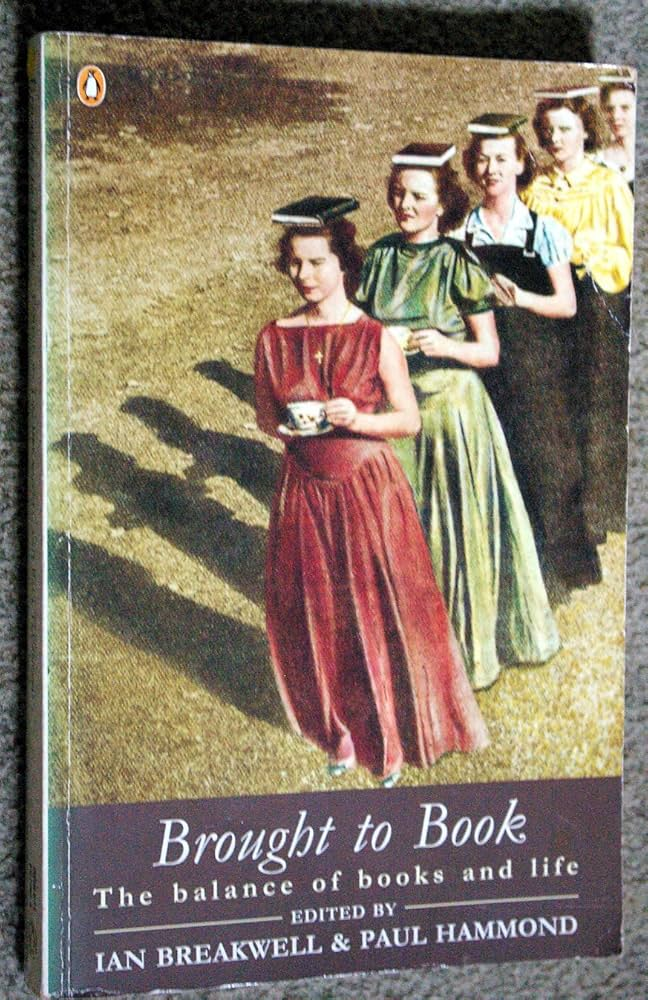
Although he had a longstanding relationship with the Anthony Reynolds Gallery in London, his keenness to develop new ways of working led to residencies with, among others, Tyne Tees Television (1985) and Durham Cathedral (1994 – 1995).

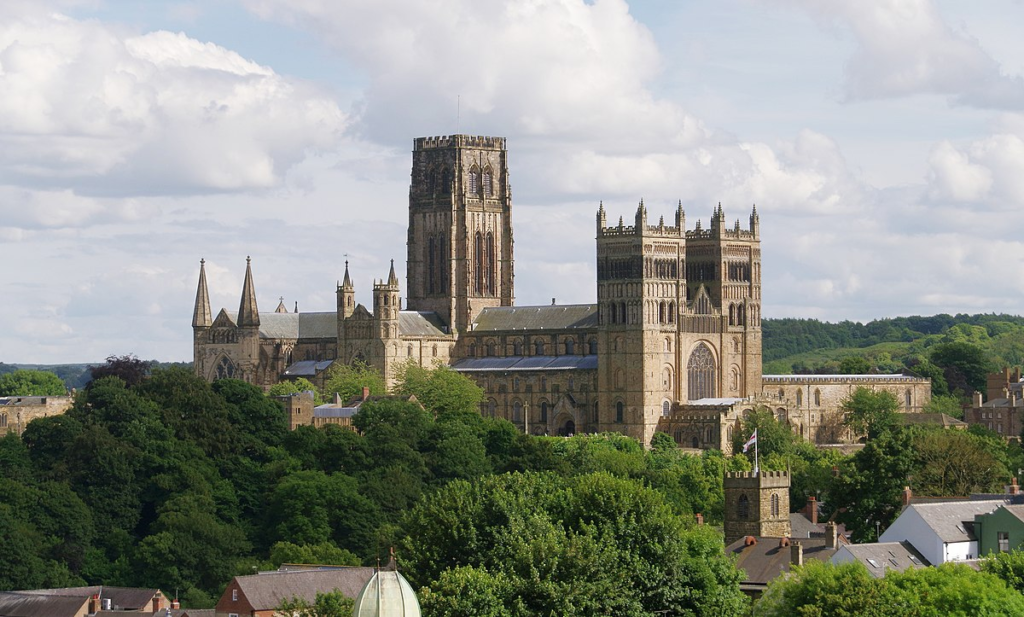
Above: Durham Cathedral
Among his other works is Auditorium (1994), a film made with composer Ron Geesin, in which we are taken to a variety show in which the viewer is only shown the audience’s reactions at a theatre rather than the show itself.
The results are hilarious and touching.
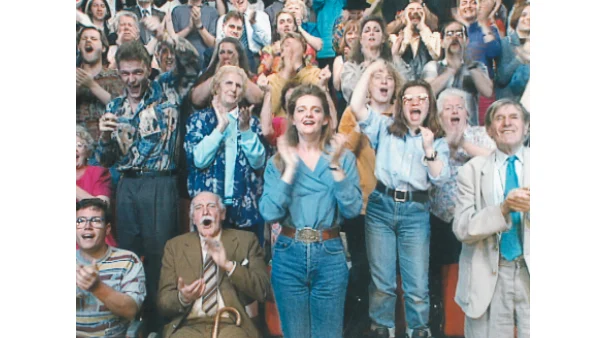
Above: Scene from Auditorium, Ian Breakwell (1984)
Auditorium was on show at the De La Warr Pavilion, Bexhill, as part of an exhibition, co-curated by Breakwell, called Variety, the title taken from another Breakwell / Geesin film.
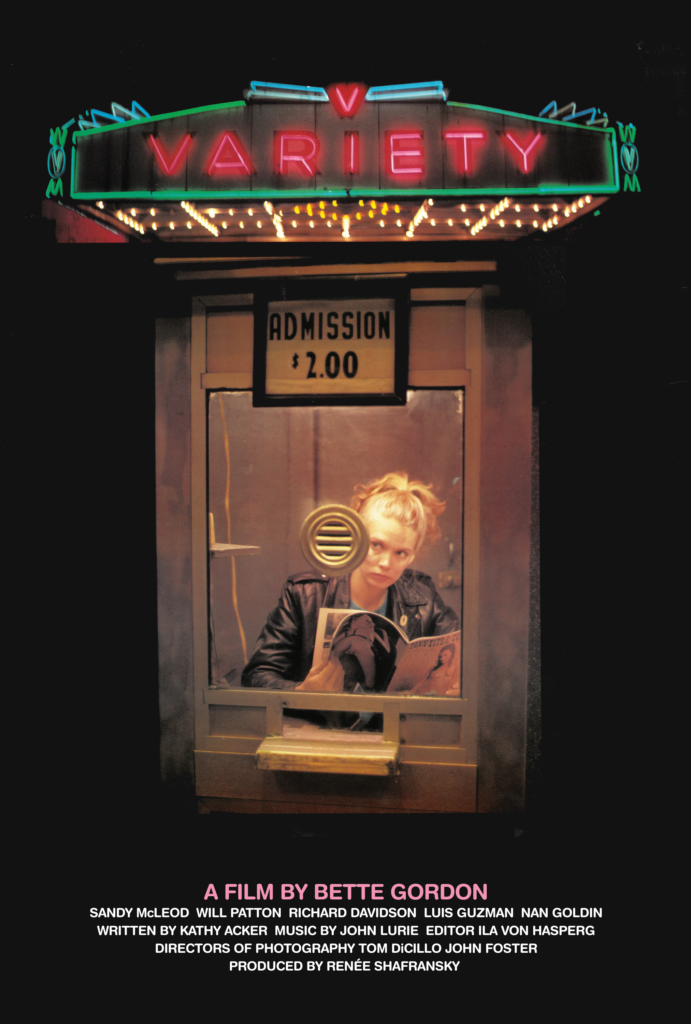
The Pavilion itself was the setting for The Other Side (2002), in which ballroom dancers float serenely through its dreamlike architecture, to the accompaniment of a Schubert nocturne for piano trio.
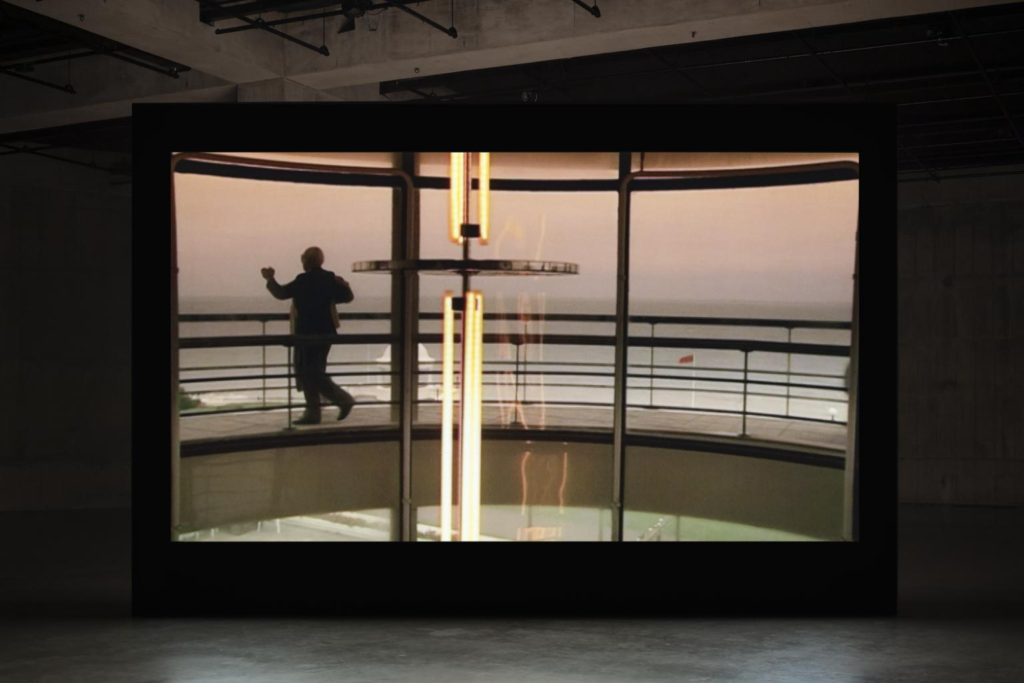
Above: Scene from The Other Side, Ian Breakwell (2002)
It was in 2004 that Breakwell was diagnosed with cancer.
Typically, he responded with renewed creative energy, creating a series of works that looked unblinkingly at his condition.
The resulting images are both painful and beautiful – just as the last pages of his diary will no doubt reveal not only the artist who created them, but unexpected facets of our own experience.
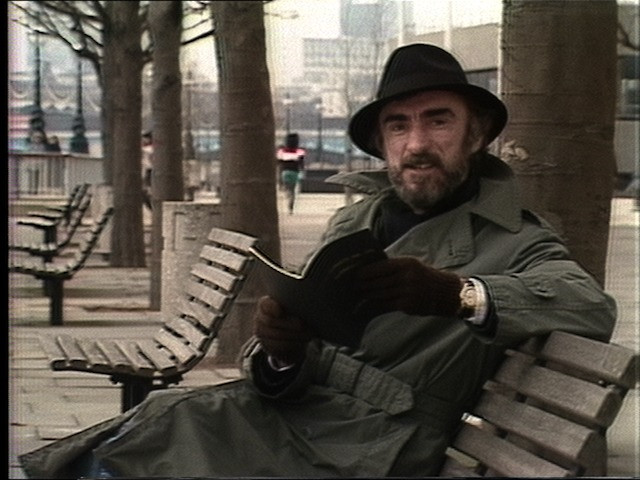
Above: Ian Breakwell
“I make art because it centers me in my body, and by doing so I hope to offer that experience to someone else.”
Janine Antoni
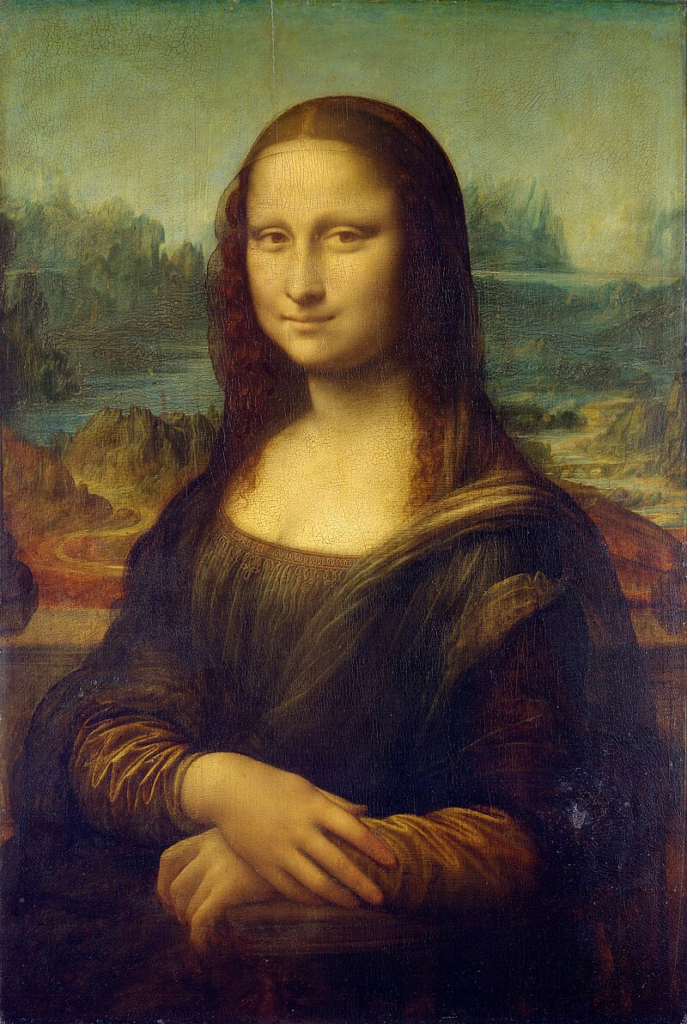
Above: Mona Lisa, Leonardo da Vinci
In a similar sense my travel blogposts attempt the same.
I am the audience rather than the places themselves.
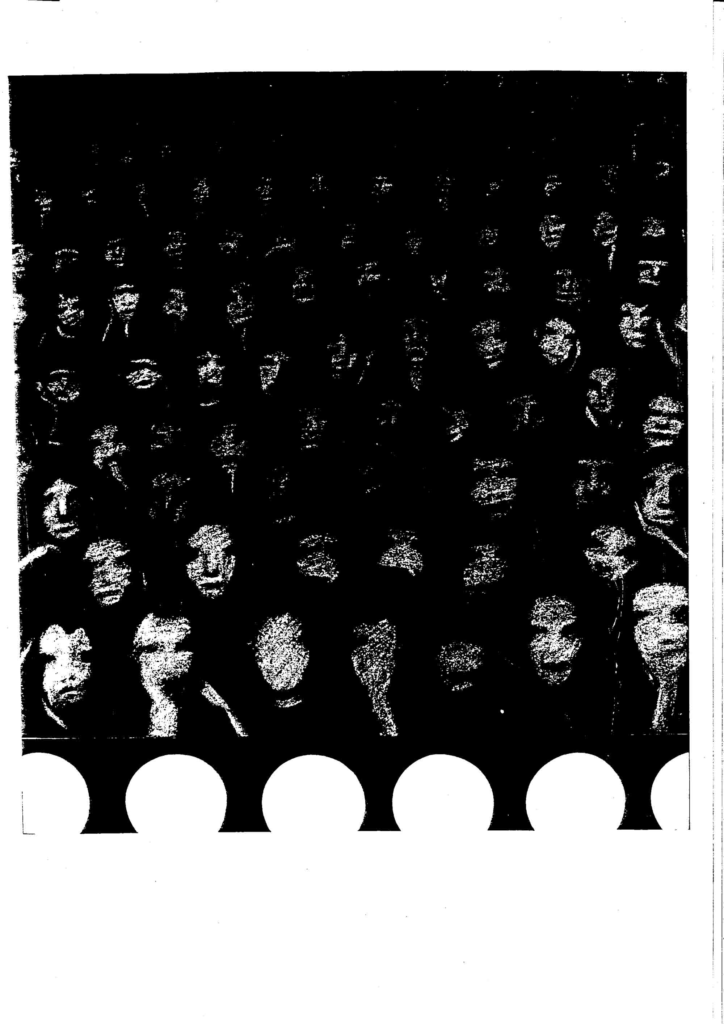
Above: Scene from Ian Blackwell’s Auditorium
“One writes out of one thing only — one’s own experience.
Everything depends on how relentlessly one forces from this experience the last drop, sweet or bitter, it can possibly give.
This is the only real concern of the artist, to recreate out of the disorder of life that order which is art.”
James Baldwin
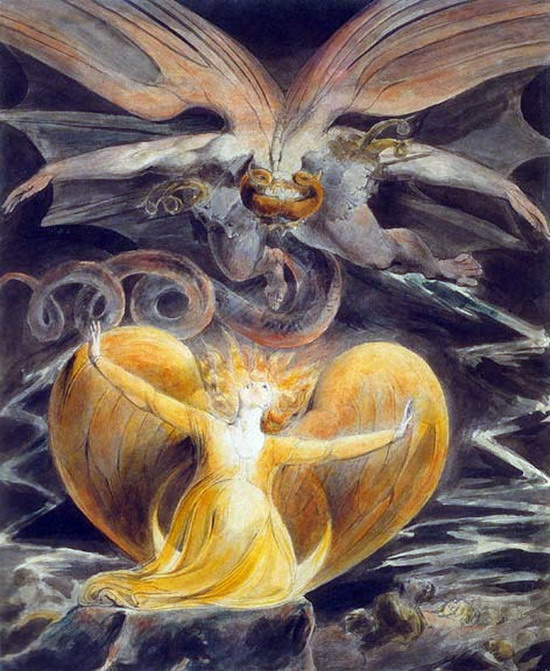
Above: The Great Red Dragon and the Woman Clothed with the Sun, William Blake (1810)
To truly and fully appreciate the artists of Málaga, I recommend that you, gentle readers, come to Málaga and witness the beauty of the place and its artistic children for yourself.
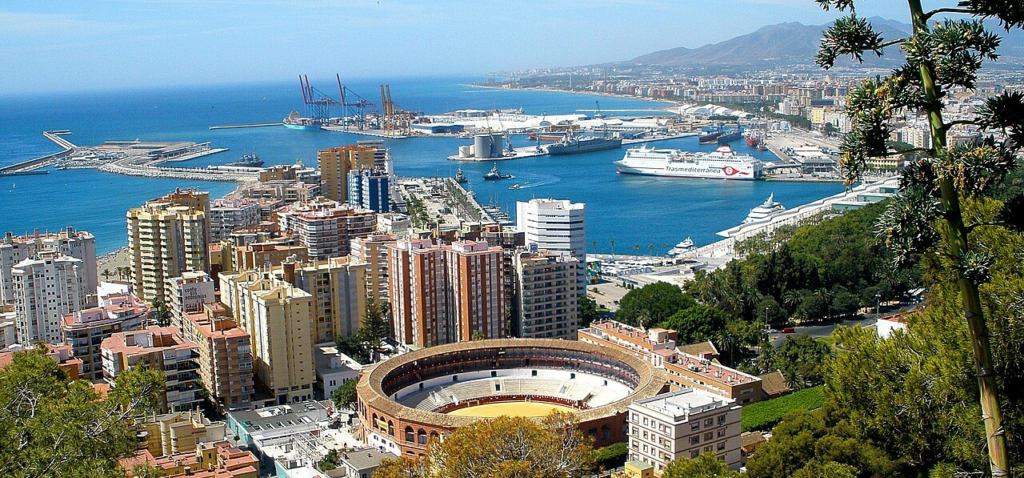
Above: Málaga, Andalucia, España
“Art is something that makes you breathe with a different kind of happiness.“
Anni Albers
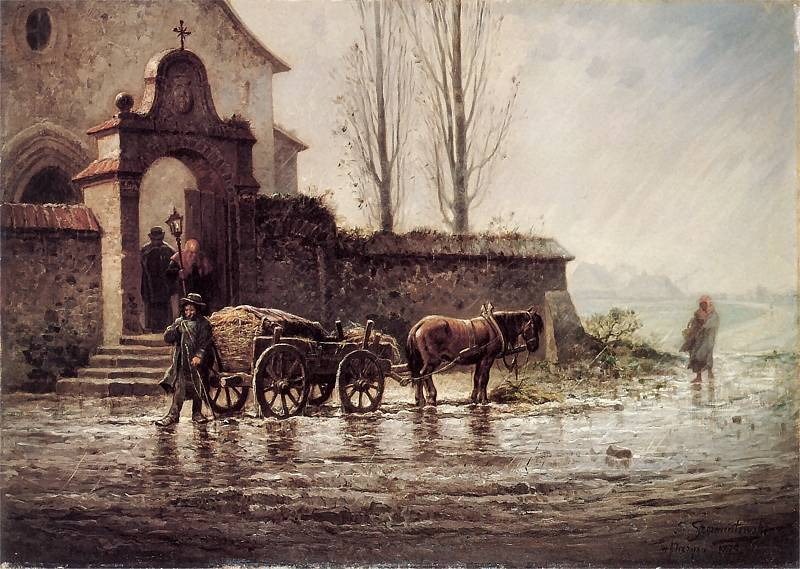
Above: Biednemu wiatr w oczy (The wind in your eyes), Jozef Szermentowski (1833 – 1876)
Málaga, España
Tuesday 11 June 2024
On this, our first full day of vacation, the wife and I play full-fledged tourists, trying to see as much as possible in the most efficient manner.
In my previous blogpost I spoke of the religious establishments we visited in Málaga, but on this day we also visited the Museo Carmen Thyssen, the Museo Jorge Rando and the Museo Picasso Málaga.
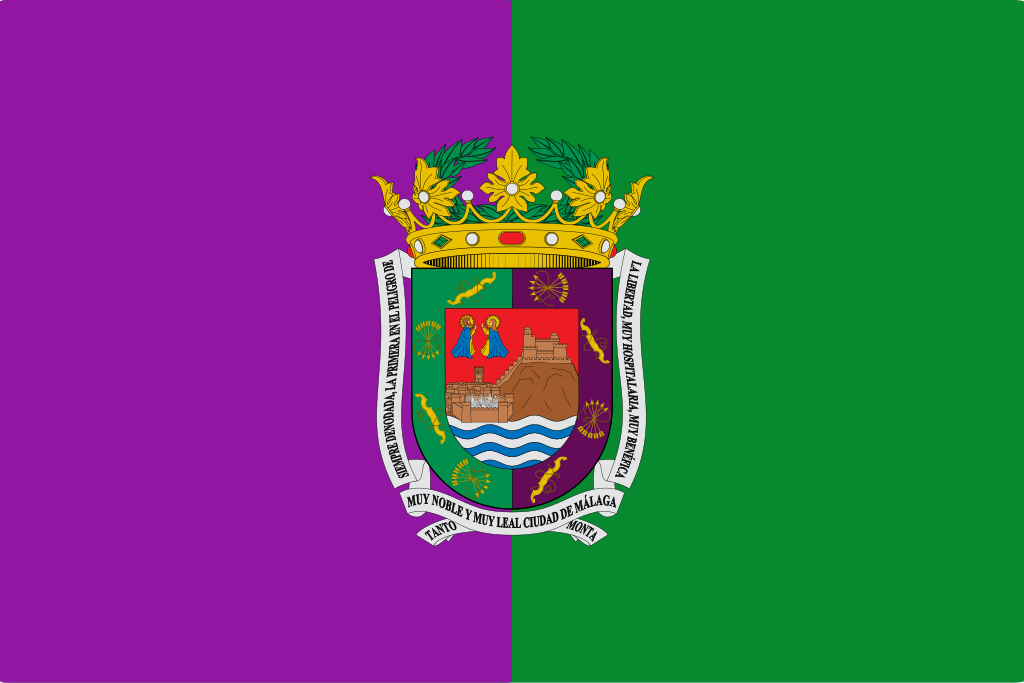
Above: Flag of Málaga
“Any great work of art revives and readapts time and space, and the measure of its success is the extent to which it makes you an inhabitant of that world — the extent to which it invites you in and lets you breathe its strange, special air.“
Leonard Bernstein
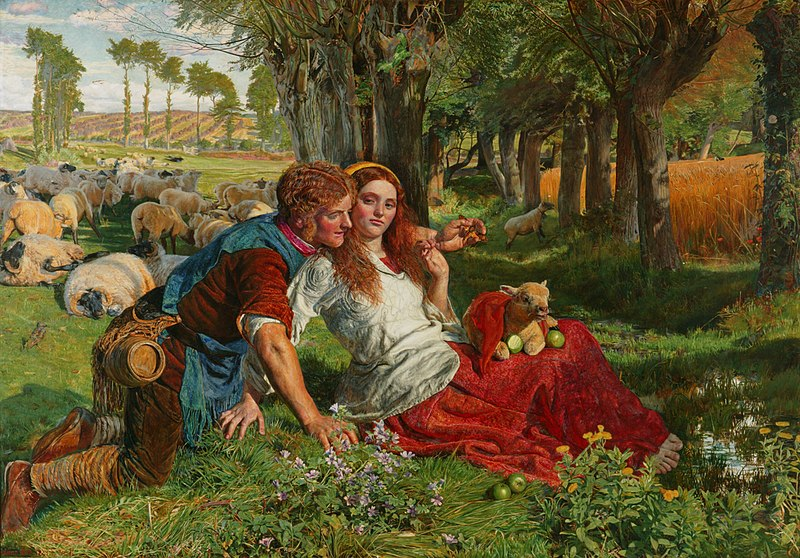
Above: The Hireling Shepherd, William Holman Hunt (1851)
The Museo Carmen Thyssen is one of the main museums in the city of Málaga.
It was opened in 2011 and houses one of the most important collections of Spanish and Andalusian painting from the beginning of the 19th century to the beginning of modernity in the 20th century, covering some of the main genres of Spanish art in this period, such as landscape and costumbrismo.
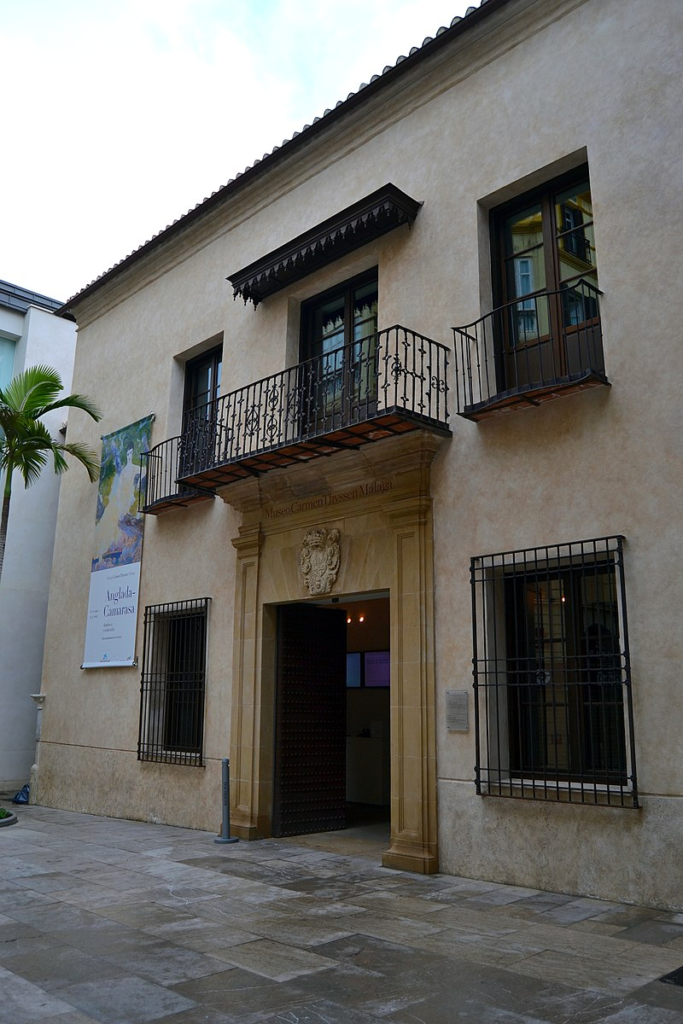
Above: Museo Carmen Thyssen, Palacio de Villalon, Málaga
Its more than 250 works come from the Carmen Thyssen -Bornemisza collection and also include a selection of pieces by old masters, including a Santa Marina by Francisco de Zurbarán (1598 – 1664).
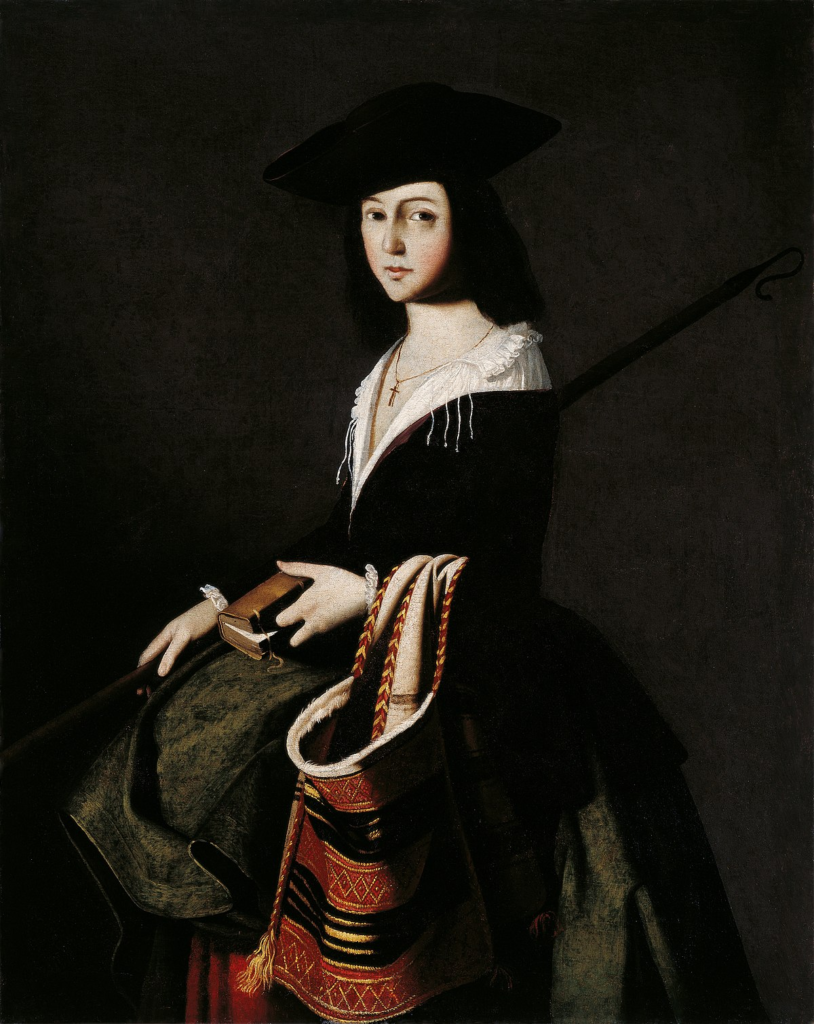
Above: Santa Marina, Francisco de Zurbarán (1650)
It is housed in the Villalón Palace, a 16th century building renovated and expanded to house the Museo.
The Museo is housed in the Palacio Villalón (Villalón Palace), taking advantage of several adjacent buildings as exhibition spaces, halls and offices.
It was inaugurated on 24 March 2011.
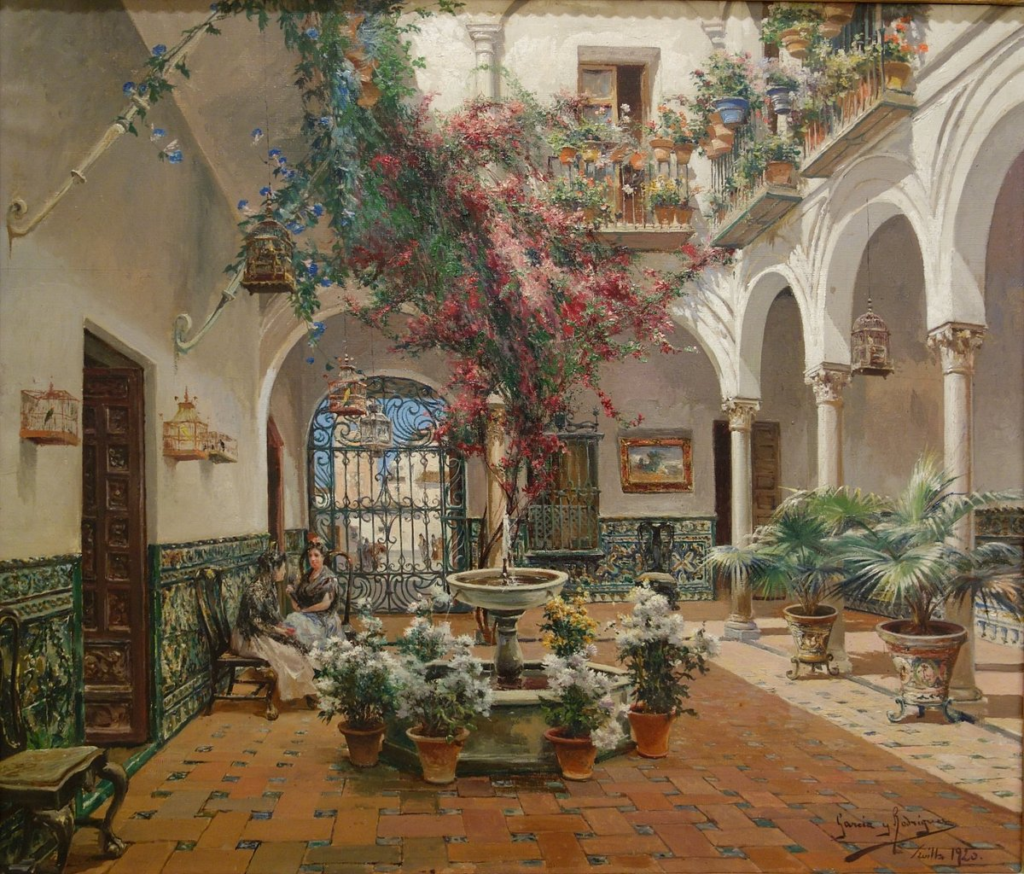
Above: Interior Courtyard, Seville, Manuel García y Rodríguez (1920), Museo Carmen Thyssen, Málaga
“While our art cannot, as we wish it could, save us from wars, privation, envy, greed, old age or death, it can revitalize us amidst it all.“
Ray Bradbury
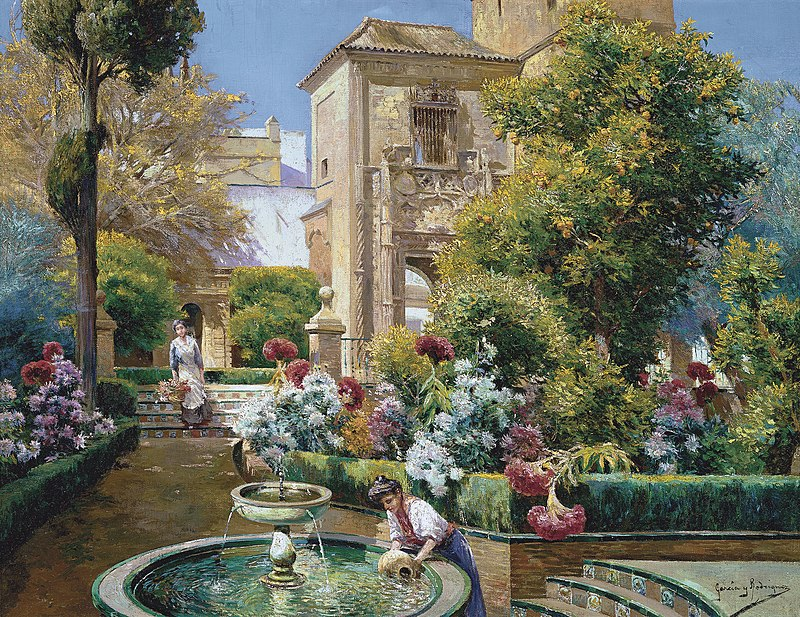
Above: The Garden of Alcázar, Seville, Manuel García y Rodríguez (1920), Museo Carmen Thyssen, Málaga
The facilities include, in addition to the exhibition halls dedicated to the Carmen Thyssen Collection, the headquarters of its Foundation, a library, rooms for temporary exhibitions, a teaching classroom, an assembly hall, the museum shop, the restoration section and an archaeological exhibition hall.
The Renaissance-style building, dating from the 16th century, was destined after its restoration to house the collection that the widowed Baroness Carmen Cervera had agreed to give to Málaga after a series of conversations with the City Council.
The restoration took a period of four years from 2007 to 2011, during which the rehabilitation and inclusion of two other buildings to the main one was also discussed.
The central construction resulted in a structure of an interior main courtyard with a double floor, adding another of reduced dimensions from which the tower of the attached Iglesia Santo Cristo de la Salud starts.
In 2017 it received its 1,000,000th visitor.
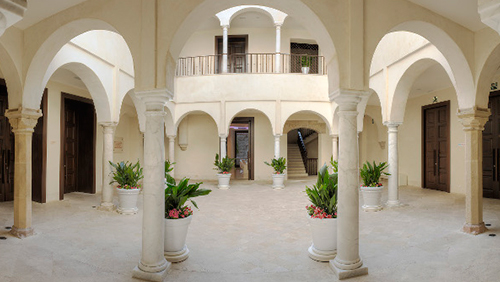
Above: Interior courtyard, Museo Carmen Thyssen, Málaga
“It’s true that things are beautiful when they work.
Art is function.“
Giannina Braschi
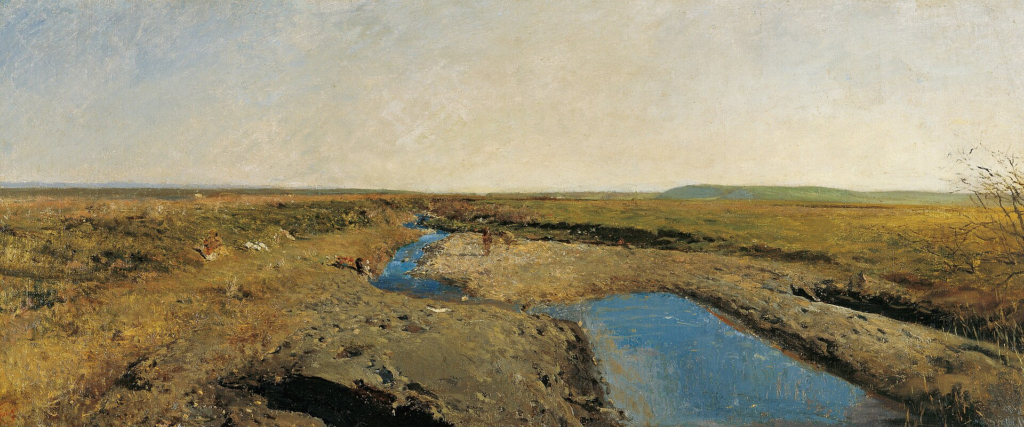
Above: North African Landscape, Marià Fortuny (1862), Museo Carmen Thyssen, Málaga
The Museo has 285 works that are part of the Carmen Thyssen-Bornemisza collection, and covers the different genres of 19th century Spanish painting, from Romanticism to the beginnings of modernity in the first decades of the 20th century , paying special attention to Andalusian painting.
The initial agreement signed establishes that the institution has access to the paintings until 2025.
However, a possible extension of the loan was contemplated.
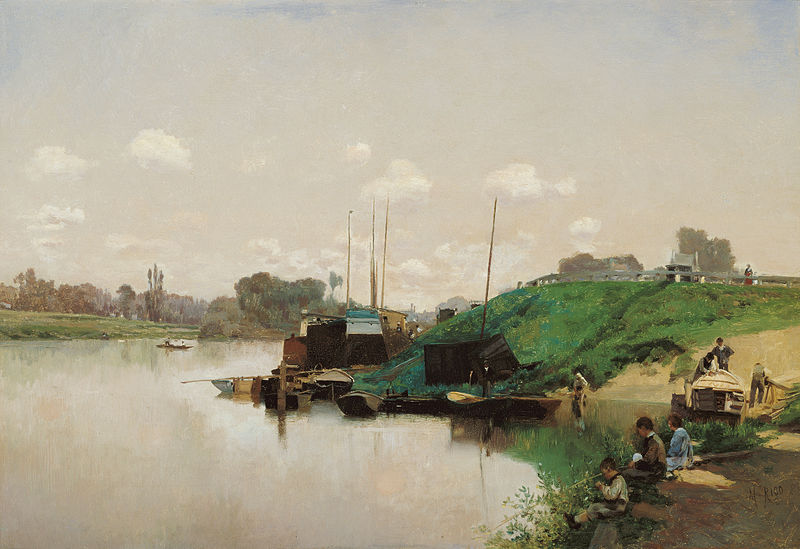
Above: A Summer’s Day on the Seine, Martín Rico Ortega (1870), Museo Carmen Thyssen, Málaga
“Art today can only be revolutionary, that is, it must aspire at the complete and radical reconstruction of society, even if for no other reason than to emancipate intellectual creation from the chains which obstruct it and to allow all mankind to rise to the heights that only geniuses could reach in the past.“
André Breton
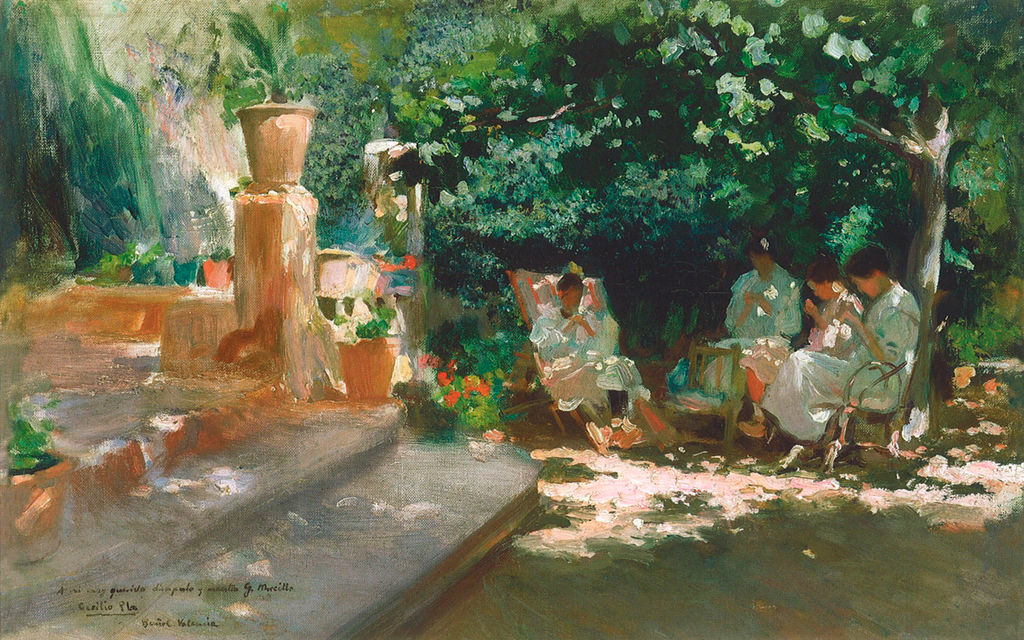
Above: Ladies in the Garden, Cecilio Plá y Gallardo, (1910), Museo Carmen Thyssen, Málaga
The Museo is divided into four sections:
- Old Masters, as an introduction to what was once the Chapel of the Palacio Villalón, with works dating back to the 17th century, led by Francisco de Zurbarán and Jerónimo Ezquerra (1660 – 1733)
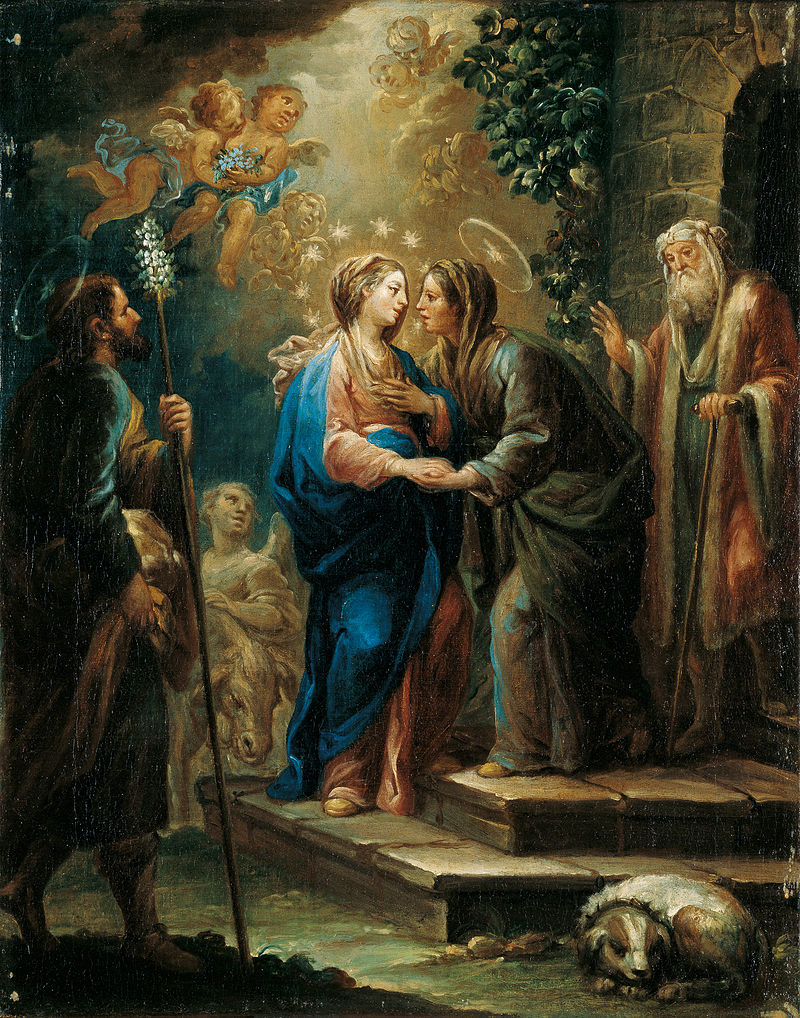
Above: The Visitation, Jerónimo Ezquerra (1737), Museo Carmen Thyssen, Málaga
- Romantic landscape and local customs, which reflects the vision that romantic travellers had of Spain, its past, Moorish architecture, gypsies, bullfights, festivals, flamenco, etc.
- Fritz Bamberger and his ‘Landscape of the Estepona coast‘ open this space, which is made up of works, among others, by:
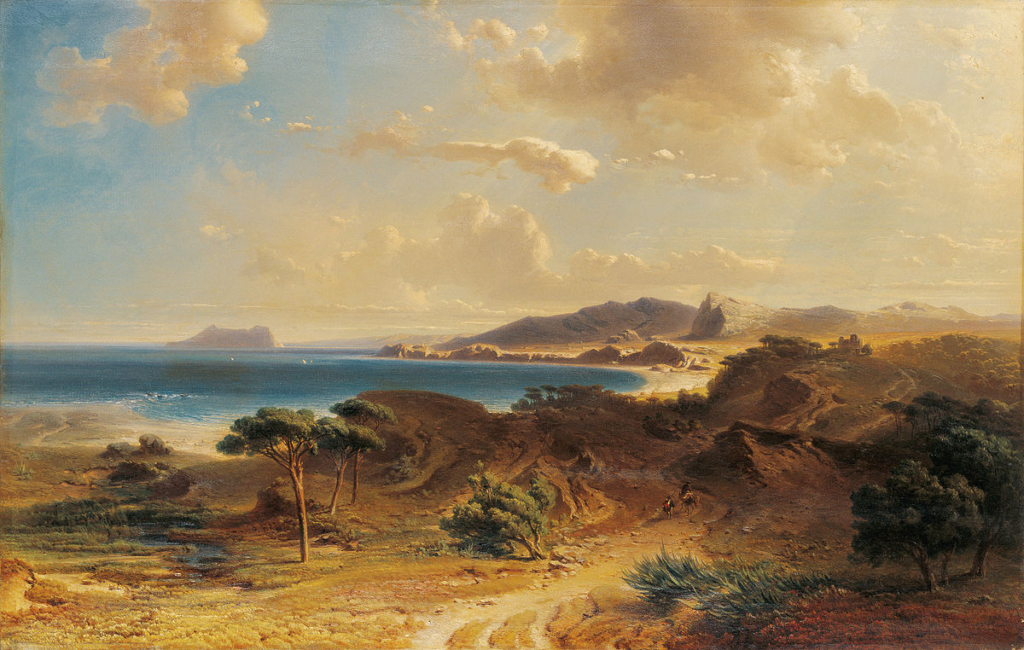
Above: The Beach of Estepona, Fritz Bamberger (1855), Museo Carmen Thyssen, Málaga
- Genaro Pérez Villaamil (1807 – 1854)
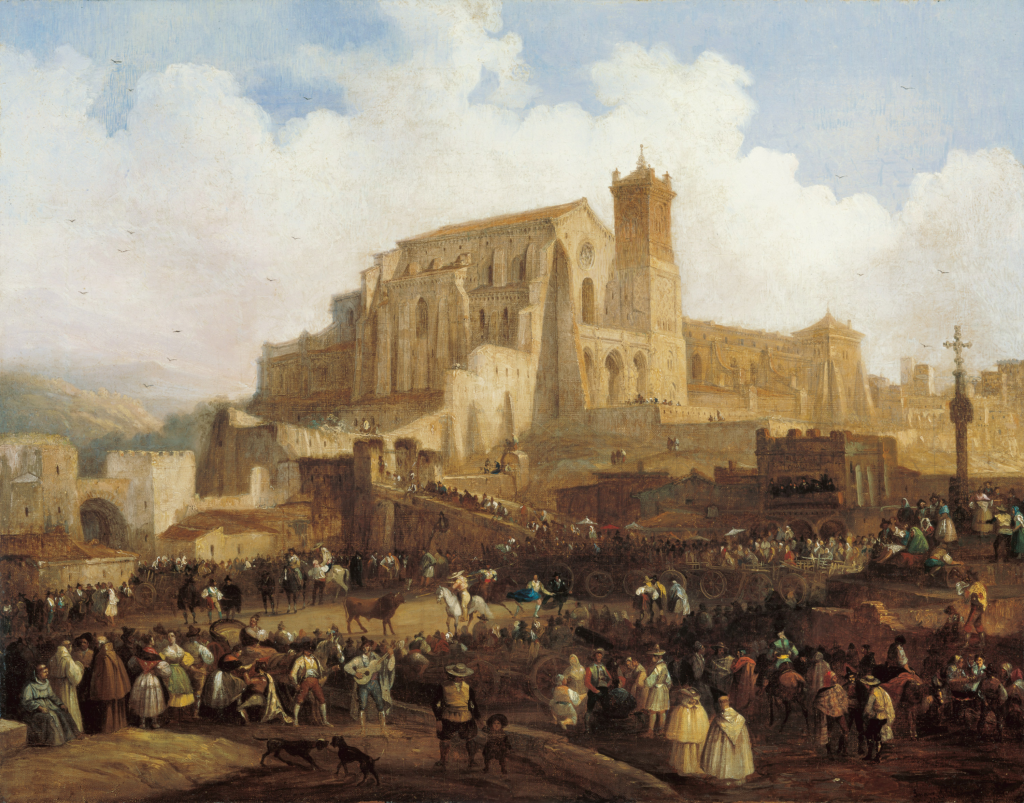
Above: Village Bullfight, Genaro Pérez Villaamil (1838), Museo Carmen Thyssen, Málaga
- Rafael Benjumea (1825 – 1888)
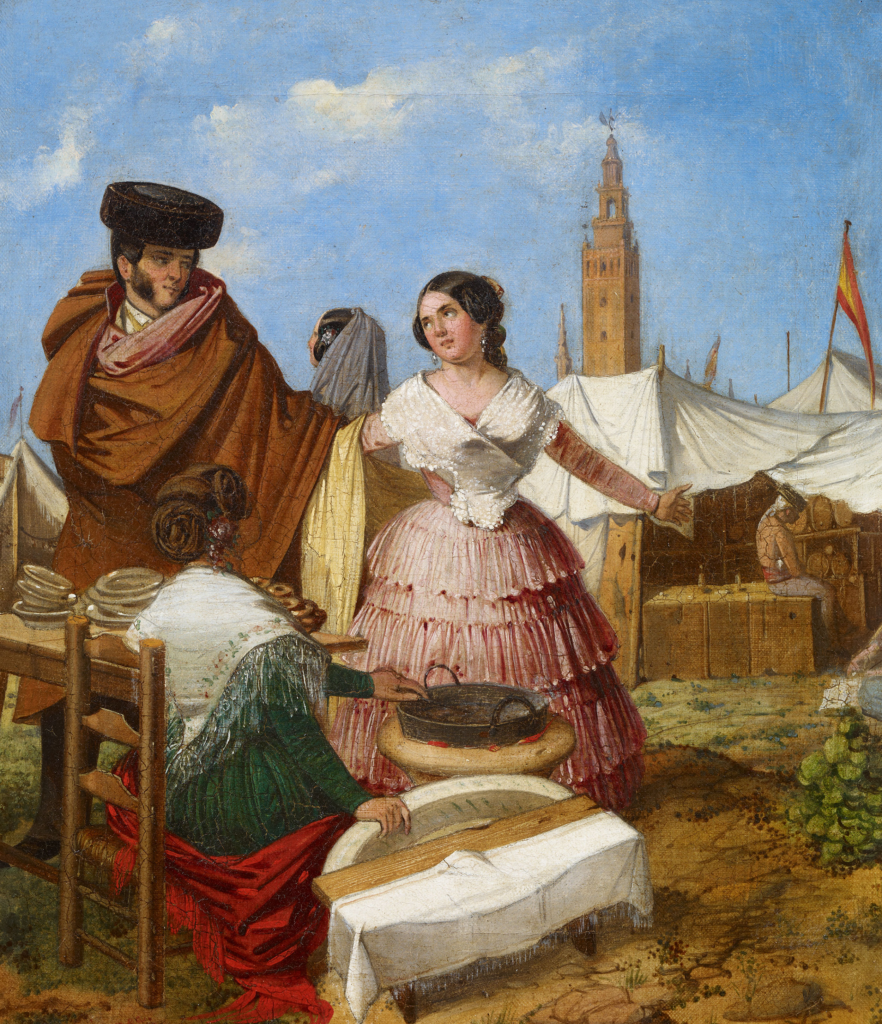
Above: Courting at a Ring-Shaped Pastry Stall at the Seville Fair, Rafael Benjumea (1852), Museo Carmen Thyssen, Málaga
- José García Ramos (1852 -1912)
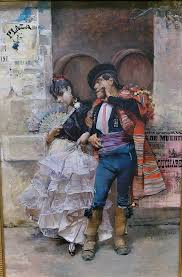
Above: Pareja de baile Sevillana (Pair of Sevilla dancers), José García Ramos, Museo Carmen Thyssen, Málaga
- Guillermo Gómez Gil (1862 – 1942)
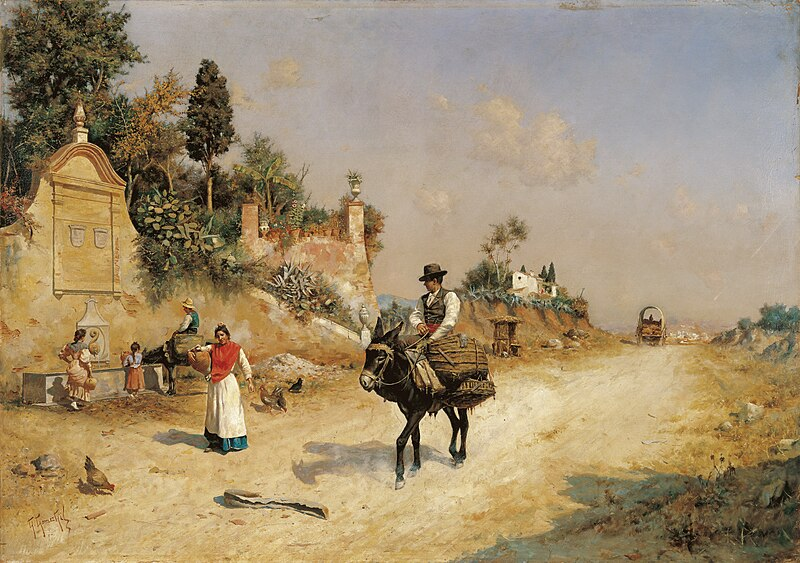
Above: The fountain, Guillermo Gómez Gil (1855), Museo Carmen Thyssen, Málaga
- Preciousness and naturalistic landscape, which shows the profound evolution that Spanish painting underwent during the second half of the 19th century towards small-format, colourful works with attention to detail, the precious painting, and on the other hand, the transformations from the romantic subjectivist landscape to the more realistic landscape of naturalism.
- Here you can find works by artists such as:
- Mariano Fortuny (1838 – 1874)
- Here you can find works by artists such as:
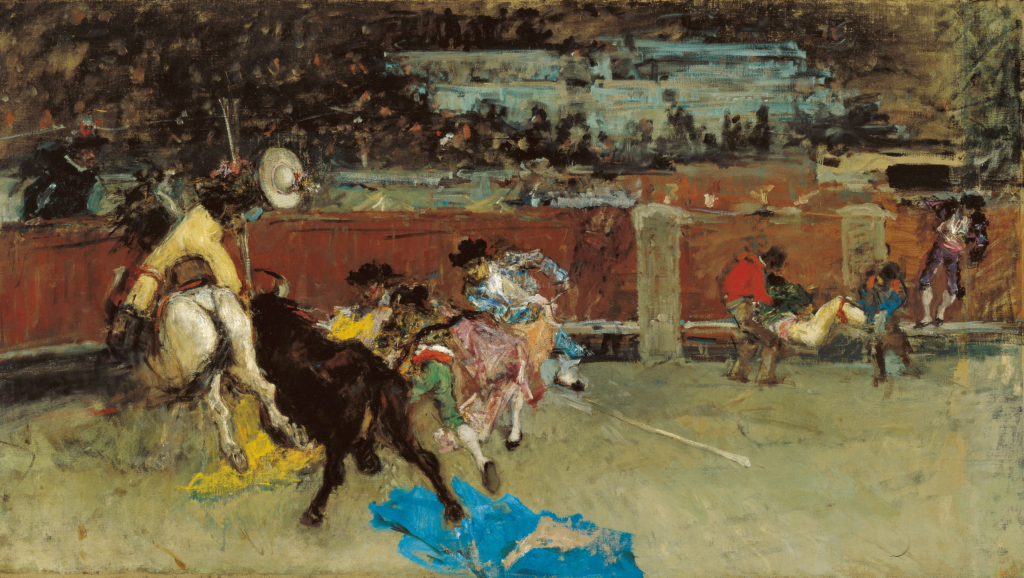
Above: Wounded picador, Bullfight, Mariano Fortuny (1867), Museo Carmen Thyssen, Málaga
- José Benlliure y Gil (1855 – 1937)
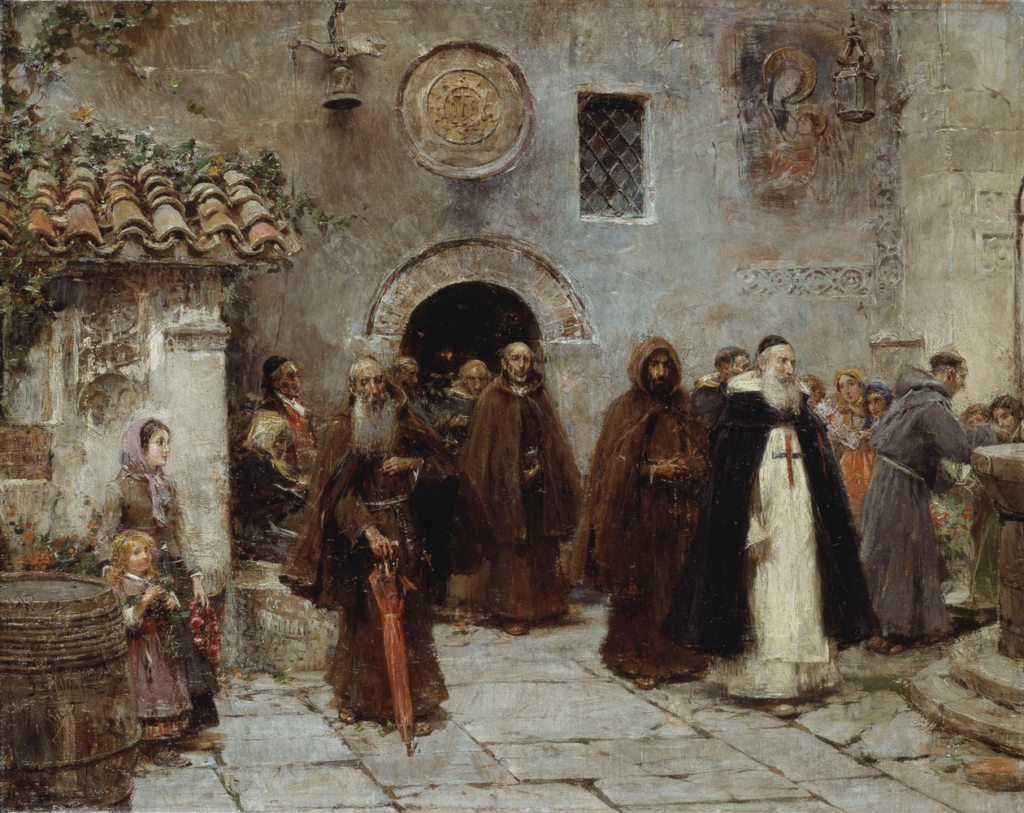
Above: The Procession, José Benlliure y Gil, Museo Carmen Thyssen, Málaga
- Raimundo de Madrazo (1841 – 1920)
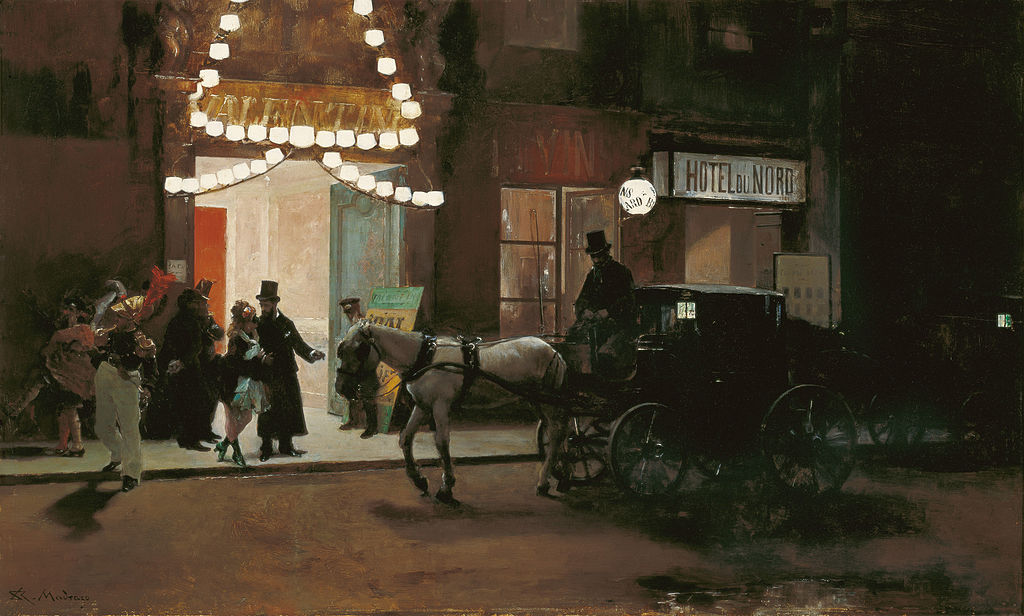
Above: Leaving the Masked Ball, Raimundo Madrazo (1885), Museo Carmen Thyssen, Málaga
- José Moreno Carbonero
José Moreno Carbonero (1860 – 1942) was a Spanish painter and decorator.
A prominent member of the Escuela Malagueña (Málaga School of Painting), he is considered one of the last great history painters of the 19th century.
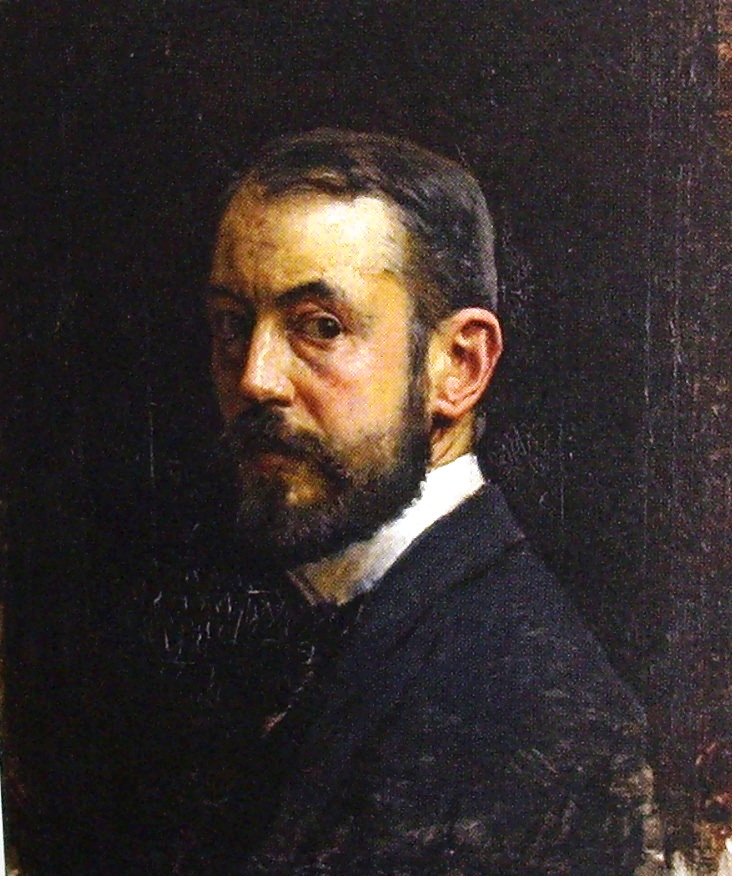
Above: Self portrait, José Moreno Carbonero (1895), Museo de Málaga
He was a celebrated portrait painter who enjoyed the patronage of Madrid’s high society.
He also created genre scenes and some landscapes, vedutas and still lifes.
Moreno Carbonero was widely recognized, both nationally and internationally, during his lifetime.
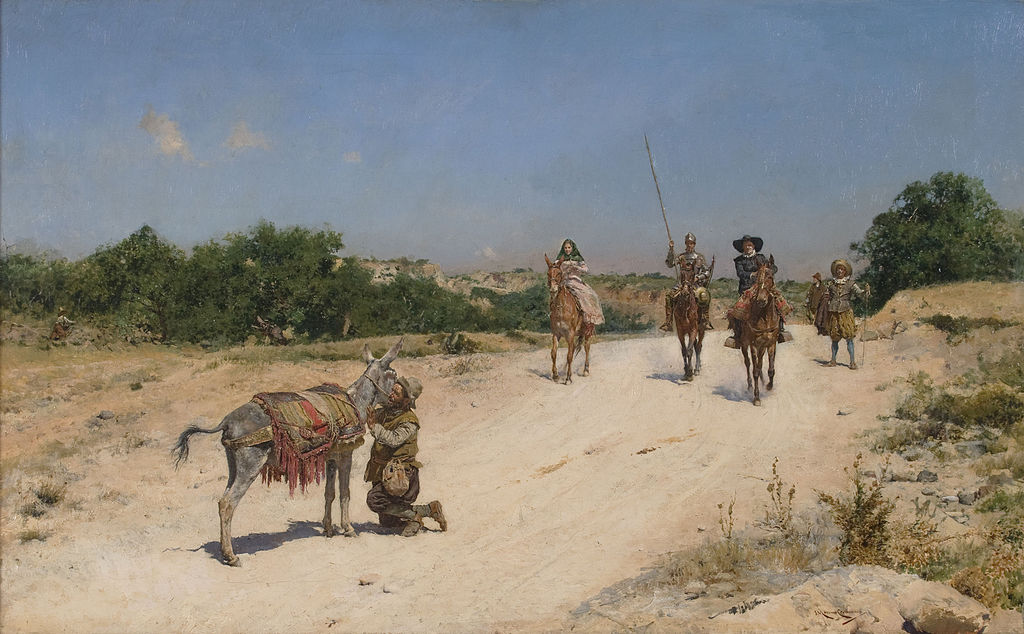
Above: Encuentro de Sancho Panza con el Rucio (Sancho Panza meets his donkey), José Moreno Carbonero, Museo del Prado, Madrid, España
He received awards, among others, at the Exposition Universelle of Paris in 1889, the Budapest International Exhibition in 1890, the Universal Exhibition of Berlin in 1891 and the only medal at the World’s Columbian Exposition of Chicago in 1893.
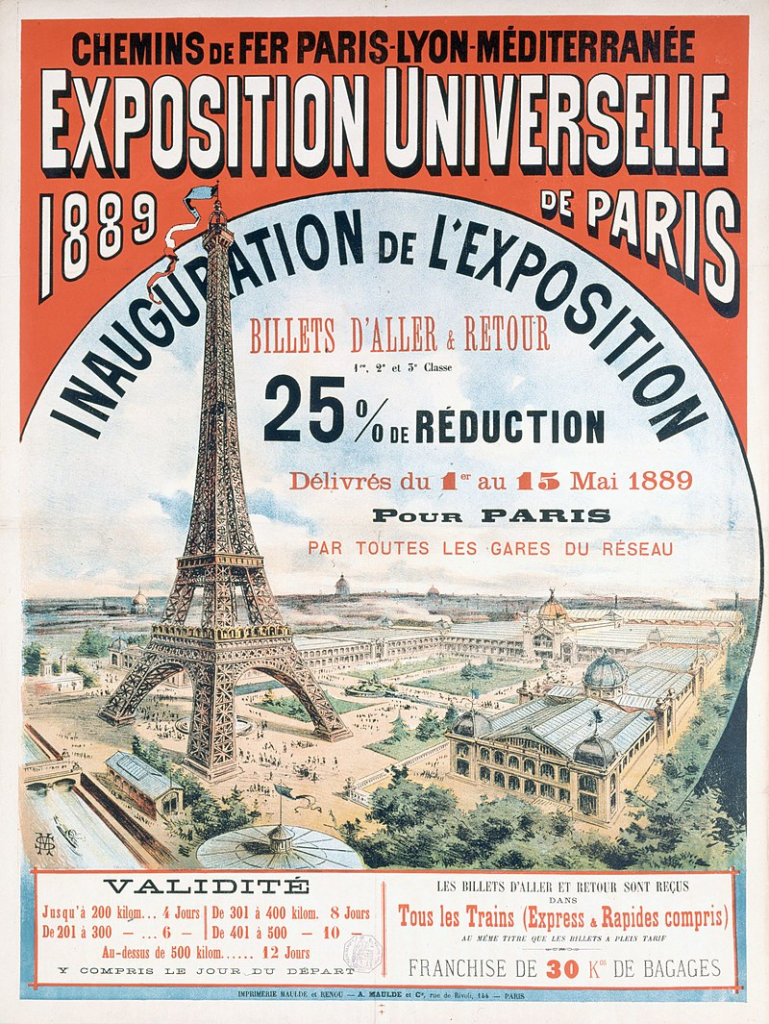
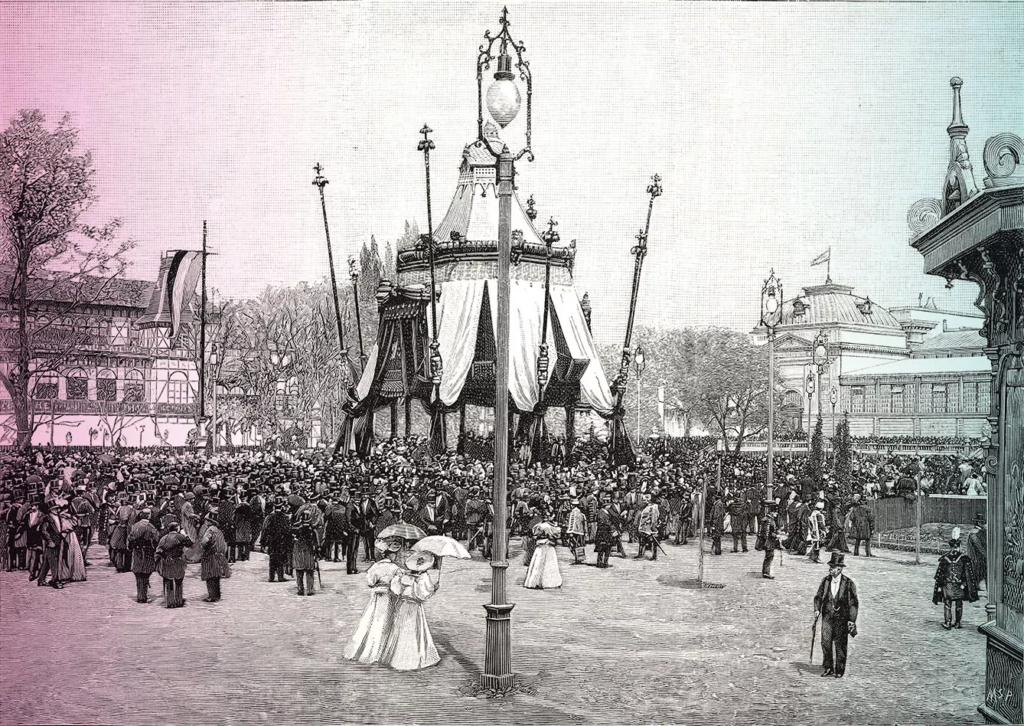
Above: Budapest Millennial Exhibition, 1890
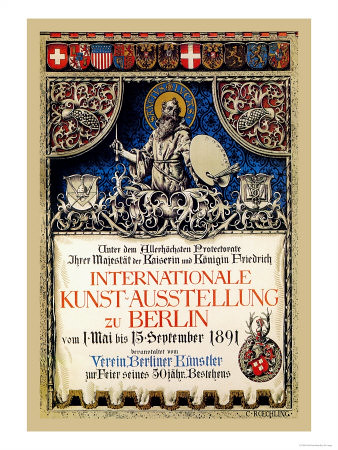
Above: Universal Exhibition, Berlin, 1891
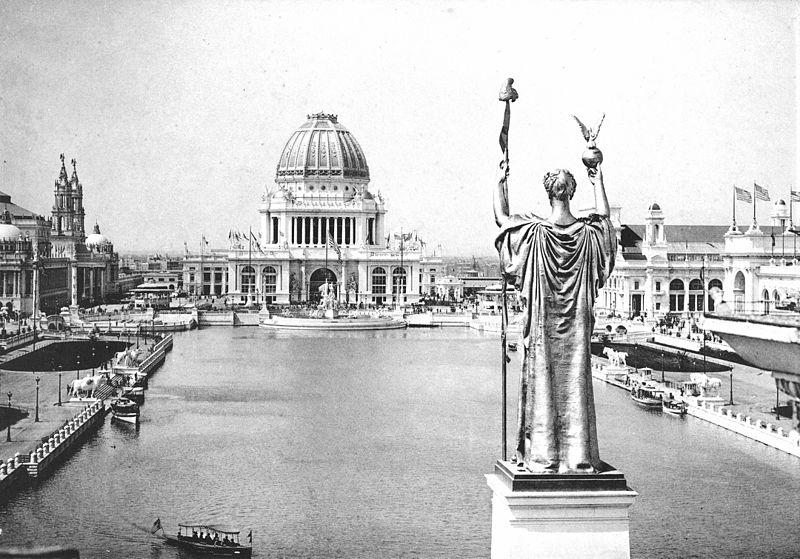
Above: Court of Honor and Grand Basin, 1893 World’s Columbian Exposition, Chicago
His work is represented at some of the most influential museums in the world, with El Prado Museum, in Madrid, holding an important collection.
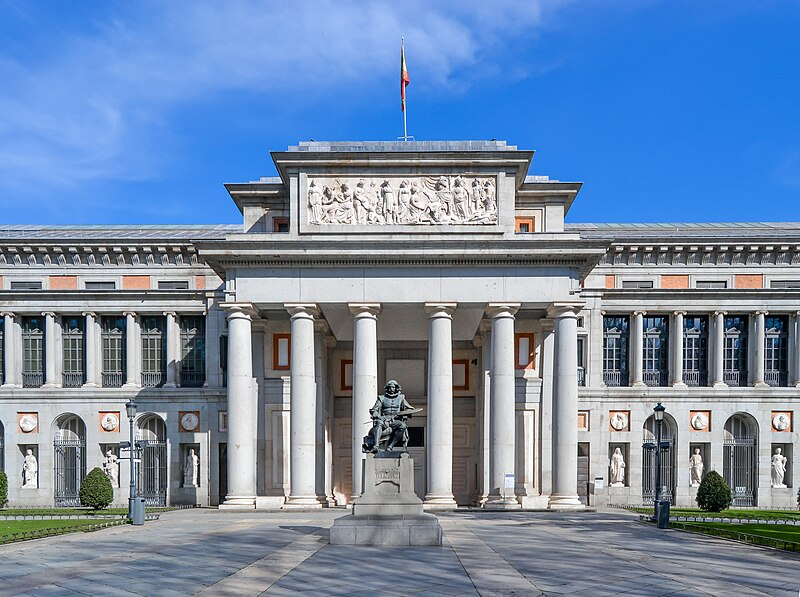
Above: Front façade of Museo del Prado, Madrid, España
Among his masterworks are The Entry of Roger de Flor in Constantinople (1888), The Prince Don Carlos de Viana (1881), The Conversion of the Duke of Gandía (1884) and The Founding of Buenos Aires (1924).
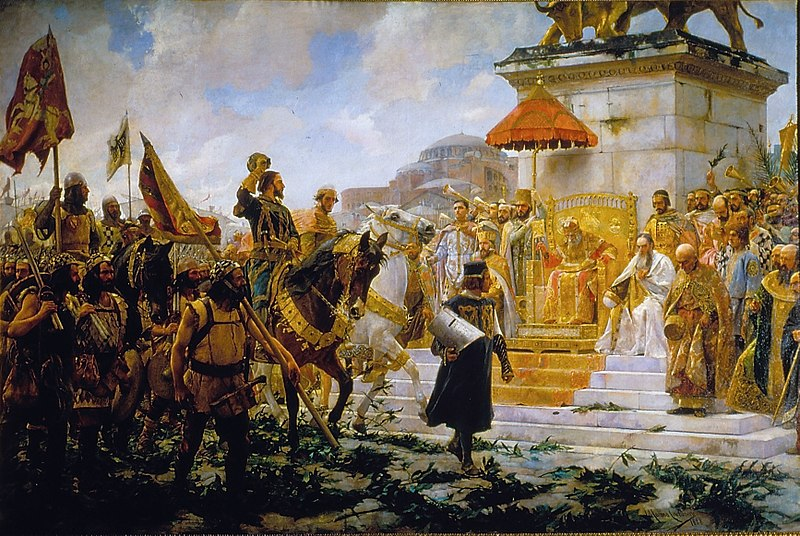
Above: Entrada de Roger de Flor en Constantinopla (The Entry of Roger de Flor in Constantinople), José Moreno Carbonero (1888), Palacio del Senado, Madrid, España
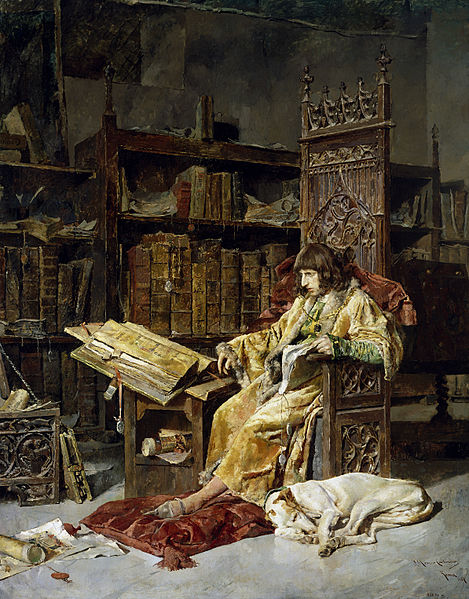
Above: El principe Don Carlos de Viana (The Prince Don Carlos de Viana), José Moreno Carbonero (1881), Museo del Prado, Madrid, España

Above: La conversión del duque de Gandía (The Conversion of the Duke of Gandía), José Moreno Carbonero (1884), Museo del Prado, Madrid, España
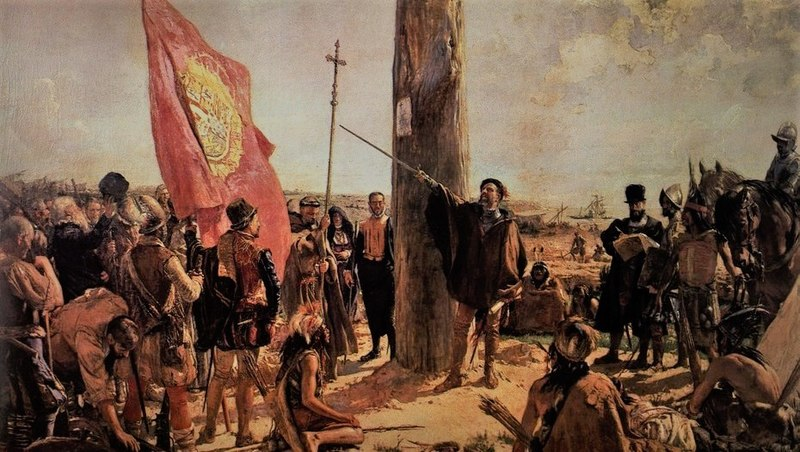
Above: The Founding of Buenos Aires, José Moreno Carbonero (1924), Palacio Municipal de Buenos Aires, Argentina
Moreno Carbonero was born in the Perchel quarter of Málaga, the son of a carpenter.
His exact birthdate has been object of debate, frequently cited as March 1860, but the original birth certificate is conserved and states he was born on 24 March 1858.
A precocious artist, in 1868 he joined the School of Fine Arts in his home town and also took classes in the studio of Bernardo Ferrándiz Bádenes.
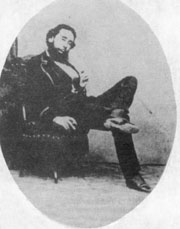
Above: Spanish artist Bernardo Ferrándiz Bádenes (1835 – 1885)
He sold his first painting at age 15 for 2,000 pesetas (an important sum at the time) and came to be known as “el niño Moreno” (the Moreno child) because of his early mastery of oil painting.
Bernardo Ferrándiz was the leading Málaga artist of the moment and introduced his young student to history painting.
Ferrándiz instilled in him his own revolutionary views which he expressed in his historical works by proclaiming a commitment to independence, freedom and nonconformity.
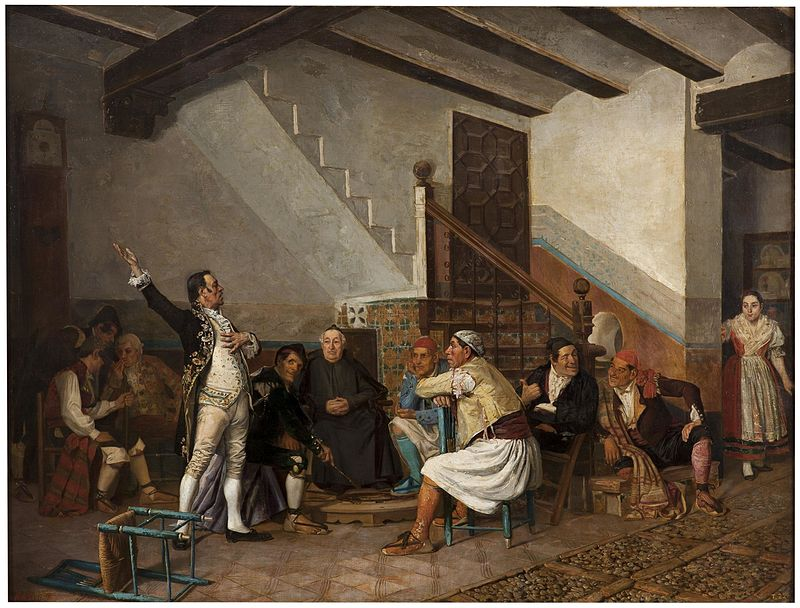
Above: The Political Windbag, Bernardo Ferrándiz (1866), Museo del Prado, Madrid, España
Moreno Carbonero obtained the gold medal in the Exhibition of the Lyceum of Málaga in 1872, being only 14.
In 1873 Moreno Carbonero visited Morocco, where he began to make African-themed paintings, influenced by Mariano Fortuny.
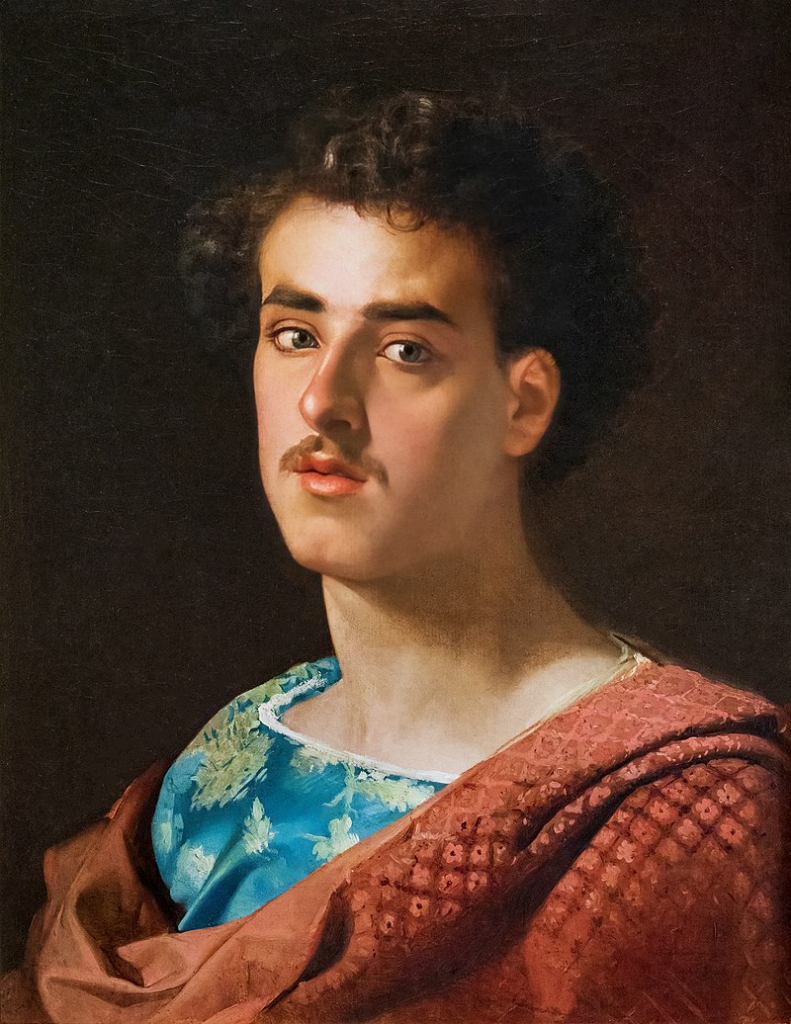
Above: Spanish artist Marià Josep Maria Bernat Fortuny i Marsal (better known as Mariano Fortuny)(1838 – 1874)
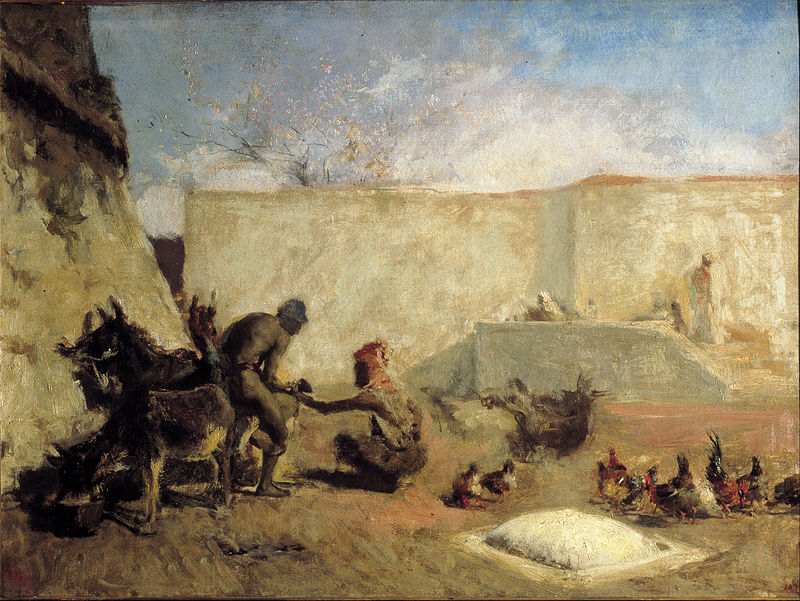
Above: Moroccan Horseshoer, Mariano Fortuny (1870), Museu Nacional d’Art de Catalunya, Barcelona, Catalunya, España
In 1875 he travelled to Paris thanks to a scholarship granted by the local government of Málaga.
In Paris he joined the workshop of the painter Jean-Léon Gérôme, known for his Academic and Orientalist works.
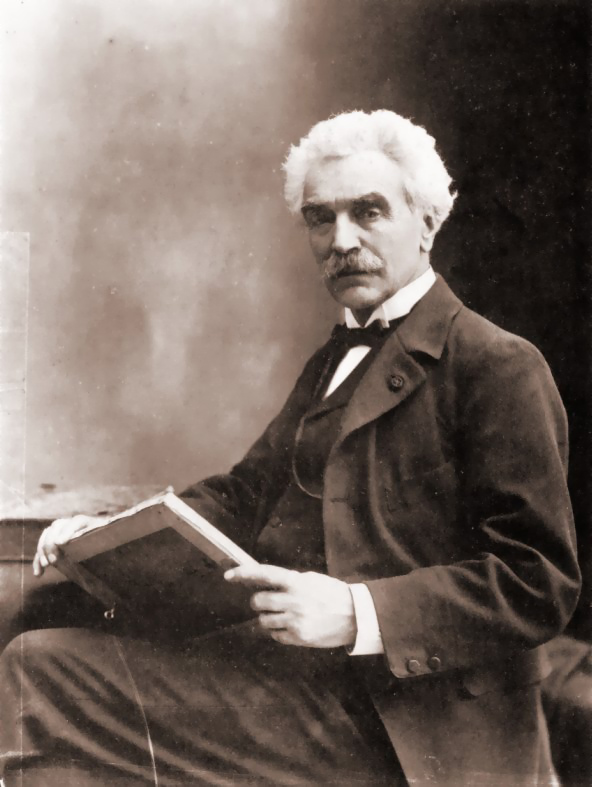
Above: French painter Jean-Léon Gérôme (1824 – 1904)
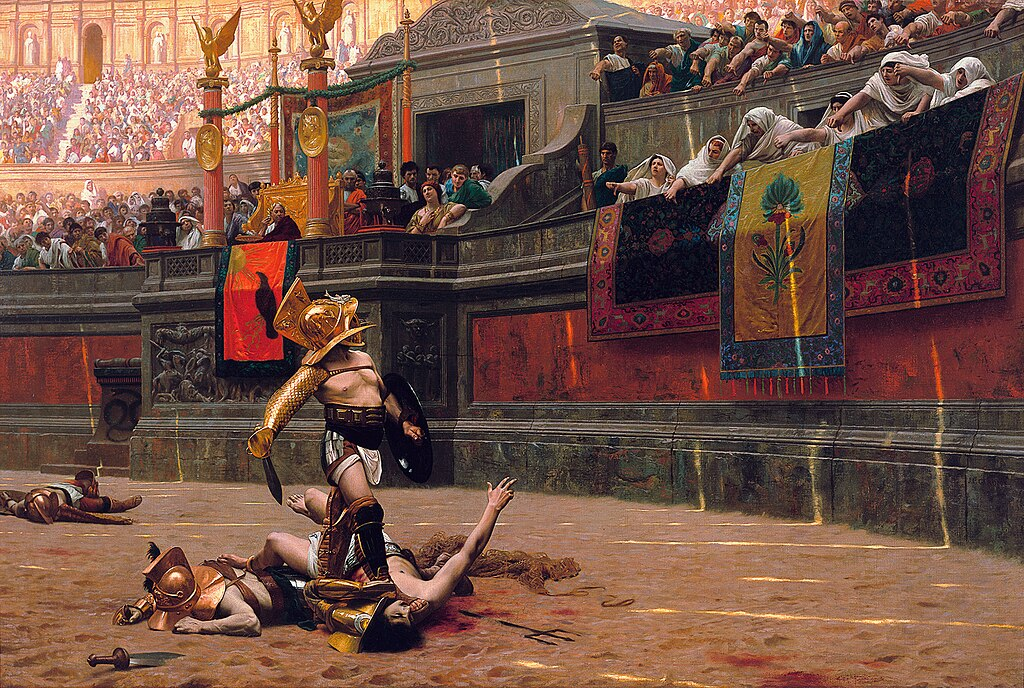
Above: Pollice Verso (Thumbs Down), Jean-Léon Gérôme (1872), Phoenix Art Museum
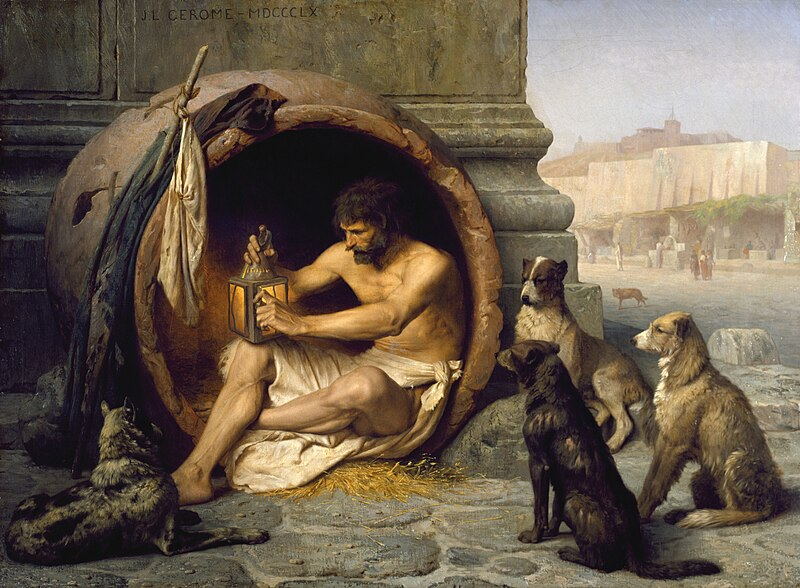
Above: Diogenes, Jean-Léon Gérôme (1860), Walters Art Museum, Mount Vernon, Baltimore, Maryland, USA
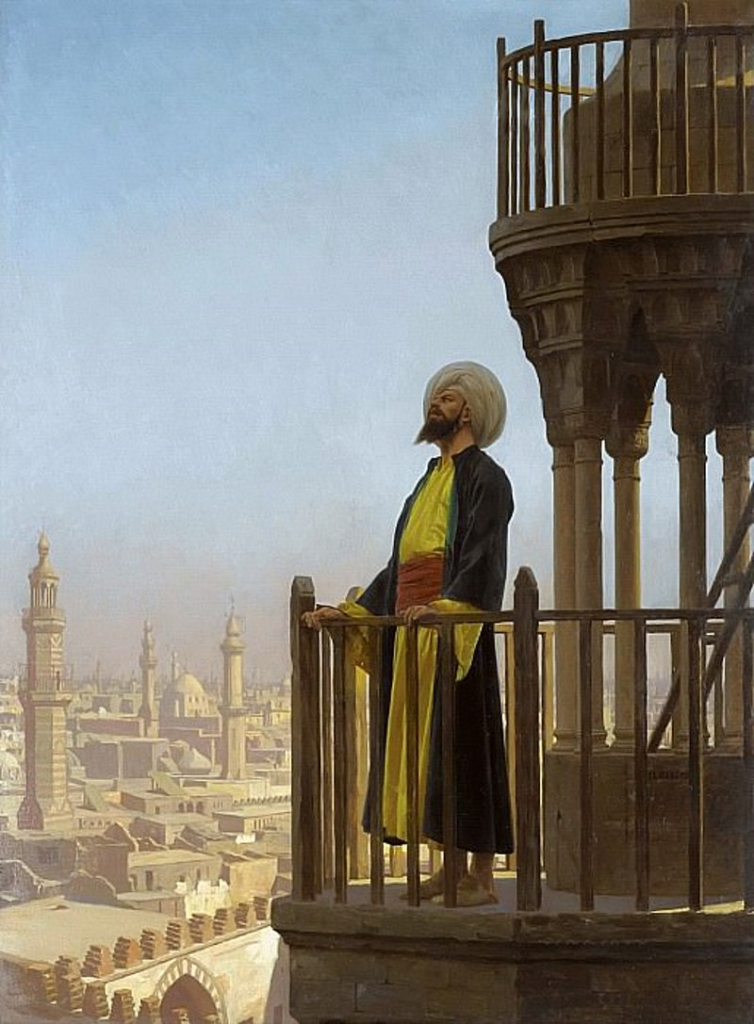
Above: The Muezzin, Jean-Léon Gérôme (1866), Joslyn Art Museum, Omaha, Nebraska, USA
He also got to know the famous art dealer Adolphe Goupil.
Goupil introduced him to the market of small genre paintings referred to in French as tableautins.
In this area he achieved his first successes and developed a virtuoso style comparable to that of Fortuny.
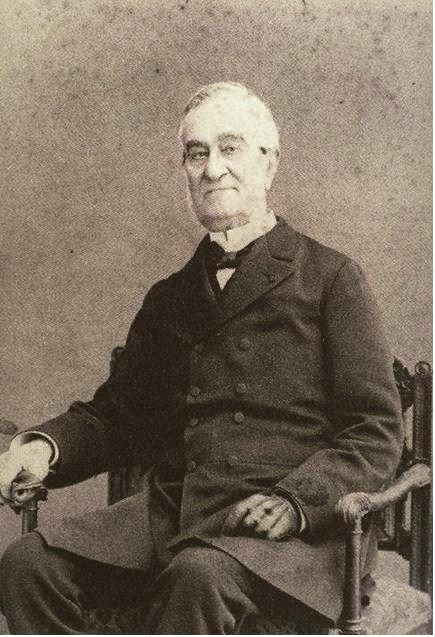
Above: French art dealer Jean-Baptiste Adolphe Goupil (1806 – 1893)
In 1881 Moreno Carbonero went to study in Rome as a boarder on a stipend.
After he returned to Spain, he won gold medals at the national exhibitions in 1881 with his painting The Prince Don Carlos de Viana and in 1884 with The Conversion of the Duke of Gandía, which he had painted during his stay in Rome.

Above: Roma, Italia
As his fame grew, he received commissions from various official institutions.
In 1888 the Spanish Senate commissioned from him the painting The Entry of Roger de Flor in Constantinople, which is considered one of the most spectacular artworks within the genre of historical painting and still decorates the walls of the Conference Hall in the Senate.
For this large-scale painting, that depicts the Italian mercenary Roger de Flor and his troops of Almogavar warriors entering the city to relieve the Byzantine Emperor from the Turkish, Moreno Carbonero extensively researched in Paris about Byzantine architecture, clothes and decoration.
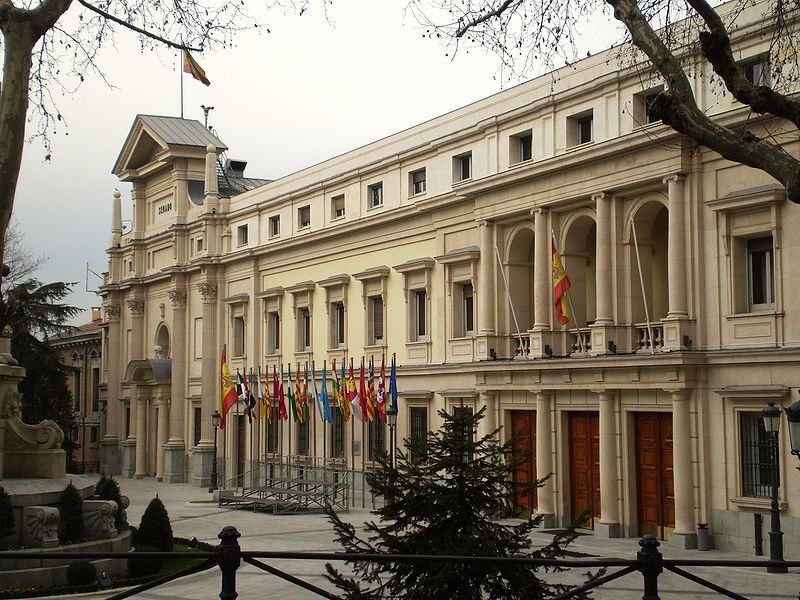
Above: Palacio del Senado, Madrid, España
He used dozens of models to recreate the complete atmosphere in the Málaga bullfighting arena.
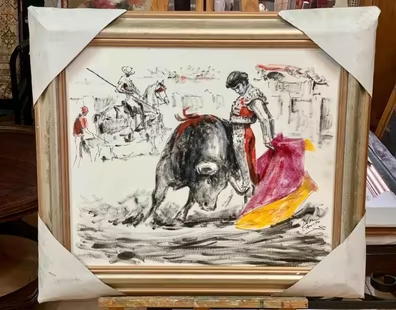
Smaller paintings derived from this work, depicting individual Almogavar warriors, are known to exist.
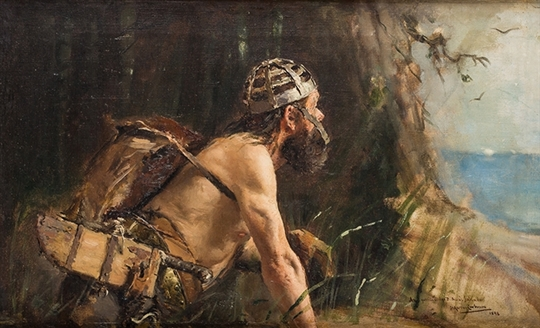
Above: Guerrero Almogávar (Almogávar Warrior), José Moreno Carbonero (1898),
In 1910, the Argentine Government asked him to execute a canvas with the theme of the founding of Buenos Aires to celebrate the 100th anniversary of the revolution of Argentina.
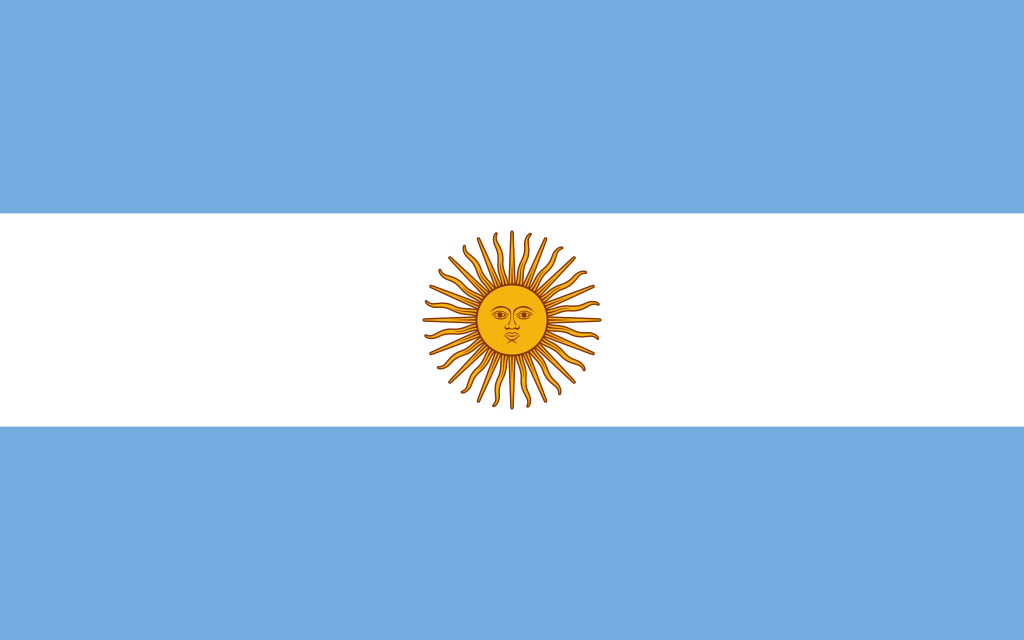
Above: Flag of Argentina
King Alfonso XIII of Spain gave this work as a gift to the city of Buenos Aires.
The King visited the studio of Moreno Carbonero during the creation of the work and kept in the bedroom of the Royal Palace of Madrid a design for the portrait of Juan de Garay, the founder of Buenos Aires, who was depicted in the canvas.
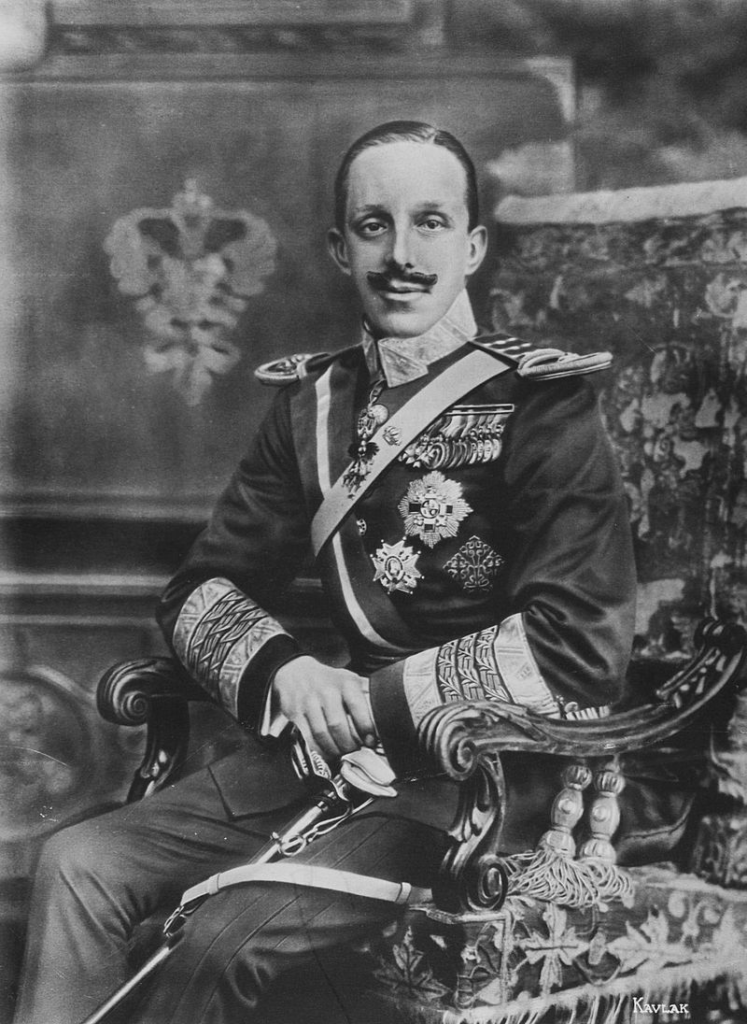
Above: Rey Alfonso XIII de España (1886 – 1941)
José Moreno Carbonero was also awarded in 1888 the highest award in the Vatican Exposition and participated in the International Exhibitions in München (Munich) and Wien (Vienna).
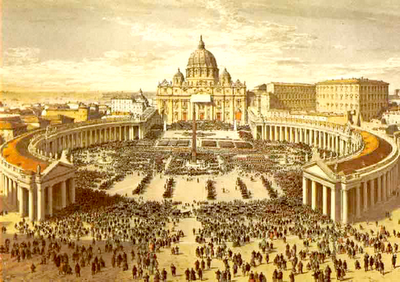
Above: Vatican Exposition, 1888
He obtained a second medal at the Exposition Universelle of Paris in 1889, a great gold medal at the Budapest International Exhibition in 1890, an honorary diploma at the Universal Exhibition of Berlin in 1891 and the only medal at the World’s Columbian Exposition of Chicago in 1893.
From 1892 he taught as Professor of Live Drawing at the Real Academia de Bellas Artes de San Fernando and was also an Academician of the same organisation.
In 1924 he was made Hijo Predilecto.
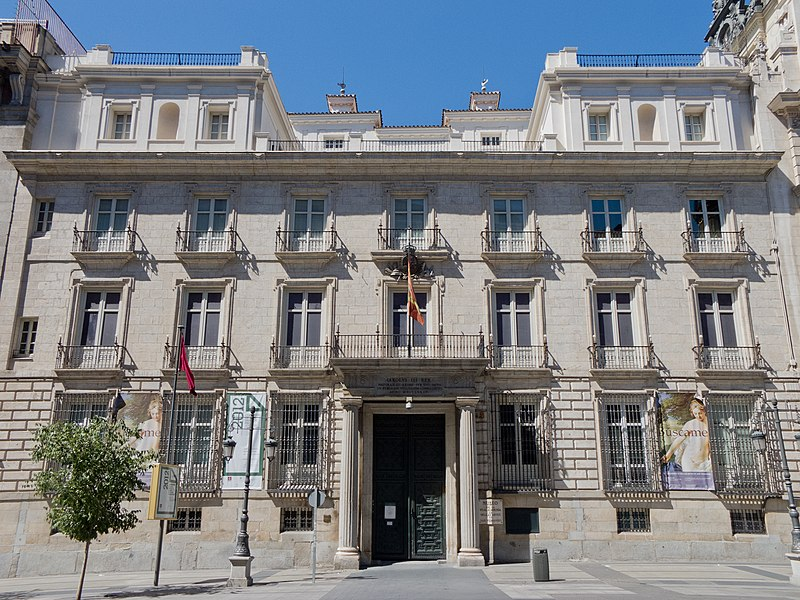
Above: Real Academia de Bellas Artes de San Fernando, Palacio de Goyeneche, Madrid, España
After his death in Madrid on 15 April 1942, his body was transferred to Málaga, where he is buried in the San Miguel Cemetery.
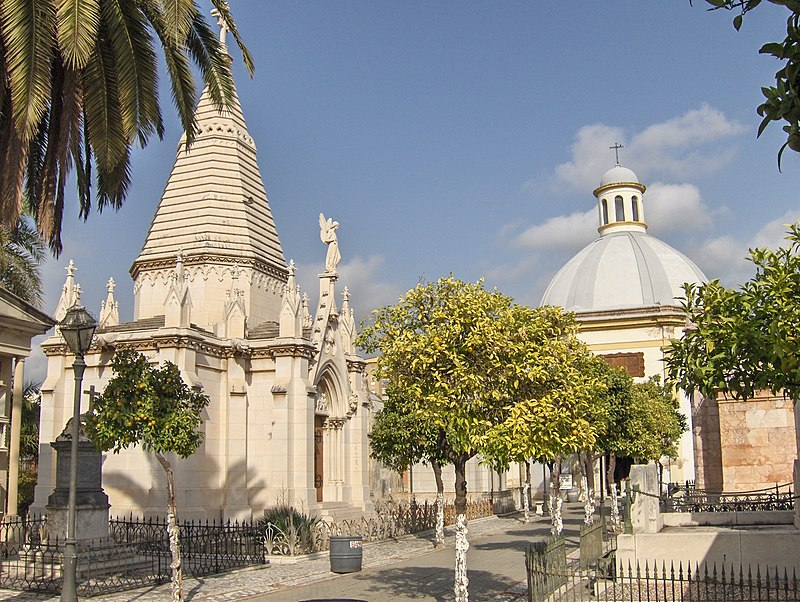
Above: Cementerio de San Miguel, Málaga
In 1958 a monument created by Mariano Benlliure was erected in the Puerta Oscura Gardens to honour the artist.
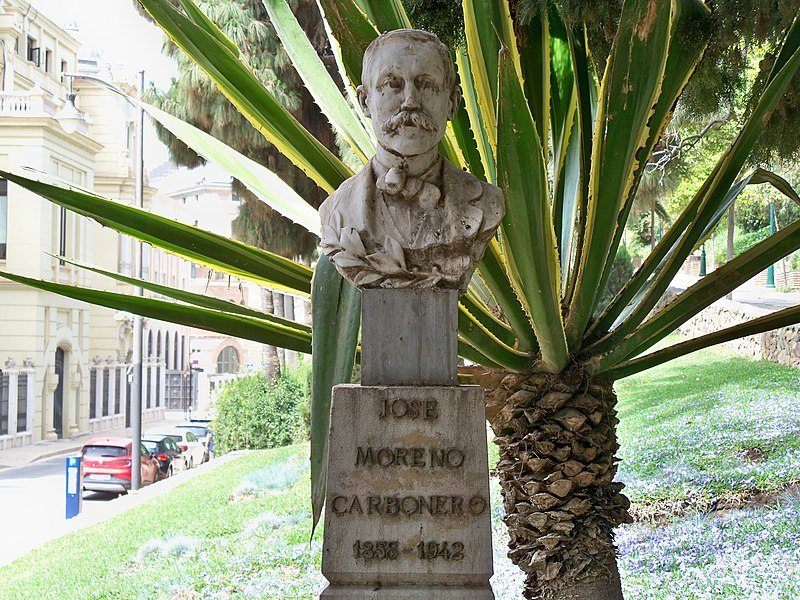
Above: José Moreno Carbonero Monument, Los jardines de Puerta Oscura, Málaga
- Emilio Sala (1850 – 1910)
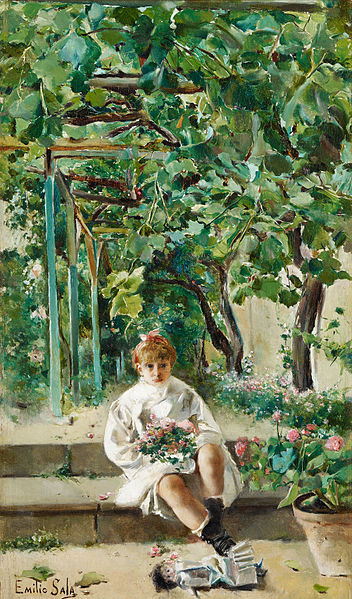
Above: Left Doll, Emilio Sala (1909), Museo Carmen Thyssen, Málaga
- Landscape painters such as:
- Carlos de Haes (1826 – 1898)
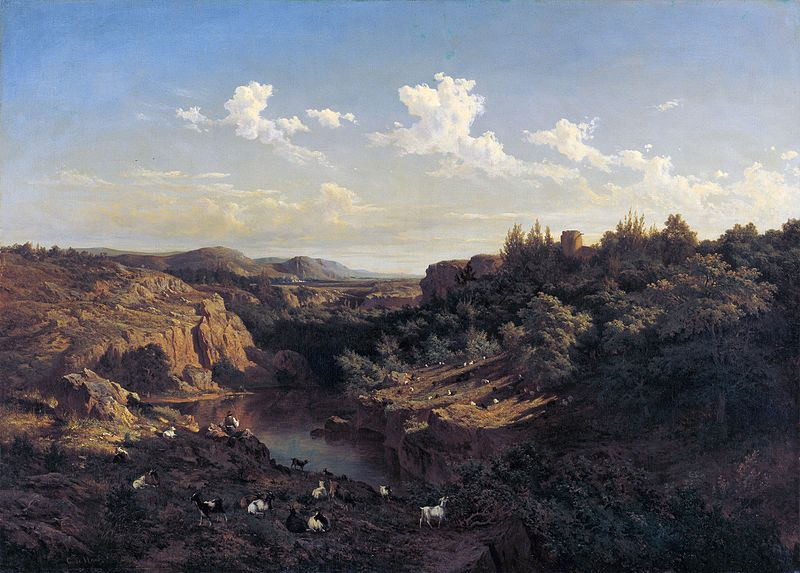
Above: Vista tomada en las cercanías del Monasterio de Piedra (View near Monasterio de Piedra, Aragón), Carlos de Haes (1856), Museo Carmen Thyssen, Málaga
- Martín Rico (1833 – 1908)
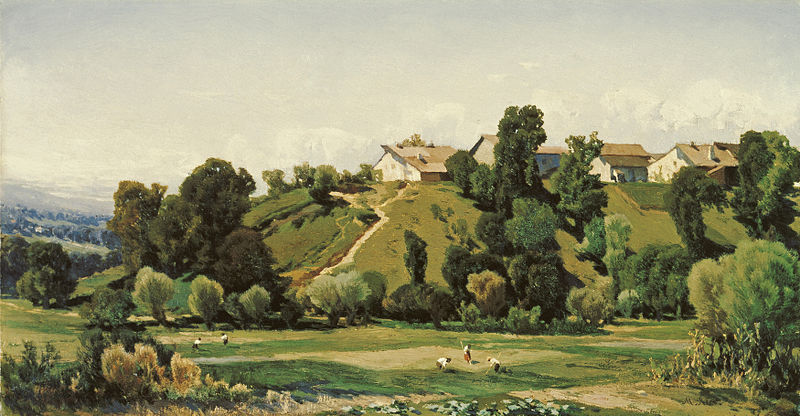
Above: Campesinos (Peasants), Martín Rico (1862), Museo Carmen Thyssen, Málaga
- Emilio Sánchez Perrier (1855 – 1907)
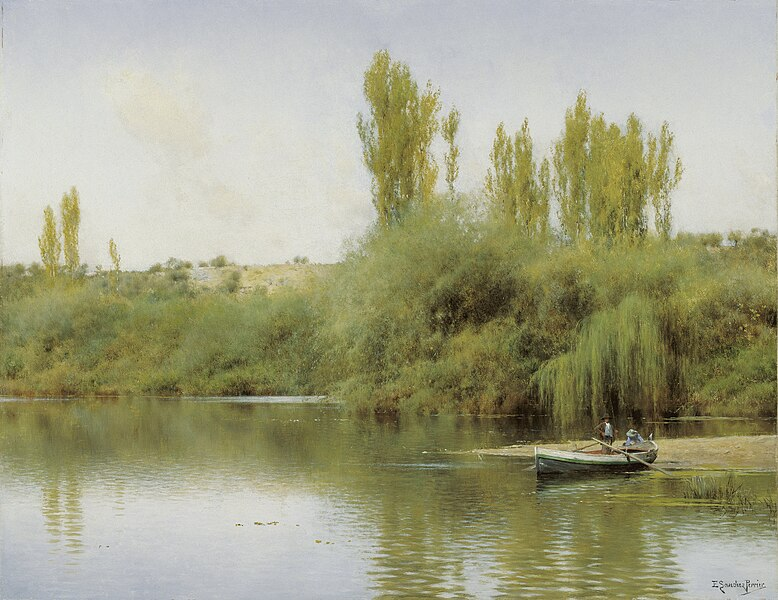
Above: Orilla del Guadaíra con barca (Bank of the Guadaira with Boat), Emilio Sánchez Perrier (1890), Museo Carmen Thyssen, Málaga
- Fin de Siècle, which reveals how Spanish painting at the end of the 19th century began to openly dialogue with international painting.
- Some of its exponents are:
- Joaquín Sorolla (1863 – 1923)
- Some of its exponents are:
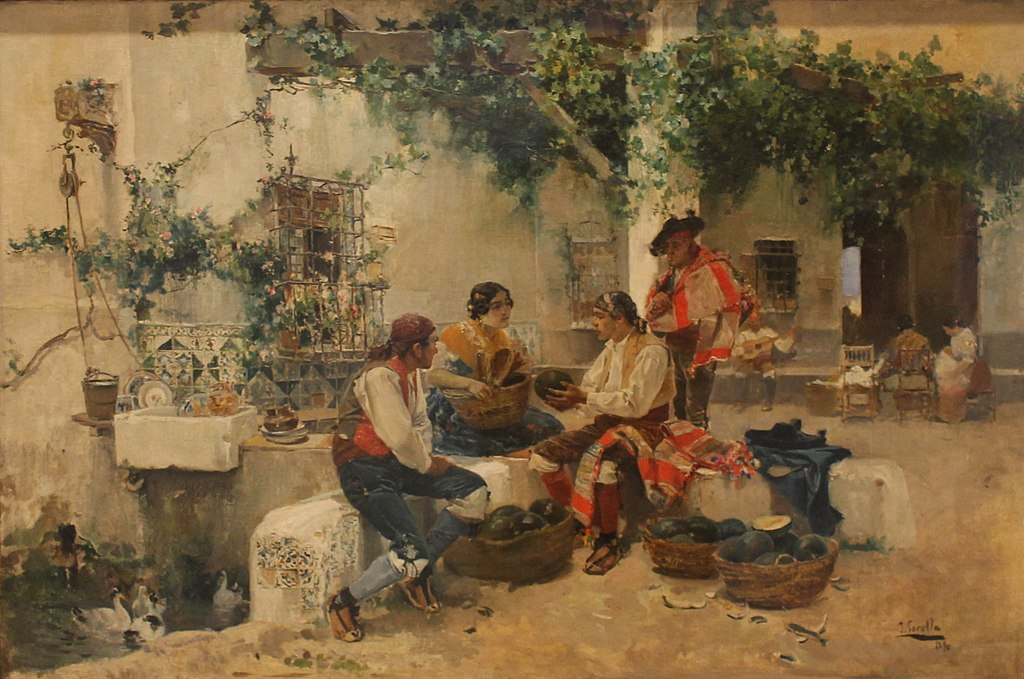
Above: Vendiendo melones (Selling melons), Joaquín Sorolla (1890), Museo Carmen Thyssen, Málaga
- Aureliano de Beruete (1845 – 1912)
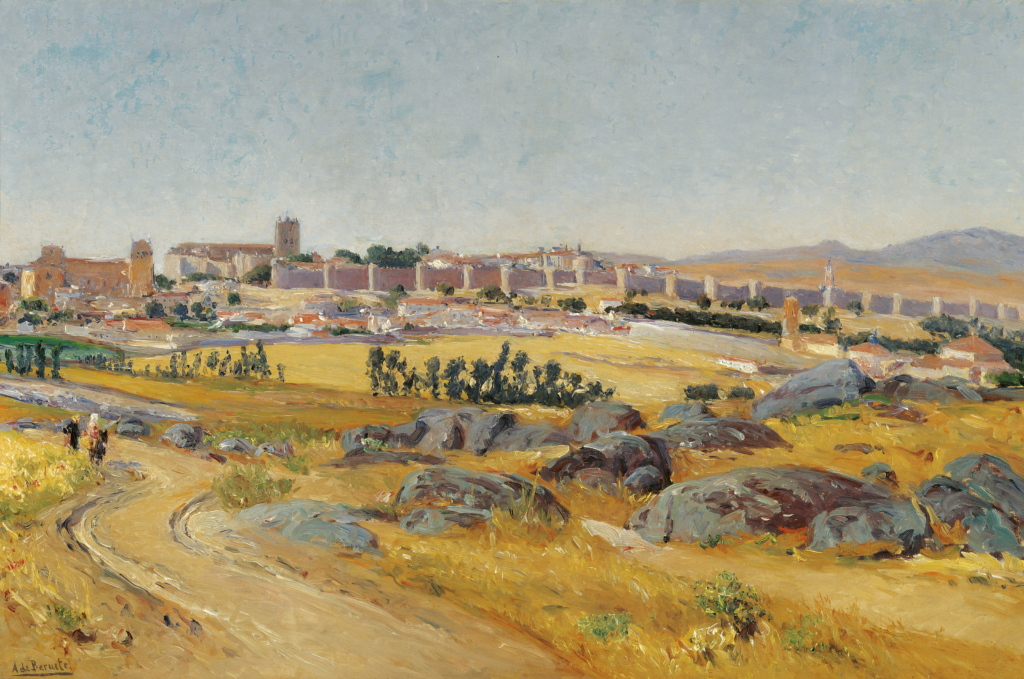
Above: Avila, Aureliano de Beruete (1909), Museo Carmen Thyssen, Málaga
- Darío de Regoyos (1857 – 1913)
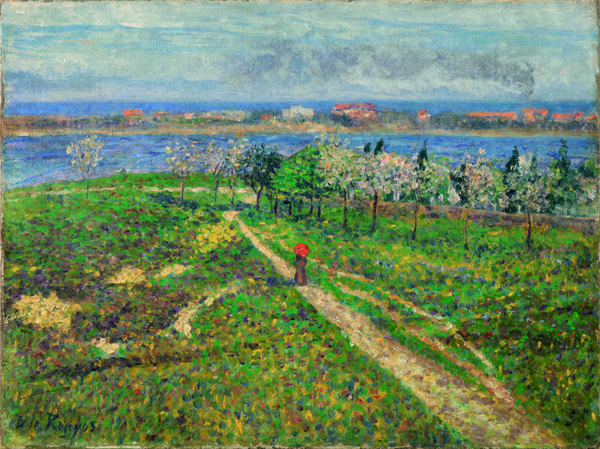
Above: Almendros en flor (Almond trees in bloom), Darío de Regoyos (1905), Museo Carmen Thyssen, Málaga
- Ramón Casas (1866 – 1932)
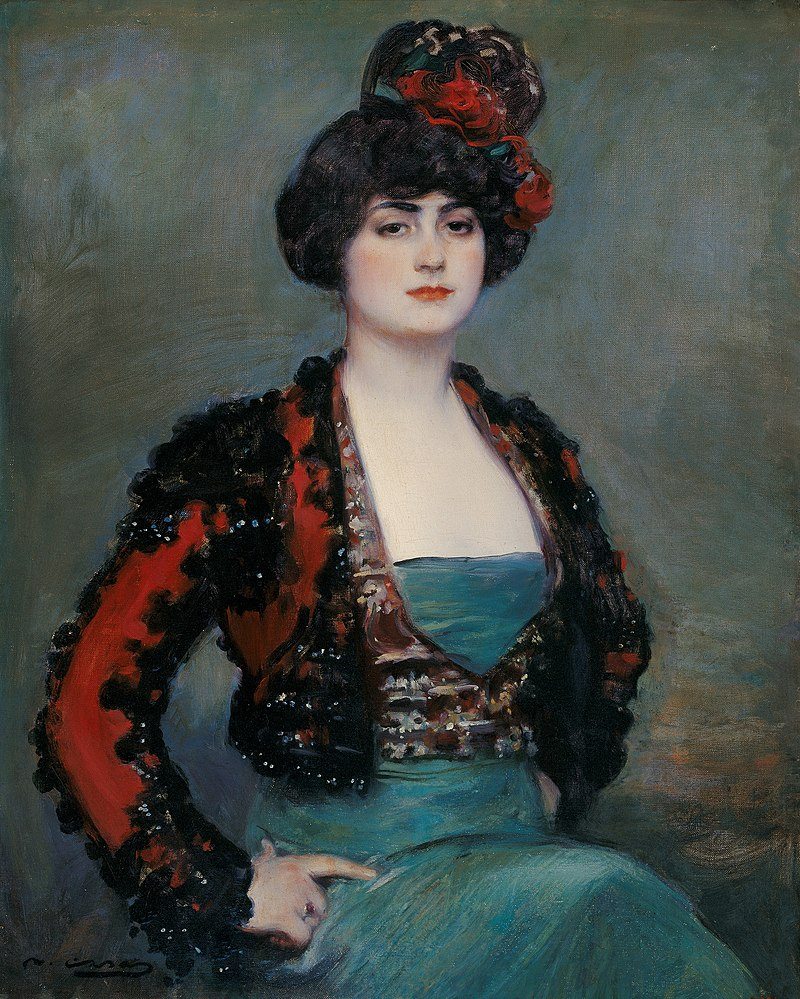
Above: Julia, Ramón Casas (1915), Museo Carmen Thyssen, Málaga
- Ricard Canals Llambí (1876 – 1931)
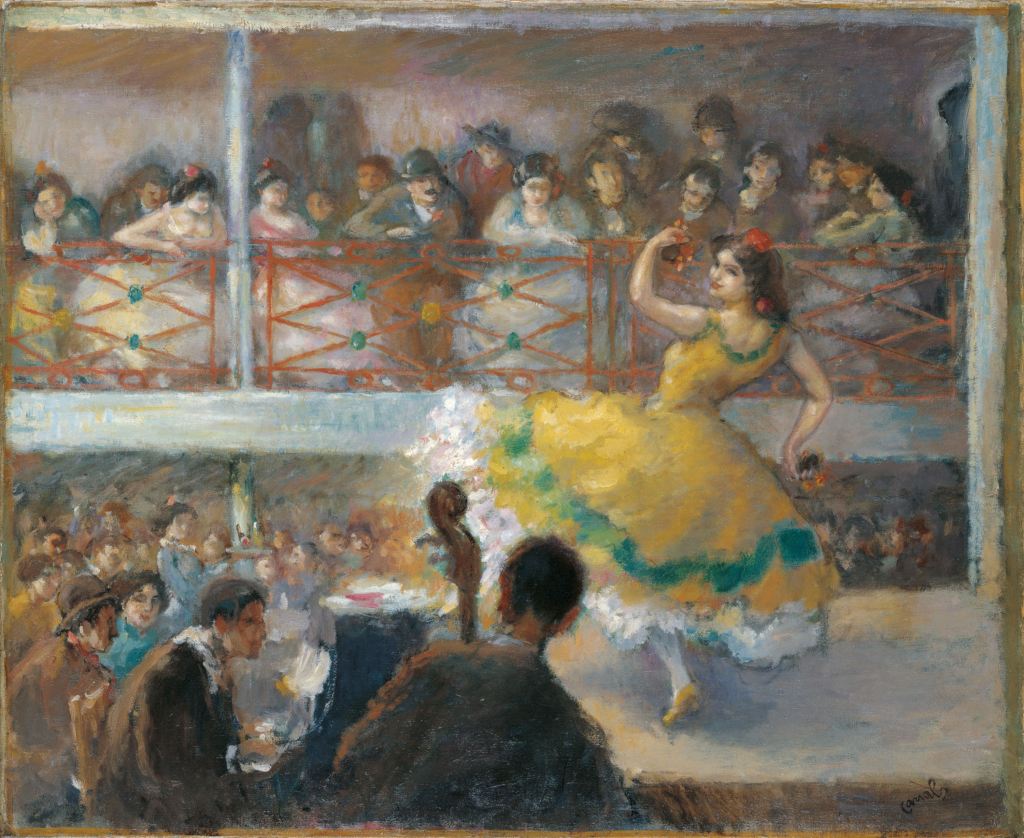
Above: Flamenco Dance, Ricard Canals Llambí, Museo Carmen Thyssen, Málaga
- Francisco Iturrino (1864 – 1924)
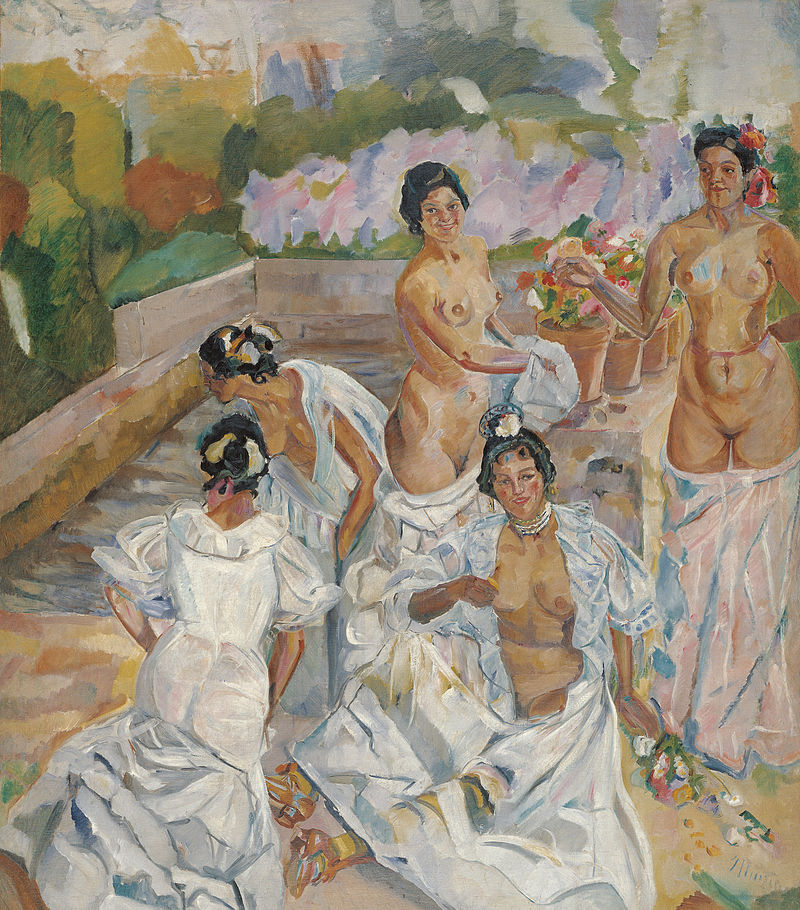
Above: The Bath (Seville), Francisco Iturrino, Museo Carmen Thyssen, Málaga
- José Gutiérrez Solana (1886 – 1945)
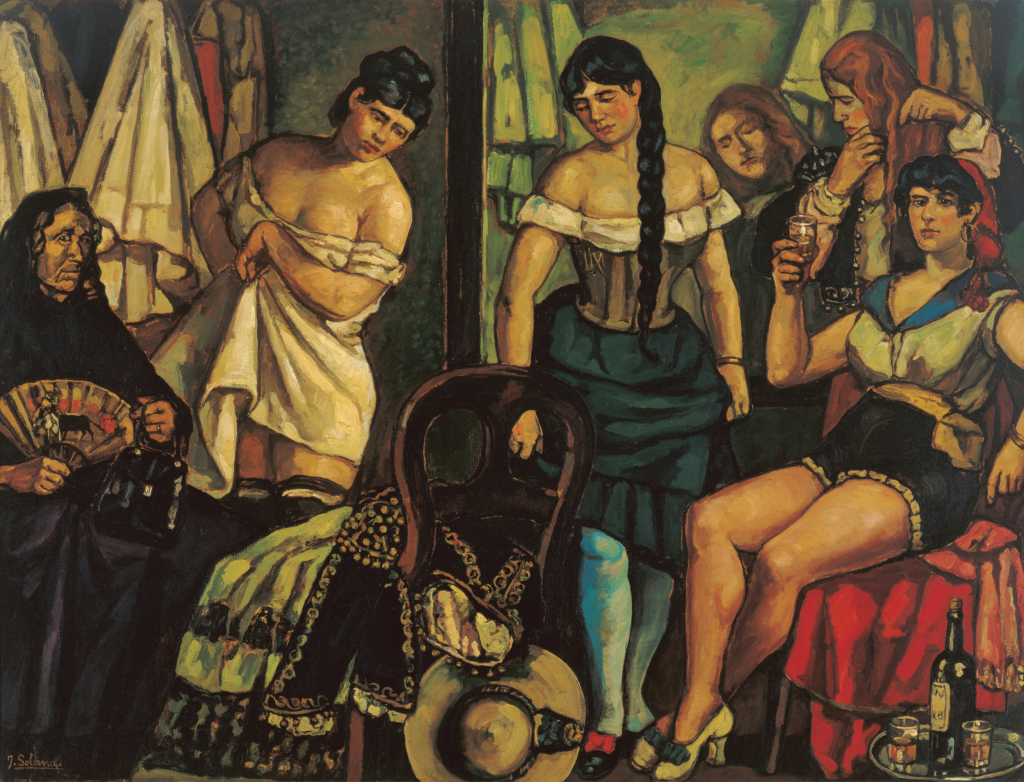
Above: Las coristas (Chorus Girls), José Gutiérrez Solana (1926), Museo Carmen Thyssen, Málaga
- Ignacio Zuloaga (1870 – 1945) and Julio Romero de Torres (1874 – 1930) deserve special mention in this period.
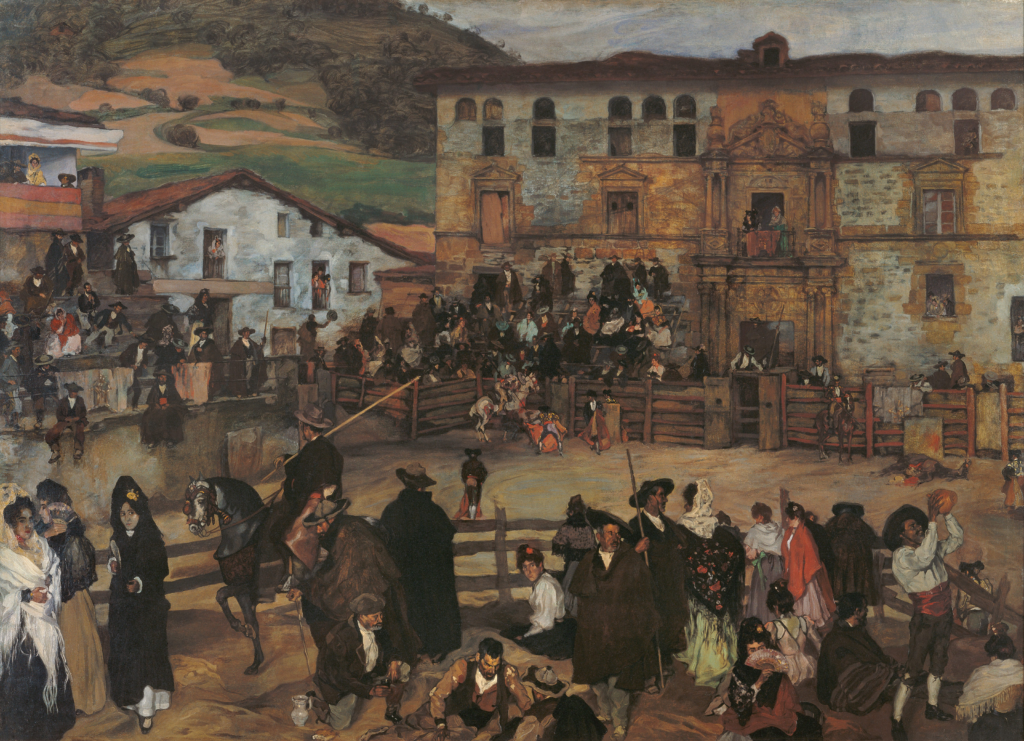
Above: Bullfight in Éibar, Ignacio Zuloaga (1899), Museo Carmen Thyssen, Málaga
Since its inception, the Museo has organized temporary exhibitions focusing mainly on 19th and 20th century art and has several exhibition spaces.
Sixteen temporary exhibitions have been organized in the main exhibition hall.
Thematic exhibitions have predominated (landscape, Spanish Pop Art, Spanish realism, cubism, the Mediterranean, among other themes) and monographic exhibitions dedicated to artists from the museum’s collection such as:
- Hermenegildo Anglada-Camarasa (1871 – 1959)
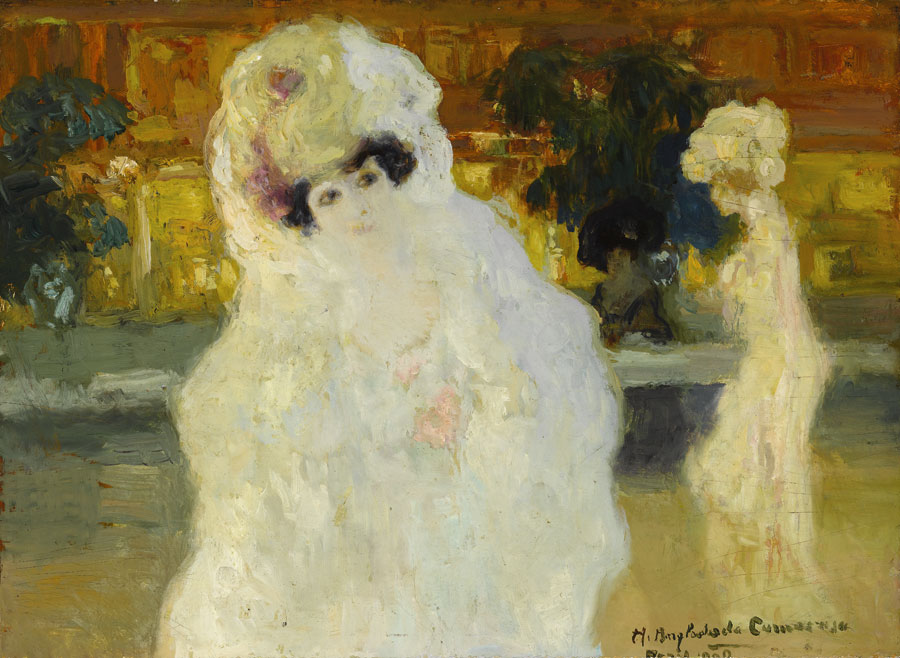
Above: Blanquita, Hermenegildo Anglada-Camarasa (1902), Museo Carmen Thyssen, Málaga
- Julio Romero de Torres (1874 – 1930)
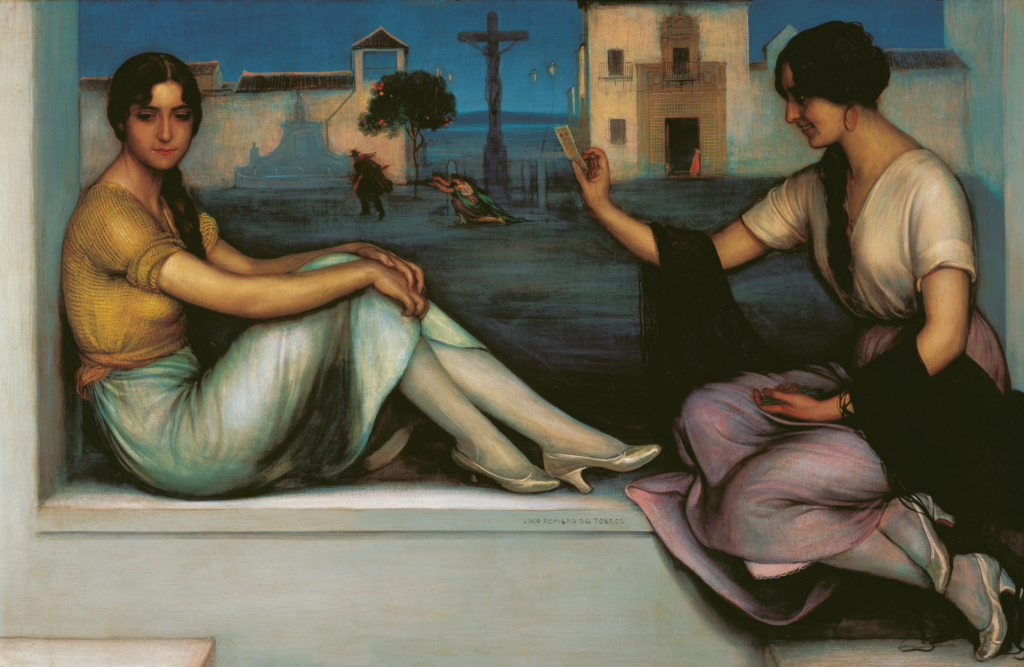
Above: The Fortune-telling, Julio Romero de Torres (1920), Museo Carmen Thyssen, Málaga
- Darío de Regoyos (1857 – 1913)
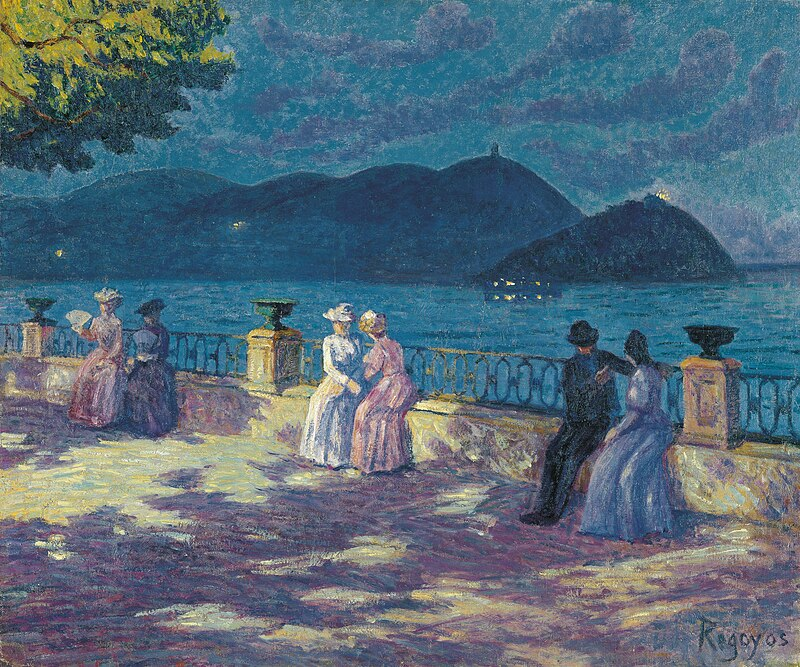
Above: La Concha, nocturno, Darío de Regoyos (1906), Museo Carmen Thyssen, Málaga
- Ramón Casas (1866 – 1932)
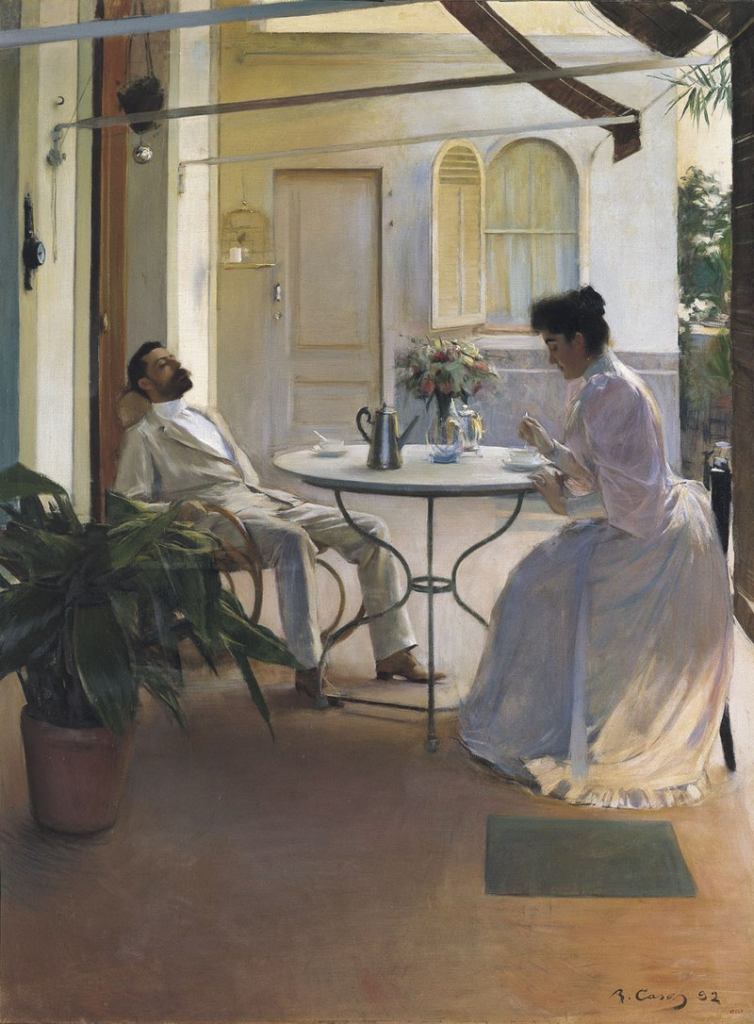
Above: Interior a l’aire lliure (Interior in the Open Air), Ramón Casas (1892), Museo Carmen Thyssen, Málaga
- Francisco Iturrino (1864 – 1924)
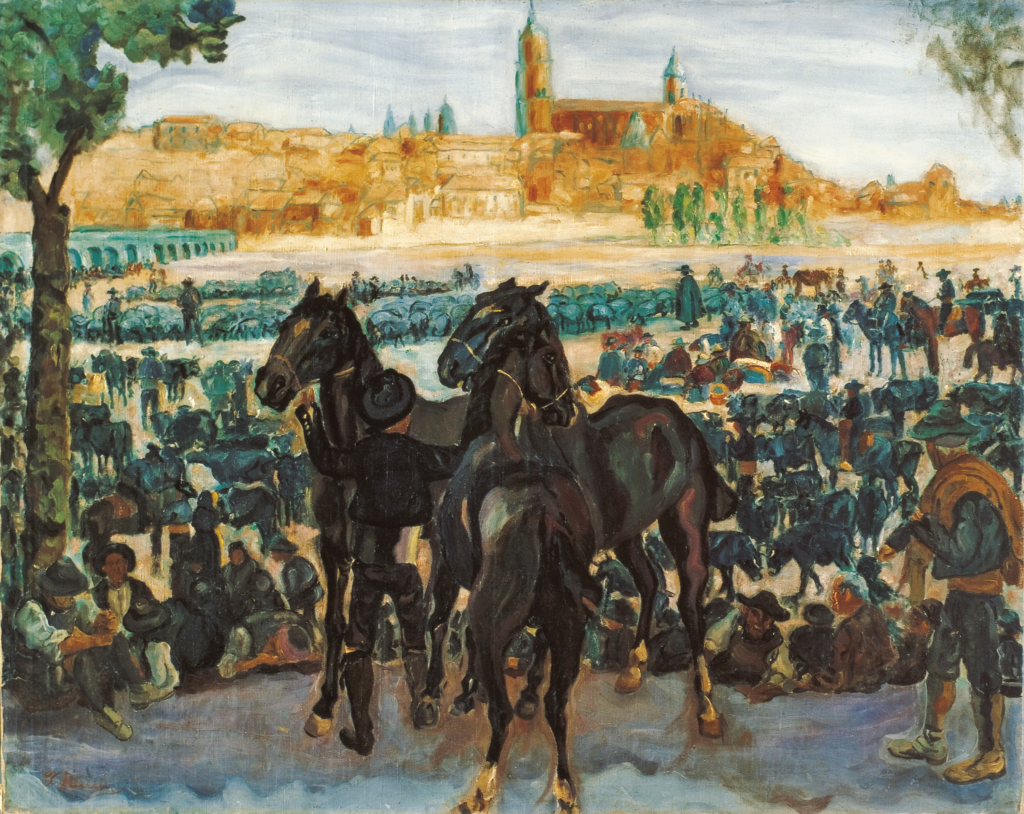
Above: Cattle fair in Salamanca, Francisco Iturrino (1898), Museo Carmen Thyssen, Málaga
The Museo has expanded its exhibition offer with the use of the Noble Room of the Palacio Villalón, where small exhibitions are presented, among which stand out:
- Sorolla: Notes from New York (27 September 2016 – 8 January 2017)
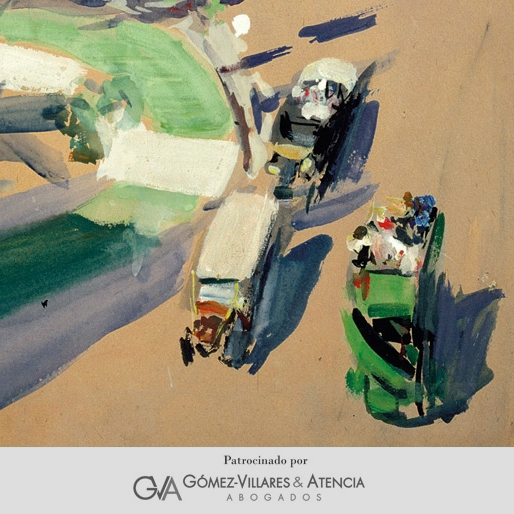
- Japan: Engravings and objects of art (31 January to 23 April 2017)
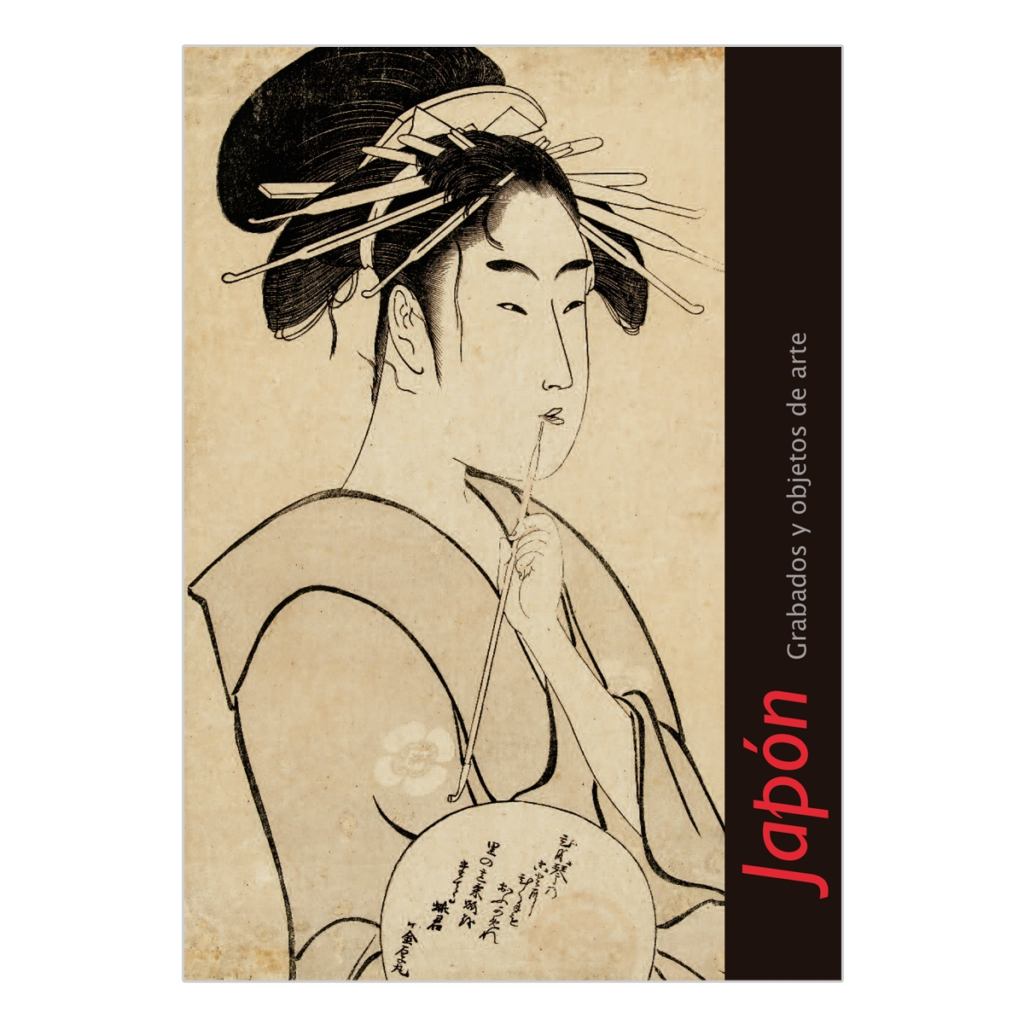
- Goya – Ensor: Dreams in flight (27 October 2017 to 28 January 2018)
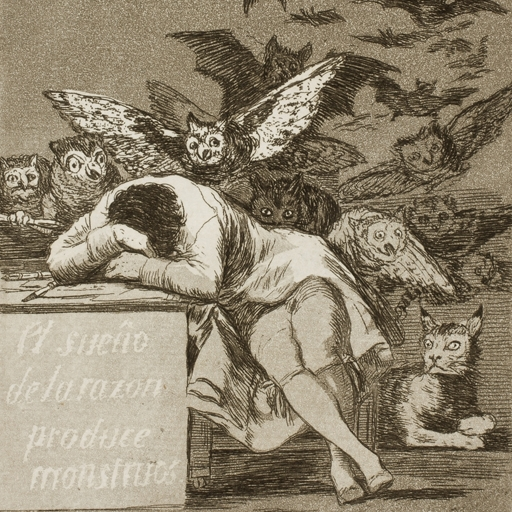
- Gustave Doré: Traveller through Andalusia (6 April – 15 July 2018)

- Henri Matisse: Jazz (11 October 2018 – 13 January 2019)
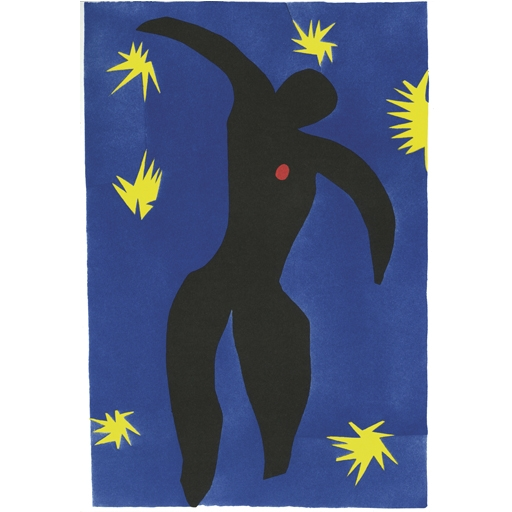
“What is art
But life upon the larger scale, the higher,
When, graduating up in a spiral line
Of still expanding and ascending gyres,
It pushed toward the intense significance
Of all things, hungry for the Infinite?
Art’s life—and where we live, we suffer and toil.“
Elizabeth Barrett Browning
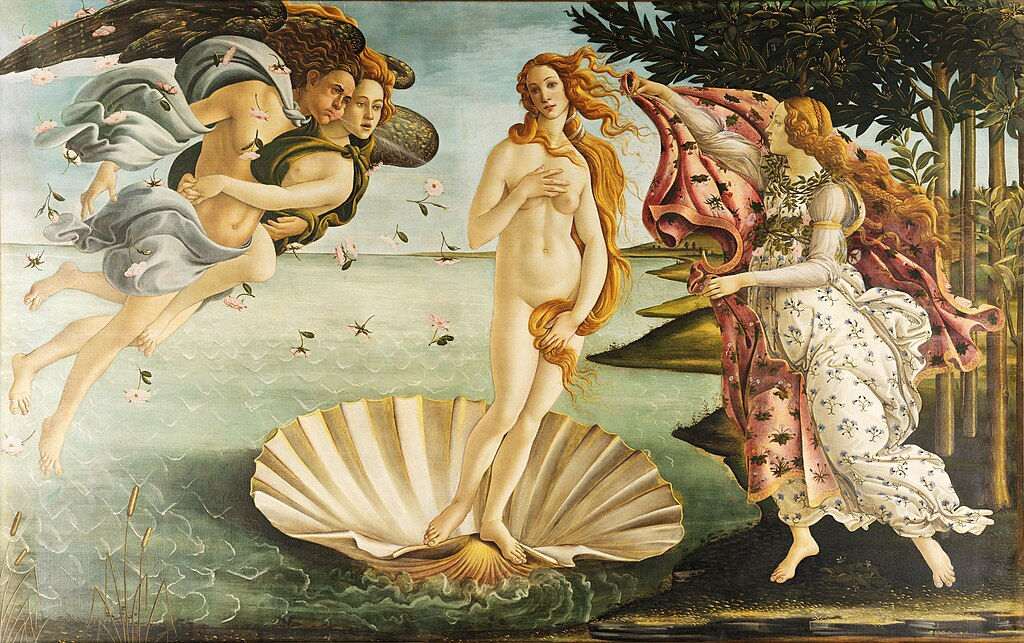
Above: La nascita di Venere (The birth of Venus), Sandro Botticelli (1485)
The excavations at the Palacio Villalón have provided interesting information about the city’s past history.
Built at the beginning of the 14th century, the Palacio was the residence of various aristocratic families, such as the Villalón and Mosquera families, from whose surnames it owes its name.
The archaeological project for the Palacio was developed gradually over several years.
According to José María Gómez Aracil, who heads the municipal office that controls and coordinates the works at the Museo, there is no archaeological site of this size in Málaga.
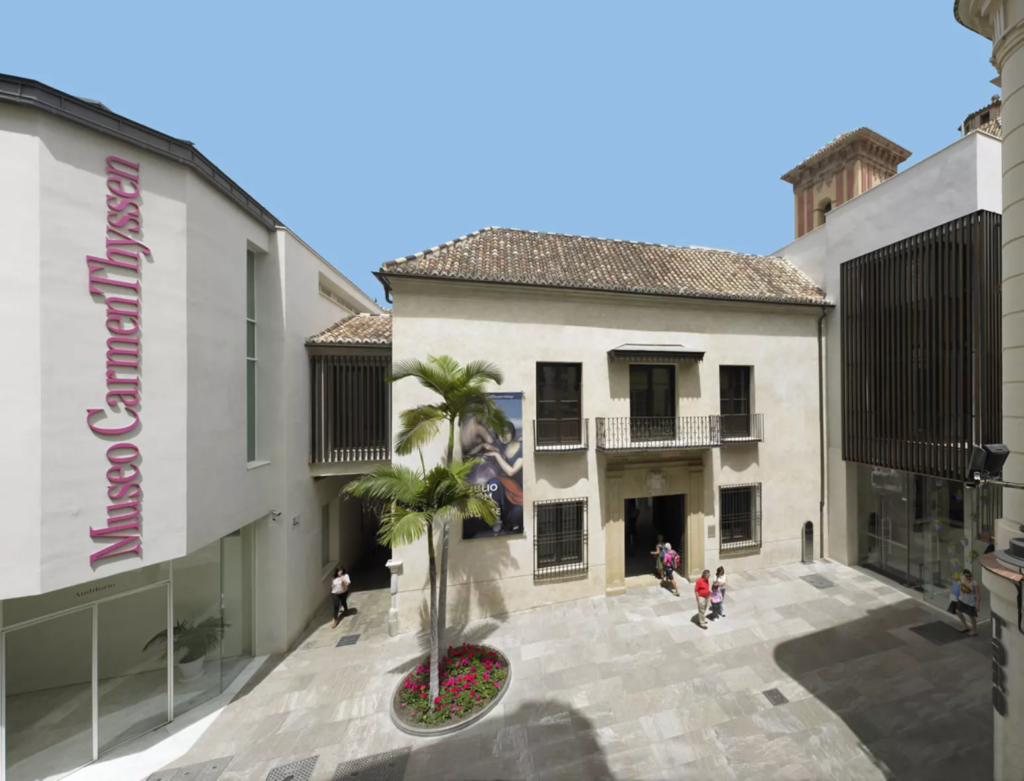
Above: Museo Carmen Thyssen, Málaga
“History is the sum total of things that could have been avoided.“
Konrad Adenauer
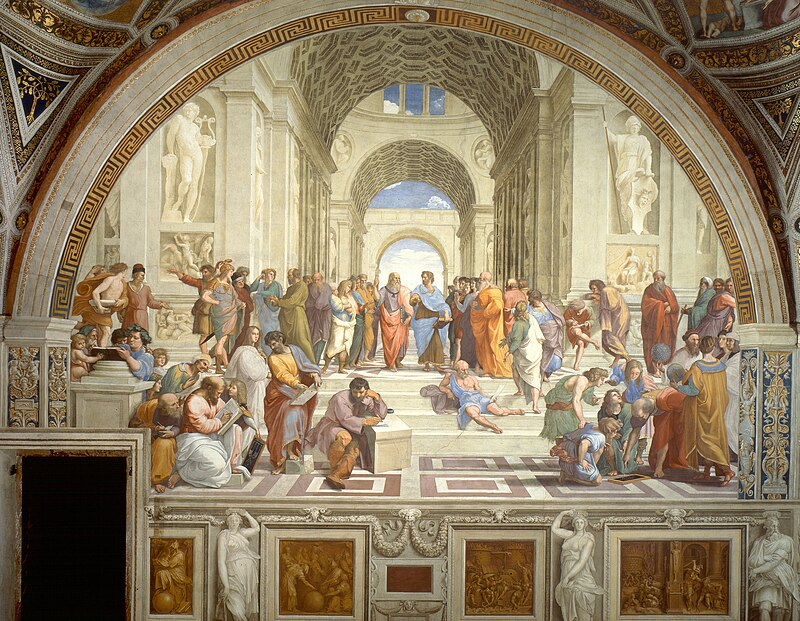
Above: Scuola di Atene, (The School of Athens), Raphael Sanzio da Urbino (1511)
In Phase I (until the last quarter of the 1st century) of excavations, the most notable are the fragment of Italic terra sigillata dated between the years 15 and 90, another fragment of an African terra sigillata plate from 75 to 150 AD, and two fragments of terra sigillata hispanica dated between 40 and 150.
Phase II (late 1st century – early 3rd century) reveals the basic structure of the occupation levels, where domestic spaces with associated facilities are differentiated.
During Phase III (early 3rd century – mid 4th century) it is confirmed that these spaces remained in use until the 4th century, when the abandoned and destroyed building complex occurred.
Thanks to the research of Phase IV (second half of the 4th century – first half of the 5th century) it is confirmed that during the second half of the 4th century there was a revitalization of the area.
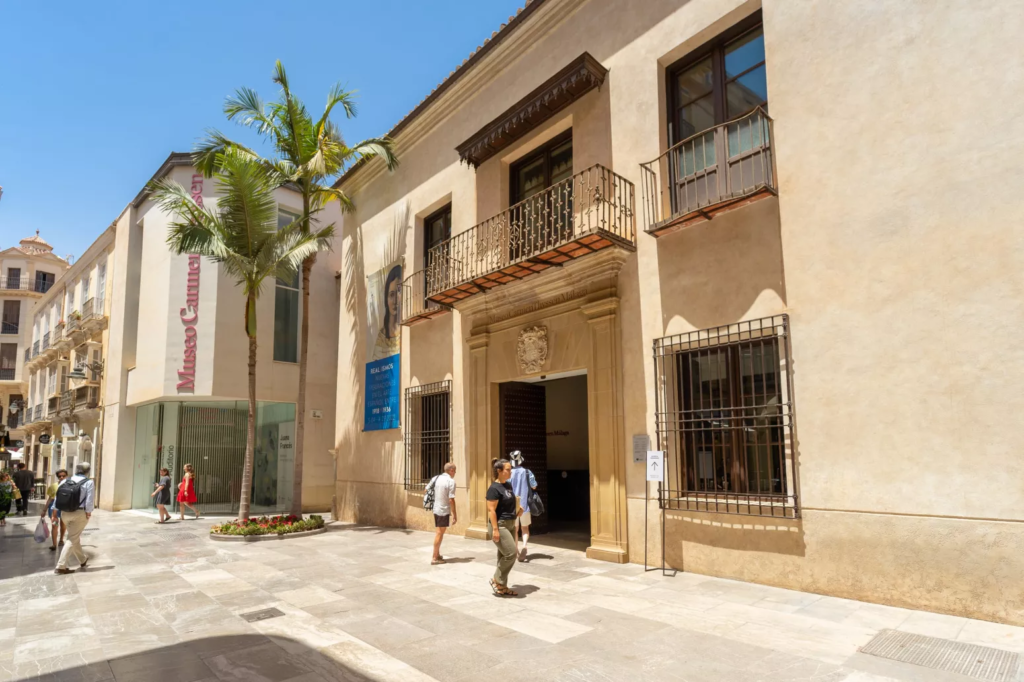
Above: Museo Carmen Thyssen, Málaga
“Escapists take refuge in cliches such as “Human nature will never change” and “History always repeats itself”.
Nevertheless, human nature is changing before our eyes, and quite new history is being made.
This century has seen world wars for the first time.
It has seen a world civilization threatened with self-destruction, not only through war but through the exploitation of all the kingdoms in nature.
It has also seen the beginnings of international alignment and collaboration.
It has seen the leaders of the people struggling with great patience to work out a new political approach from the ‘world’ angle.
It has seen the people themselves taking increasing individual and collective action in order to obtain a world organization or government, a universal religion, or a universal language.
Let us avoid being misled by the apparent irresponsibility of the crowd with its absorption in crime films, dog racing and gambling, and its immorality and apathy.
It is traditional for the outstanding leaders of humanity to work for the shaping of history.
It is a new procedure when a large and ever growing section of the public begins to take responsibility for the trend of evolution to such purpose that the community is increasingly honeycombed with progressive movements of every possible kind.
This is the new element in history which constitutes a mighty landmark in the development of mankind.“
Vera Stanley Alder
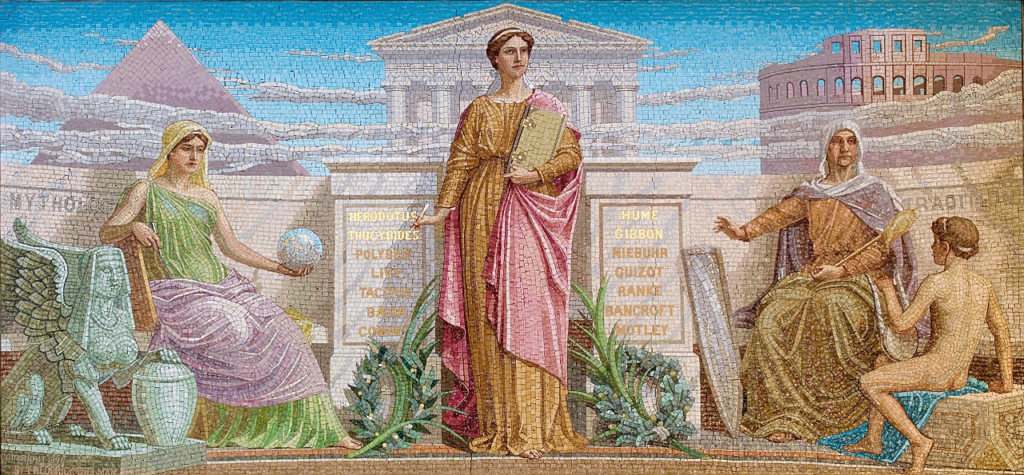
Above: History, Frederick Dielman (1896), House Members Room, Library of Congress, Thomas Jefferson Building, Washington DC
One of the most striking discoveries made during archaeological excavations in the subsoil is the remains of a monumental fountain built at the end of the 1st century, partially exhumed, which presents a high-quality pictorial decoration.
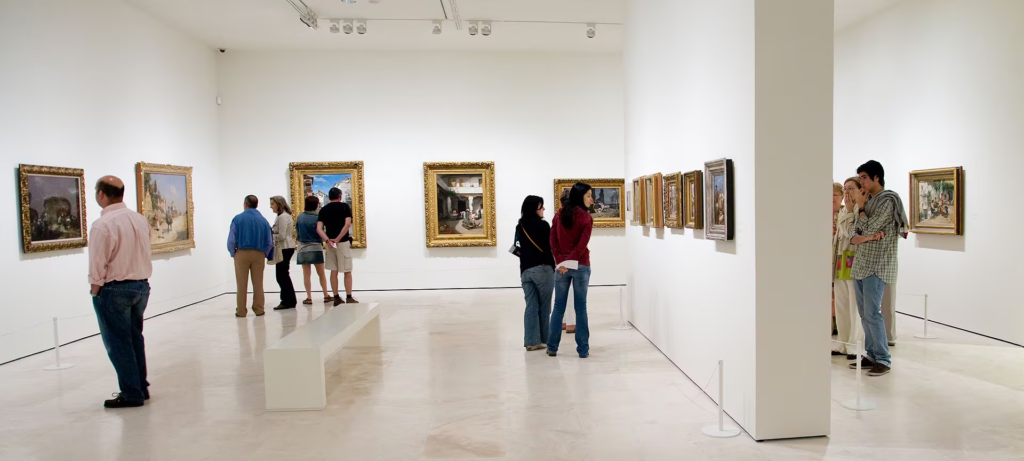
Above: Museo Carmen Thyssen, Málaga
“The past is a pointer to the future.
If we can understand the past and follow the trend of development throughout history we shall be more sure of where we are going.
History tells us of wars and conquests and empires and revolutions, of cities and cultures, and of religions and persecutions.
Yet actually it is a rather superficial survey.
It leaves out almost entirely one vital part of the picture — the most important part.
It has very little to say of Man’s purpose in living, of his understanding of the reason of his existence and of his conception of life around him, and his interpretation of the mysteries of creation and evolution.
So little does history say about this aspect of Man — the mainspring and motive of his living — that we are left guessing about the most important part of the story — the extent of Man’s actual knowledge throughout the ages.
We are given superficial and rather materialistic details of the outward forms and the bitter strife which accompanied the development of the various religions as they were interpreted and practised by the people, much of which leaves us with an impression of brutal and bigoted primitiveness.“
Vera Stanley Alder
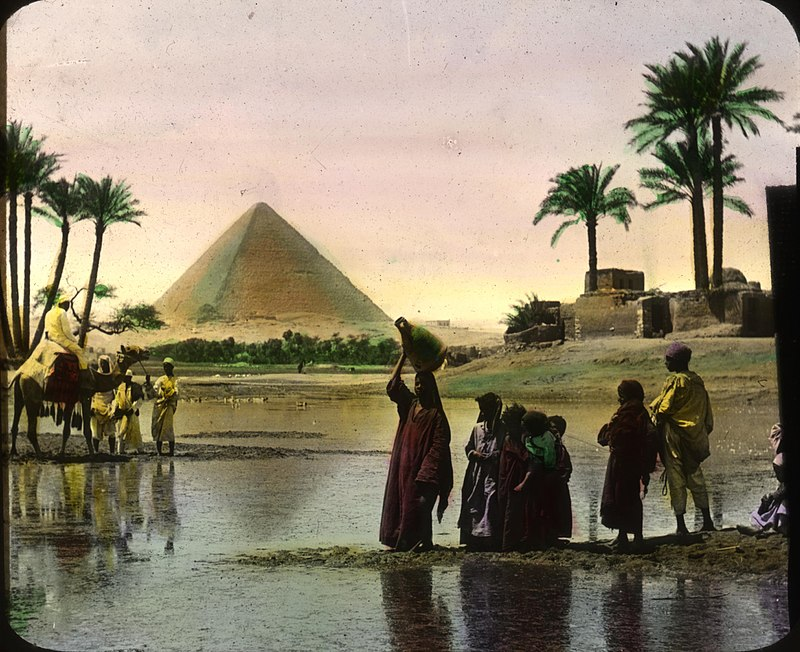
Above: Inundation of the Nile
Among the finds found was a nymphaeum decorated with figurative paintings of fish, but also pools from fish salting factories and a necropolis from the late antique period, probably Byzantine.
The nymphaeum would present the figure of the town’s ruler, whose well-being would depend on the capture and sale of the fish depicted.
Its historical and cultural value is increased by the fact that it is the only remnant with these characteristics found in the city.
Following the Roman conquest of the Hellenistic East, the Greek term was translated into Latin as “nymphaeum” until it eventually came to mean large monumental fountains.
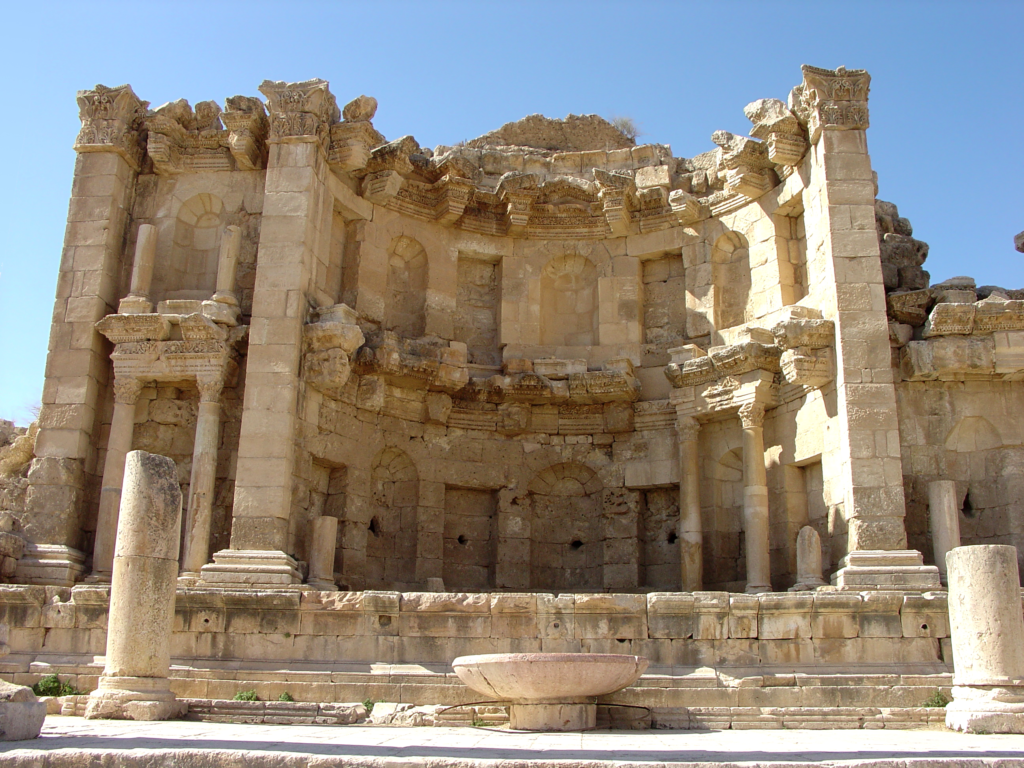
Above: Nymphaeum, Jerash, Jordan
“I was not speaking of minor ripples in the mainstream of history—certainly those are ruled by chance.
But the broad current moves quite inexorably, I assure you.”
Poul Anderson
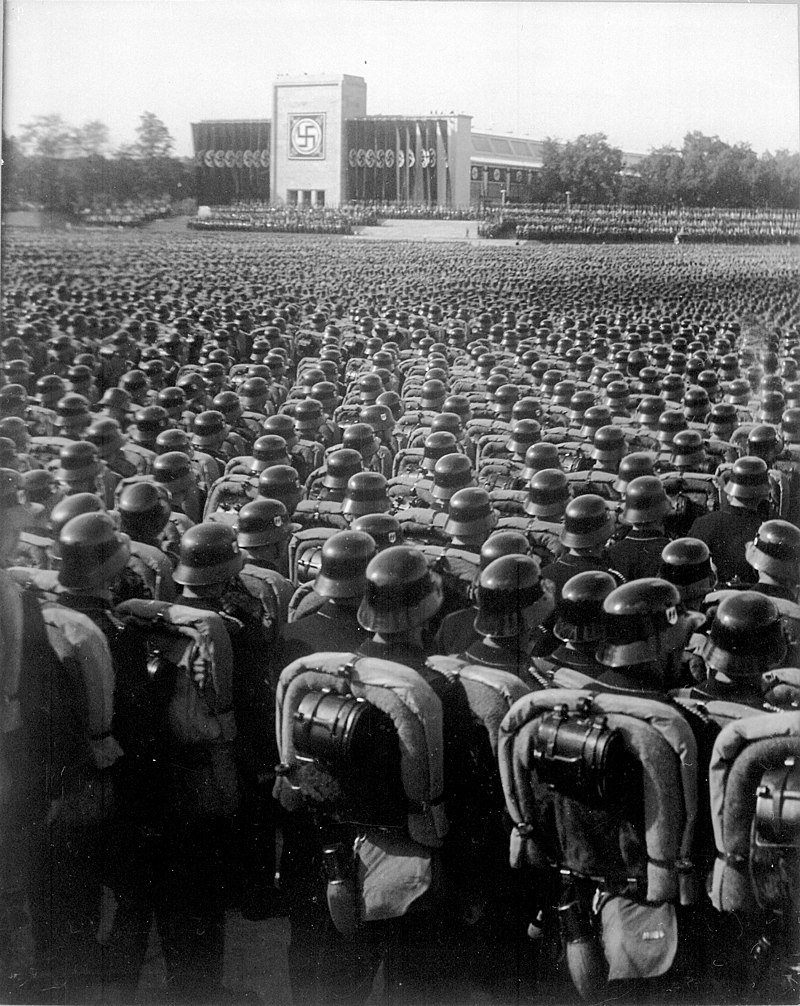
Above: Reichsparteitag, Nuremberg, Germany (11 September 1935)
All the pieces found during the excavations are kept in the courtyards, strictly following the rules of the Department of Culture.
During the restoration work in the basement of the Renaissance palace, archaeological remains belonging to Imperial Rome were found.
The basement of the Museo Carmen Thyssen houses the remains of a Roman domus from the 2nd century with buildings that were renovated and maintained until the 5th century.
The Roman domus and archaeological site were expected to open to the public before 2019, but to this day they remain hidden from the public.
In March 2021, the Department of Urban Planning announced that it would carry out a project to make the remains visitable.
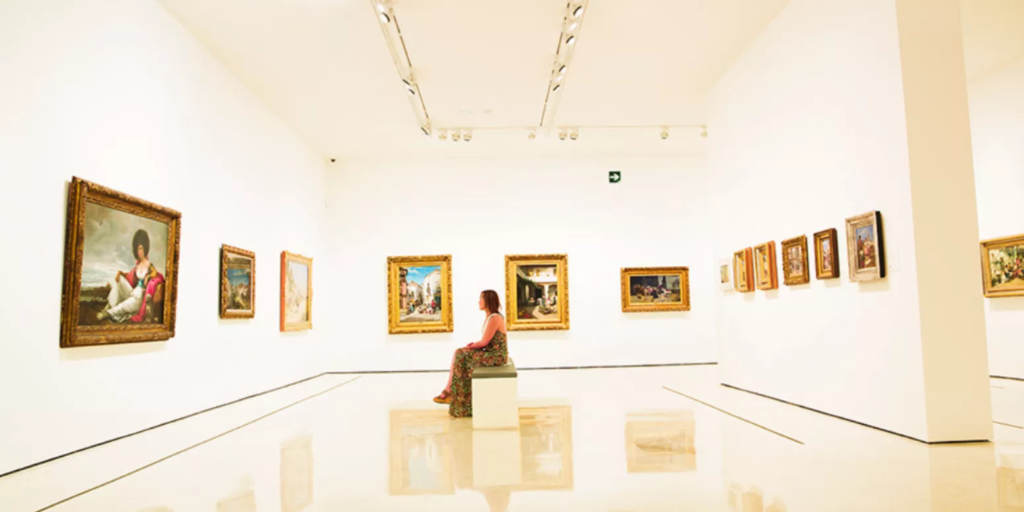
Above: Museo Carmen Thyssen, Málaga
“A writer — and, I believe, generally all persons — must think that whatever happens to him or her is a resource.
All things have been given to us for a purpose, and an artist must feel this more intensely.
All that happens to us, including our humiliations, our misfortunes, our embarrassments, all is given to us as raw material, as clay, so that we may shape our art.“
Jorge Luis Borges
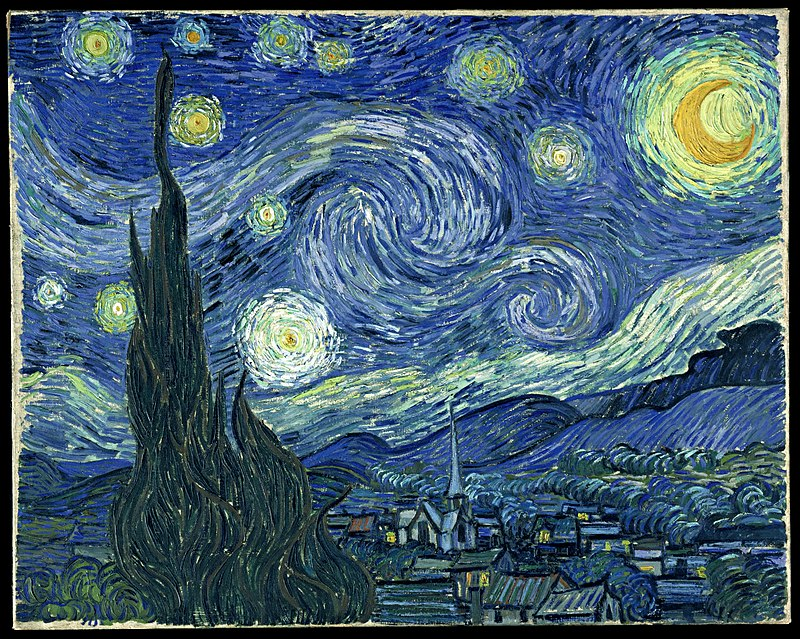
Above: Starry night, Vincent van Gogh (1889), Museum of Modern Art, New York City
As I age I find that my body has become more intolerant of my enjoying myself.
My wife and I visited the aforementioned Museo Carmen Thyssen, had lunch at a restaurant called L’Expérience and we realized that there was still a gap of time before we could use our electronic entry into the Museo Picasso Málaga.
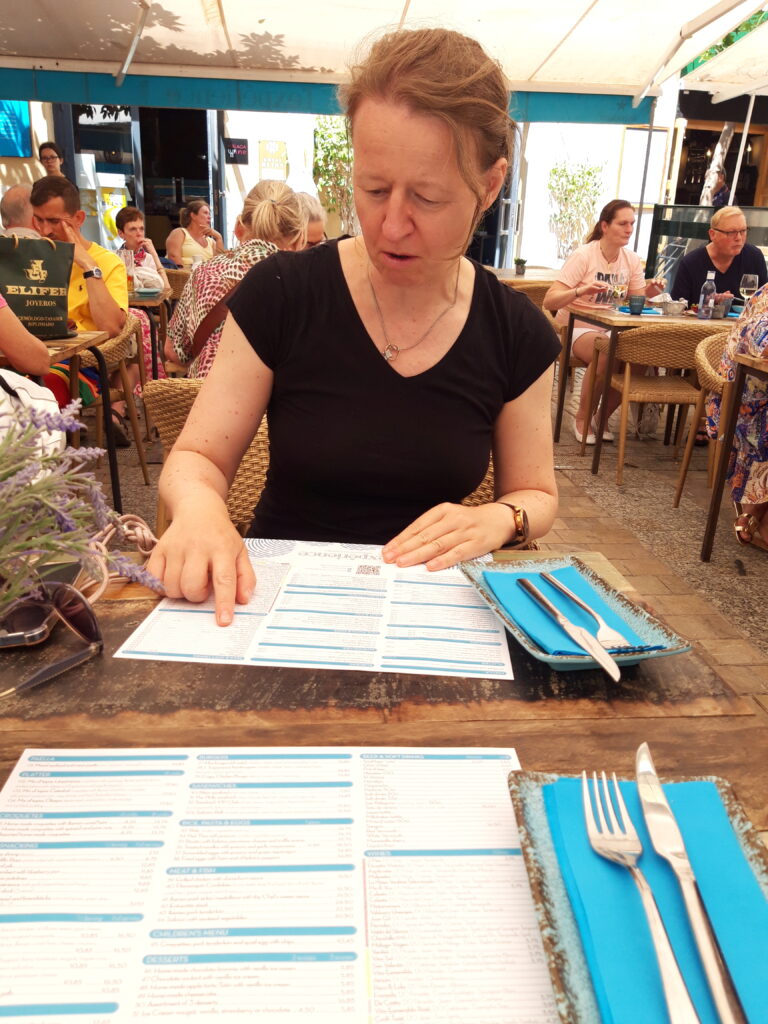
Above: The Mrs. being ever decisive, 11 June 2024
Upon leaving L’Expérience my stomach began to disagree with something I had eaten.
Perhaps too much lactose in my breakfast buffet choices at the hotel this morning.
My stomach sent out an alarm.
Find a washroom.
Now.
We found one at the Museo Revello de Toro – a place we had never heard of and one that our guidebooks had not mentioned.
After creating my own Chernobyl, I explored the Museo as well….
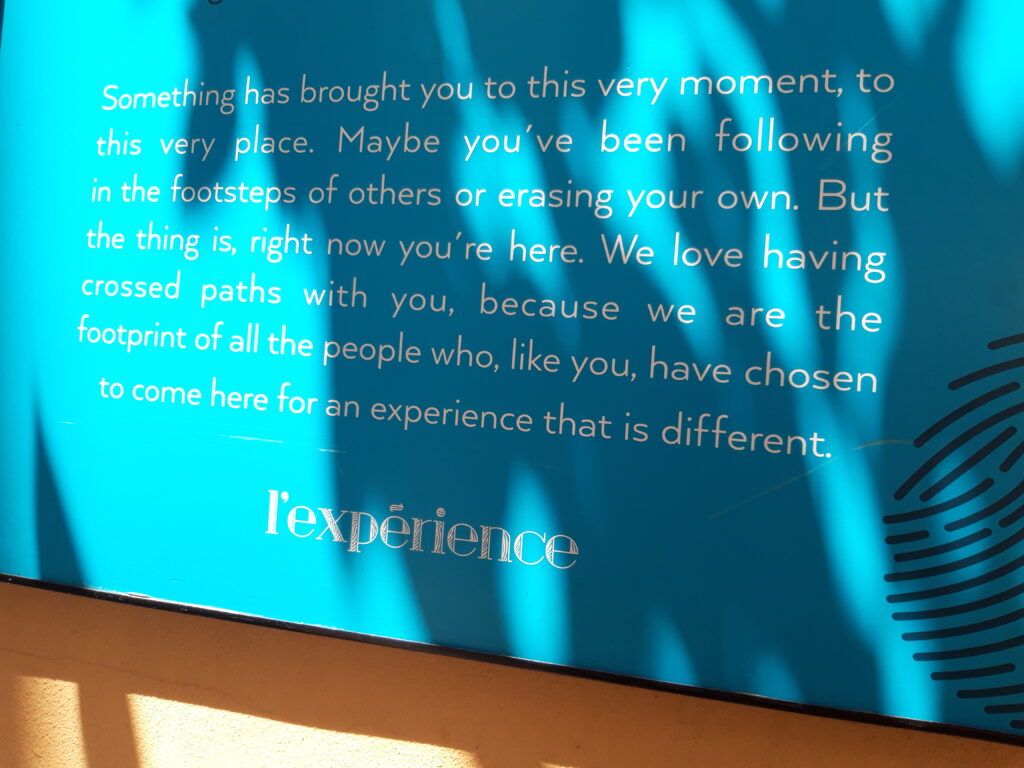
The Museo Revello de Toro (Revello de Toro Museum), located in the house-workshop of Pedro de Mena, is an art gallery in the city of Málaga.
It is located on Calle Císter, in the historic centre of the city, in what was Pedro de Mena’s home during his stay in Málaga.
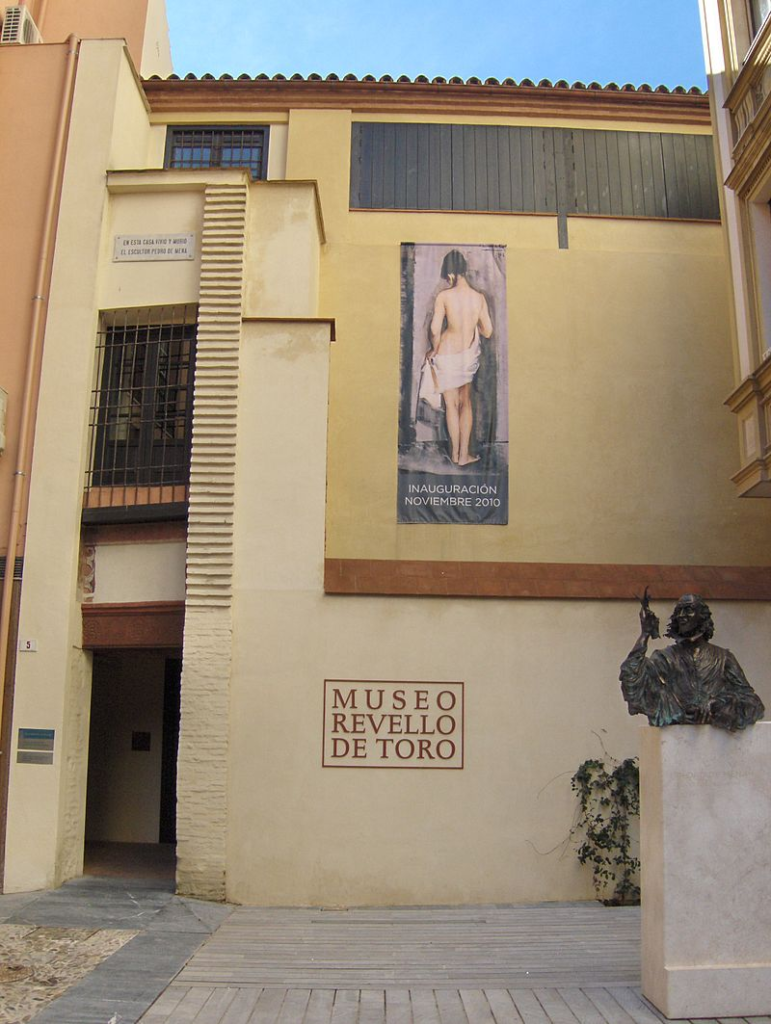
Above: Museo Revello de Toro, Málaga
“Importantly, in Europe the question of art has been inscribed into religious pictures since the Renaissance.
Here the rise of art marked a turning point in the history of images which is foundational for art history.
Pictures not only carried the names of artists, but displayed their personal views on religion.
The practice of art began without a fixed concept of art.
But it developed specific evidence that distinguishes works of art.
The notion of art emerged in the heart of the religious picture, with the themes still remaining the same.
In an evolving market, personal artistic style became a brand in its own right.
In the French writings of the time, “art” is introduced with the term “science”, while “art” refers to craft.
The concept of Poesia, used much later by Titian when referring to his own pictures with mythological subjects, had hitherto been the privilege of poets.
Giovanni Bellini defended the “bella fantasia” against the expectations of his patrons, thereby initiating the era of art collections.“
Hans Belting
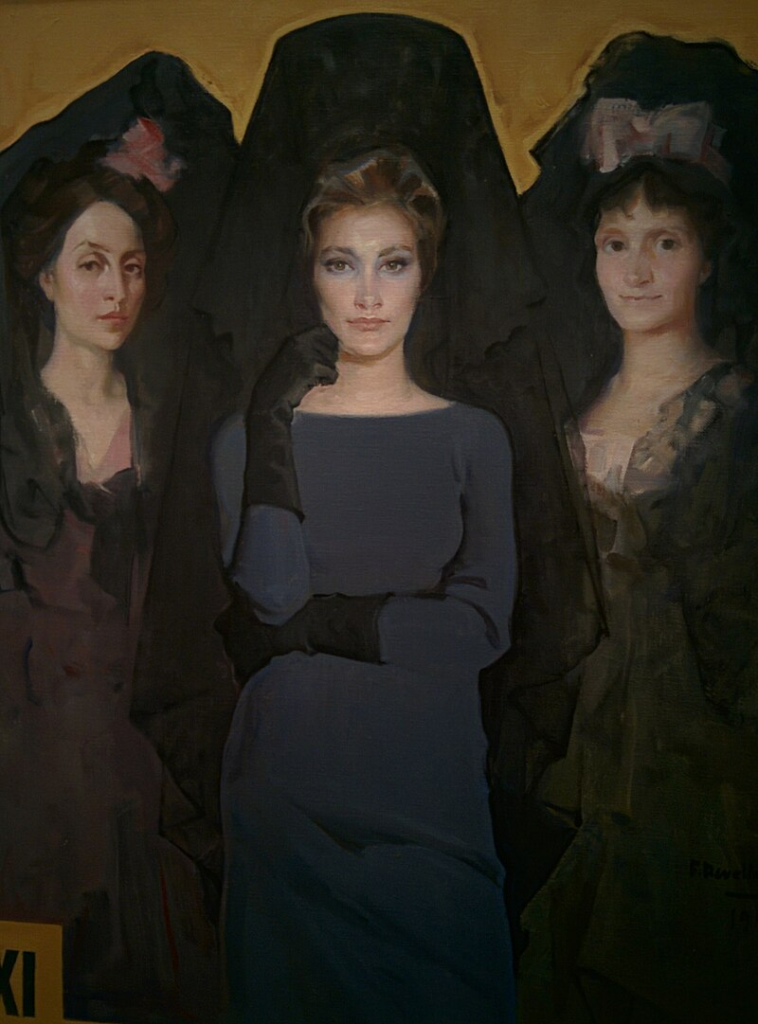
Above: Untitled, Museo Revello de Toro, Málaga
(Pedro de Mena (1628 – 1688) was born in Granada, Andalusia.
He was baptized on 29 August 1628 in Granada in the Parish of San Andrés.
His parents were Alonso de Mena, a famous sculptor, and his second wife Juana de Medrano.
He spent his early years of apprenticeship with his father along with other workshop apprentices among whom was Pedro Roldán.
Upon his father’s death in 1646, Pedro, aged 18, took over the workshop, which he shared from 1652 with Alonso Cano – when the latter returned to Granada from Madrid to act as a rationer in the Cathedral – with whom he worked and collaborated closely, putting his own workshop at his disposal.
Thanks to this collaboration, Mena was able to assimilate more elaborate work procedures and a new aesthetic concept that he developed along the path of technical perfection and realism.
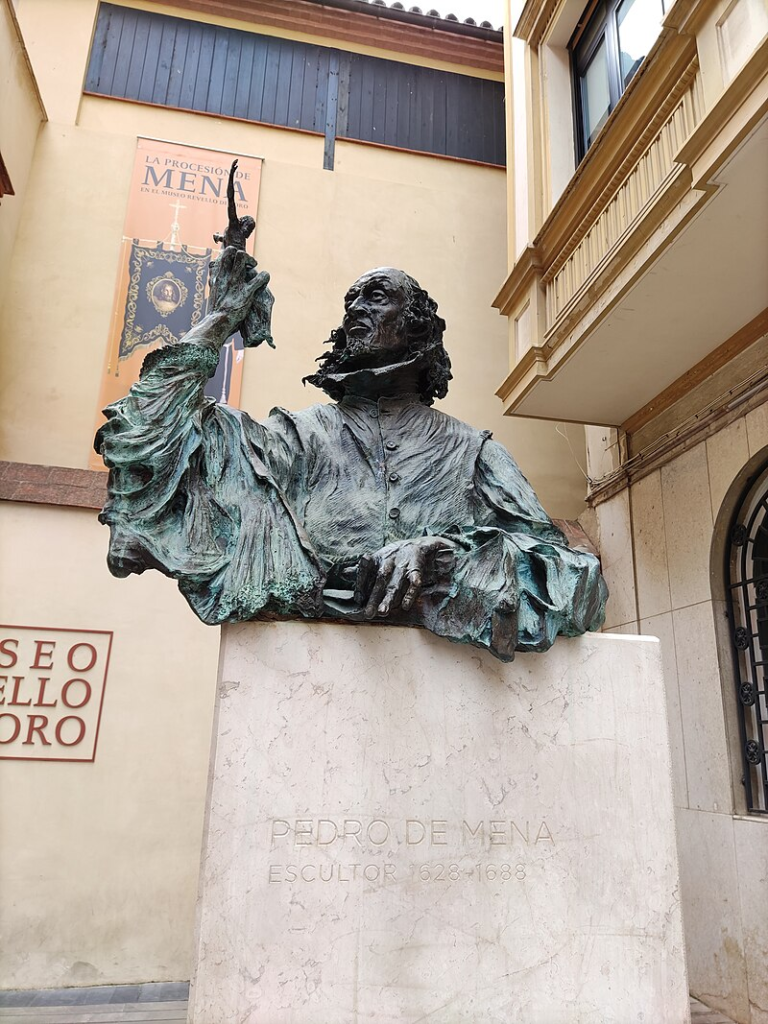
Above: Sculpture of Pedro de Mena at the entrance of the Revello de Toro Museum, Málaga
“It is the glory and good of Art,
That Art remains the one way possible
Of speaking truth, to mouths like mine at least.“
Robert Browning
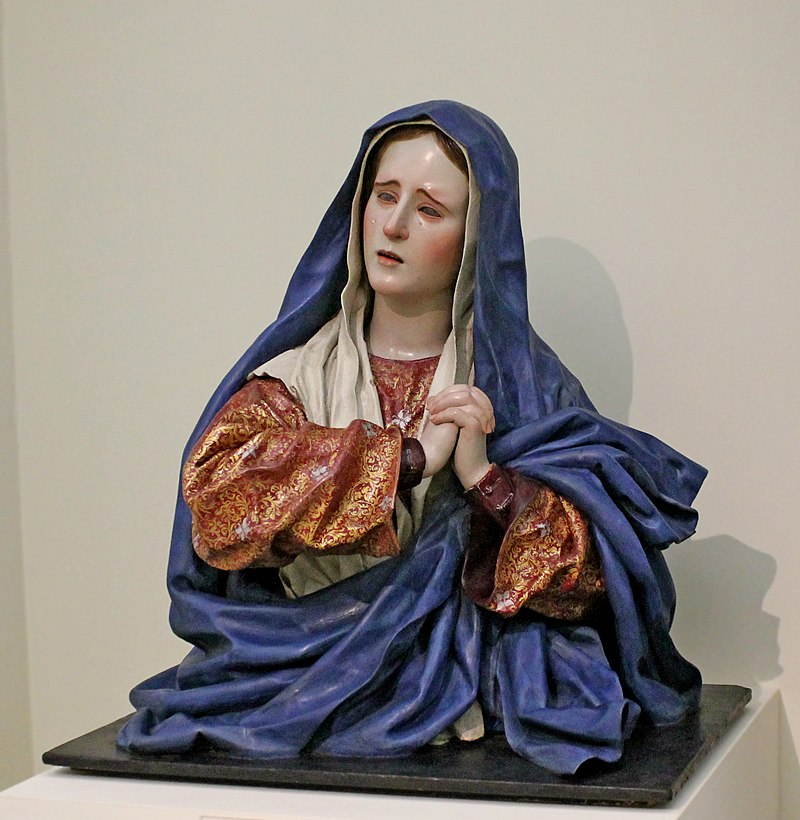
Above: Mater Dolorosa, Pedro de Mena, Real Academia de Bellas Artes de San Fernando, Madrid, España
On 5 June 1647, he married Catalina de Vitoria y Urquízar, a native of Granada and 13 years old, with whom he had six children before his departure to Malaga, of whom three survived and became religious.
During his stay in Malaga they had another eight children, leaving only two alive, José, royal chaplain in the Royal Chapel of Granada and Juana Teresa in the Císter, where her sisters Andrea and Claudia Juana were already.
He wrote his first will in 1666; but it is in the one made in 1675 when he speaks of his daughter Juana who was not yet six years old:
…and wishes to live and remain in a state of religion, maintaining purity and chastity, for which reason we wish her to be religious because it is one of the most perfect and secure states for salvation.”
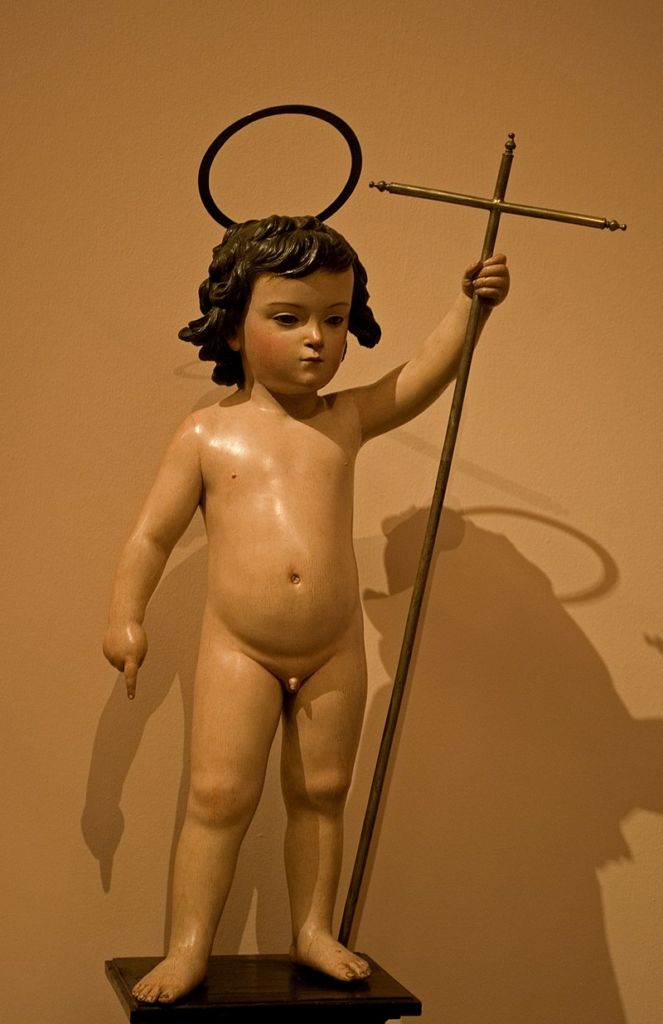
Above: San Juan Bautista niño (Saint John the Baptist as a Child), Pedro de Mena (1674), Museo de Bellas Artes de Sevilla, España
“In a rational religion there is no perplexity.“
Agni Yoga

Because of his firm religious beliefs, de Mena asked to be buried between the two doors of the Cistercian Church so that his tombstone would be stepped on by all the faithful who entered the Church.
In 1876, the Cistercian Abbey of Santa Ana in Malaga was demolished.
His remains were found in a pine box.
They were transferred to the Iglesia Santo Cristo de la Salud, until their new transfer in 1996 to the current Cistercian church, very close to the house where he lived and died.
He remains buried in a small chapel with the busts of the Dolorosa and the Ecce Homo, which he had made and donated for that purpose.
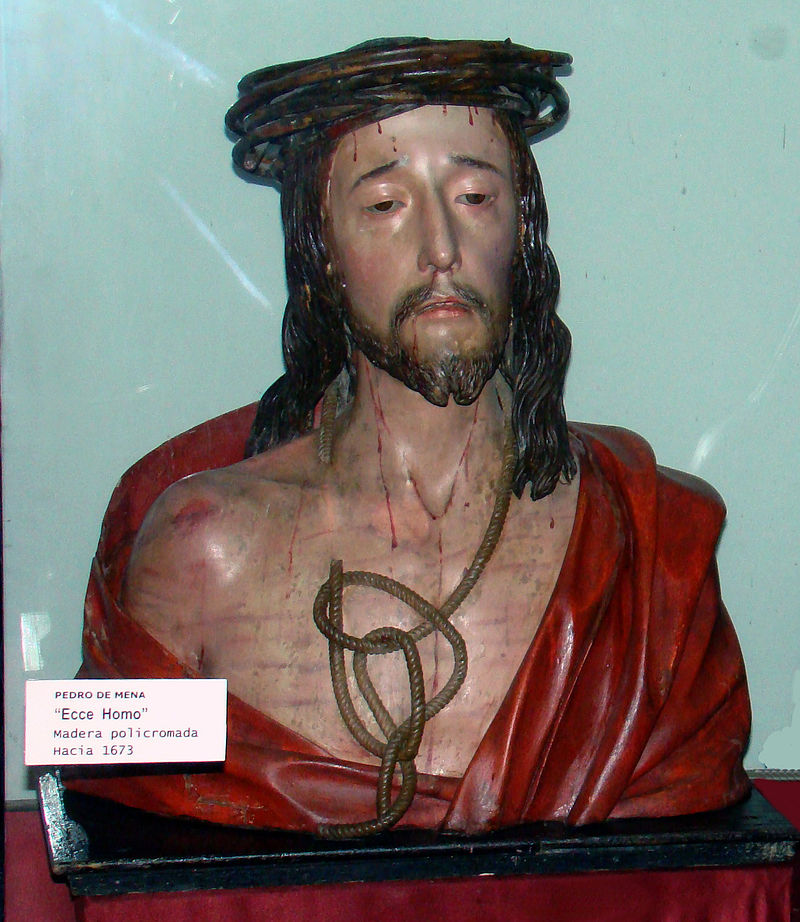
Above: Ecce Homo, Pedro de Mena (1673), Museo Diocesano y Catedralicio de Valladolid, España
“A man’s religion should be more in his life than on his lips.“
Joseph Arch
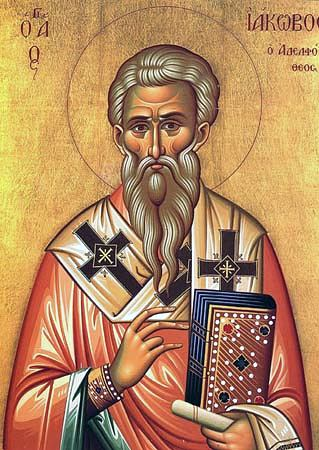
Above: Saint James the Just
Pedro de Mena maintained a strong religious connection with various brotherhoods and was the elder brother of the guild of artists of the Most Holy Corpus Christi, Souls and Mercy.
He fought and managed to be accepted as a member of the Inquisition in 1678.
This meant a social rise, since it implied a public recognition of purity of blood and also brought with it certain privileges such as being free from paying taxes.
His greatest friendships were above all ecclesiastical, according to Palomino:
He was a man of the highest esteem, and thus he never accompanied anyone but the first nobility, taking him to his side on public walks and hunting recreations.”
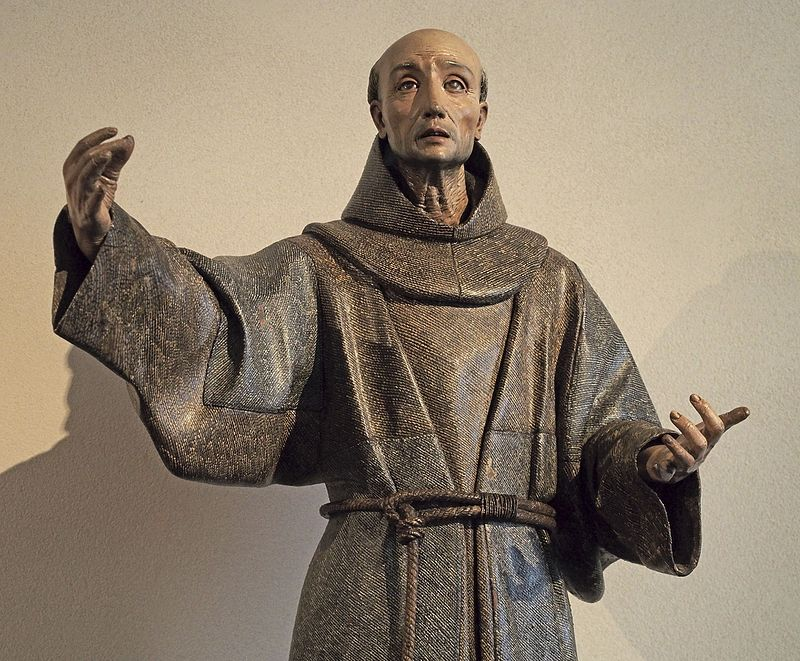
Above: San Pedro de Alcántara (St. Peter of Alcantara), Pedro de Mena, Museo Nacional de Escultura (National Museum of Sculpture), Valladolid, España
“Religion is, by definition, interpretation.
And by definition, all interpretations are valid.
However, some interpretations are more reasonable than others.“
Reza Aslan

Above: Solar halo, Île de la Réunion
His first success was achieved in work for the Convent of St. Anthony Granada, including figures of St Joseph, St Anthony of Padua, St Diego, St Pedro Mentara, St Francis and St Clare.
He remained in Granada until 1658, when he was called by the Bishop of Malaga, Diego Martinez de Zarzosa, to make the choir stalls of the Cathedral of the Incarnation of Malaga.
In this city, except for a stay in Madrid between 1662 and 1663, he set up his permanent workshop with great success of commissions, until his death in October 1688.
In 1658 he signed a contract for sculptural work on the choir stalls of the Cathedral of Málaga, this work extending over four years.
Other works include statues of the Madonna and Child and of St Joseph in Madrid, the polychromatic figures in the Church of St Isodoro, the Magdalena and the Gertrudlis in the church of St Martin (Madrid), the Crucifixion in the Nuestra Señora de Gracia (Madrid), the statuette of St Francis of Assisi in Toledo, and of St Joseph in the St Nicholas Church in Murcia.
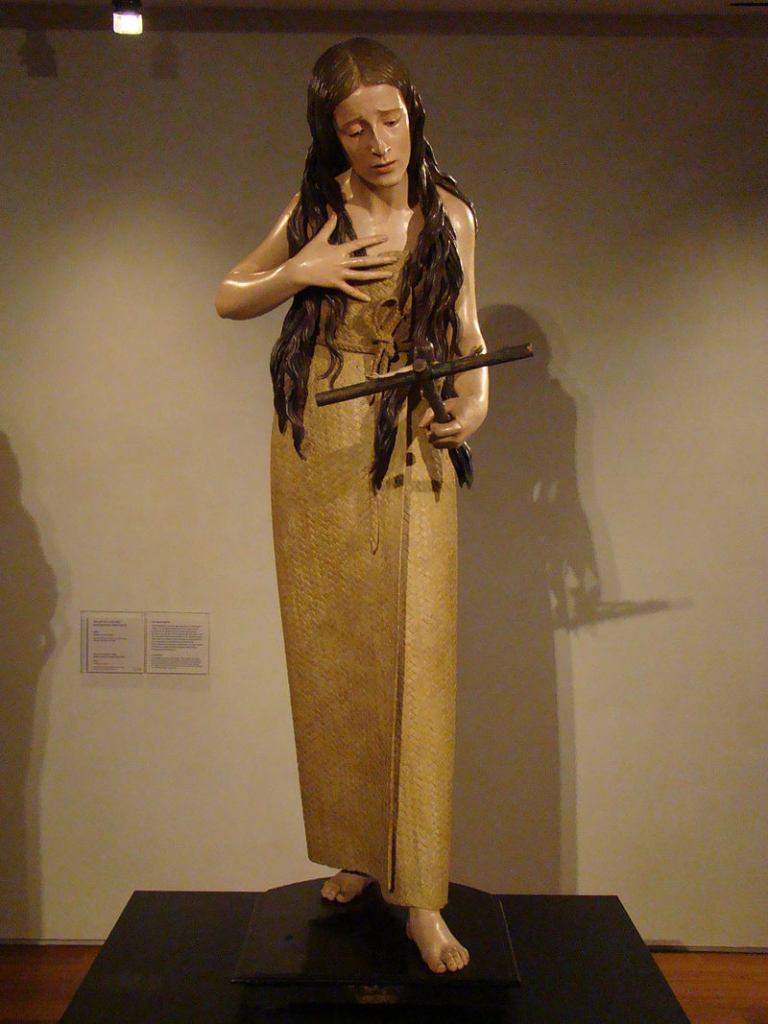
Above: Magdalena penitente (Penitent Magdalena), Pedro de Mena, Museo Nacional de Escultura (National Museum of Sculpture), Valladolid, España
Mena travelled to Madrid in 1662.
Between 1673 and 1679 Mena worked at Córdoba.
About 1680 he was in Granada, where he executed a half-length Madonna and Child (seated) for the Church of St. Dominic.
He stood out for his great capacity for work as well as for his administrative skills and his commercial vision.
They provided him with a patrimony that allowed him a comfortable life and a respectable position.
Mena died in Málaga, the city where he spent most of his life, and where he had a sculpture studio for 30 years until his death in 1688.
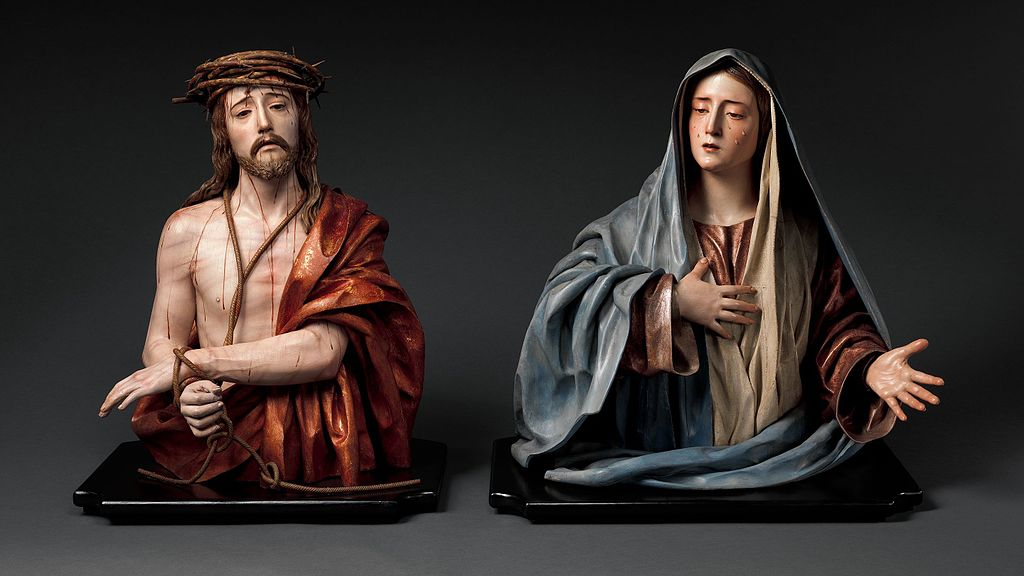
Above: Ecce Homo and Mater Dolorosa, Pedro de Mena (1685), Metropolitan Museum of Art, New York City
“There is a strange idea prevalent that by merely teaching the dogmas of religion children can be made pious and moral.
This is an European error, and its practice either leads to mechanical acceptance of a creed having no effect on the inner and little on the outer life, or it creates the fanatic, the pietist, the ritualist or the unctuous hypocrite.
Religion has to be lived, not learned as a creed.“
Sri Aurobindo

Above: Soul iris
In technical skill and the expression of religious motive his statues are unsurpassed in the sculpture of Spain.
His skill to sculpt nude figures was remarkable.
Like his immediate predecessors, he excelled in the portrayal of contemplative figures and scenes.)
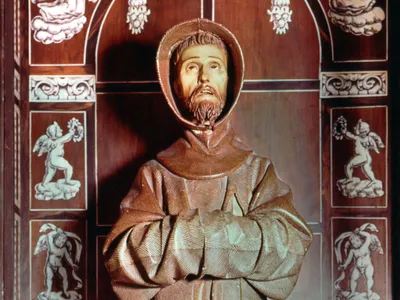
Above: St. Francis, Pedro de Mena (1664), Toledo Cathedral
“Art isn’t just technique, in any culture.
It is also Content.
It is understanding not just How, but also What, to express.“
Adam-Troy Castro
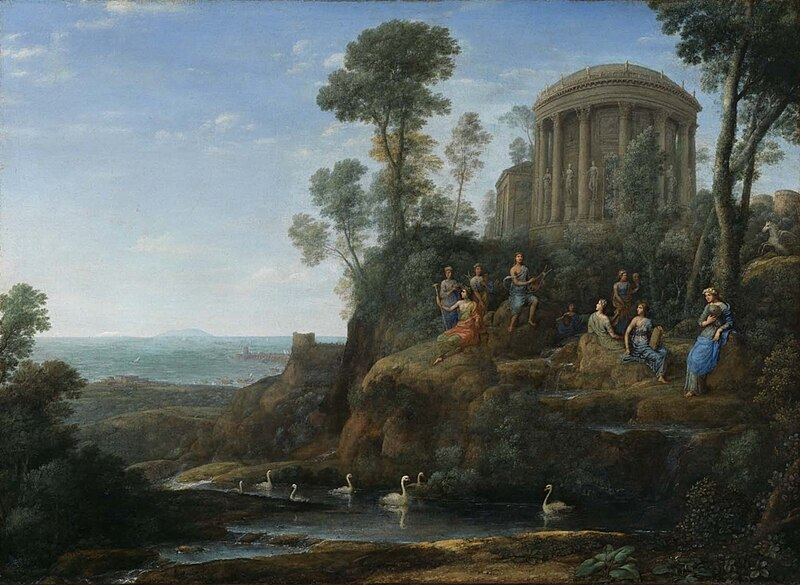
Above: Apollo and the Muses on Mount Helion, Claude Lorrain (1680), Museum of Fine Arts, Boston, Massachusetts, USA
As its name suggests, the Museo Revello de Toro is dedicated to the Málaga painter Félix Revello de Toro.
Félix Revello de Toro was born in Málaga in 1926.
His first exhibition took place in 1938, when he was 10 years old.
At 16 he received his first professional commission for a local brotherhood.
The following year he received a scholarship to study in Madrid for five years at the Royal Academy of San Fernando.
He then obtained another scholarship that allowed him to stay in Rome in 1951.
From 1953 onwards his work began to be recognized.
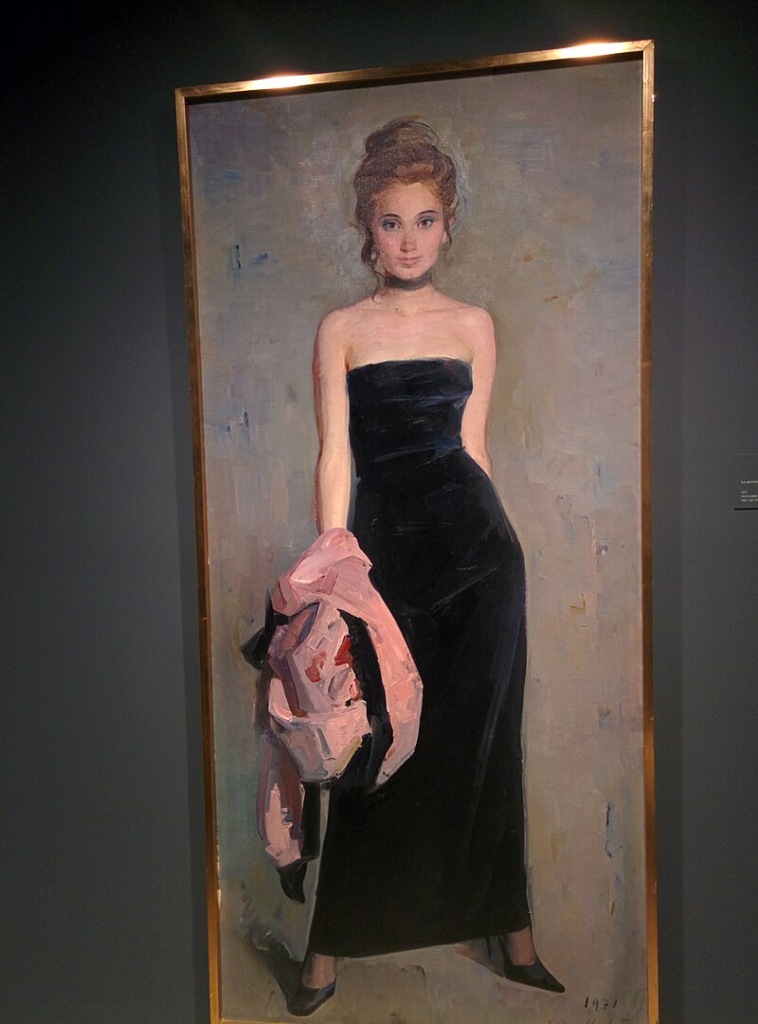
Above: Untitled, Revello de Toro Museum, Málaga
He was a Professor of Fine Arts in Barcelona, at the Escuela de la Lonja.
He has been an honorary member of the Royal Academy of Fine Arts of San Telmo since 1987.
On 27 November 2010, a museum dedicated to him called Museo Revello de Toro opened in the center of Málaga, with 117 works donated by the painter.
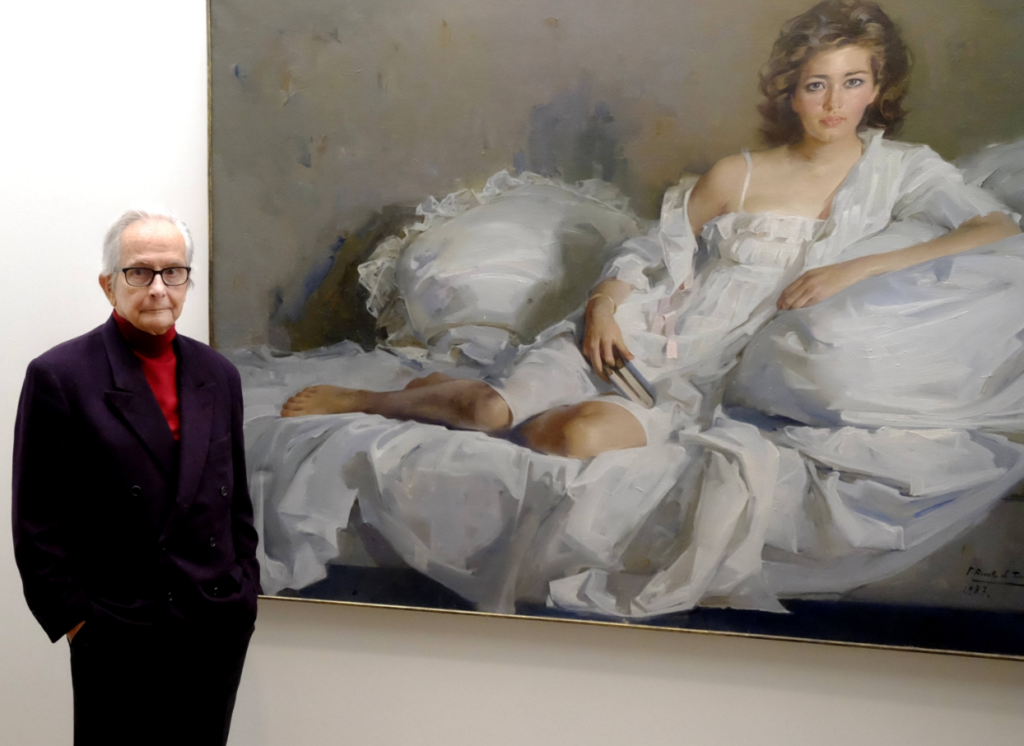
Above: Spanish painter Felix Revello de Toro
“The history of art is that there have been a lot of artists who have always been socially engaged.
Art comes out of both a desire to define the meaning of life and a kind of rage and railing against human limitations.“
Judy Chicago
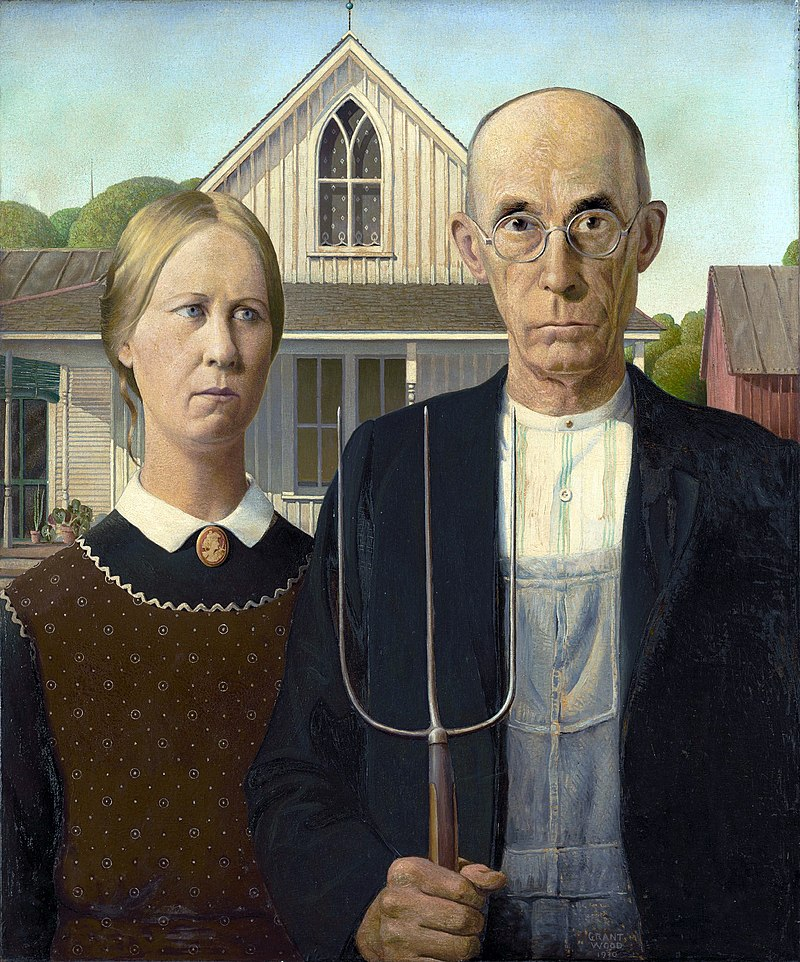
Above: American Gothic, Grant Wood (1930), Art Institute of Chicago Museum
The Museo houses a collection of 132 works by the artist, of which 117 are on display at any one time.
The works are arranged according to thematic and technical criteria.
Thus, the intimate works with still lifes and family portraits are grouped on one side, and on the other, the feminine paintings for which the artist is best known.
Another room contains sketches and drawings.
The Museo also has a temporary exhibition hall, where a collection of posters is on display.
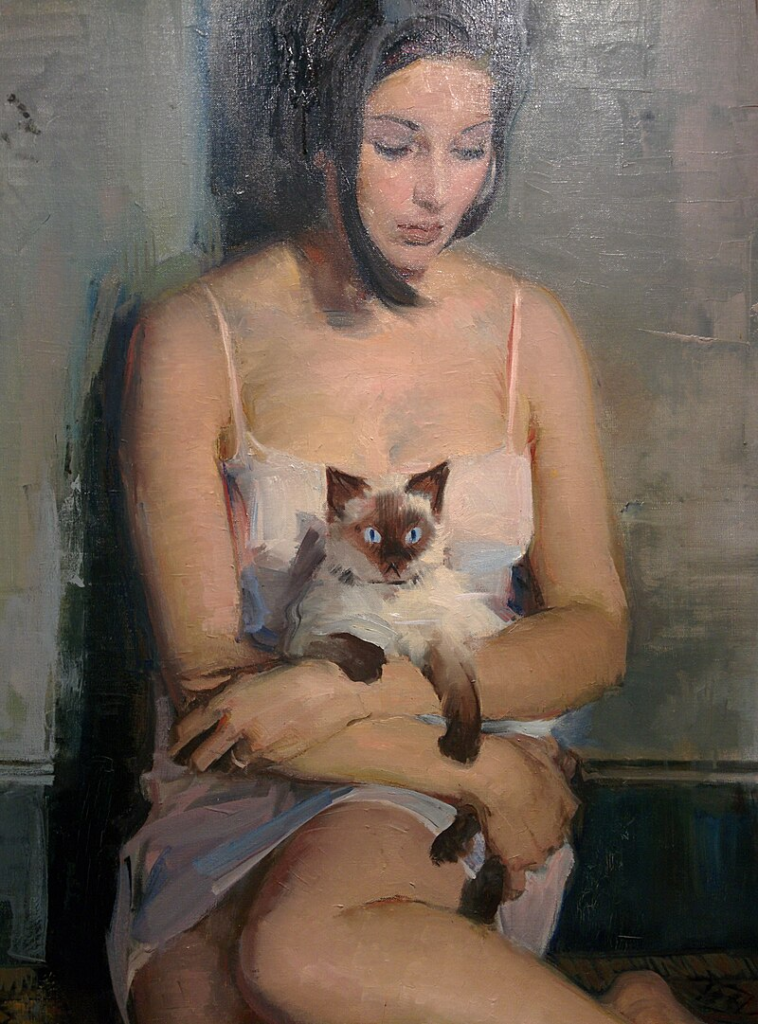
Above: Untitled, Revello de Toro Museum, Málaga
“Art is magic delivered from the lie of being truth.“
Theodor Adorno
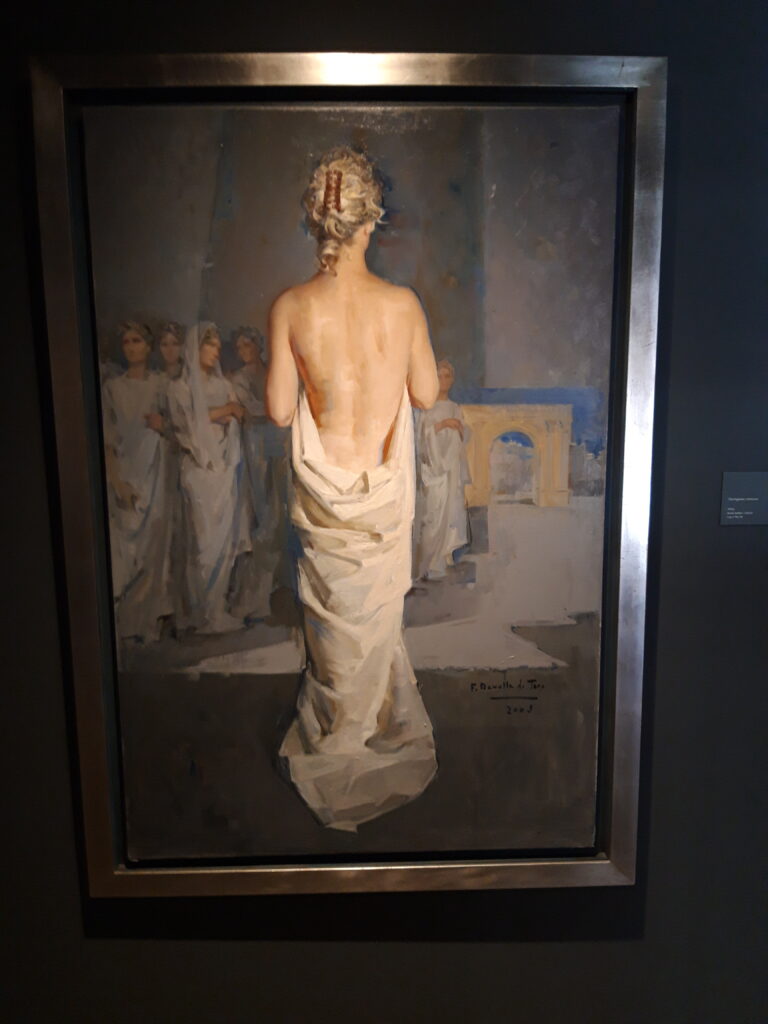
Above: Untitled, Revello de Toro Museum, Málaga
After the Museo Revello de Toro and after the discomfort of my interior, we visited the Museo Picasso Málaga.
The Museo Picasso Málaga (MPM) is one of the two art galleries dedicated to Pablo Picasso located in his hometown of Málaga, the other being the Fundación Picasso Museo Casa Natal. (The later did not fit comfortably into our itinerary.)
In 2023 the MPM reached the figure of more than 779,000 visitors, being the most visited museum in Andalusia.
The 285 works in the MPM collection encompass Picasso’s groundbreaking innovations as well as the wide variety of styles, materials, and techniques he mastered.
From his early academic studies to his vision of classicism, through to the superimposed planes of cubism, ceramics, his interpretations of the great masters, and the last paintings of the 1970s.
On 13 March 2017, the Museum opened with its reorganized space, LED lights in all its rooms, and 166 new works that significantly expanded the Museum’s catalog.
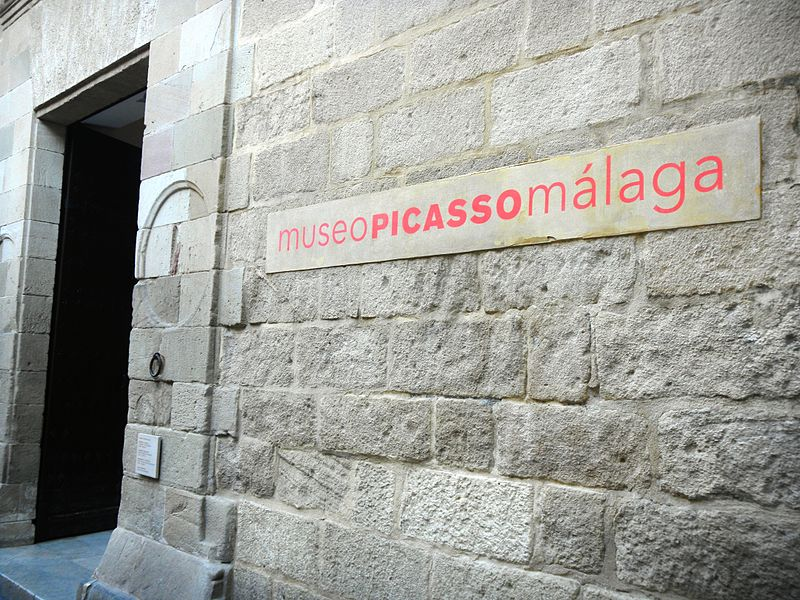
The initial idea for this museum was born from the contacts between Pablo Picasso and Juan Temboury, the provincial delegate of Fine Arts in Málaga during the Franco dictatorship.
In 1953, Juan Temboury wrote to Picasso requesting the donation of two works of each technique, to which:
Picasso, enthusiastic, replied that he would not send two works, but two trucks.“
Christine Ruiz-Picasso
This donation, which would have created the first museum in the world dedicated exclusively to Picasso, would be frustrated by the refusal of the authorities of the time to accept the donation.
Christine Ruiz-Picasso, widow of Paul Ruiz-Picasso, the artist’s eldest son, resumed contacts with Málaga in 1992 on the occasion of the exhibition in the city “Classic Picasso” and in 1994 with the exhibition “Picasso, First Look“.
In 1996, she restarted the 1953 project, which finally became a reality 50 years later, on 27 October 2003, when the Museo Picasso Málaga was inaugurated in the presence of King Juan Carlos I and Queen Sofia.
Christine Ruiz-Picasso donated 14 paintings, nine sculptures, 44 individual drawings, a sketchbook with over 36 drawings, 58 prints and nine ceramic pieces:
In total, 133 pieces of art.
In addition, Picasso’s grandson Bernard Ruiz-Picasso donated another five paintings, two drawings, ten prints and five ceramic pieces:
Amassing a total of 155 pieces.
The collection ranges from early academic studies towards Cubism to his latest reinterpretations of the Old Masters.
Numerous pieces are also always in storage at the Museum and the library houses an archive with over 800 titles relating to Picasso, including relevant documents and photographs.
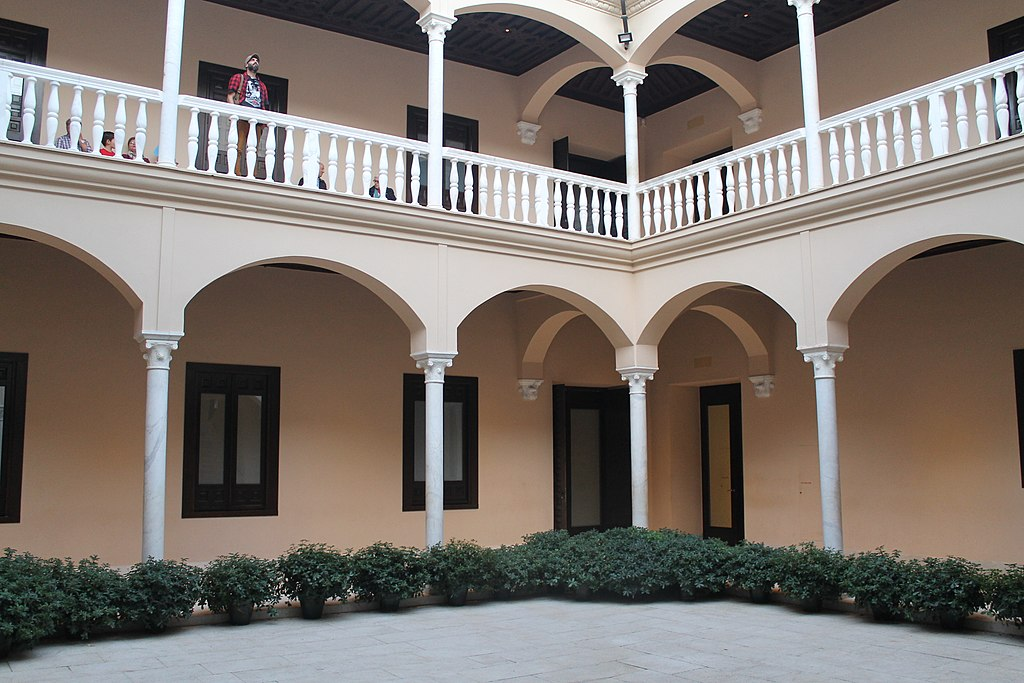
Above: Main courtyard of the Picasso Museum Málaga
The Palace of the Counts of Buenavista was originally a palace residence built in 1530 by Diego de Cazalla, the city’s mayor, half a century after the capture of Málaga.
With a Renaissance architecture, since the 16th century it has been one of the most emblematic civil buildings in the city due to its large plot, privileged location and its strong exterior image provided by the powerful watchtower.
In keeping with the Málagan typology, it is a two-storey building around a porticoed courtyard.
This simple layout enabled the versatility of the different uses it has had throughout its history, without the need for structural transformations.
In the 1950s, it underwent a first intervention to become the headquarters of the Museum of Fine Arts.
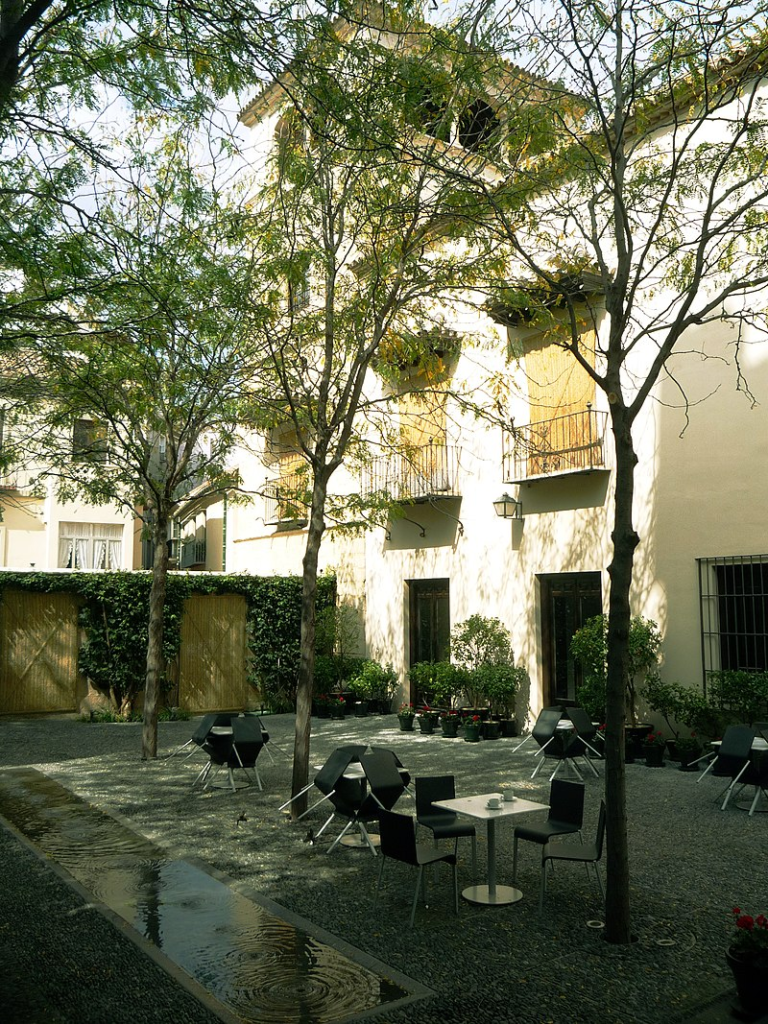
Above: Small garden with tables in the café area of the Palace -Museum, Picasso Museum, Málaga
The conversion of the building began with the acquisition of two houses at the back of the Palace, which were demolished to make way for a temporary exhibition hall and an assembly hall, with the idea of juxtaposing the contemporary architecture with the existing architecture.
The Palace and the new extension are separated by a gap, an open space between the two, with a glass roof where the staircase is located.
The entrance was kept at the same main door, although the position of the staircase was modified to create a larger reception area, changing the direct entrance to the patio to one in a corner.
In order to control the light, the skylights have two layers of glass, with a practical space between them.
Awnings cover the skylight in one piece, filtering the light.
The floor is made of ivory cream marble.
The need for a second extension became evident when archaeological remains were discovered, with all the layers that have formed the city, as well as part of the ancient wall of the Phoenician Malaka.
Part of the walls that rested directly on the remains had to be made diaphanous, collecting their load on beams that transmit it to the ground by means of pillars.
For public circulation, a wooden floor was designed, supported by a light metal structure in the form of a walkway that runs between the remains, illuminated in semi-darkness and without touching them.
A library-documentation centre, a building for the education department, an auditorium and an office building were added to the programme, maintaining the layout of narrow streets and taking advantage of an empty lot on which a fig tree grew.
At the rear, which faces Calle Alcazabilla, an existing garden was reconfigured, creating a space in which the Museum is connected to the Teatro Romano and the Alcazaba, which is intended to be the centre of a monumental area that would include the Customs Palace, the Cathedral of Málaga, the Park and the Plaza de La Merced.
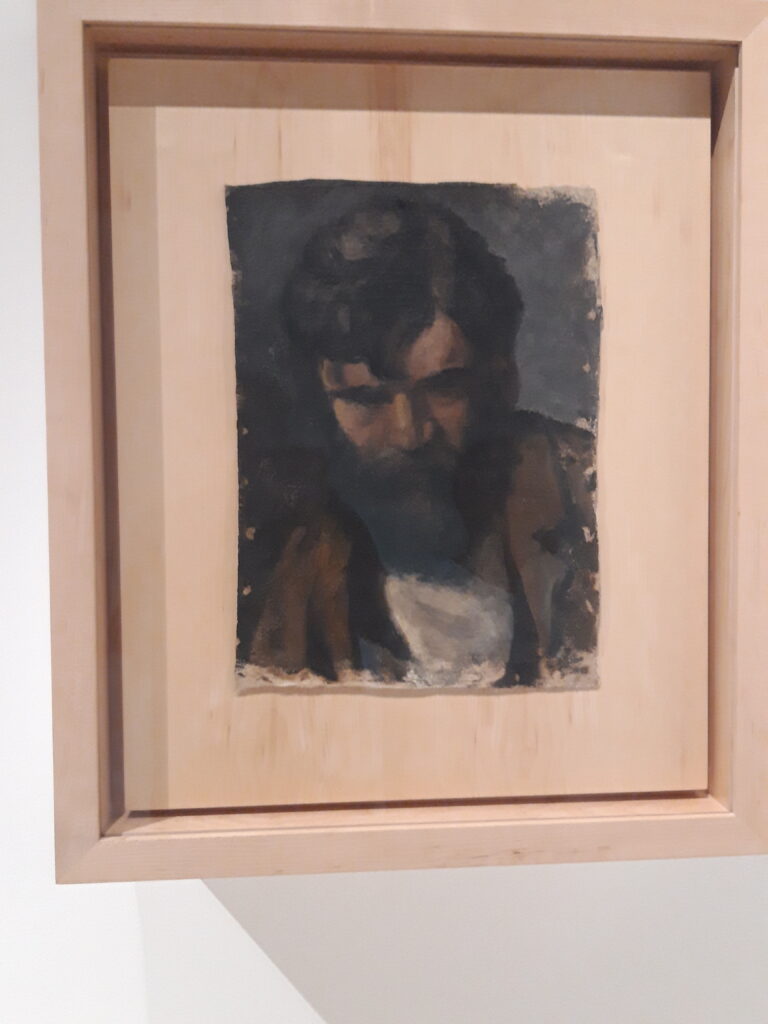
Pablo Ruiz Picasso (1881 – 1973) was a Spanish painter, sculptor, printmaker, ceramicist and theatre designer who spent most of his adult life in France.
One of the most influential artists of the 20th century, he is known for co-founding the Cubist movement, the invention of constructed sculpture, the co-invention of collage, and for the wide variety of styles that he helped develop and explore.
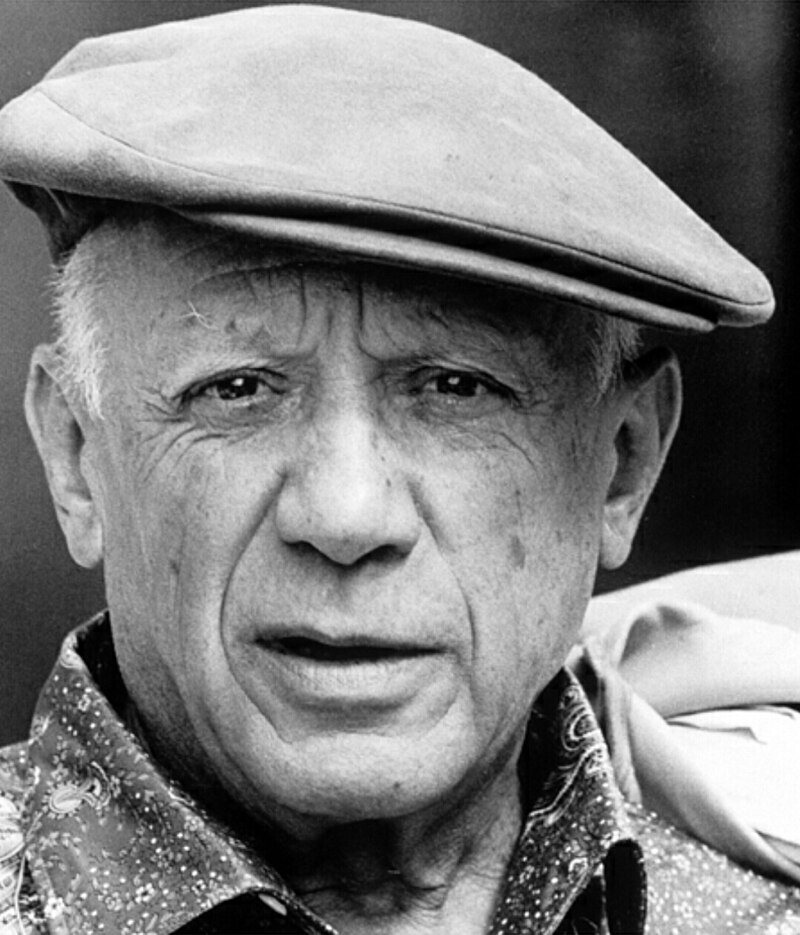
Above: Spanish artist Pablo Picasso (1962)
Among his most famous works are the proto-Cubist Les Demoiselles d’Avignon (1907) and the anti-war painting Guernica (1937), a dramatic portrayal of the bombing of Guernica by German and Italian air forces during the Spanish Civil War.
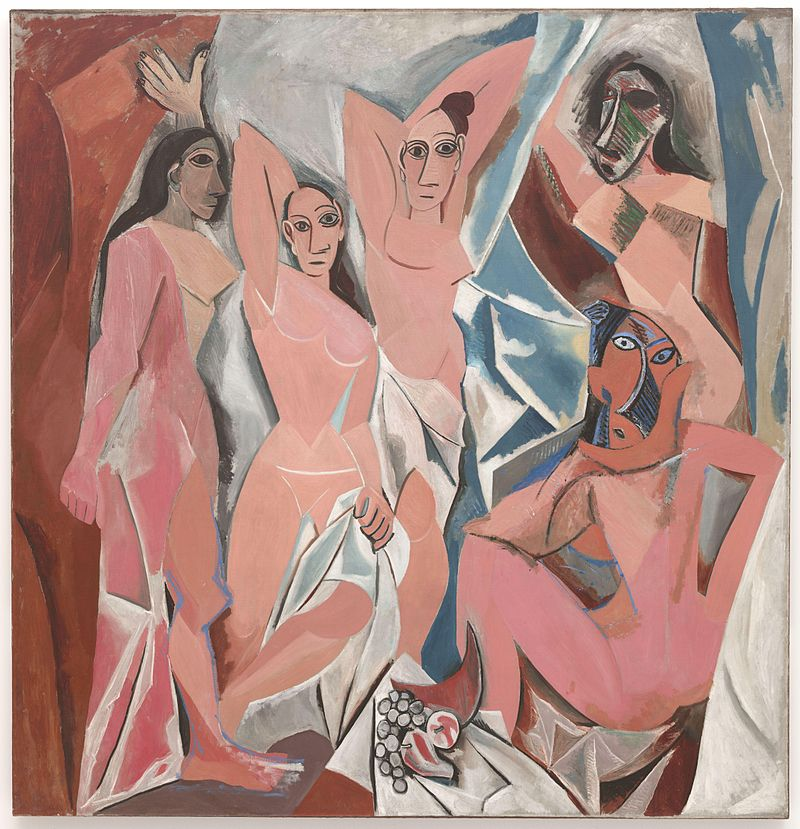
Above: Les Demoiselles d’Avignon, Pablo Picasso (1907), Museum of Modern Art, New York City
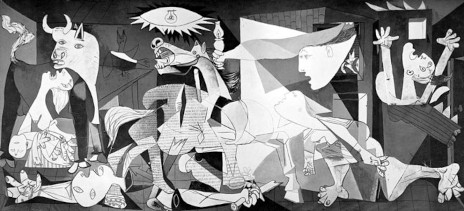
Above: Guernica, Pablo Picasso (1937), Museo Reina Sofia, Madrid, España
“Without tradition, art is a flock of sheep without a shepherd.
Without innovation, it is a corpse.“
Winston Churchill
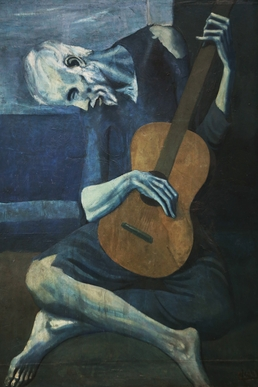
Above: The Old Guitarist, Pablo Picasso (1904), Art Institute of Chicago
Picasso demonstrated extraordinary artistic talent in his early years, painting in a naturalistic manner through his childhood and adolescence.
During the first decade of the 20th century, his style changed as he experimented with different theories, techniques and ideas.
After 1906, the Fauvist work of the older artist Henri Matisse motivated Picasso to explore more radical styles, beginning a fruitful rivalry between the two artists, who subsequently were often paired by critics as the leaders of modern art.
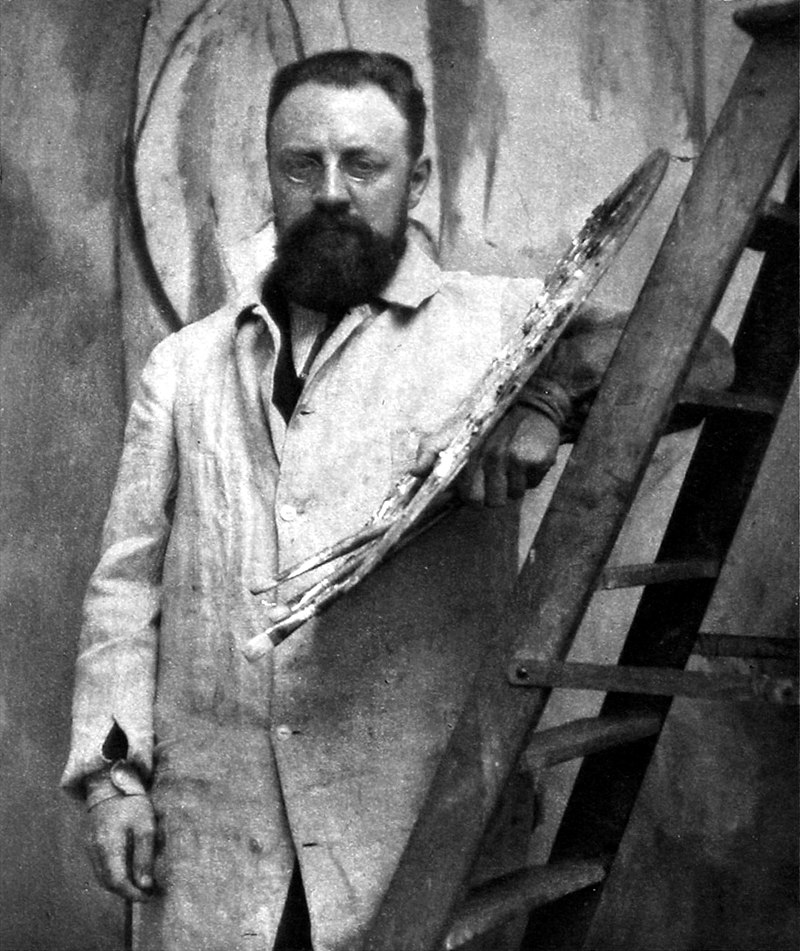
Above: French artist Henri Matisse (1869 – 1954)
Picasso’s output, especially in his early career, is often periodized.
While the names of many of his later periods are debated, the most commonly accepted periods in his work are the Blue Period (1901 –1904), the Rose Period (1904 – 1906), the African-influenced Period (1907 – 1909), Analytic Cubism (1909 – 1912), and Synthetic Cubism (1912–1919), also referred to as the Crystal Period.
Much of Picasso’s work of the late 1910s and early 1920s is in a neoclassical style, and his work in the mid-1920s often has characteristics of Surrealism.
His later work often combines elements of his earlier styles.
Exceptionally prolific throughout the course of his long life, Picasso achieved universal renown and immense fortune for his revolutionary artistic accomplishments, and became one of the best-known figures in 20th-century art.
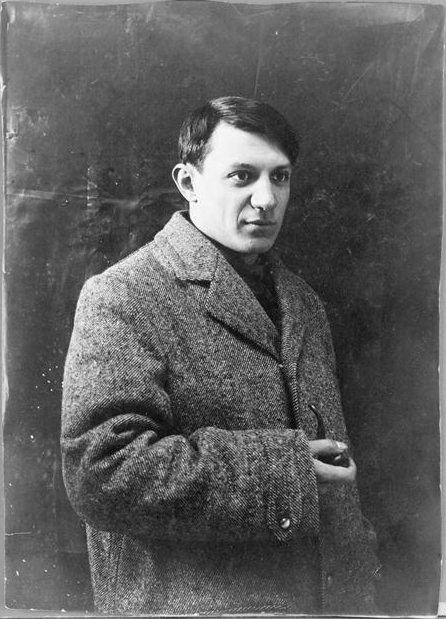
Above: Pablo Picasso (1908)
“Inspiration exists, but it has to find you working.“
Pablo Picasso

“All creative art is magic, is evocation of the unseen in forms persuasive, enlightening, familiar and surprising, for the edification of mankind, pinned down by the conditions of its existence to the earnest consideration of the most insignificant tides of reality.“
Joseph Conrad
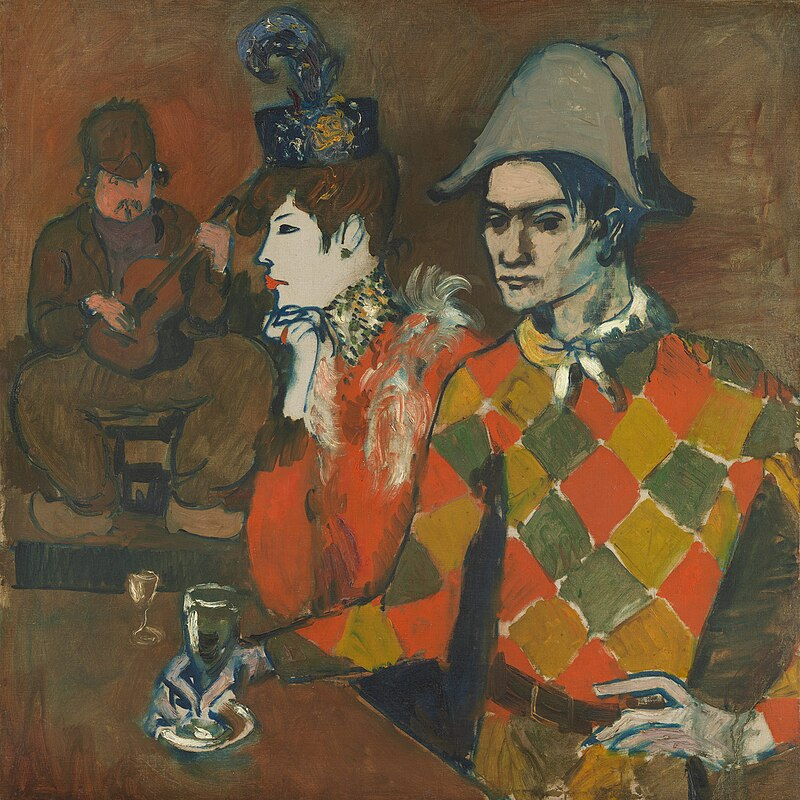
Above: Au Lapin Agile (At the Agile Rabbit) (Arlequin tenant un verre)(Harlequin takes a glass), Pablo Picasso (1905)
Picasso was born at 23:15 on 25 October 1881, in the city of Málaga.
He was the first child of Don José Ruiz y Blasco (1838 – 1913) and María Picasso y López.
Picasso’s family was of middle-class background.
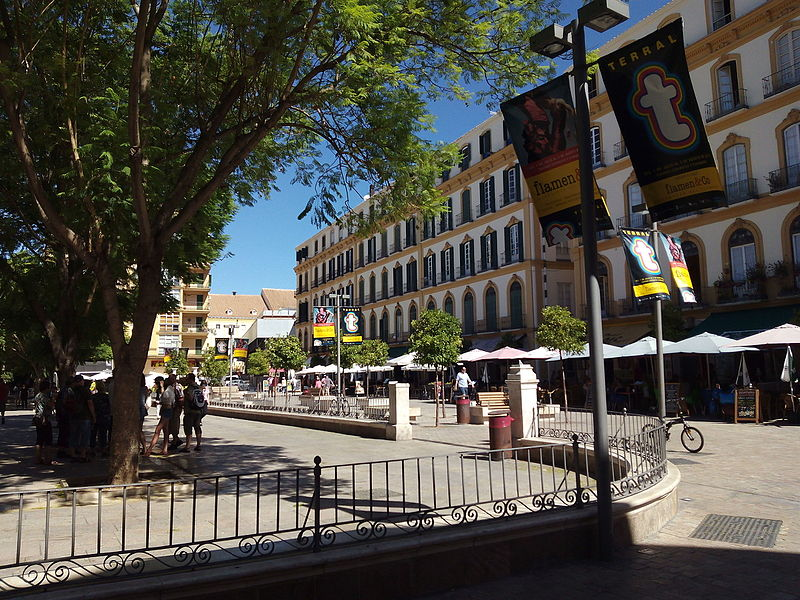
Above: View of the Plaza de la Merced in Málaga from the north. Pablo Ruiz Picasso was born at #15 of this building, located at #36 of the Plaza de la Merced in Málaga, right where the Picasso Foundation Birthplace Museum is located today.
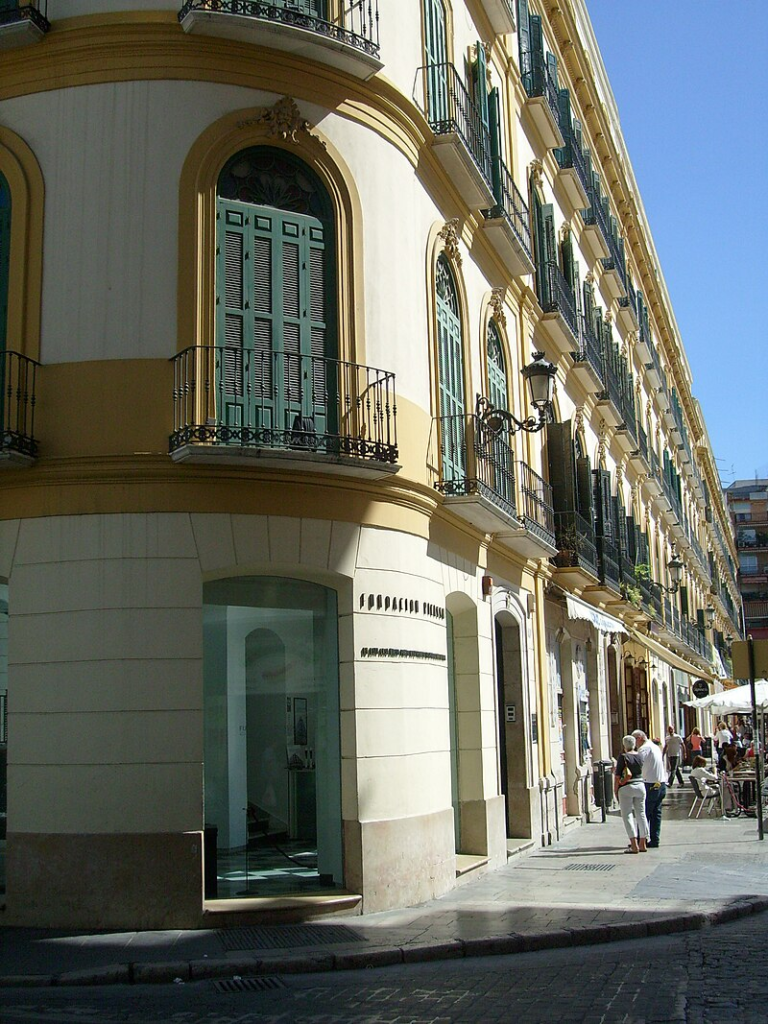
Above: Fundación Casa Natal Picasso, Málaga
His father was a painter who specialized in naturalistic depictions of birds and other game.
For most of his life, Ruiz was a professor of art at the School of Crafts and a curator of a local museum.
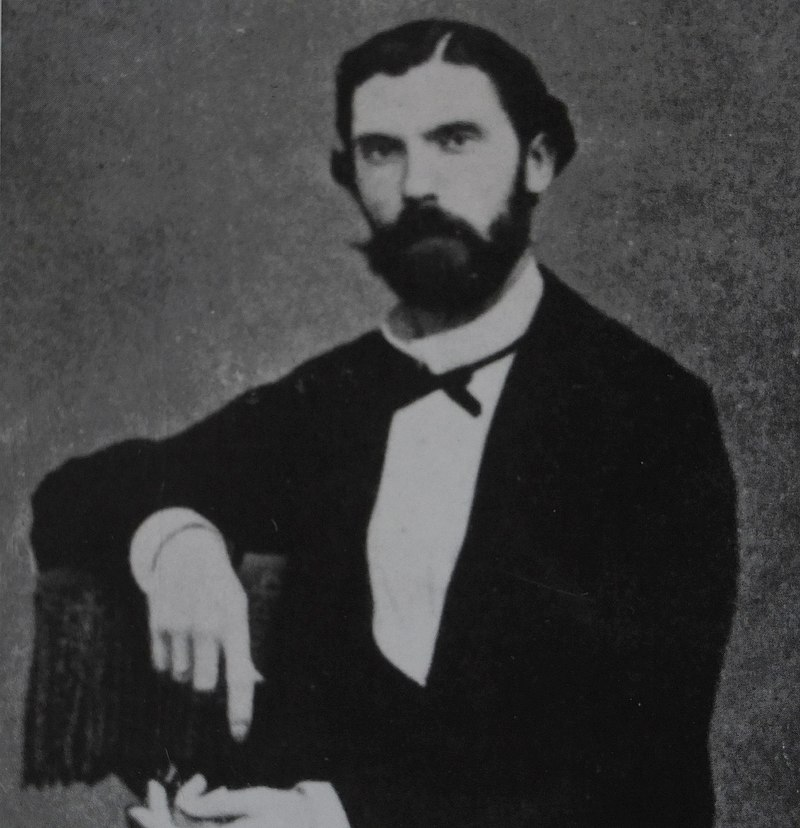
Above: José Ruiz y Biasco, Pablo Picasso’s father
“Art, as far as it is able, follows nature, as a pupil imitates his master.
Thus your art must be, as it were, God’s grandchild.”
Dante Aligheri
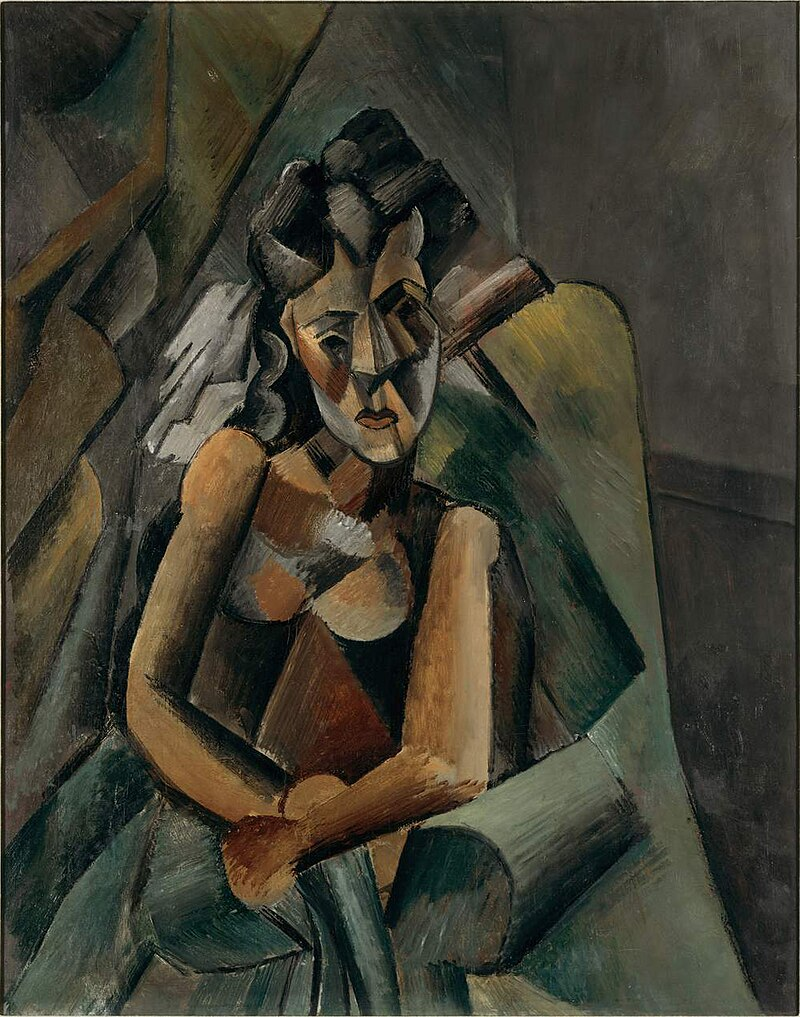
Above: Seated Woman, Pablo Picasso (1909), Neue Nationalgalerie, Berlin, Deutschland
Little is known about his mother.
Apparently she had a stronger personality than her husband, and Picasso always had greater respect and tenderness towards her, which some believe can be seen in the portrait he drew of her in 1923.
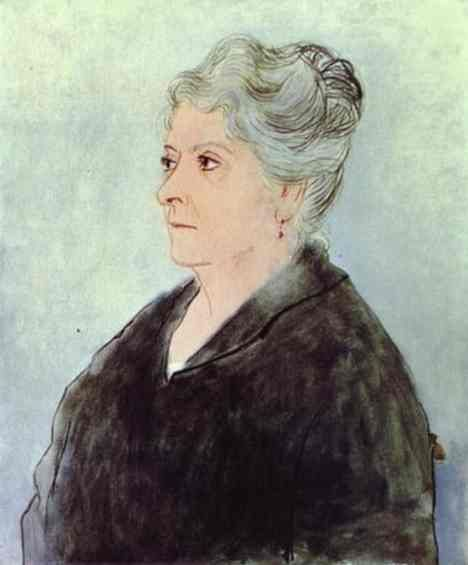
Above: Portrait of the artist’s mother, Pablo Picasso (1923), Museum Rhett, Arles, France
Picasso’s birth certificate and the record of his baptism include very long names, combining those of various saints and relatives.
Ruiz y Picasso were his paternal and maternal surnames, respectively, per Spanish custom.
The surname “Picasso” comes from Liguria, a coastal region of northwestern Italy.
Pablo’s maternal great-grandfather, Tommaso Picasso, moved to Spain around 1807.
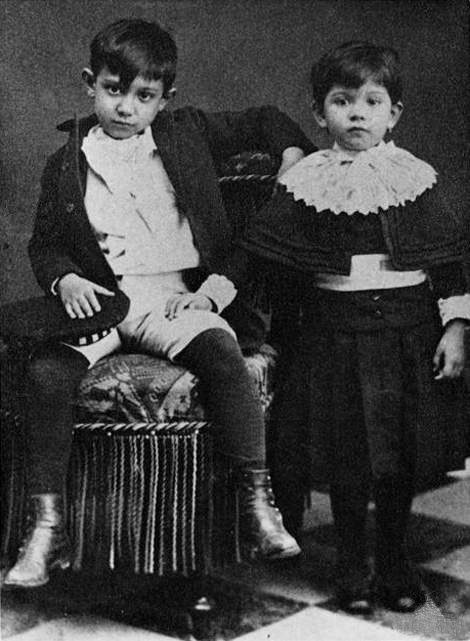
Above: Pablo Picasso with his sister Lola (1889)
“Art should not attempt to set up idols.
It should reveal existence as a reason for existing.“
Simone de Beauvoir
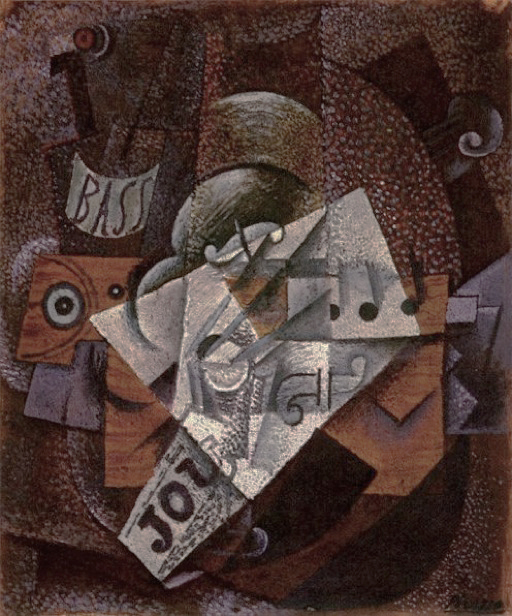
Above: Bouteille, clarinet, violon, journal, verre (bottle, clarinet, violin, newspaper, glass), Pablo Picasso (1913)
Picasso showed a passion and a skill for drawing from an early age.
According to his mother, his first words were “piz, piz“, a shortening of lápiz, the Spanish word for “pencil“.
From the age of seven, Picasso received formal artistic training from his father in figure drawing and oil painting.
Pablo began painting at an early age.
At the age of eight, after a bullfight and under the direction of his father, he painted El picador Amarillo (1889), his first oil painting , which he always refused to part with.
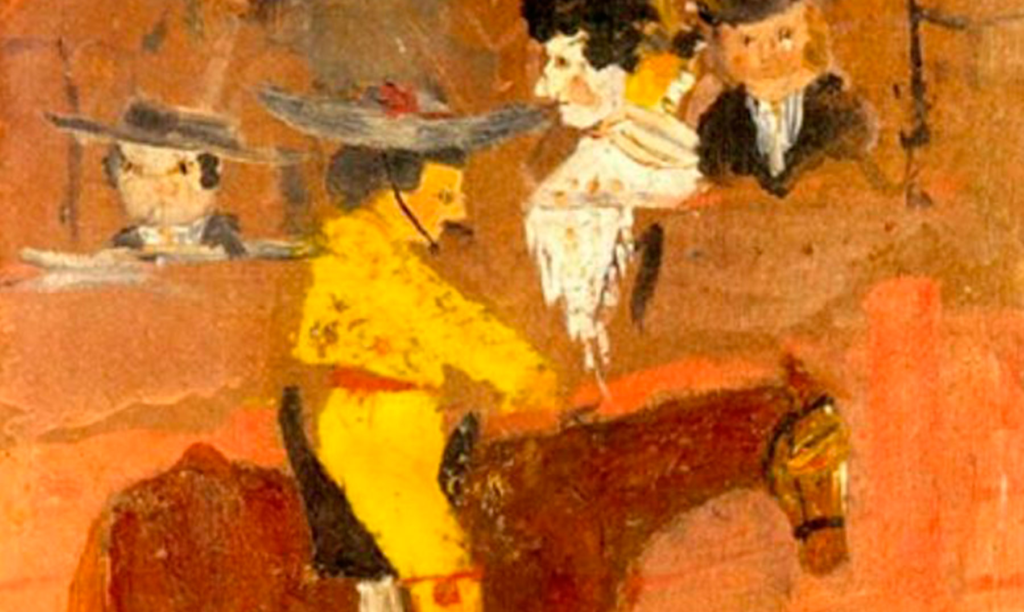
Above: El picador Amarillo (The yellow picador), Pablo Picasso (1889)
“Art is the beautiful illustration of Truth from the creative imagination.
The truth is in our life and unless it comes from the formlessness to the form we do not realize it.“
Laxmi Prasad Devkota
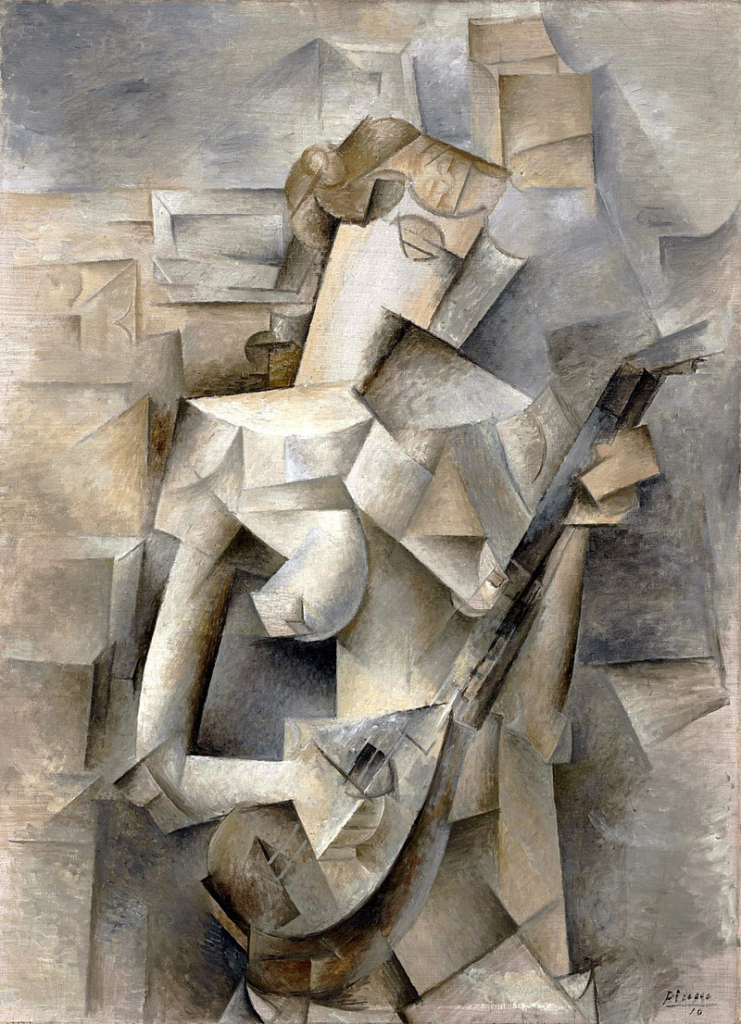
Above: Girl with a mandolin, Pablo Picasso (1910), Museum of Modern Art, New York City
Ruiz was a traditional academic artist and instructor, who believed that proper training required disciplined copying of the masters, and drawing the human body from plaster casts and live models.
His son became preoccupied with art to the detriment of his classwork.
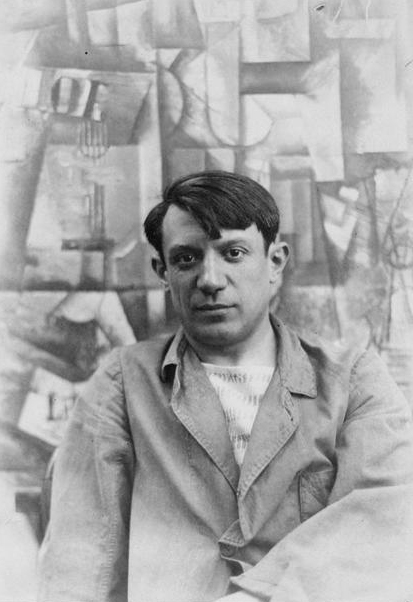
Above: Pablo Picasso (1912)
“Art is the complement of science.
Science as I have said is concerned wholly with relations, not with individuals.
Art, on the other hand, is not only the disclosure of the individuality of the artist but also a manifestation of individuality as creative of the future, in an unprecedented response to conditions as they were in the past.
Some artists in their vision of what might be but is not, have been conscious rebels.
But conscious protest and revolt is not the form which the labor of the artist in creation of the future must necessarily take.
Discontent with things as they are is normally the expression of the vision of what may be and is not, art in being the manifestation of individuality is this prophetic vision.“
John Dewey
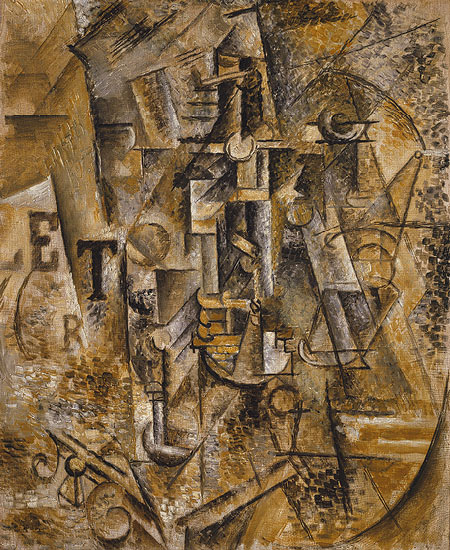
Above: Still life with a bottle of rum, Pablo Picasso (1911), Metropolitan Museum of Art, New York City
The family moved to A Coruña in 1891, where his father became a professor at the School of Fine Arts.
They stayed for almost four years.
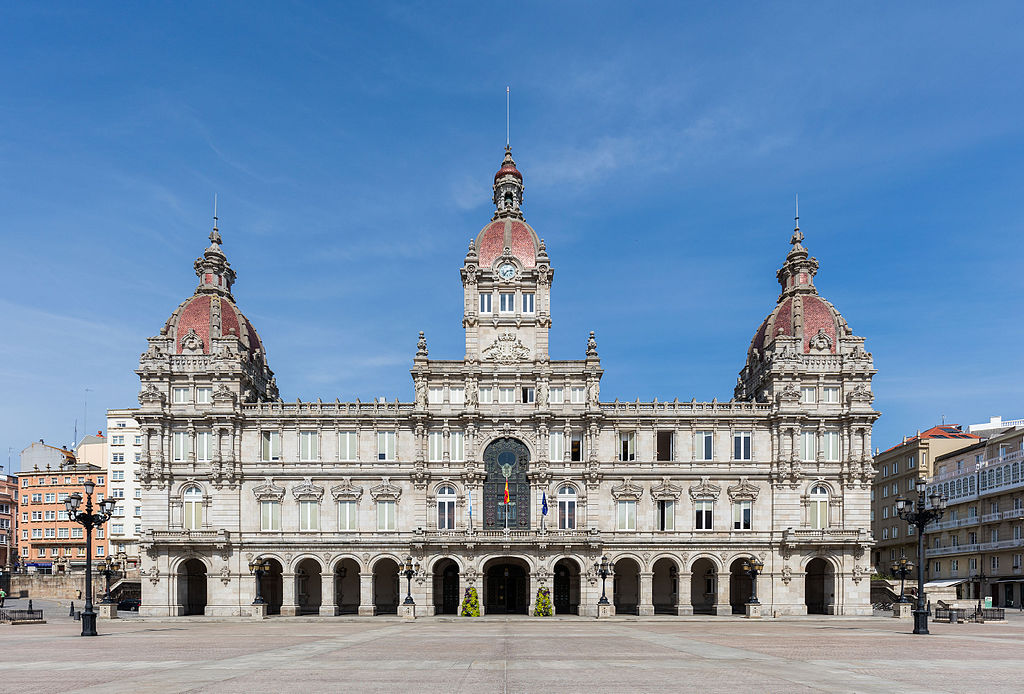
Above: Palacio Municipal, A Coruña, Galicia, España
On one occasion, the father found his son painting over his unfinished sketch of a pigeon.
Observing the precision of his son’s technique, an apocryphal story relates, Ruiz felt that the 13-year-old Picasso had surpassed him, and vowed to give up painting, though paintings by him exist from later years.
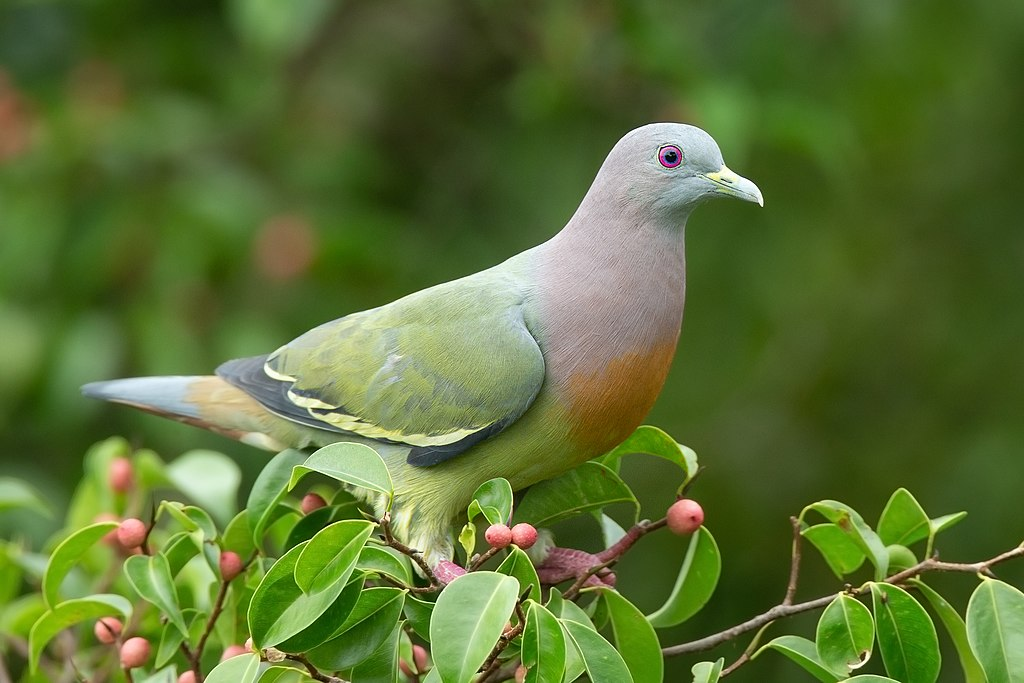
Above: Pink-necked green pigeon
“Art is not the possession of the few who are recognized writers, painters, musicians.
It is the authentic expression of any and all individuality.
Those who have the gift of creative expression in unusually large measure disclose the meaning of the individuality of others to those others.
In participating in the work of art, they become artists in their activity.
They learn to know and honour individuality in whatever form it appears.
The fountains of creative activity are discovered and released.
The free individuality which is the source of art is also the final source of creative development in time.”
John Dewey
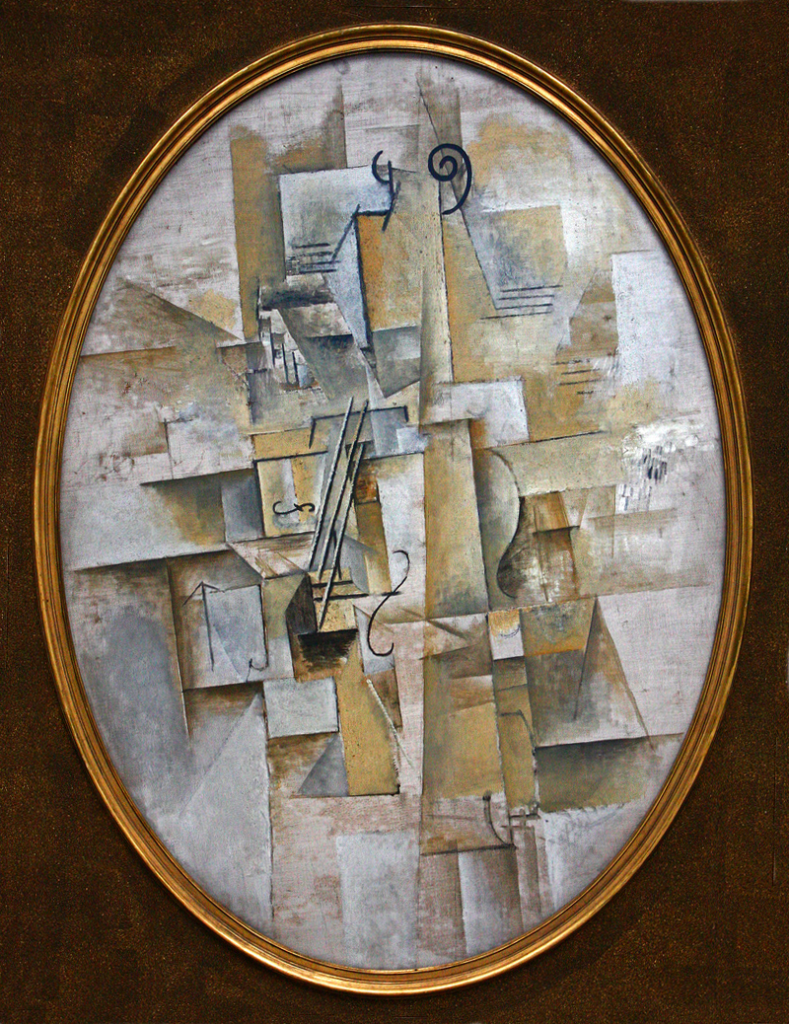
Above: Violin, Pablo Picasso (1912), Kröller-Müller Museum, Otterlo, Netherlands
In 1895, Picasso was traumatized when his seven-year-old sister, Conchita, died of diphtheria.
After her death, the family moved to Barcelona, where Ruiz took a position at its School of Fine Arts.
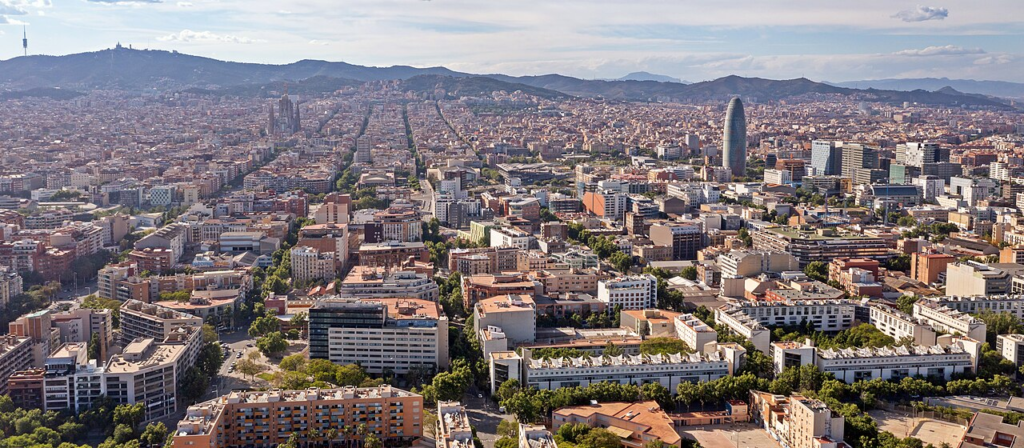
Above: Aerial view of Barcelona, Catalunya, España
“Art reveals the transitory as an absolute.
And as the transitory existence is perpetuated through the centuries, art too, through the centuries, must perpetuate this never-to-be-finished revelation.“
Simone de Beauvoir
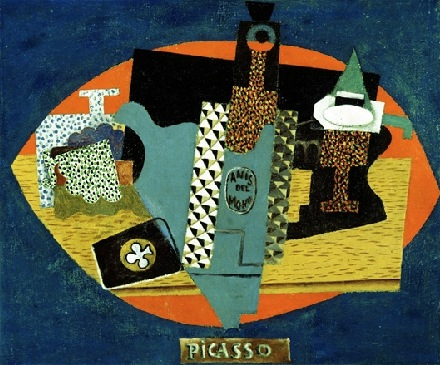
Above: L’anis del mono (Bottle of Anis del Mono), Pablo Picasso (1916), Detroit Institute of Arts
Picasso thrived in the city, regarding it in times of sadness or nostalgia as his true home.
Ruiz persuaded the officials at the academy to allow his son to take an entrance exam for the advanced class.
This process often took students a month, but Picasso completed it in a week.
The jury admitted him, at just 14.
A brilliant and precocious student, Picasso passed the entrance exam for the Ecole de la Lonja in a single day and was allowed to skip the first two classes.
According to one of the many legends about the artist, his father, after recognizing his son’s extraordinary talent upon seeing his early childhood works, gave him his brushes and palette and promised never to paint again in his life.
“Unlike music, there are no child prodigies in painting.
What people perceive as premature genius is the genius of childhood.
It does not gradually disappear as one grows older.
It is possible that such a child may become a real painter one day, perhaps even a great painter.
But he would have to start from scratch.
So, as far as I was concerned, I was not a genius.
My first drawings have never been shown at an exhibition of children’s drawings.
I lacked the clumsiness of a child, his naivety.
I made academic drawings at the age of seven, with a precision that frightens me.“
(Pablo Picasso)
As a student, Picasso lacked discipline but made friendships that would affect him in later life.
His father rented a small room for him close to home so he could work alone, yet he checked up on him numerous times a day, judging his drawings.
The two argued frequently.
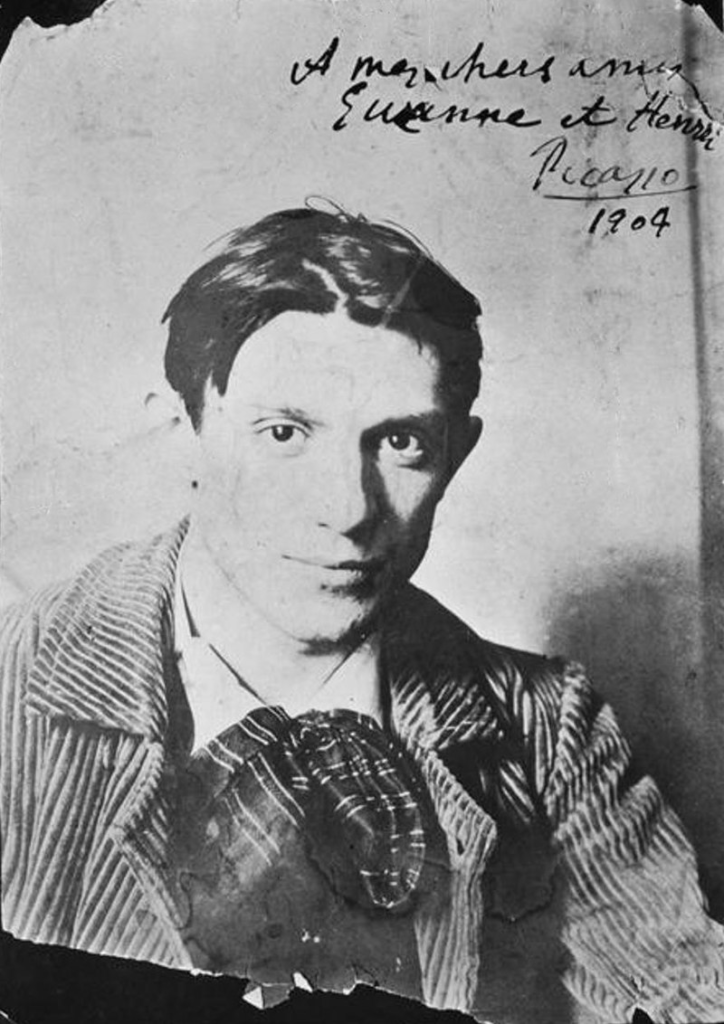
Above: Pablo Picasso (1904)
“The significant problems and issues of life and philosophy concern the rate and mode of the conjunction of the precarious and the assured, the incomplete and the finished, the repetitious and the varying, the safe and sane and the hazardous.
These traits, and the modes and tempos of their interaction with each other, are fundamental features of natural existence.
The experience of their various consequences, according as they are relatively isolated, unhappily or happily combined, is evidence that wisdom, and hence the love of wisdom which is philosophy, is concerned with choice and administration of their proportioned union.
Structure and process, substance and accident, matter and energy, permanence and flux, one and many, continuity and discreetness, order and progress, law and liberty, uniformity and growth, tradition and innovation, rational will and impelling desires, proof and discovery, the actual and the possible, are names given to various phases of their conjunction.
The issue of living depends upon the art with which these things are adjusted to each other.“
John Dewey
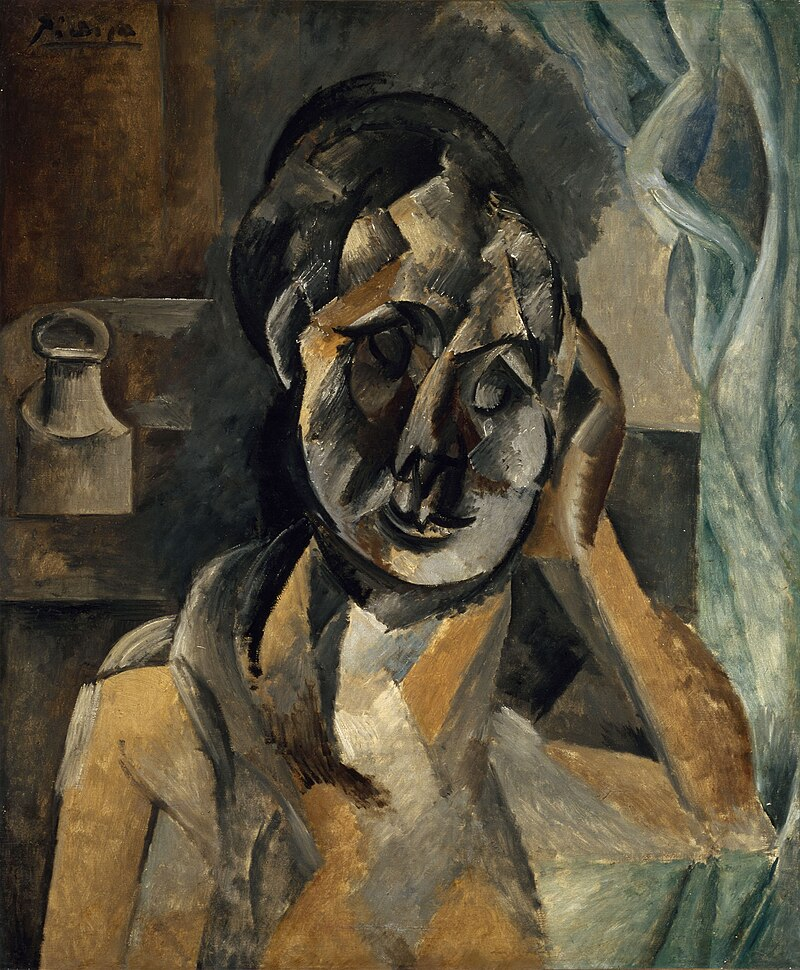
Above: Woman with mustard pot, Pablo Picasso (1910), Gemeentemuseum, Den Haag (The Hague), Netherlands
“The main thing to understand is that we are imprisoned in some kind of work of art.“
Rod Dickinson and Terence McKenna
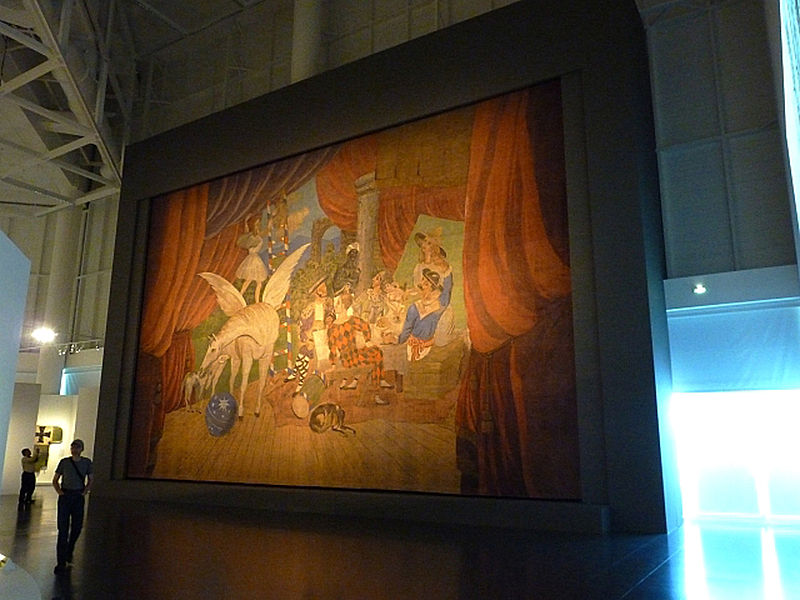
Above: Parade, Pablo Picasso (1917), Centre Pompidou-Metz, Metz, France
Picasso’s father and uncle decided to send the young artist to Madrid’s Real Academia de Bellas Artes de San Fernando, the country’s foremost art school.
At age 16, Picasso set off for the first time on his own, but he disliked formal instruction and stopped attending classes soon after enrollment.
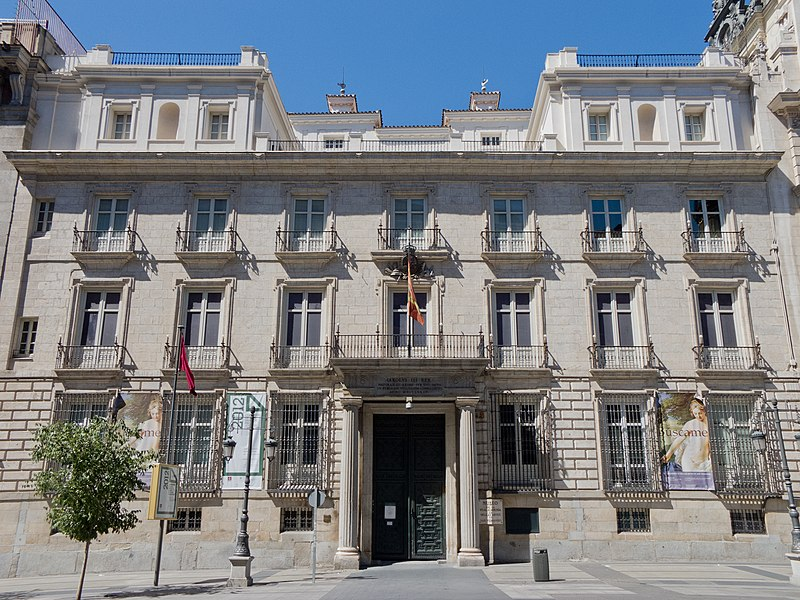
Above: Palacio de Goyeneche, Real Academia de Bellas Artes de San Fernando, Madrid, España
Madrid held many other attractions.
The Prado housed paintings by Diego Velázquez, Francisco Goya and Francisco Zurbarán.
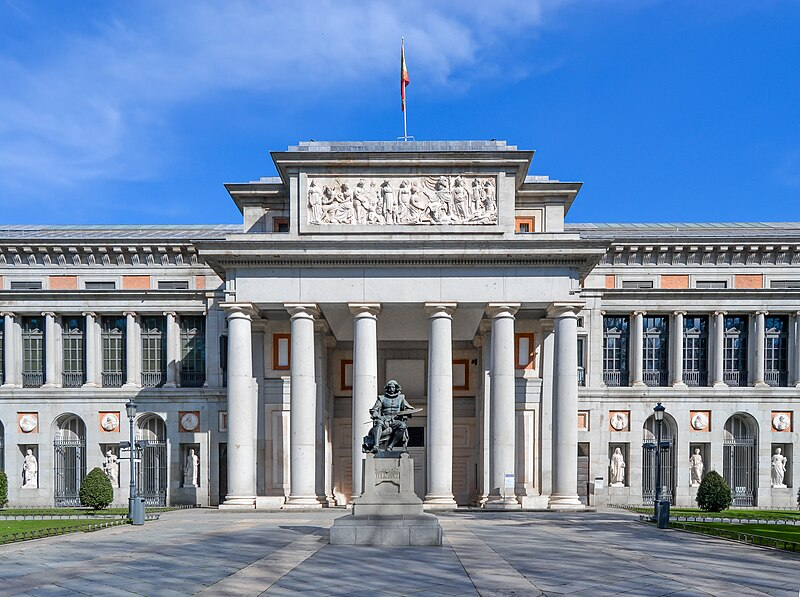
Above: Front façade of the Museo del Prado, Madrid, España
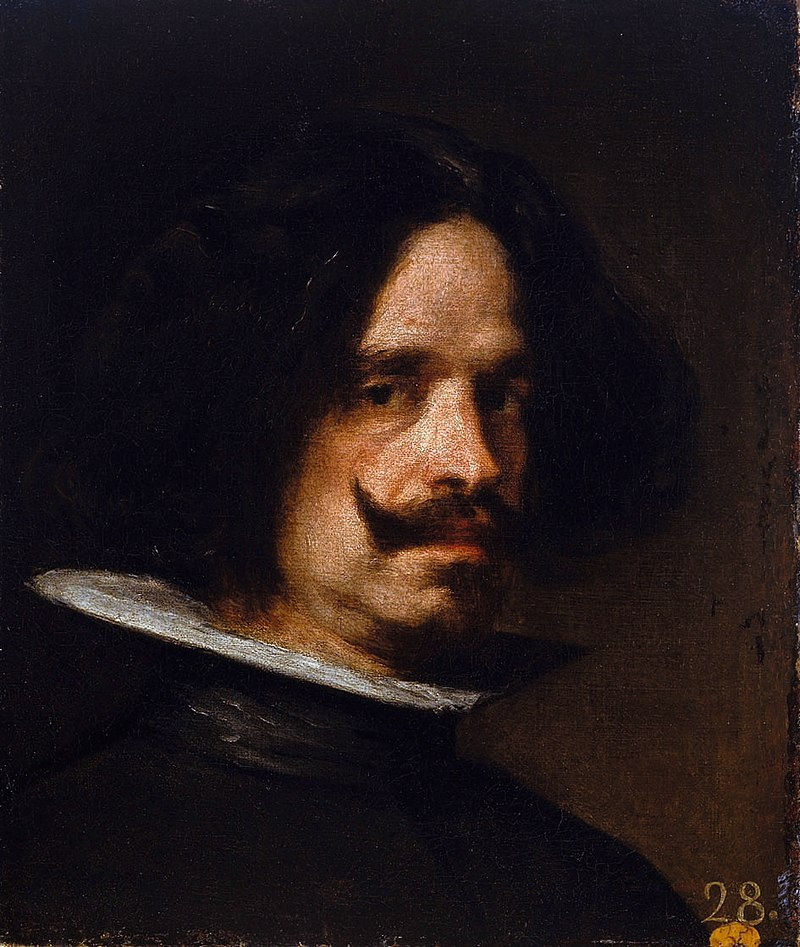
Above: Self portrait, Diego Velázquez (1599 – 1660)
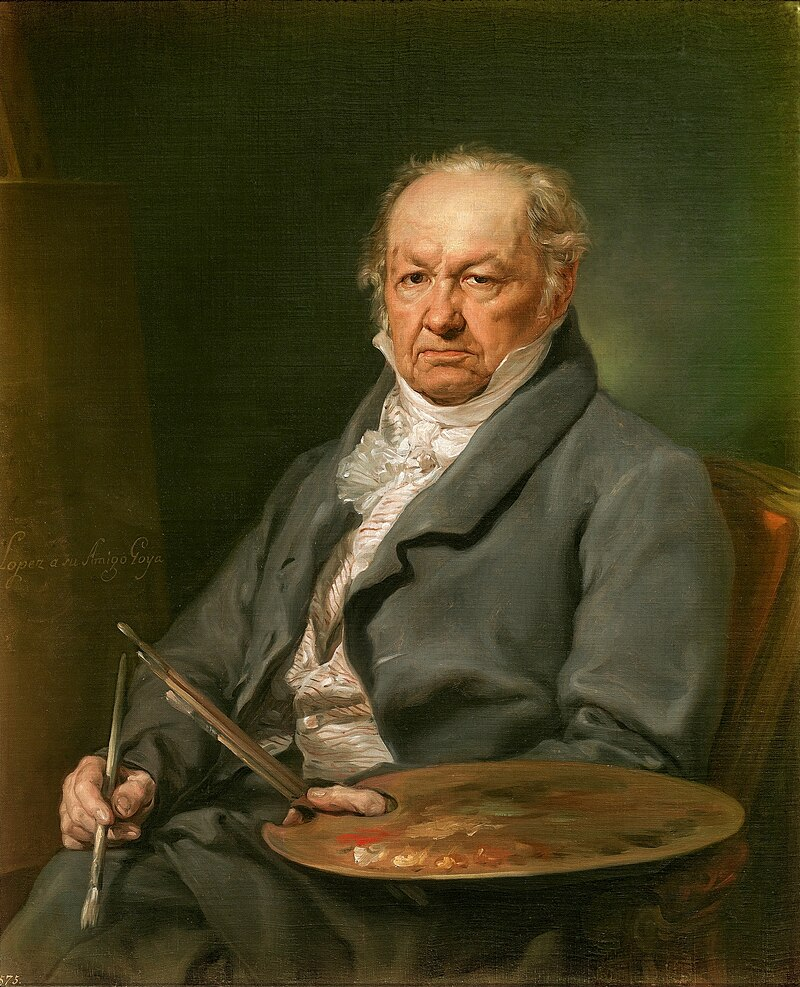
Above: Francisco de Goya (1746 – 1828)
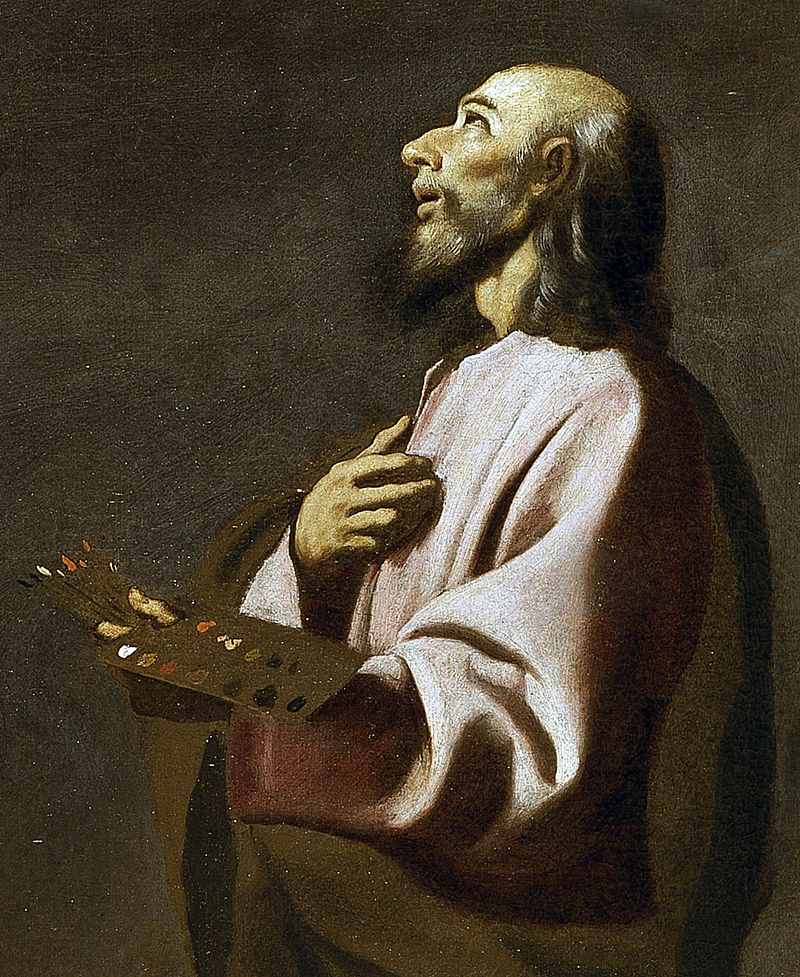
Above: Self-portrait as St. Luke, Francisco de Zurbarán (1598 – 1664)
Picasso especially admired the works of El Greco.
Elements such as his elongated limbs, arresting colours, and mystical visages are echoed in Picasso’s later work.
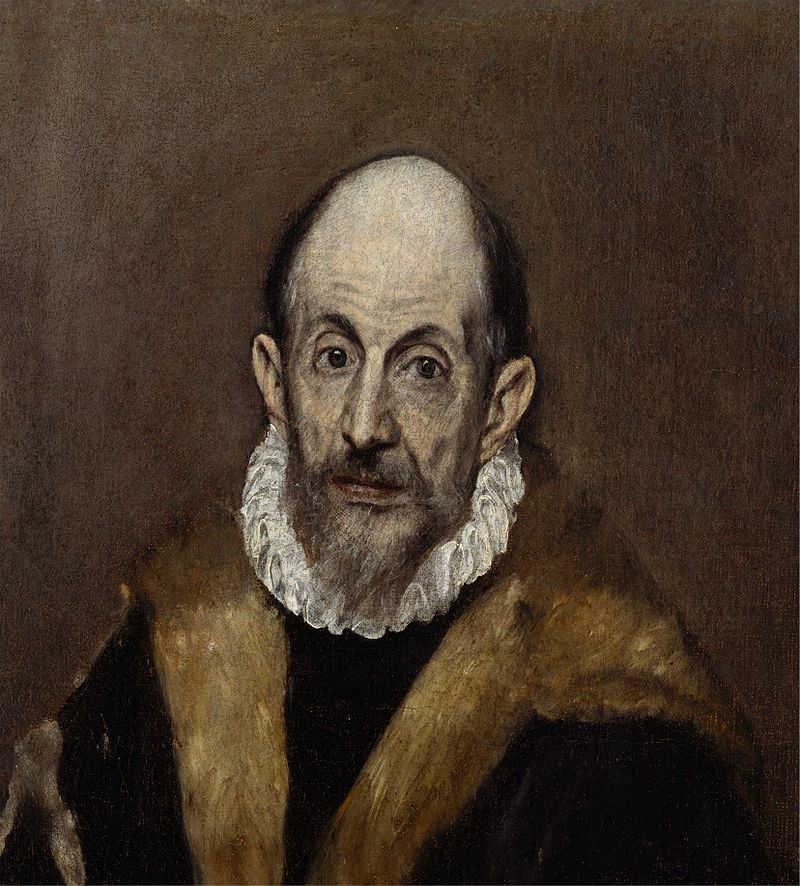
Above: Portrait of a Man (self portrait), El Greco (né Doménikos Theotokópoulos)(1541 – 1614)
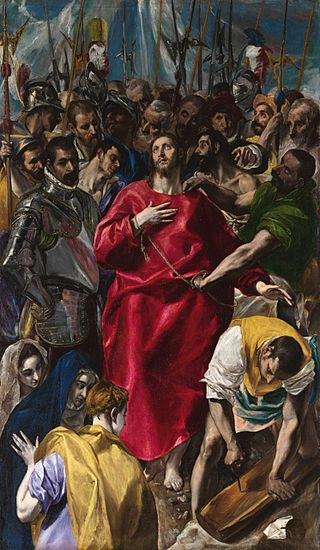
Above: El Expolio (The disrobing of Christ), El Greco (1577), Sacristy of the Cathedral, Toledo, España
“All passes, Art alone
Enduring stays to us;
The bust outlasts the throne,
The coin, Tiberius.“
Austin Dobson
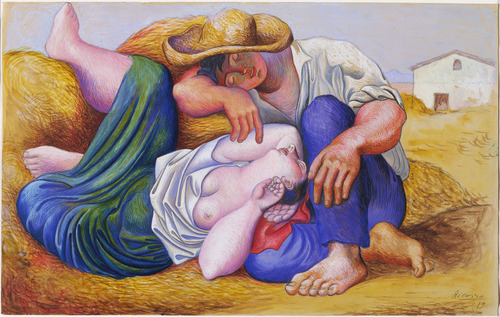
Above: Sleeping peasants, Pablo Picasso (1919), Museum of Modern Art, New York City
Picasso’s training under his father began before 1890.
His progress can be traced in the collection of early works now held by the Museo Picasso in Barcelona, which provides one of the most comprehensive extant records of any major artist’s beginnings.
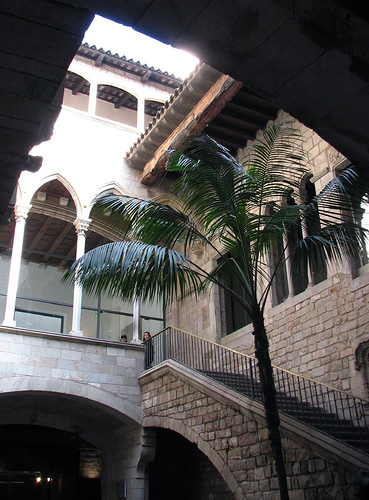
Above: Museo Picasso Barcelona
During 1893 the juvenile quality of his earliest work falls away, and by 1894 his career as a painter can be said to have begun.
The academic realism apparent in the works of the mid-1890s is well displayed in The First Communion (1896), a large composition that depicts his sister, Lola.
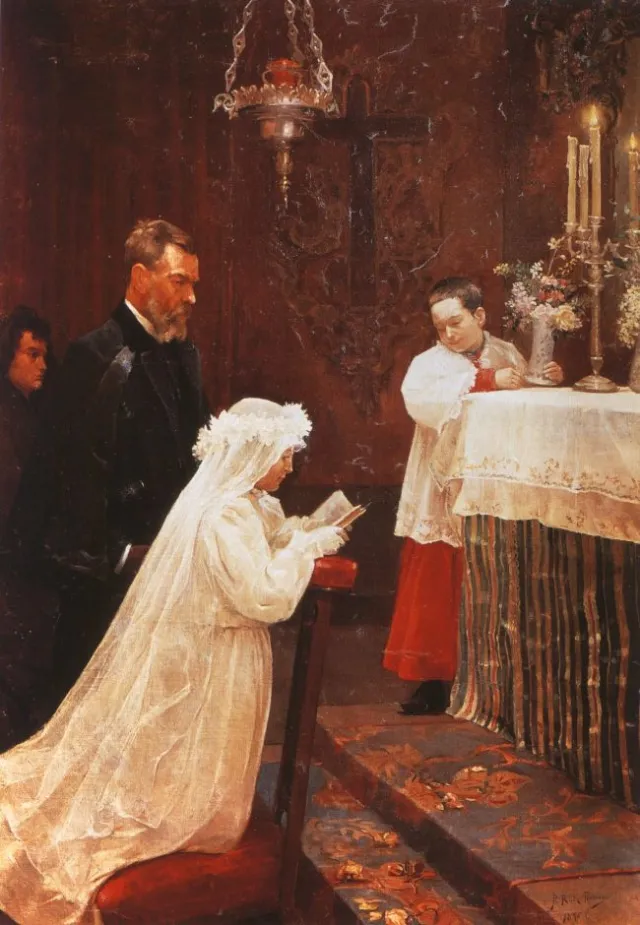
Above: The First Communion, Pablo Picasso (1896), Museo Picasso Barcelona
In the same year, at the age of 14, he painted Portrait of Aunt Pepa, a vigorous and dramatic portrait that Juan-Eduardo Cirlot has called “without a doubt one of the greatest in the whole history of Spanish painting“.
He lived in Barcelona for about nine years, except for some summer holidays and more or less long stays in Madrid and Paris.
In 1897, his realism began to show a Symbolist influence, for example, in a series of landscape paintings rendered in non-naturalistic violet and green tones.
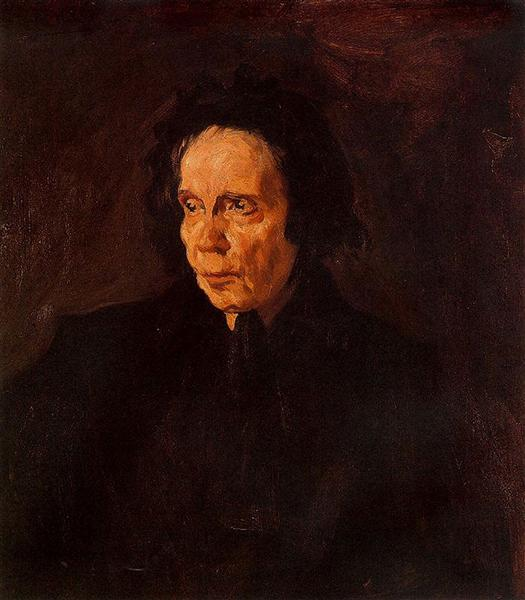
Above: Portrait of Aunt Pepa, Pablo Picasso (1896), Museo Picasso Barcelona
“Art can only flourish in total freedom.
In an artists’ assembly I recently stated:
The artist must, as an artist, be an anarchist and as a member of society, as a citizen dependent on the bourgeoisie for the necessities of life, a socialist.
The state can give the artist no other advice than that he freely and independently follow his innermost impulses, and that is the best the state can do to encourage art:
That it gives the artist complete freedom of his artistic action.
Its concern, and its justified concern, is that the artist be able to live, that he be able to exist as an economic entity.“
Kurt Eisner
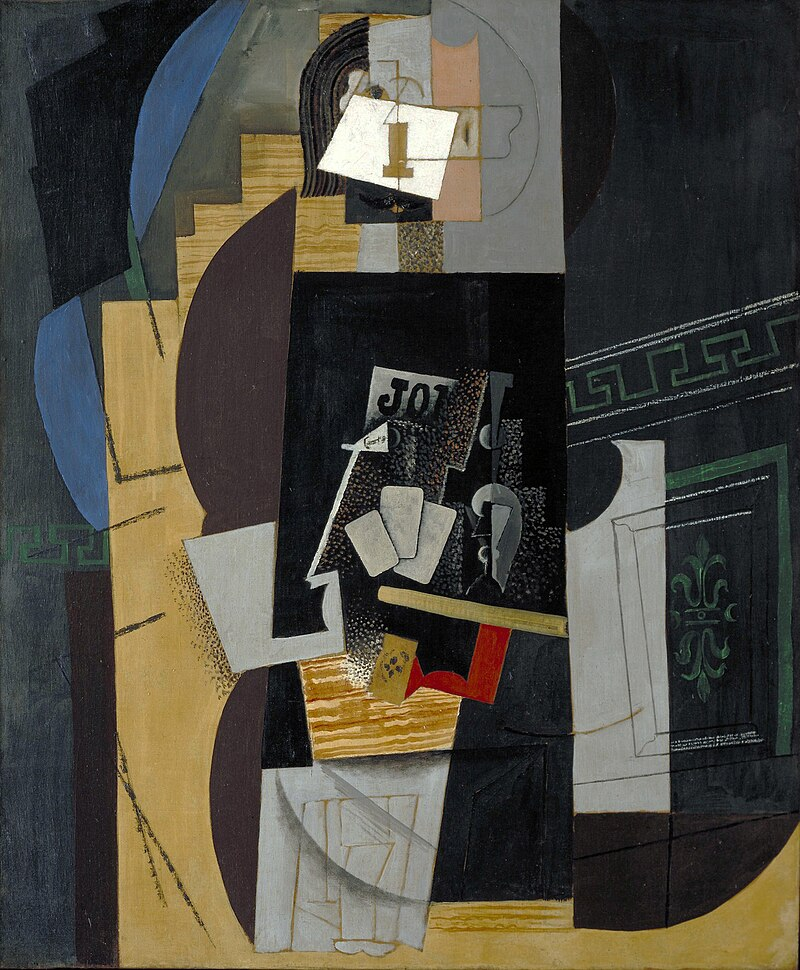
Above: L’Homme aux cartes (Card player), Pablo Picasso (1914), Museum of Modern Art, New York City
In 1897, his realism began to show a Symbolist influence, for example, in a series of landscape paintings rendered in non-naturalistic violet and green tones.
In 1897 he presented the canvas Science and Charity (Museo Picasso, Barcelona) at the General Exhibition of Fine Arts in Madrid.
During the summer he spent his holidays once again in Malaga, where he painted landscapes and bullfights .
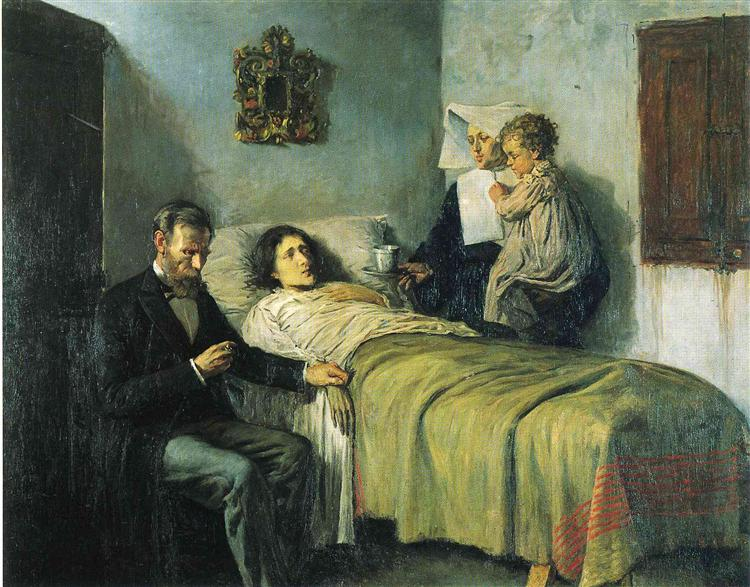
Above: Science and Charity, Pablo Picasso (1897), Museo Picasso, Barcelona
He returned to Barcelona in June 1898, ill with scarlet fever and moved to Horta de San Joan, the town of his friend Manuel Pallarés.
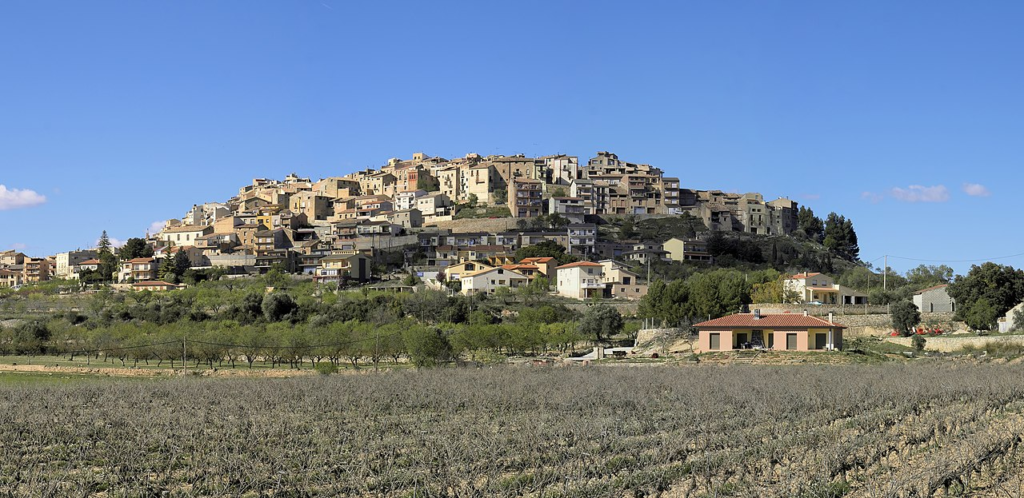
Above: Horta de Sant Joan village, Cataluña, España
During this stay, Picasso reconnected with the country’s primordial roots and with a certain return to nature, more in line with the modernist ideal, which constituted one of the first “primitivist” episodes of his career.
Having abandoned his intention of living in Madrid to devote himself to copying the great masters, in February 1899 he was back in Barcelona, where he began to frequent the Els Quatre Gats brewery , the symbol of modernist bohemianism and the place where he held his first solo exhibition and made friends with Jaime Sabartés and Carlos Casagemas.
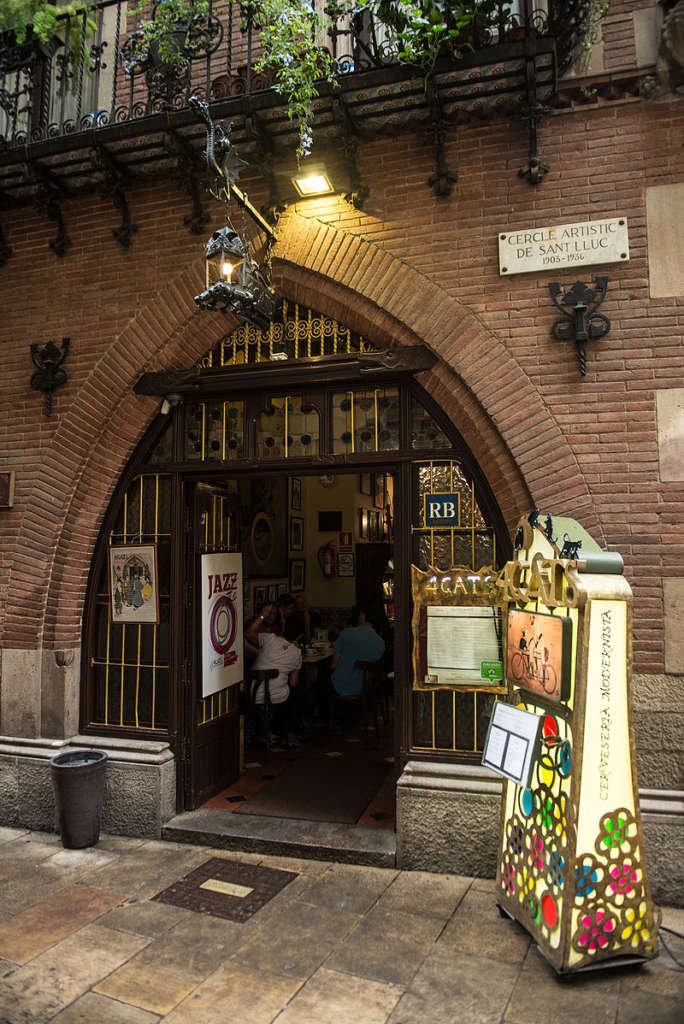
Above: Entrance to the Els Quatre Gats (The Four Cats) café, Barcelona
Picasso came into contact with anarchist thought.
The prevailing misery in the slums of Barcelona, the sick and wounded soldiers returning to Spain after the disastrous Cuban War of Independence (1895 – 1898), created a breeding ground for social violence that marked Picasso’s sensitivity on an individual and moral level rather than purely politically, and which can be appreciated in certain drawings made between 1897 and 1901: for example, The Prisoner and An Anarchist Meeting.

Above: The Prisoner, Pablo Picasso (1901), Museo Picasso, Barcelona
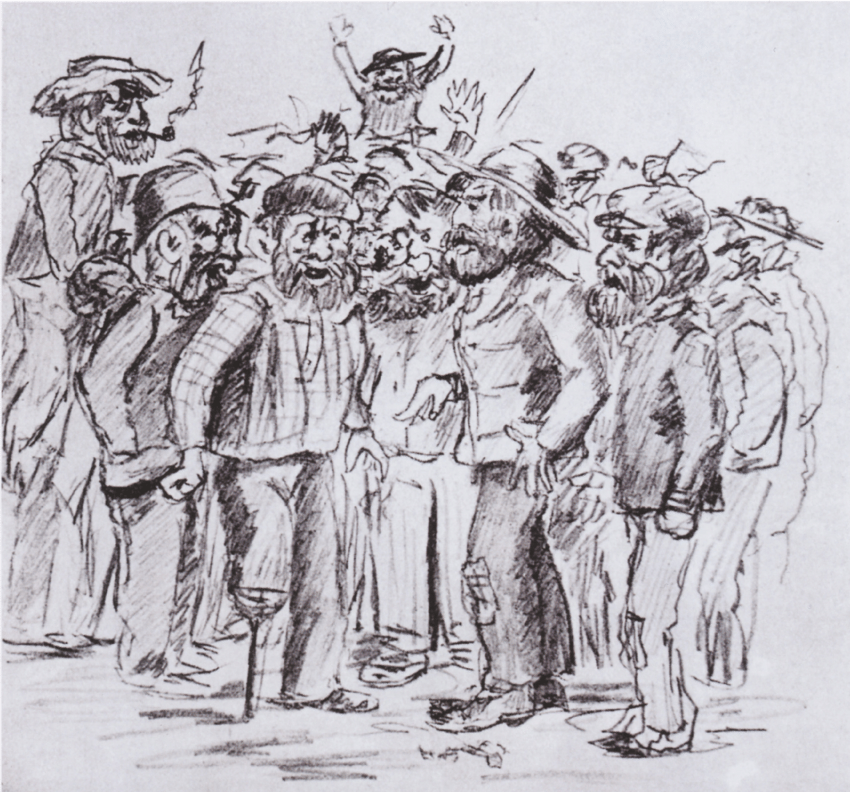
Above: Congreso de anarquistas (An anarchist meeting), Pablo Picasso (1893), Museo de Bellas Artes, A Coruna, España
What some call his Modernist period (1899 – 1900) followed.
His exposure to the work of Rossetti, Steinlen, Toulouse-Lautrec and Edvard Munch, combined with his admiration for favourite old masters such as El Greco, led Picasso to a personal version of modernism in his works of this period.
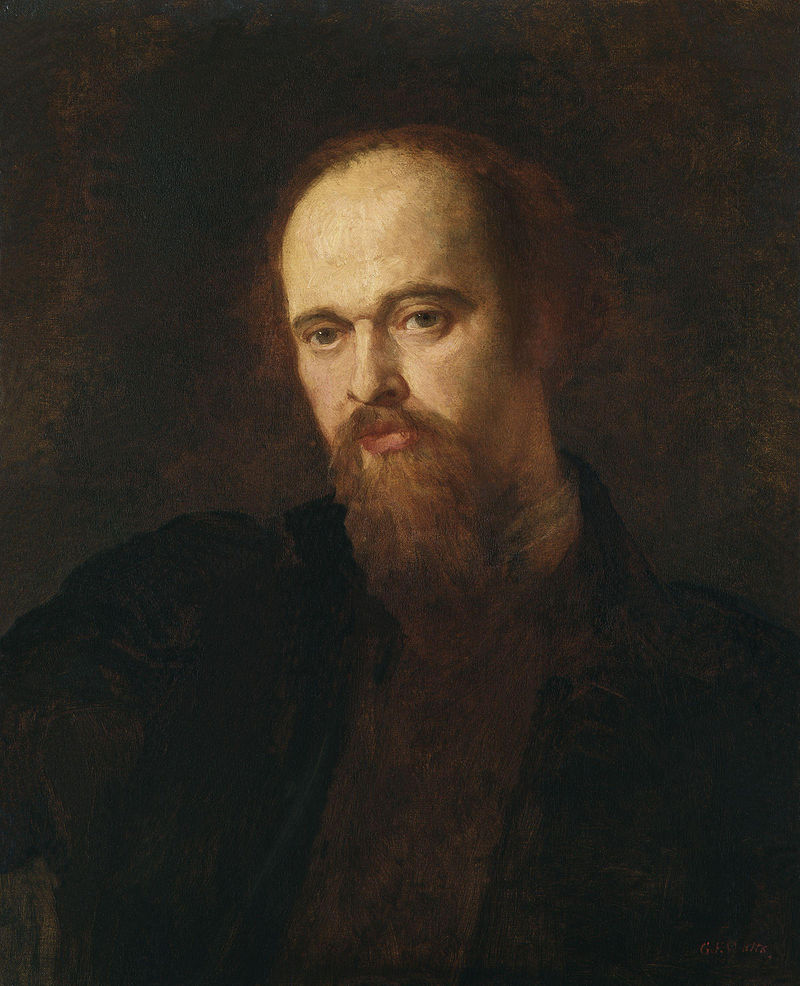
Above: English artist Dante Gabriel Rossetti (1828 – 1882)
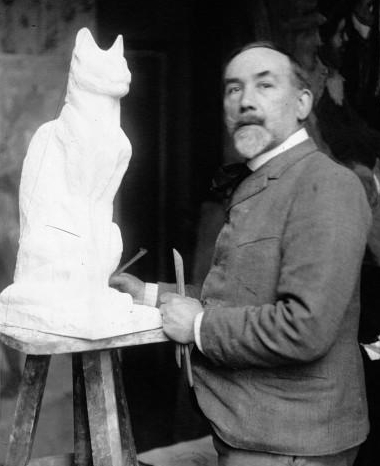
Above: Swiss-born French artist Théophile Steinlen (1859 – 1923)
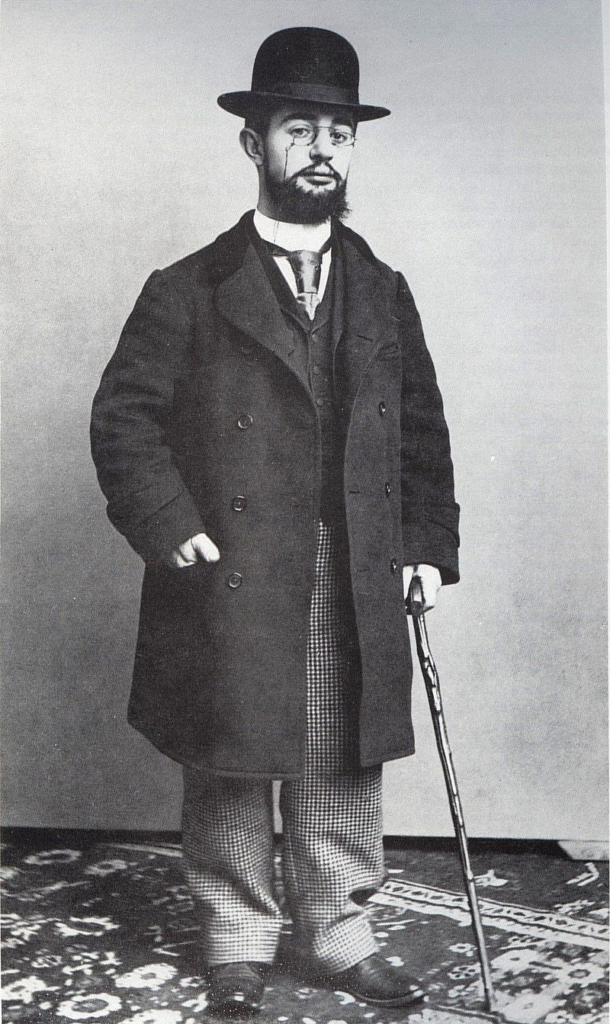
Above: French artist Henri de Toulouse-Lautrec (1864 – 1901)
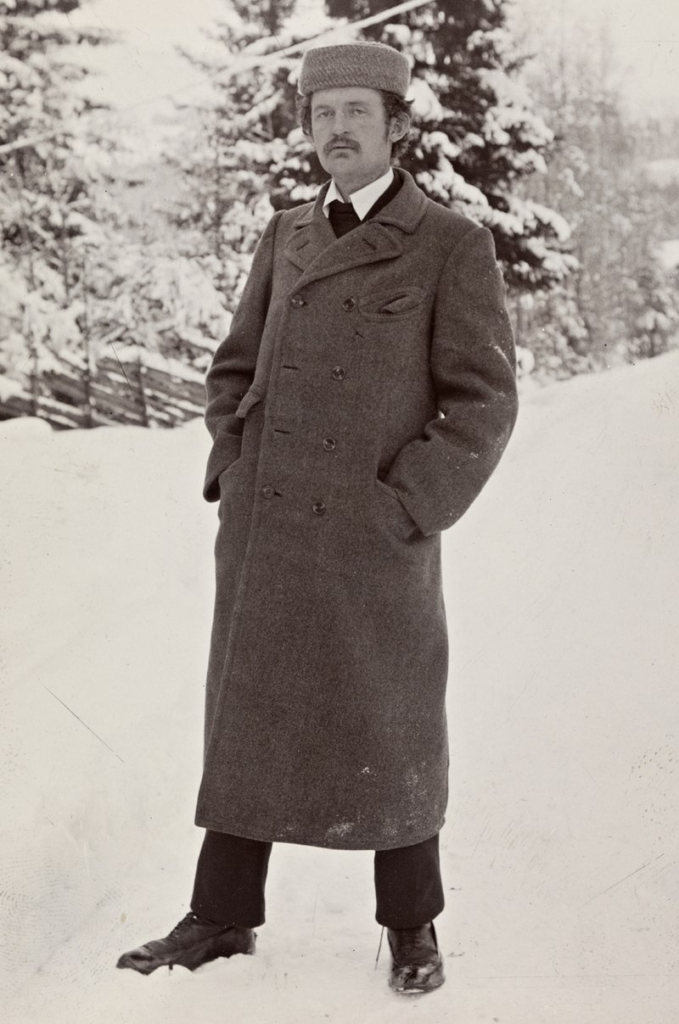
Above: Norwegian painter Edvard Munch (1863 – 1944)
“The conscious utterance of thought, by speech or action, to any end, is art.“
Ralph Waldo Emerson
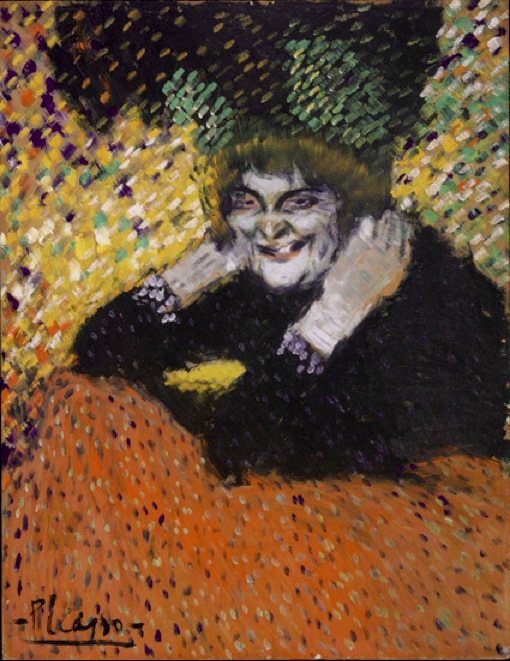
Above: Old Woman with Gloves, Pablo Picasso (1901), Philadelphia
Picasso made his first trip to Paris, then the art capital of Europe, in 1900.
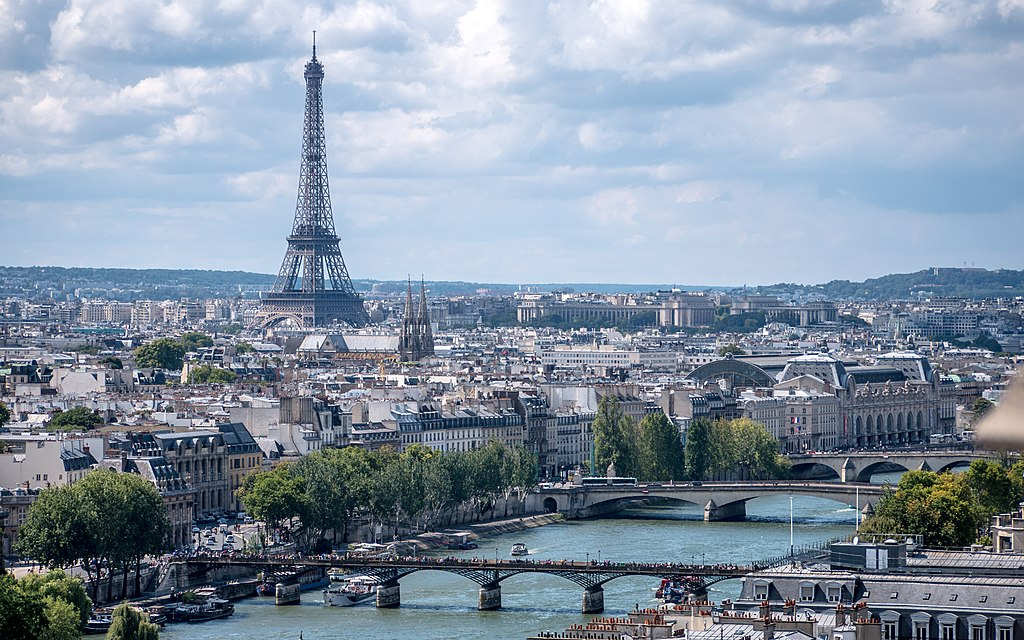
Above: Paris, France
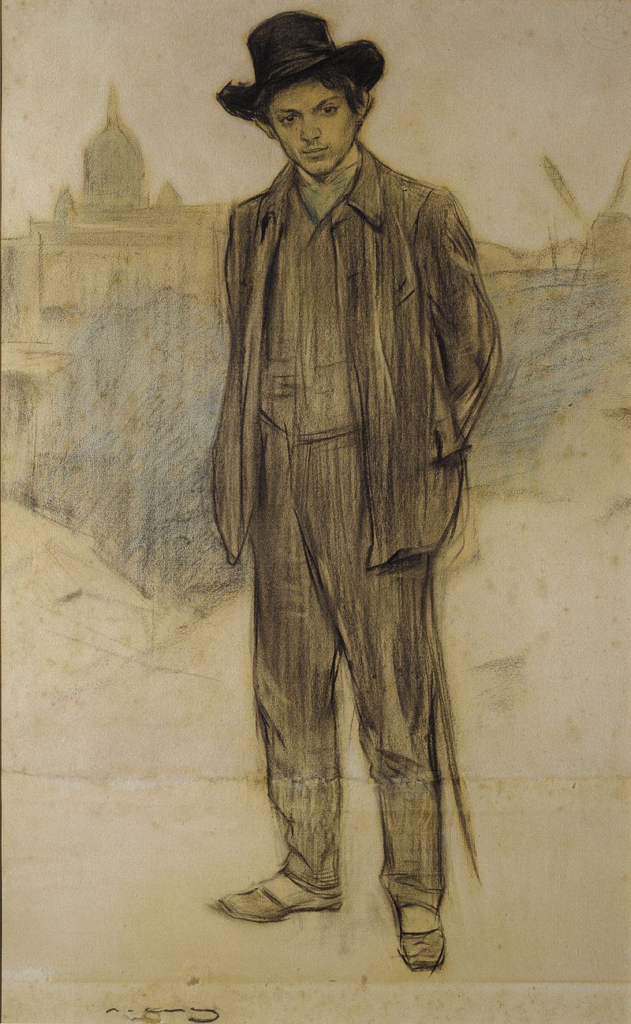
Above: Portrait of Picasso, Ramón Casas (1900), Museo Nacional de Arte de Cataluña (National Museum of Art of Catalonia), Barcelona
In Paris he settled in the studio of Isidre Nonell, a Catalan artist whom Picasso knew from the Els Quatre Gats group, influenced by Impressionism and who reflected the Catalan social situation at the beginning of the century through portraits of marginalized and miserable characters.
Nonell’s work, along with that of Toulouse-Lautrec, greatly influenced Picasso’s style at this time, which can be seen in works such as Waiting (Margot), Dwarf Dancer and The End of the Performance, both from 1901.
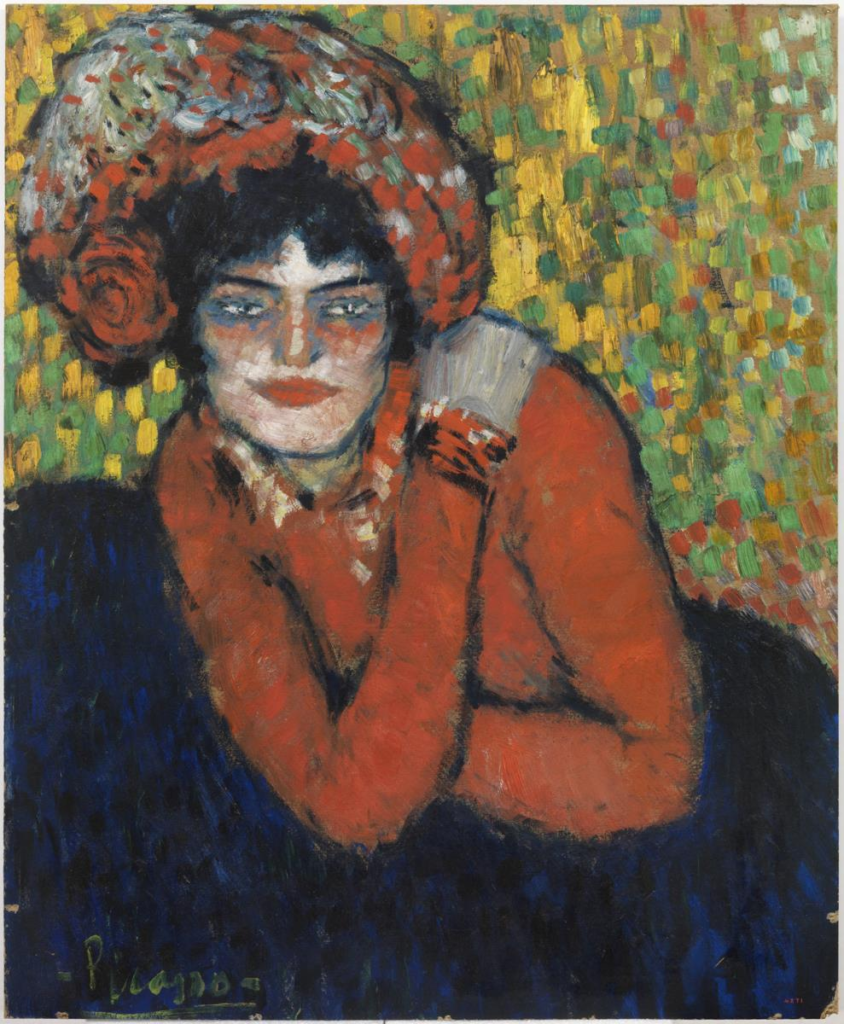
Above: Waiting (Margot), Pablo Picasso (1901), Museu Picasso, Barcelona
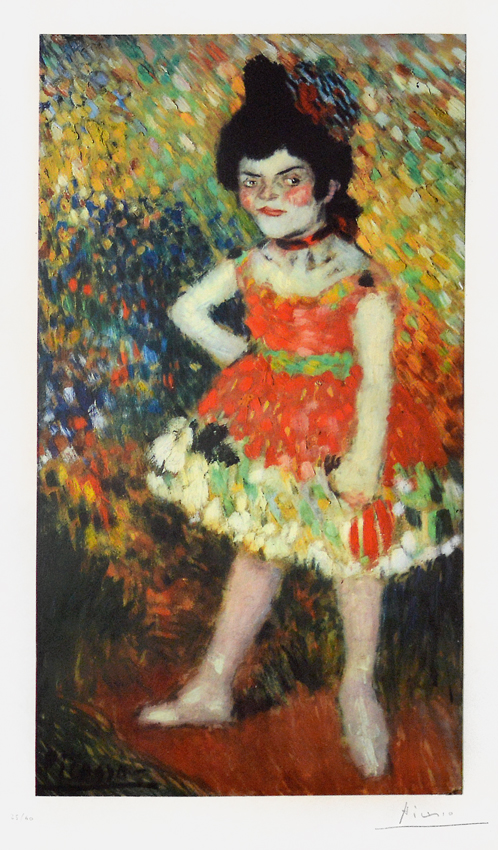
Above: Danseuse naine (Dwarf Dancer), Pablo Picasso (1901)
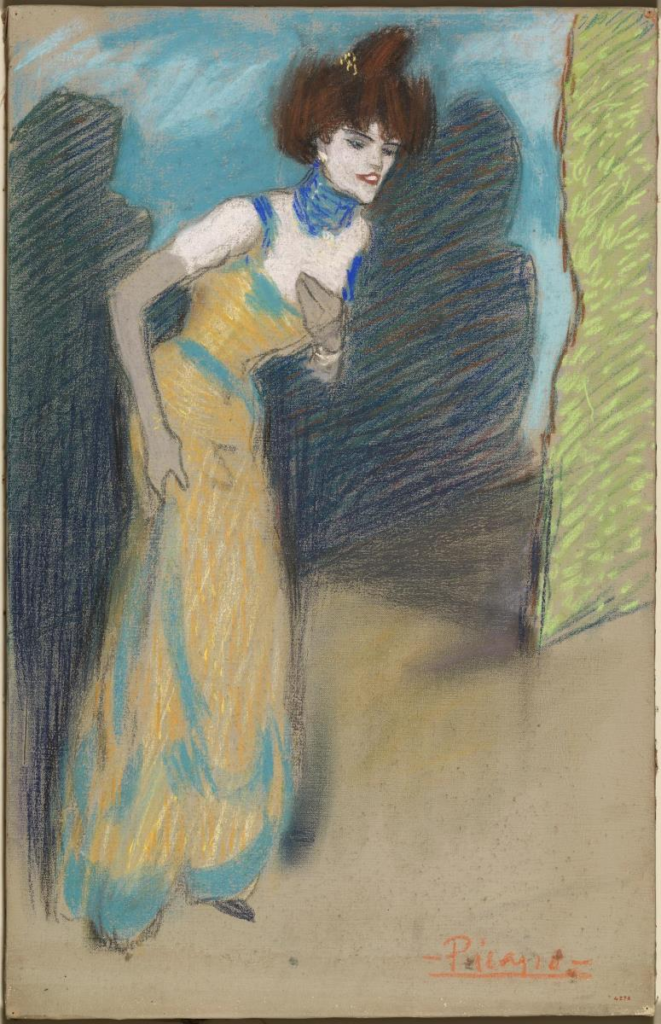
Above: The End of the Performance, Pablo Picasso (1901), Museu Picasso, Barcelona
He also met the man who would be his first dealer, Pere Mañach (who offered him 150 francs a month for all his work for a year) and came into contact with the gallery owner Berthe Weill.
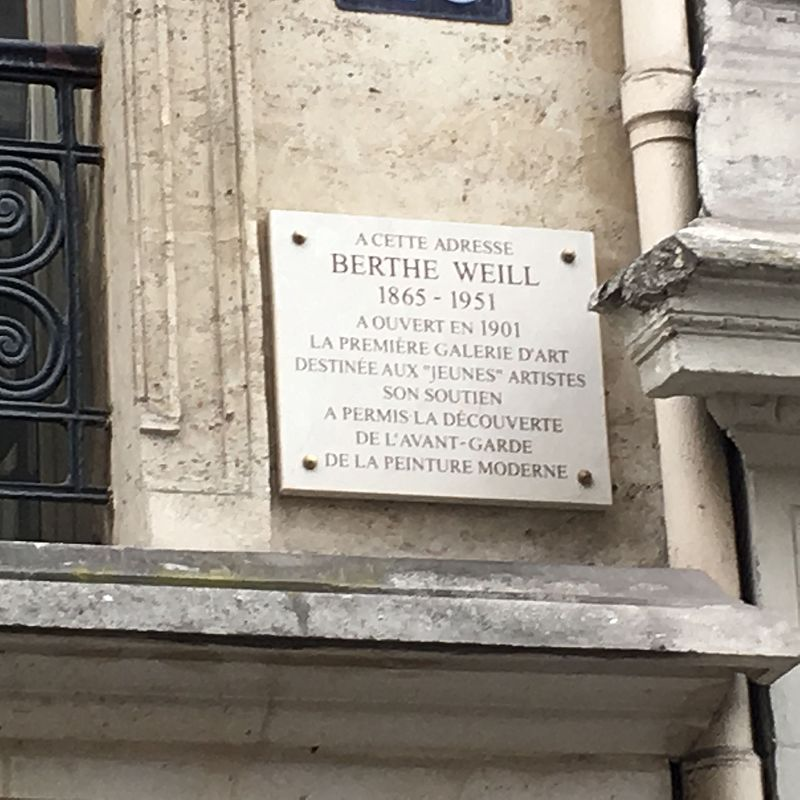
Above: Commemorative plaque at the site of Berthe Weill’s gallery at 25 rue Victor Massé (Montmartre) in Paris
He returned to Barcelona on 23 December with Casagemas, whom Picasso took with him to celebrate New Year’s Eve in Málaga.
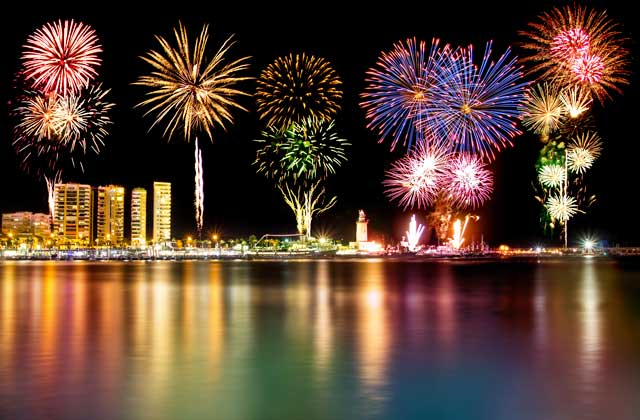
Above: New Year’s Eve, Málaga
He met his first Parisian friend, journalist and poet Max Jacob, who helped Picasso learn the language and its literature.
Soon they shared an apartment.
Max slept at night while Picasso slept during the day and worked at night.
These were times of severe poverty, cold and desperation.
Much of his work was burned to keep the small room warm.
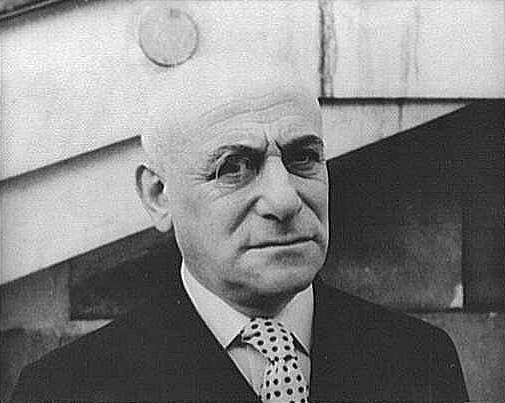
Above: French artist Max Jacob (1876 – 1944)
In the Far North, where humans must face the constant threat of starvation, where life is reduced to the bare essentials — it turns out that one of these essentials is art.
Art seems to belong to the basic pattern of life of the Inuıt and of the neighboring Athapaskan and Algonquian bands as well.
Peter Farb
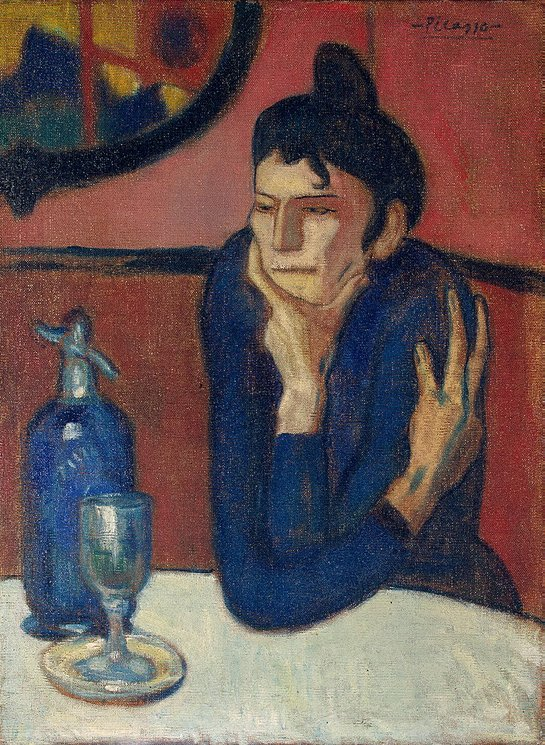
Above: Femme au café (Absinthe Drinker), Pablo Picasso (1902), Hermitage Museum, St. Petersburg, Russia
During the first five months of 1901, Picasso lived in Madrid, where he and his anarchist friend Francisco de Asís Soler founded the magazine Arte Joven (Young Art), which published five issues.
Soler solicited articles and Picasso illustrated the journal, mostly contributing grim cartoons depicting and sympathizing with the state of the poor.
The first issue was published on 31 March 1901, by which time the artist had started to sign his work Picasso.
From 1898 he signed his works as “Pablo Ruiz Picasso“, then as “Pablo R. Picasso” until 1901.
The change does not seem to imply a rejection of the father figure.
Rather, he wanted to distinguish himself from others.
Initiated by his Catalan friends who habitually called him by his maternal surname, much less current than the paternal Ruiz.
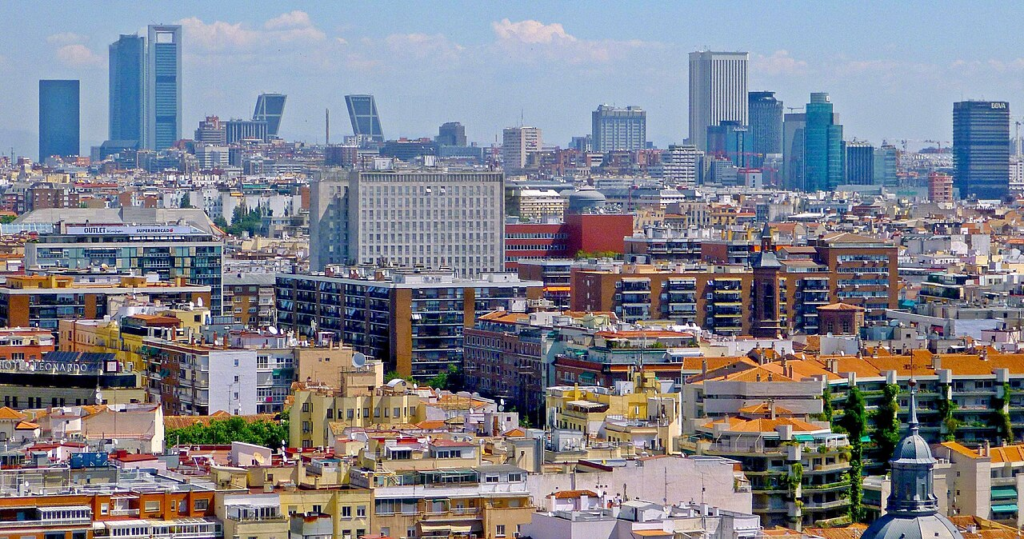
Above: Madrid, España
“All art is autobiographical.
The pearl is the oyster’s autobiography.“
Federico Fellini
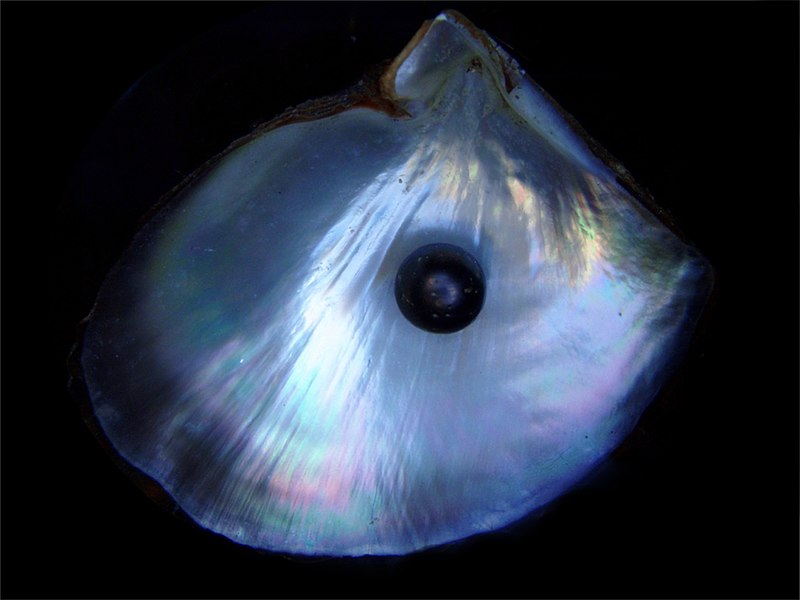
Above: A black pearl and its shell
Picasso’s Blue Period (1901 – 1904), characterized by sombre paintings rendered in shades of blue and blue-green only occasionally warmed by other colours, began either in Spain in early 1901 or in Paris in the second half of the year.
Many paintings of gaunt mothers with children date from the Blue Period, during which Picasso divided his time between Barcelona and Paris.
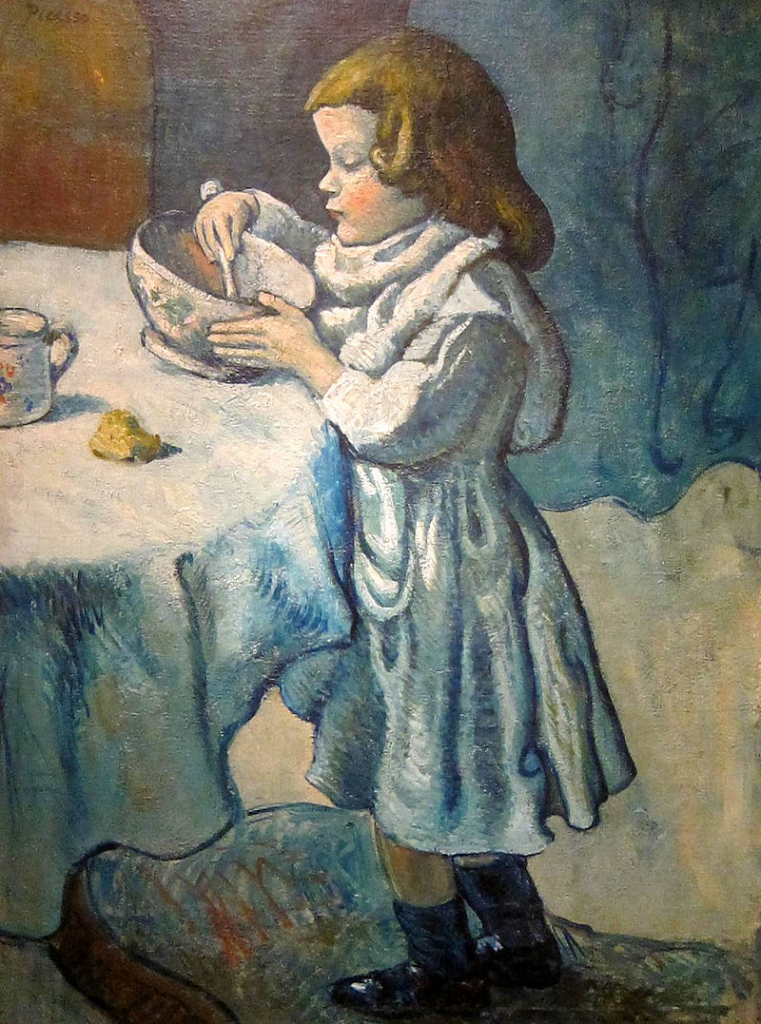
Above: Le Gourmet (The Greedy Child), Pablo Picasso (1901), National Gallery of Art, Washington DC
In his austere use of colour and sometimes doleful subject matter —prostitutes and beggars are frequent subjects.
Picasso was influenced by a trip through Spain and by the suicide of his friend Carles Casagemas.
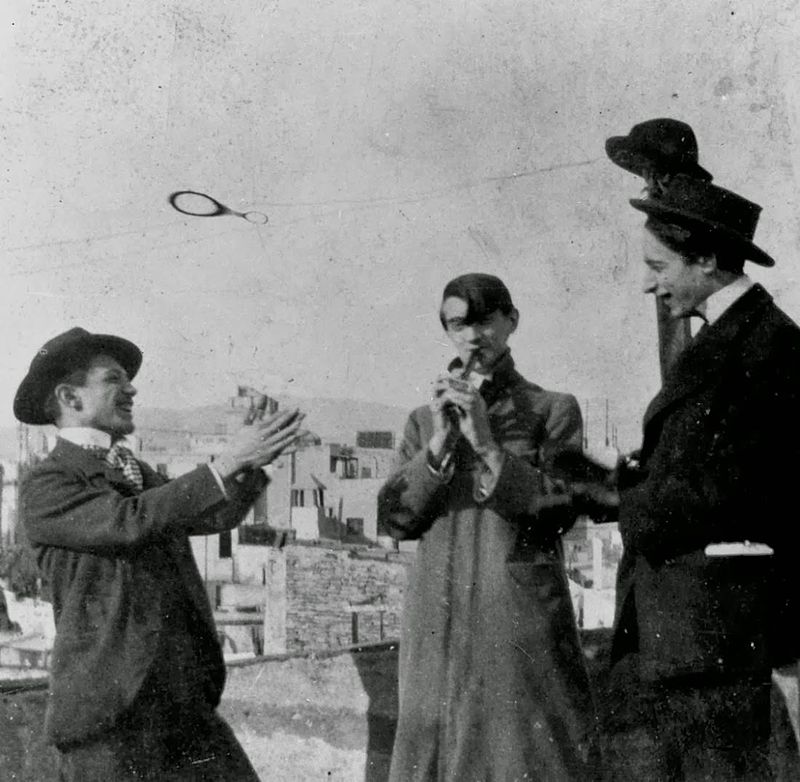
Above: Picasso, Angel Fernández de Soto and Carles Casagemas (1880 – 1901)
(Carles Antoni Cosme Damià Casagemas i Coll (Carlos Casagemas) (1880 – 1901) was a Spanish painter and poet.
He is known for his friendship with Pablo Picasso, who painted several portraits of Casagemas.
They travelled around Spain and eventually to Paris, where they lived together in a vacant studio.
Casagemas fell in love with Germaine, a model they had portrayed.
However, Casagemas was unable to consummate the relationship due to impotence.
This, along with his descent into depression and mood swings, led to several suicide attempts.
On 17 February 1901, Casagemas arranged a farewell dinner for himself at the Hippodrome Cafe in Paris.
He invited Germaine and a few friends.
At approximately 9 pm and after many rounds of wine and absinthe, Casagemas asked Germaine one final time if she would marry him.
When she refused, he drew a pistol and shot at her.
The bullet did not strike her, but she fell to the ground.
Casagemas then turned the gun and shot himself in the right temple.
He died in a hospital later that evening.
One of Picasso’s portraits accompanied Casagemas’s obituary nine days later.
Picasso returned to Paris in May 1901, resumed residence in the studio that he had shared with Casagemas, visited the site of Casagemas’s suicide, and eventually had an affair with Germaine.
During the years to follow, Picasso painted various death portraits of Casagemas.
This event is widely recognized as inspiring Picasso’s Blue Period.)
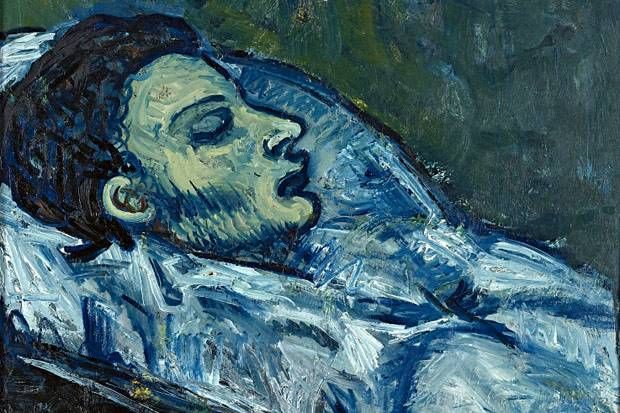
Above: Casagemas in His Coffin, Pablo Picasso (1901)
Starting in autumn of 1901, he painted several posthumous portraits of Casagemas culminating in the gloomy allegorical painting La Vie (1903), now in the Cleveland Museum of Art.
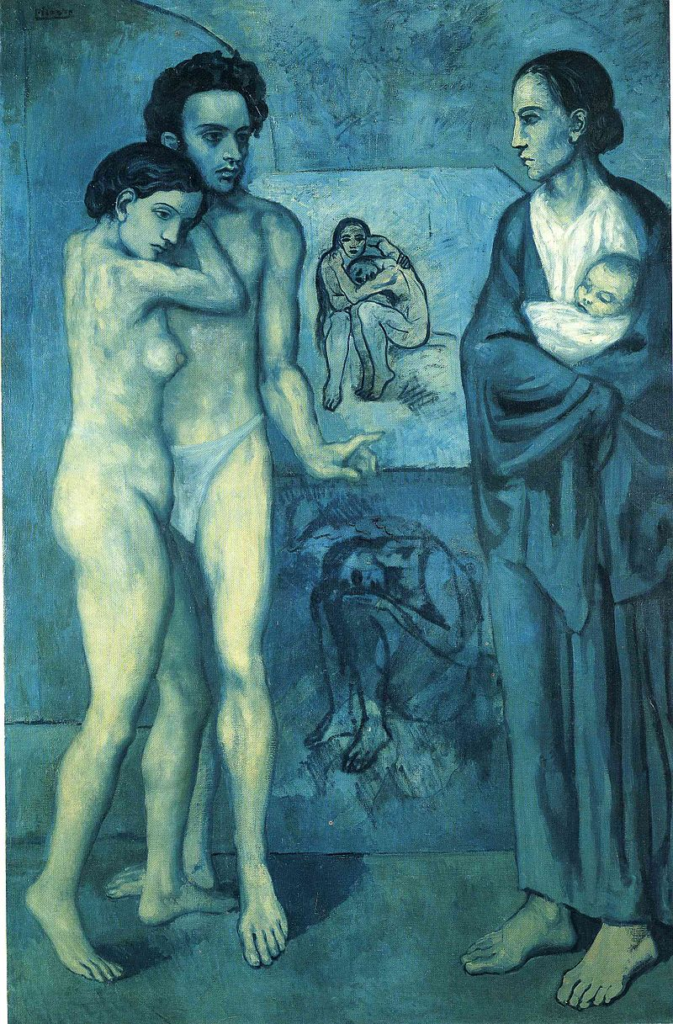
Above: La vie (Life), Pablo Picasso (1903), Cleveland Museum of Art
The same mood pervades the well-known etching The Frugal Repast (1904), which depicts a blind man and a sighted woman, both emaciated, seated at a nearly bare table.
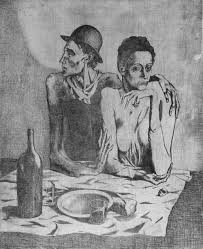
Above: The frugal repast, Pablo Picasso (1904), Hammer Museum, University of California, Los Angeles
Blindness, a recurrent theme in Picasso’s works of this period, is also represented in The Blindman’s Meal (1903) (Metropolitan Museum of Art) and in the portrait of Celestina (1903).
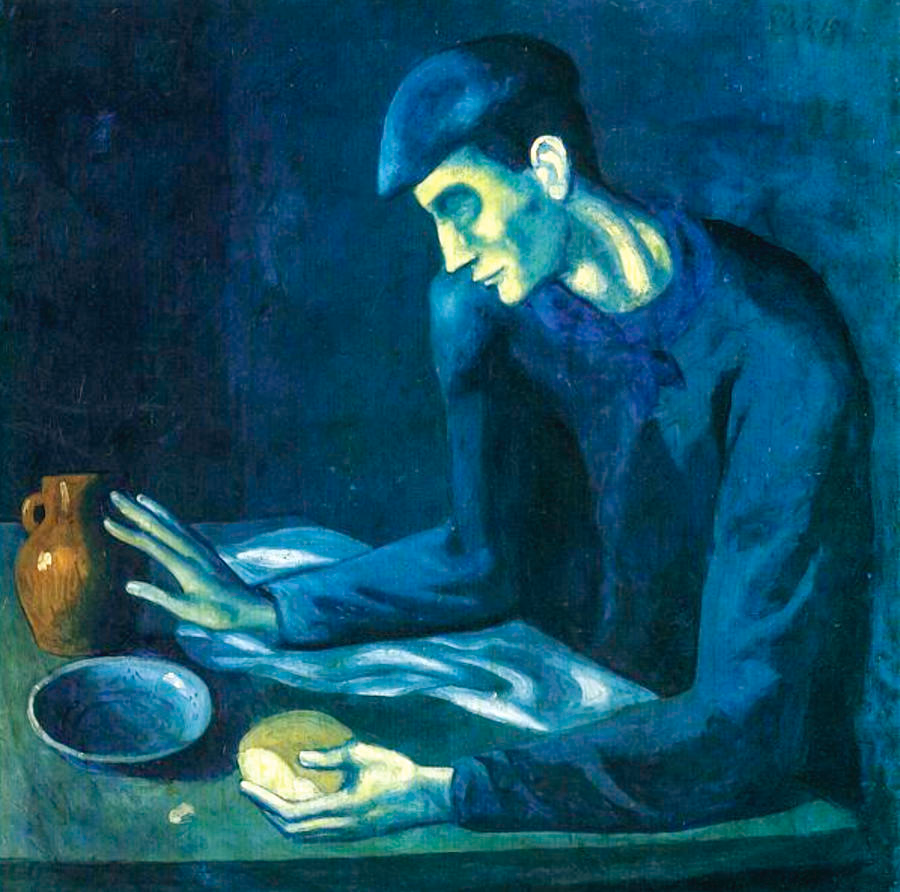
Above: The blind man’s meal, Pablo Picasso (1903), Metropolitan Museum of Art, New York City
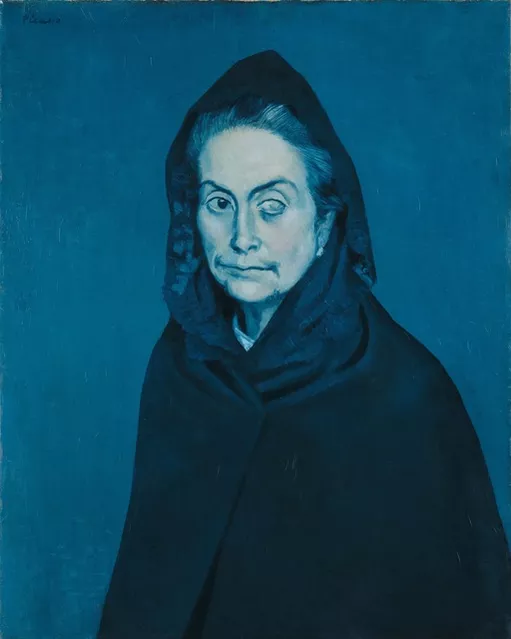
Above: La Célestine (La femme à la taie), Pablo Picasso (1904), Musée Picasso, Paris
Other Blue Period works include Portrait of Soler and Portrait of Suzanne Bloch.
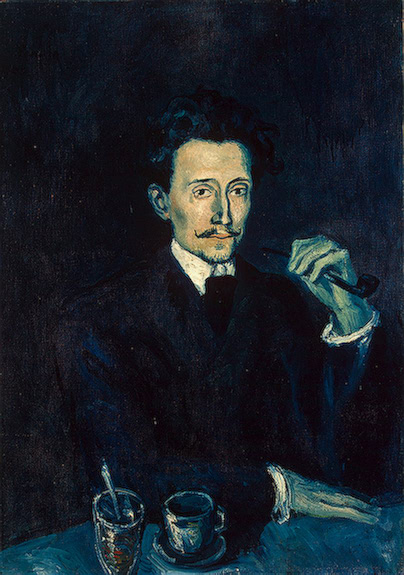
Above: Portrait of the tailor Soler, Pablo Picasso (1903), Hermitage Museum, St. Petersburg, Russia
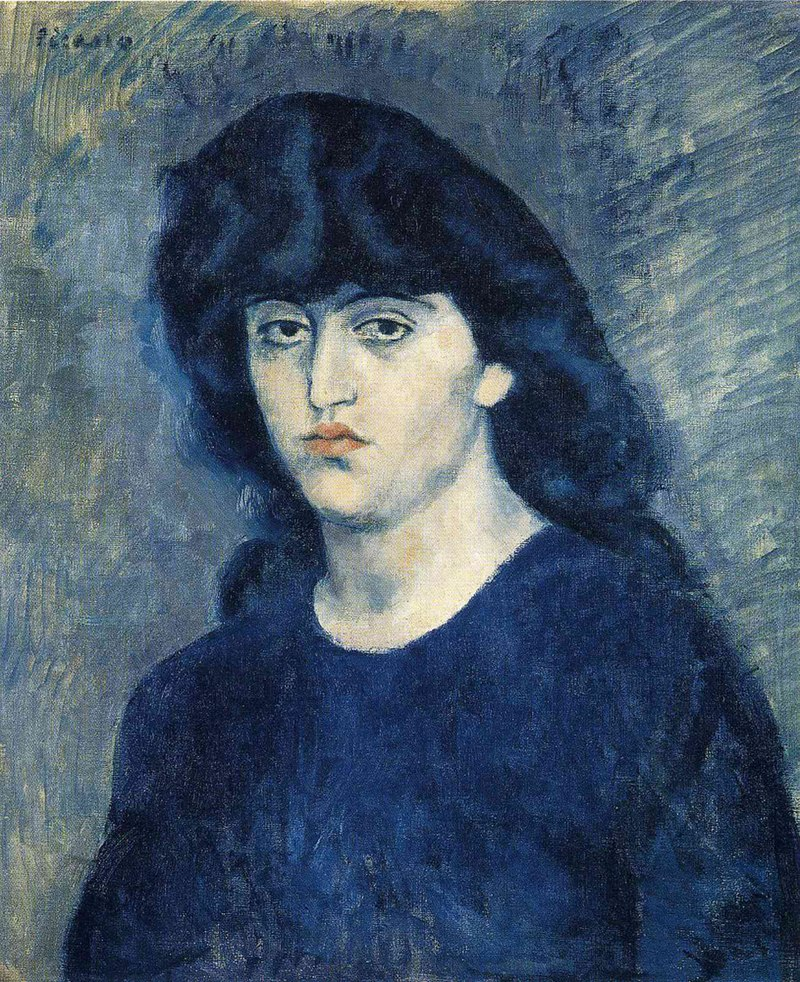
Above: Portrait of Suzanne Bloch, Pablo Picasso (1904), São Paulo Museum of Art, Brazil
“Great artists are people who find the way to be themselves in their art.
Any sort of pretension induces mediocrity in art and life alike.”
Margot Fonteyn
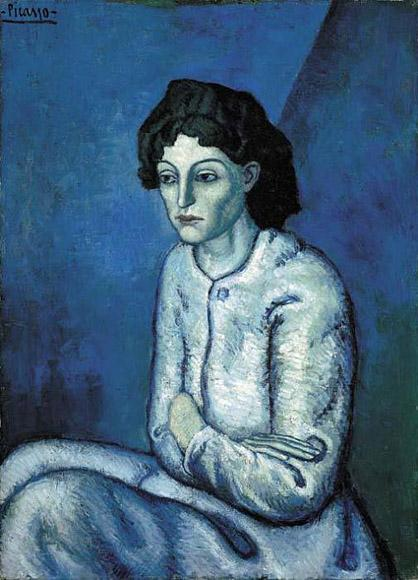
Above: Femme aux Bras Croisés (Woman with Folded Arms), Pablo Picasso (1902),
The Rose Period (1904 – 1906) is characterized by a lighter tone and style utilizing orange and pink colours and featuring many circus people, acrobats and harlequins known in France as saltimbanques.
The harlequin, a comedic character usually depicted in checkered patterned clothing, became a personal symbol for Picasso.
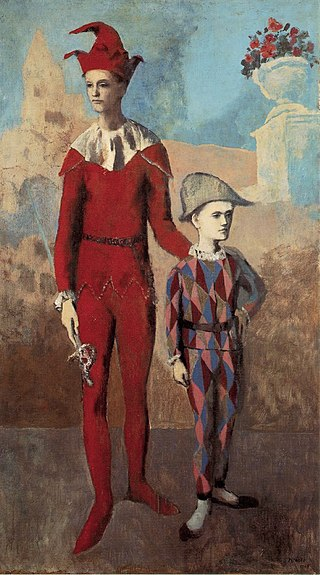
Above: Acrobate et jeune Arlequin (Acrobat and Young Harlequin), Pablo Picasso (1905), Barnes Foundation, Philadelphia
“He is but a poor philosopher who holds a view so narrow as to exclude forms not to his personal taste.
No realist can love romantic Art so much as he loves his own, but when that Art fulfils the laws of its peculiar being, if he would be no blind partisan, he must admit it.
The romanticist will never be amused by realism, but let him not for that reason be so parochial as to think that realism, when it achieves vitality, is not Art.
For what is Art but the perfected expression of self in contact with the world.
And whether that self be of enlightening, or of fairy-telling temperament, is of no moment whatsoever.
The tossing of abuse from realist to romanticist and back is but the sword-play of two one-eyed men with their blind side turned toward each other.
Shall not each attempt be judged on its own merits?
If found not shoddy, faked, or forced, but true to itself, true to its conceiving mood, and fair-proportioned part to whole, so that it lives — then, realistic or romantic, in the name of Fairness let it pass!
Of all kinds of human energy, Art is surely the most free, the least parochial, and demands of us an essential tolerance of all its forms.
Shall we waste breath and ink in condemnation of artists, because their temperaments are not our own?“
John Galsworthy
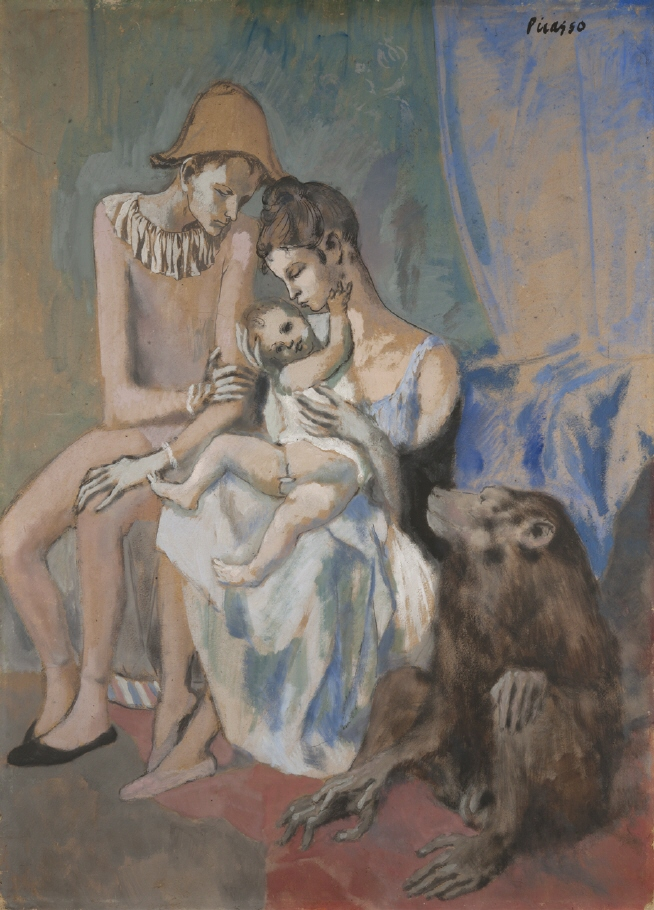
Above: Famille au Singe (Acrobat’s Family with a Monkey), Pablo Picasso (1905), Konstmuseum, Goteburg, Sweden
Picasso met Fernande Olivier, a bohemian artist who became his mistress, in Paris in 1904.
Olivier appears in many of his Rose Period paintings, many of which are influenced by his warm relationship with her, in addition to his increased exposure to French painting.
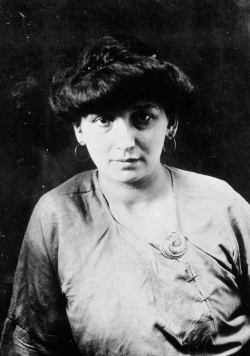
Above: French artist / model Fernande Olivier (1881 – 1966)
The generally upbeat and optimistic mood of paintings in this period is reminiscent of the 1899 – 1901 period (i.e., just prior to the Blue Period).
1904 can be considered a transition year between the two periods.
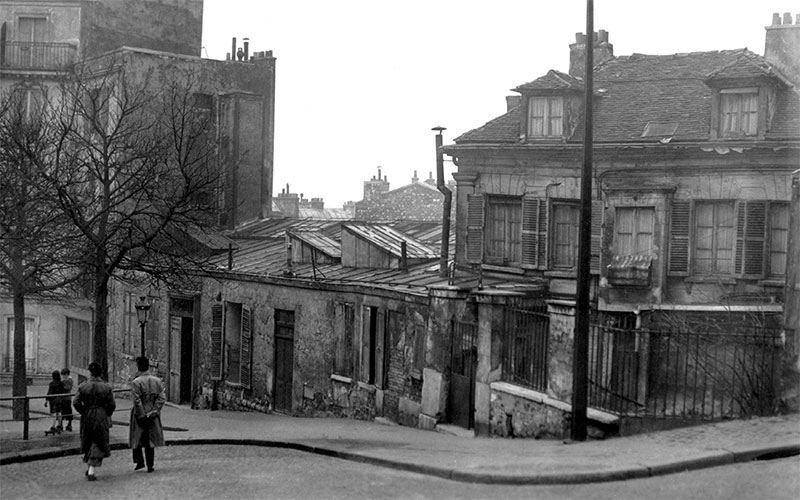
Above: At the time Picasso lived at the Le Bateau-Lavoir (center) in Montmartre, Paris (1910)
“Art is the great and universal refreshment.
For Art is never dogmatic, holds no brief for itself.
You may take it or you may leave it.
It does not force itself rudely where it is not wanted.
It is reverent to all tempers, to all points of view.
But it is wilful — the very wind in the comings and goings of its influence, an uncapturable fugitive, visiting our hearts at vagrant, sweet moments.
Since we often stand even before the greatest works of Art without being able quite to lose ourselves!
That restful oblivion comes, we never quite know when — and it is gone!
But when it comes, it is a spirit hovering with cool wings, blessing us from least to greatest, according to our powers.
A spirit deathless and varied as human life itself.”
John Galsworthy
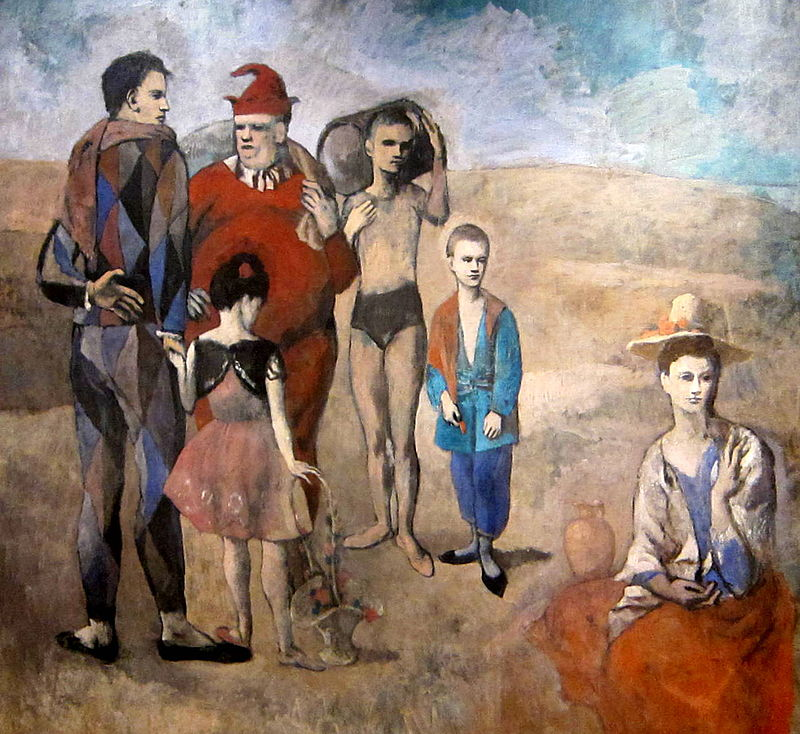
Above: Family of Saltimbanques, Pablo Picasso (1905), National Gallery of Art, Washington DC
By 1905, Picasso became a favourite of American art collectors Leo and Gertrude Stein.
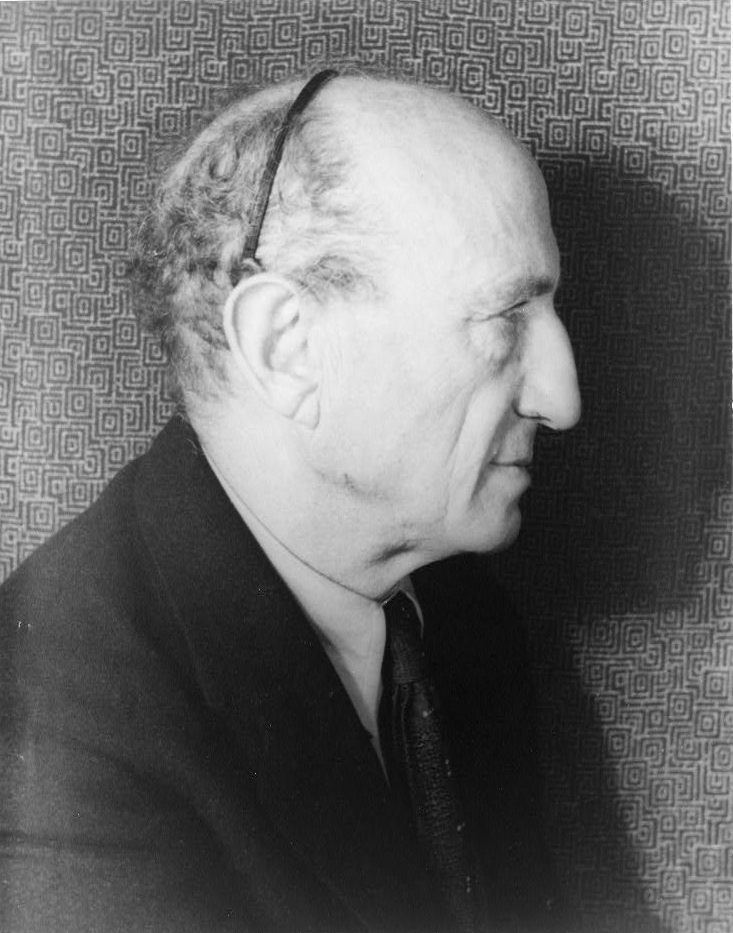
Above: Art collector / critic Leo Stein (1872 – 1947), elder brother of Gertrude Stein
Their older brother Michael Stein and his wife Sarah also became collectors of his work.
Picasso painted a portrait of Gertrude Stein and one of her nephew Allan Stein.
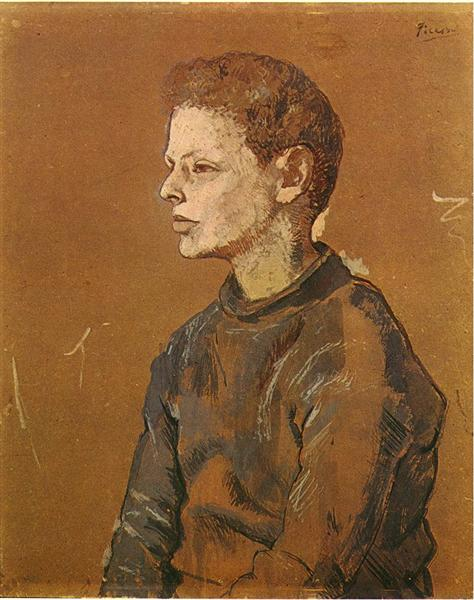
Above: Portrait of Allan Stein, Pablo Picasso (1906)
Gertrude Stein became Picasso’s principal patron, acquiring his drawings and paintings and exhibiting them in her informal Salon at her home in Paris.
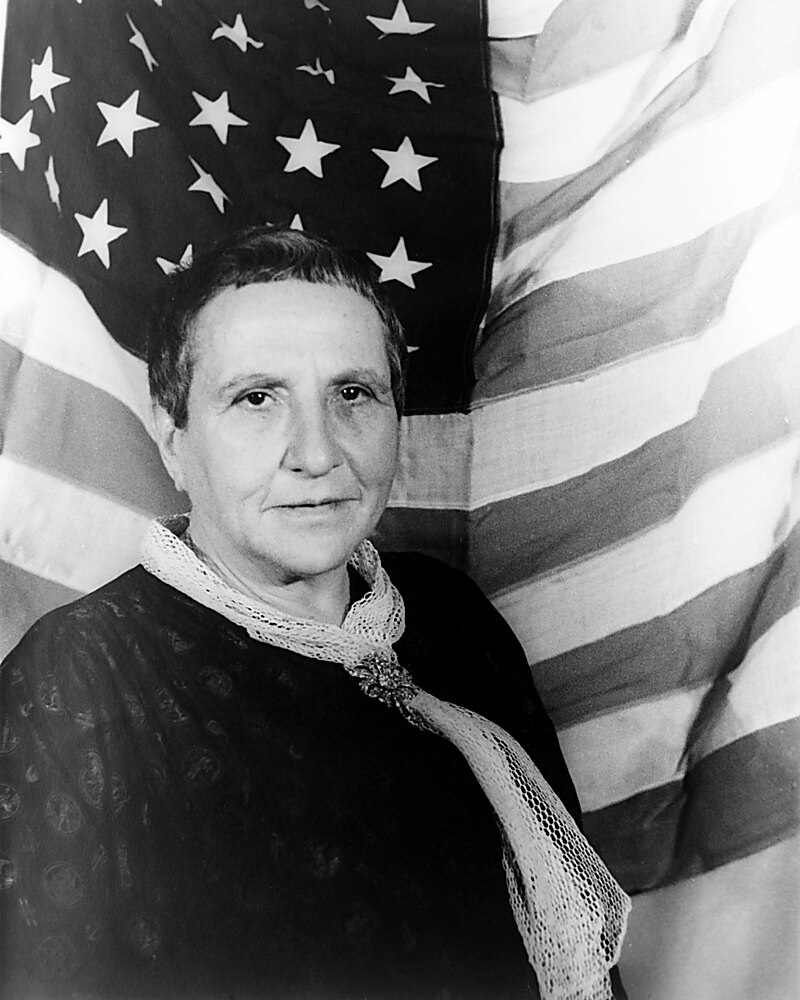
Above: American writer / art collector Gertrude Stein (1874 – 1946)
At one of her gatherings in 1905, he met Henri Matisse, who was to become a lifelong friend and rival.
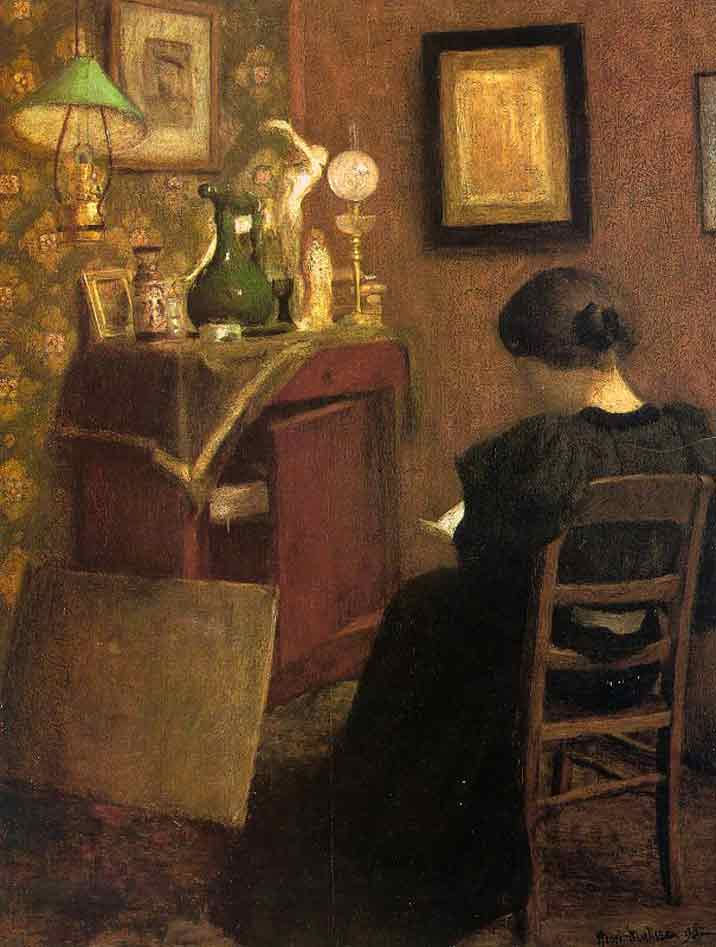
Above: La Liseuse (Woman reading), Henri Matisse (1895), Musée Matisse, Paris
The Steins introduced him to Claribel Cone and her sister Etta, who were American art collectors.
They also began to acquire Picasso’s and Matisse’s paintings.
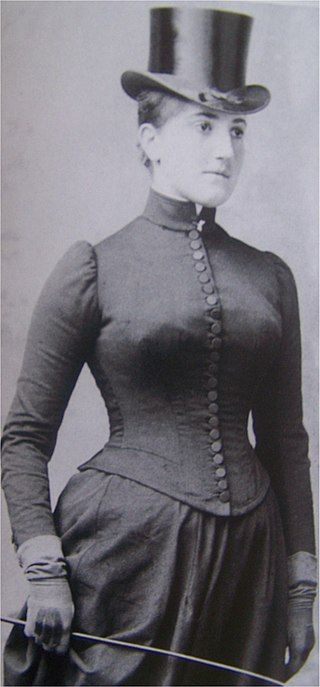
Above: American art collector pianist Etta Cone (1870 – 1949)
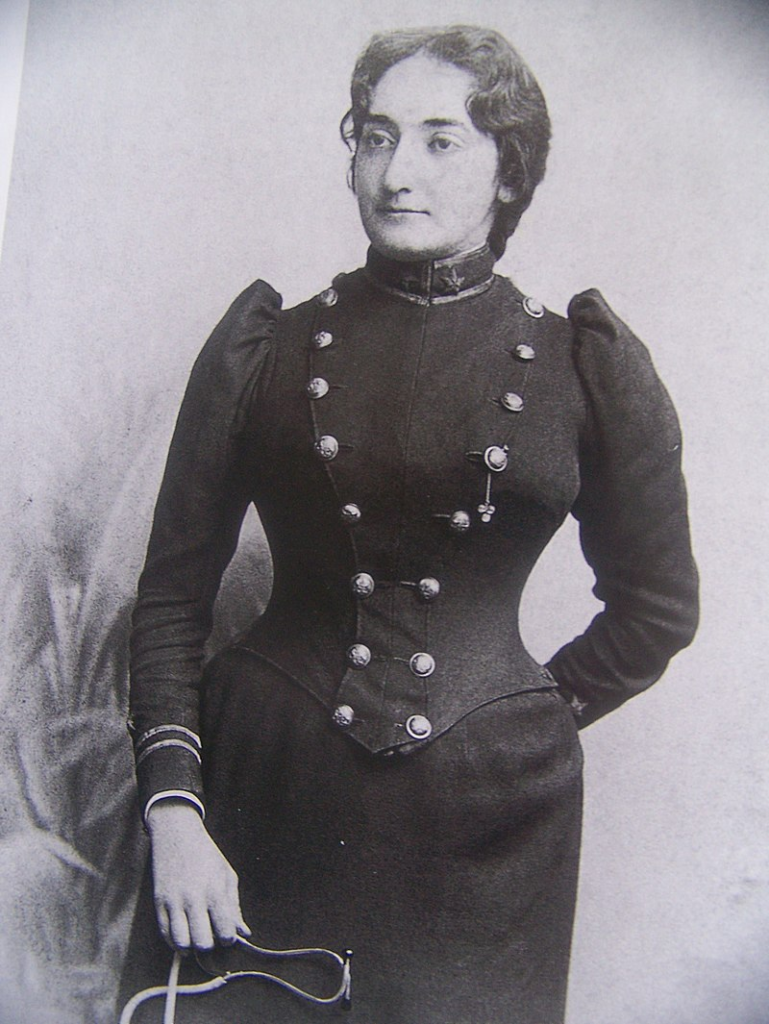
Above: American art collector / physician Claribel Cone (1864 – 1929)
Eventually, Leo Stein moved to Italy.
Michael and Sarah Stein became patrons of Matisse, while Gertrude Stein continued to collect Picassos.
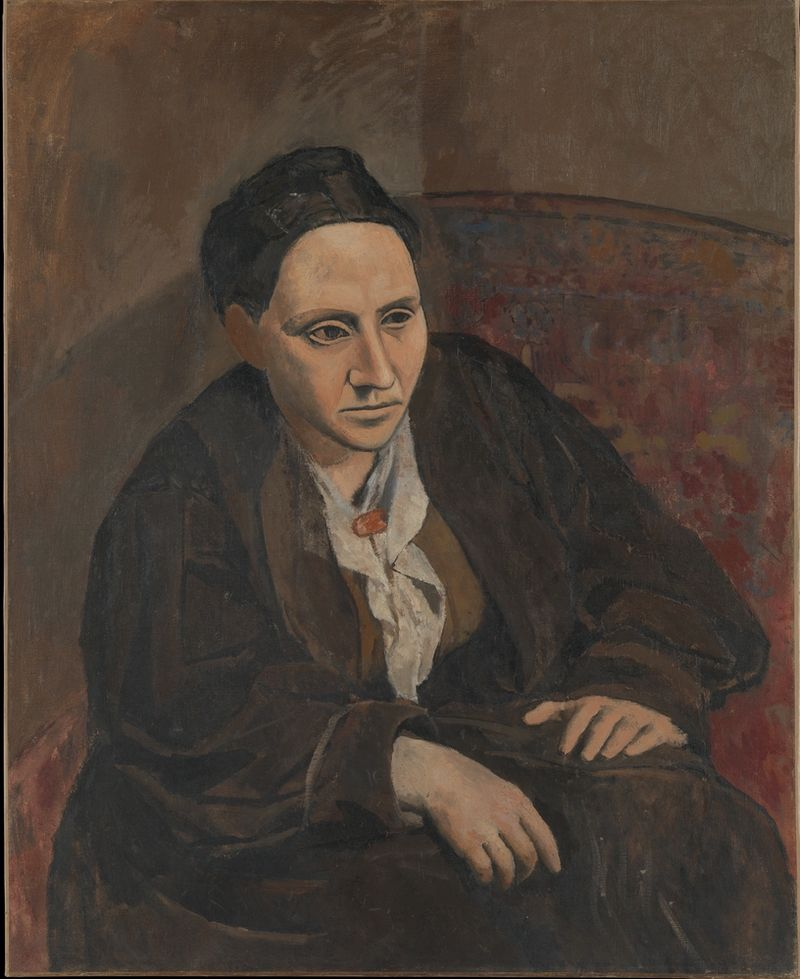
Above: Portrait of Gertrude Stein, Pablo Picasso (1906), Metropolitan Museum of Art, New York City – When someone commented that Stein did not look like her portrait, Picasso replied, “She will“.
“The great artists are the ones who dare to entitle to beauty things so natural that when they’re seen afterward, people say:
Why did I never realize before that this too was beautiful?“
André Gide
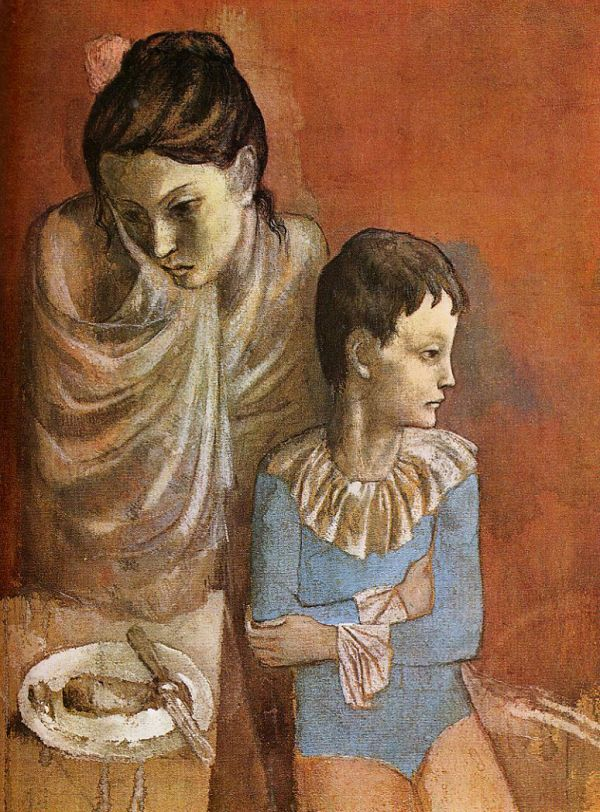
Above: Les Baladins (Mother and Child, Acrobats), Pablo Picasso (1905), Staatsgalerie, Stuttgart, Deutschland
In 1907, Picasso joined an art gallery that had recently been opened in Paris by Daniel-Henry Kahnweiler, a German art historian and art collector who became one of the premier French art dealers of the 20th century.
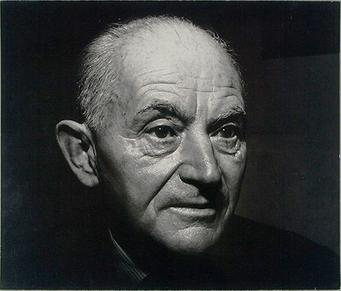
Above: German art collector Daniel – Henry Kahnweiler (1884 – 1979)
He was among the first champions of Pablo Picasso, Georges Braque and the Cubism that they jointly developed.
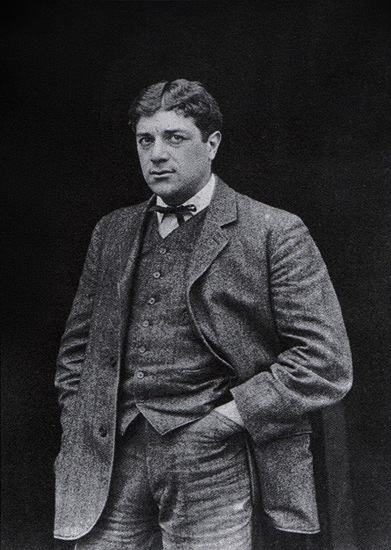
Above: French artist Georges Braque (1882 – 1963)
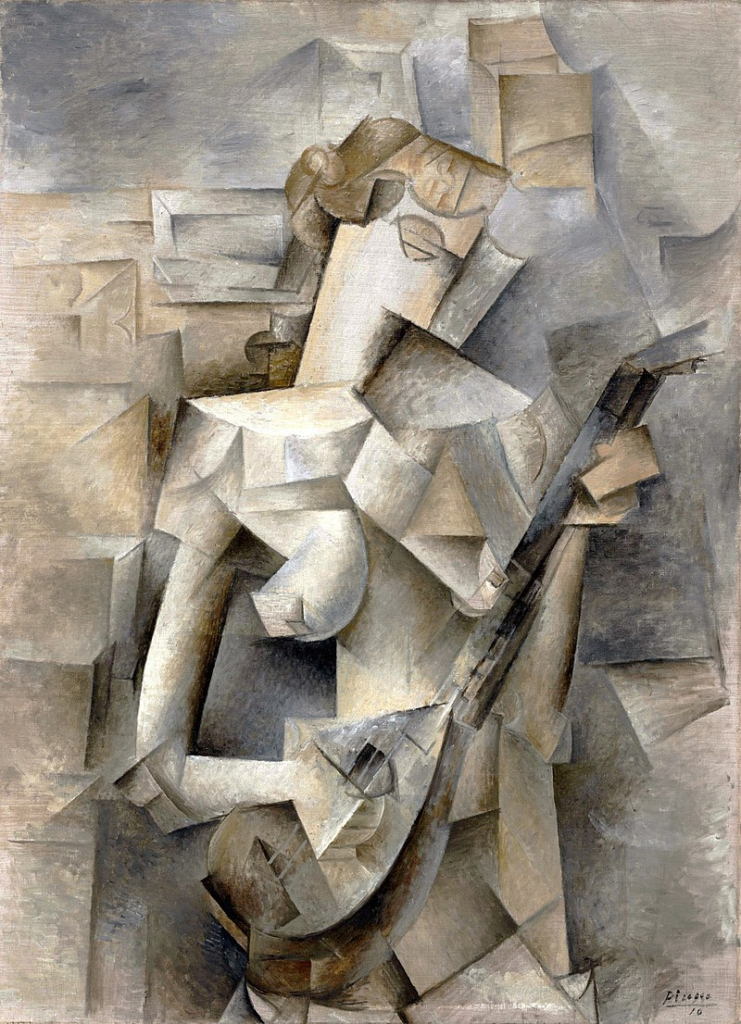
Above: Girl with a Mandolin, Pablo Picasso (1910), Museum of Modern Art, New York City
Kahnweiler promoted burgeoning artists such as André Derain, Kees van Dongen, Fernand Léger, Juan Gris, Maurice de Vlaminck and several others who had come from all over the globe to live and work in Montparnasse at the time.
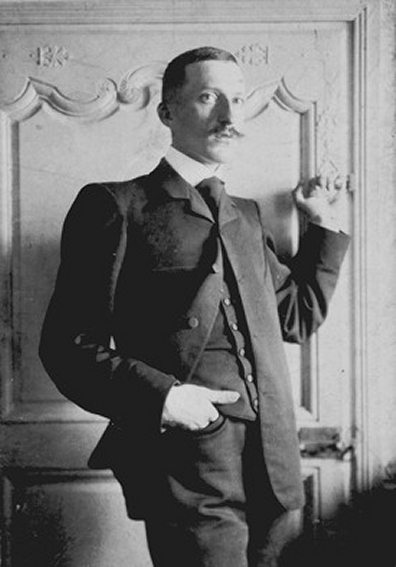
Above: French artist André Derain (1880 – 1954)
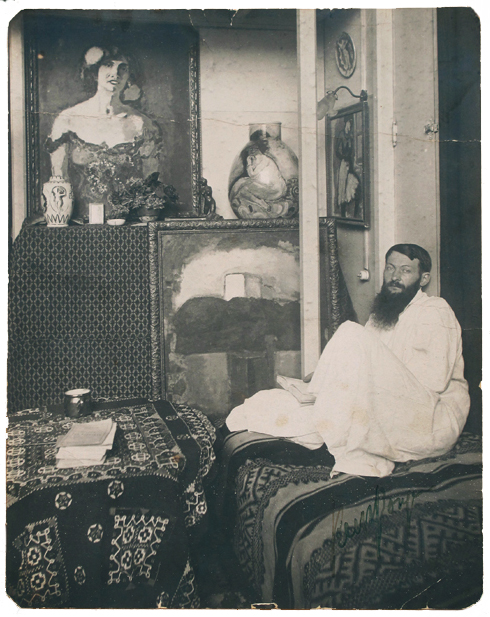
Above: Dutch-born French painter Kees van Dongen (1877 – 1968) in his studio at 6 rue Saulnier, Paris
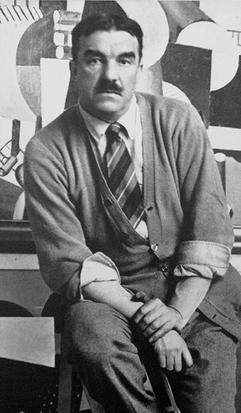
Above: French artist Fernand Léger (1881 – 1955)
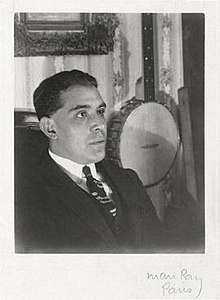
Above: Spanish painter Juan Gris (né José Victoriano González-Pérez)(1887 – 1927)
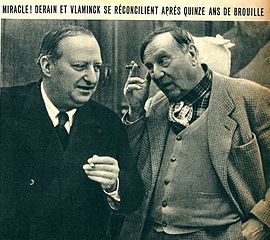
Above: (left) André Derain and (right) French artist Maurice de Vlaminck (1876 – 1958)
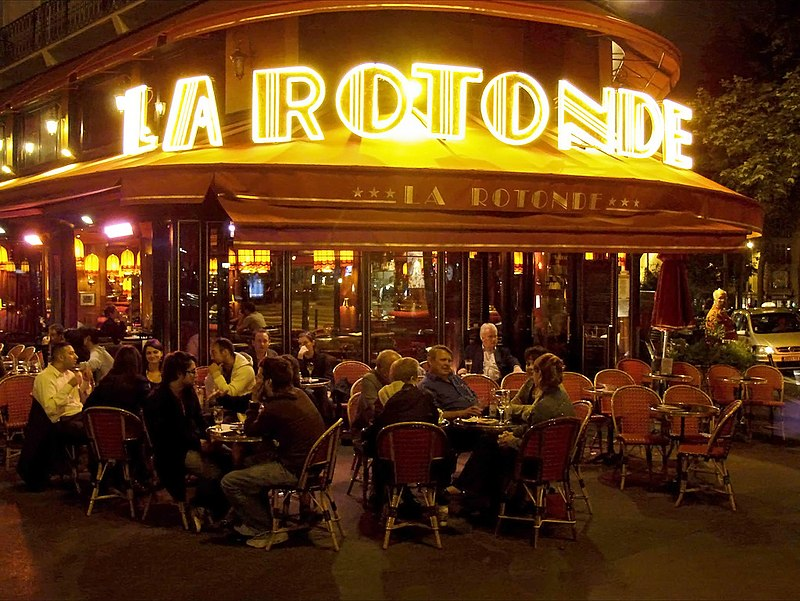
Above: Café La Rotonde, Montparnasse, Paris
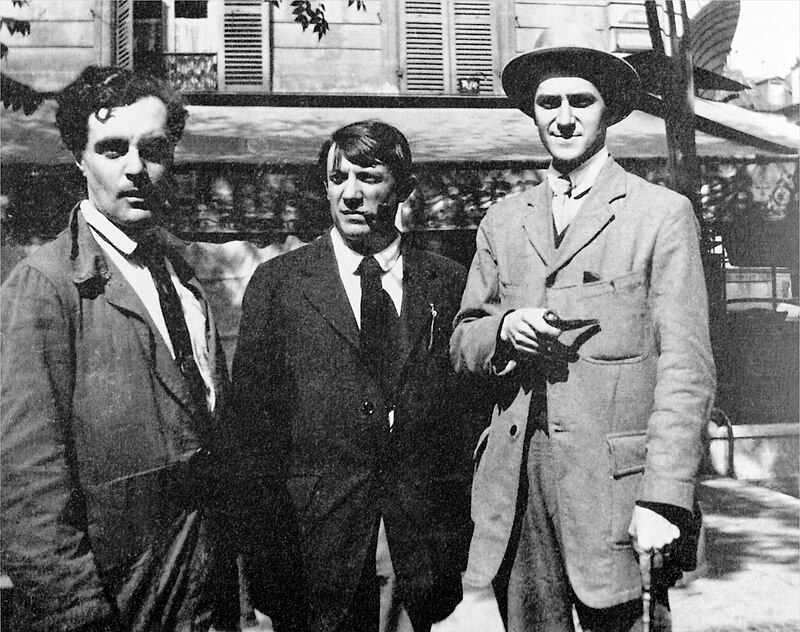
Above: Italian artist Amadeo Modigliani (1884 – 1920), Picasso and French writer André Salmon (1881 – 1969) at the Rotonde (1916)
“As all Nature’s thousand changes
But one changeless God proclaim;
So in Art’s wide kingdom ranges
One sole meaning still the same:
This is Truth, eternal Reason,
Which from Beauty takes its dress,
And serene through time and season
Stands for aye in loveliness.“
Johann Wolfgang von Goethe
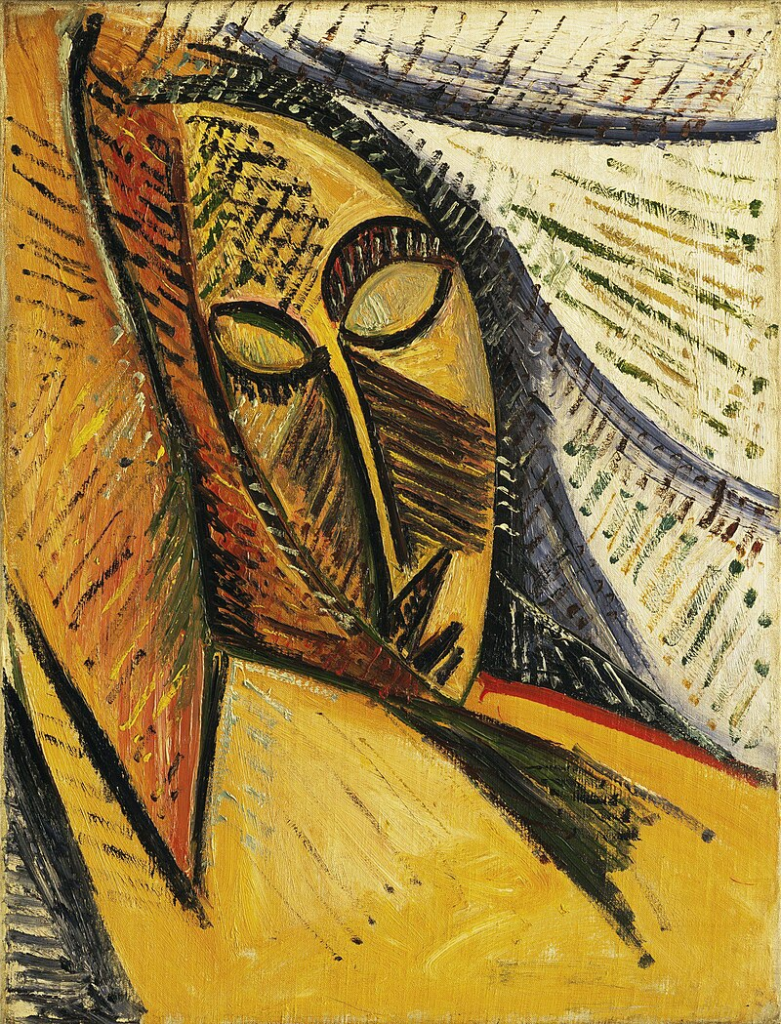
Above: Head of a sleeping woman (Study for Nude with Drapery), Pablo Picasso (1907), Museum of Modern Art, New York City
Picasso’s African-influenced Period (1907 – 1909) begins with his painting Les Demoiselles d’Avignon.
Part of the permanent collection of the Museum of Modern Art in New York, it portrays five nude female prostitutes in a brothel on Carrer d’Avinyó, a street in Barcelona, Spain.
The figures are confrontational and not conventionally feminine, being rendered with angular and disjointed body shapes, some to a menacing degree.
The far left figure exhibits facial features and dress of Egyptian or southern Asian style.
The two adjacent figures are in an Iberian style of Picasso’s Spain, while the two on the right have African mask-like features.
Picasso said the ethnic primitivism evoked in these masks moved him to “liberate an utterly original artistic style of compelling, even savage force” leading him to add a shamanistic aspect to his project.
The three figures on the left were inspired by Iberian sculpture, but he repainted the faces of the two figures on the right after being powerfully impressed by African artefacts he saw in June 1907 in the ethnographic museum at the Palais du Trocadéro.
When he displayed the painting to acquaintances in his studio later that year, the nearly universal reaction was shock and revulsion.
Matisse angrily dismissed the work as a hoax.
Picasso did not exhibit Les Demoiselles publicly until 1916.
Les Demoiselles d’Avignon (The Young Ladies of Avignon, originally titled The Brothel of Avignon) is a large oil painting created in 1907 by the Spanish artist Pablo Picasso.
Part of the permanent collection of the Museum of Modern Art (MOMA) in New York, it portrays five nude female prostitutes in a brothel on Carrer d’Avinyó, a street in Barcelona, Spain.
The figures are confrontational and not conventionally feminine, being rendered with angular and disjointed body shapes, some to a menacing degree.
The far left figure exhibits facial features and dress of Egyptian or southern Asian style.
The two adjacent figures are in an Iberian style of Picasso’s Spain, while the two on the right have African mask-like features.
Picasso said the ethnic primitivism evoked in these masks moved him to “liberate an utterly original artistic style of compelling, even savage force” leading him to add a shamanistic aspect to his project.
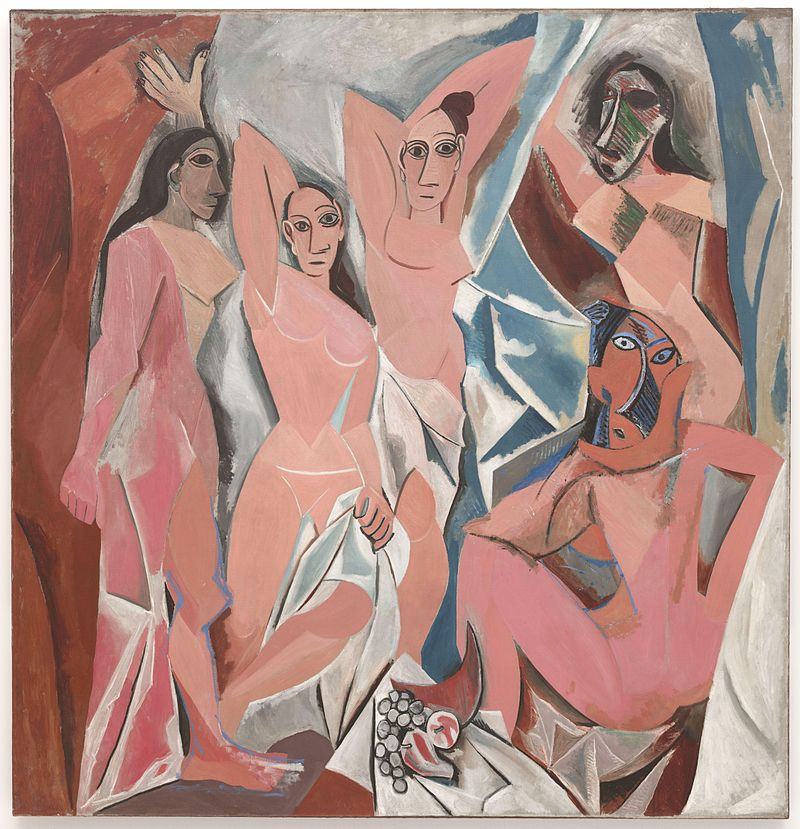
Above: Les Demoiselles d’Avignon, Pablo Picasso (1907), Museum of Modern Art, New York City
Les Demoiselles was revolutionary, controversial and led to widespread anger and disagreement, even amongst the painter’s closest associates and friends.
Henri Matisse considered the work something of a bad joke yet indirectly reacted to it in his 1908 Bathers with a Turtle.
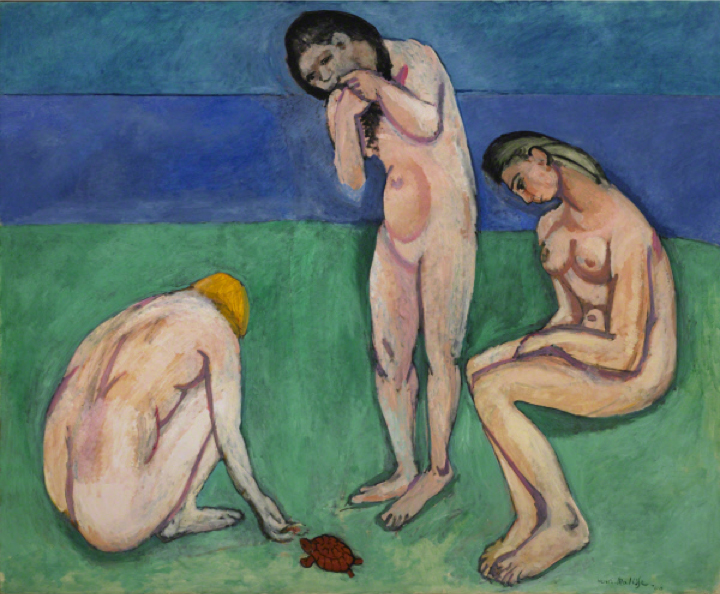
Above: Baigneuses (Bathers with a turtle), Henri Matisse (1907), Saint Louis Art Museum
Georges Braque too initially disliked the painting yet studied the work in great detail.
His subsequent friendship and collaboration with Picasso led to the cubist revolution.
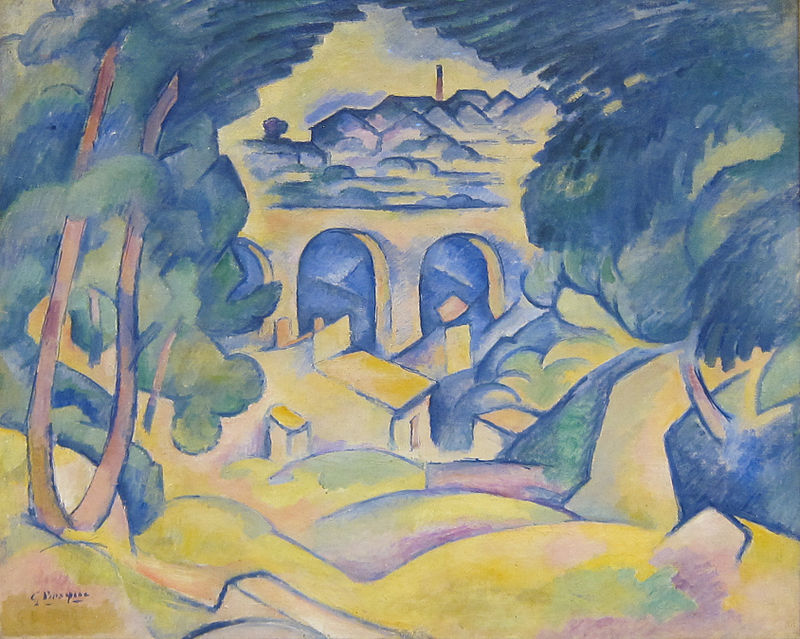
Above: Le Viaduc de l’Estaque (The Viaduct at L’Estaque), Georges Braques (1907), Minneapolis Institute of Arts
Its resemblance to Cézanne’s The Bathers, Paul Gauguin’s statue Oviri and El Greco’s Opening of the Fifth Seal has been widely discussed by later critics.
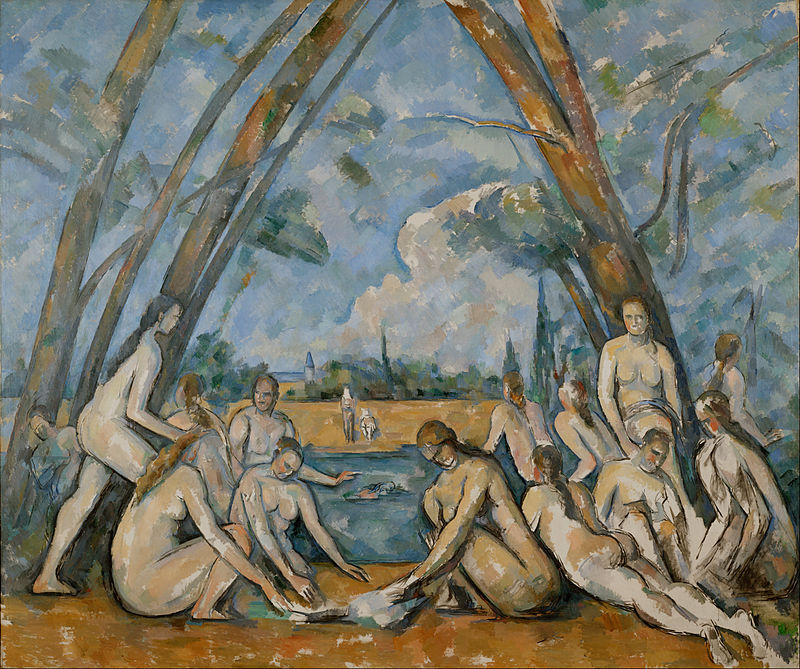
Above: Baigneuses (Bathers), Paul Cézanne (1906), Philadelphia Museum of Art
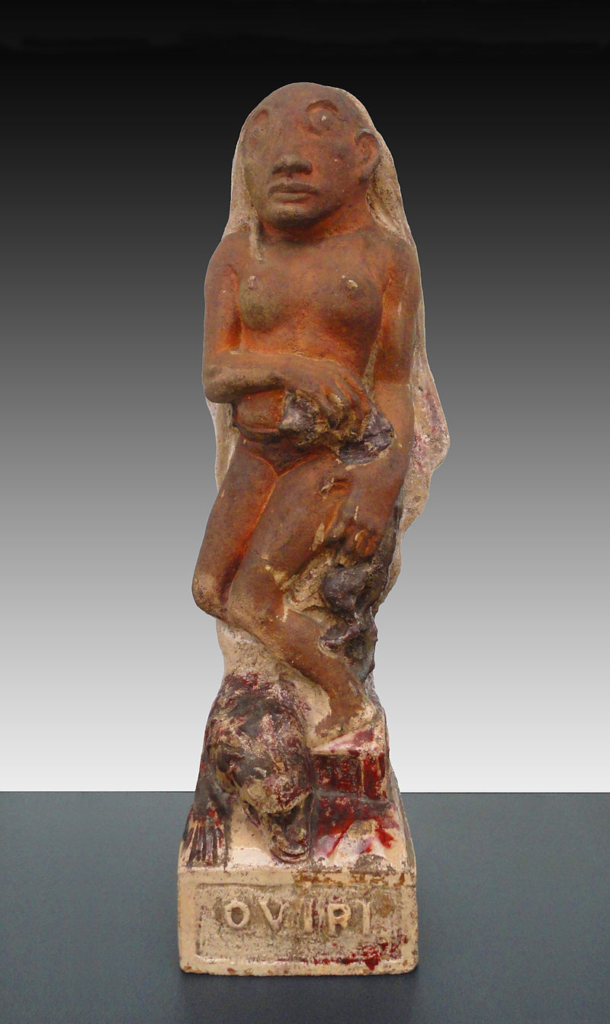
Above: Oviri, Paul Gauguin (1894), Musée d’Orsay, Paris
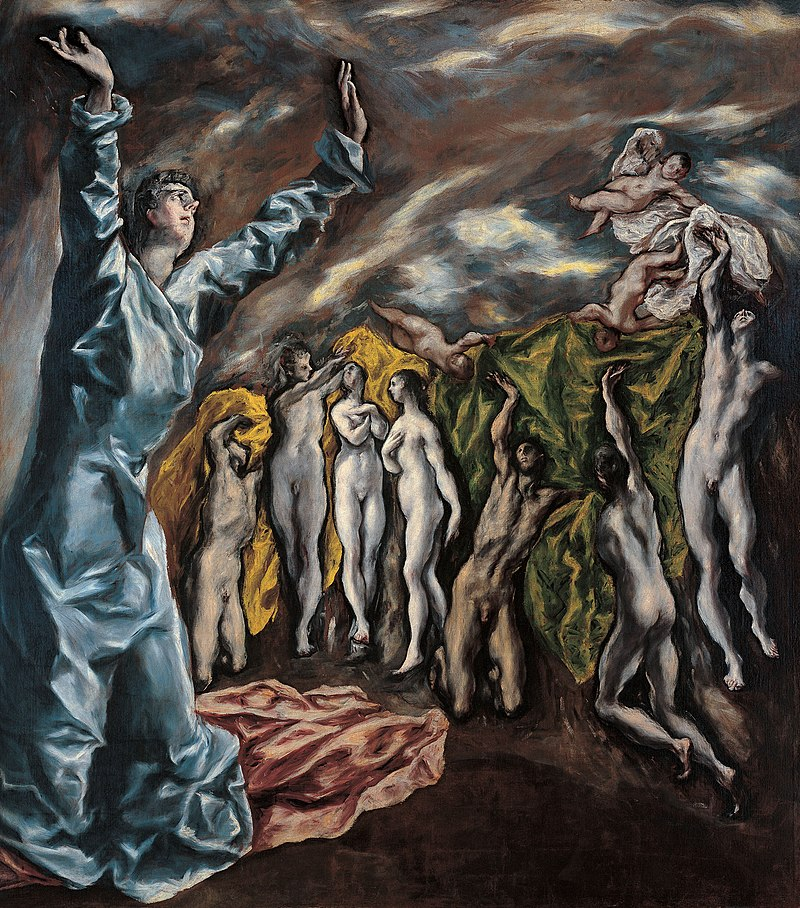
Above: The Vision of Saint John (Opening of the 5th Seal), El Greco (1650), Metropolitan Museum of Art, New York City
At the time of its first exhibition in 1916, the painting was deemed immoral.
Painted in Picasso’s studio in the Bateau-Lavoir in Montmartre, Paris, it was seen publicly for the first time at the Salon d’Antin in July 1916, at an exhibition organized by the poet André Salmon.
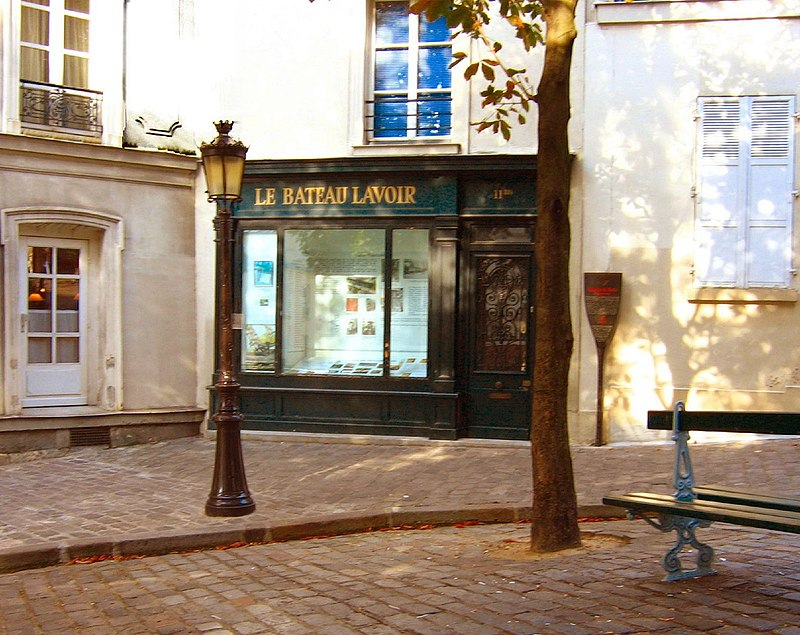
Above: Le Bateau Lavoir, Montparnasse, Paris
It was at this exhibition that Salmon, who had previously titled the painting in 1912 Le bordel philosophique, renamed it to its current, less scandalous title, Les Demoiselles d’Avignon, instead of the title originally chosen by Picasso, Le Bordel d’Avignon.
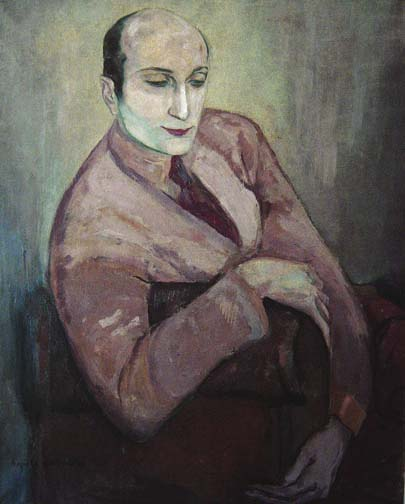
Above: Portrait of André Salmon, Leopold Gottlieb (1920)
Picasso, who always referred to it as mon bordel (“my brothel“) or Le Bordel d’Avignon, never liked Salmon’s title and would have instead preferred the bowdlerization Las chicas de Avignon (“The Girls of Avignon“).
(The term bowdlerization is a pejorative term for the practice, particularly the expurgation of lewd material from books.
The term derives from Thomas Bowdler’s 1818 edition of William Shakespeare’s plays, which he reworked in ways that he felt were more suitable for women and children.
He similarly edited Edward Gibbon’s Decline and Fall of the Roman Empire.)
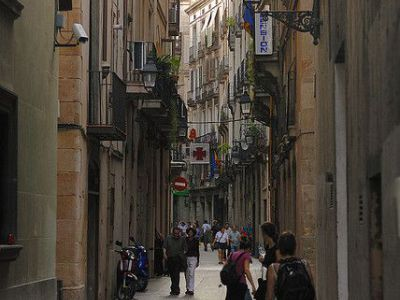
Above: Carrer d’Avinyo, Barcelona, España
“Whores are the most honest girls.
They present the bill right away.
The others hang on and never let go.“
Alberto Giacometti
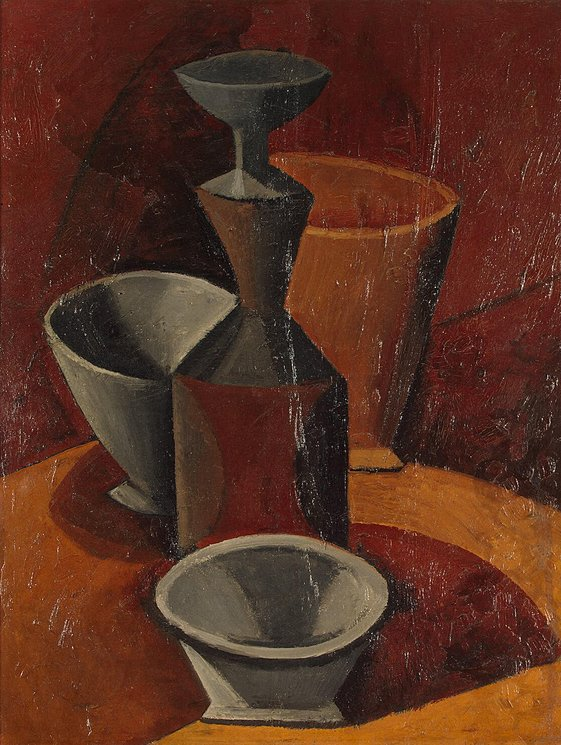
Above: Bols et flacons (Pitcher and Bowls), Pablo Picasso (1908), Hermitage Museum, Saint Petersburg, Russia
Other works from this period include Nude with Raised Arms (1907) and Three Women (1908).
Formal ideas developed during this period lead directly into the Cubist period that follows.
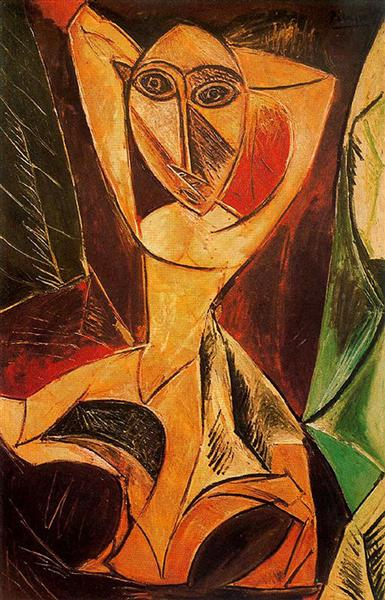
Above: Nude with Raised Arms (The Avignon Dancer), Pablo Picasso (1907)
“Perhaps there is no other way of reaching some understanding of being than through art?“
Nadine Gordimer
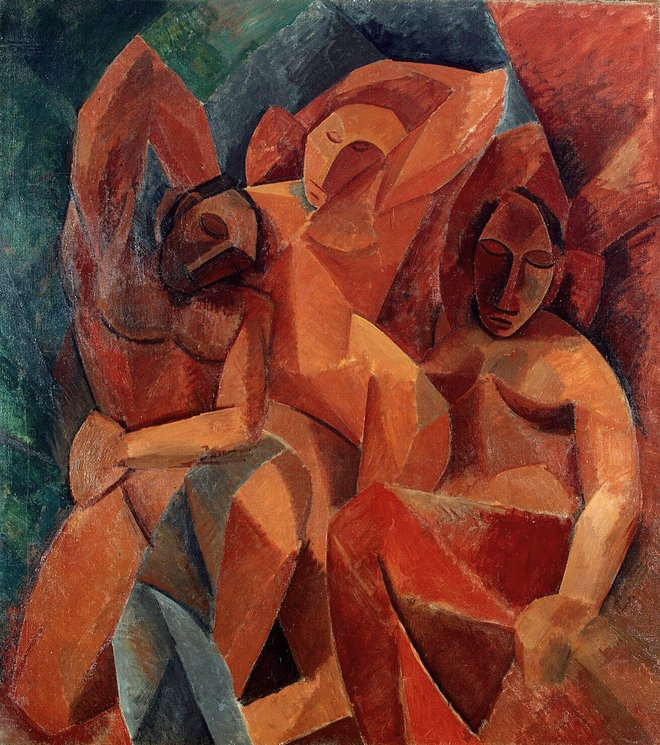
Above: Trois femmes (Three women), Pablo Picasso (1908), Hermitage Museum, Saint Petersburg, Russia
Analytic cubism (1909 – 1912) is a style of painting Picasso developed with Georges Braque using monochrome brownish and neutral colours.
Both artists took apart objects and “analyzed” them in terms of their shapes.
Picasso and Braque’s paintings at this time share many similarities.
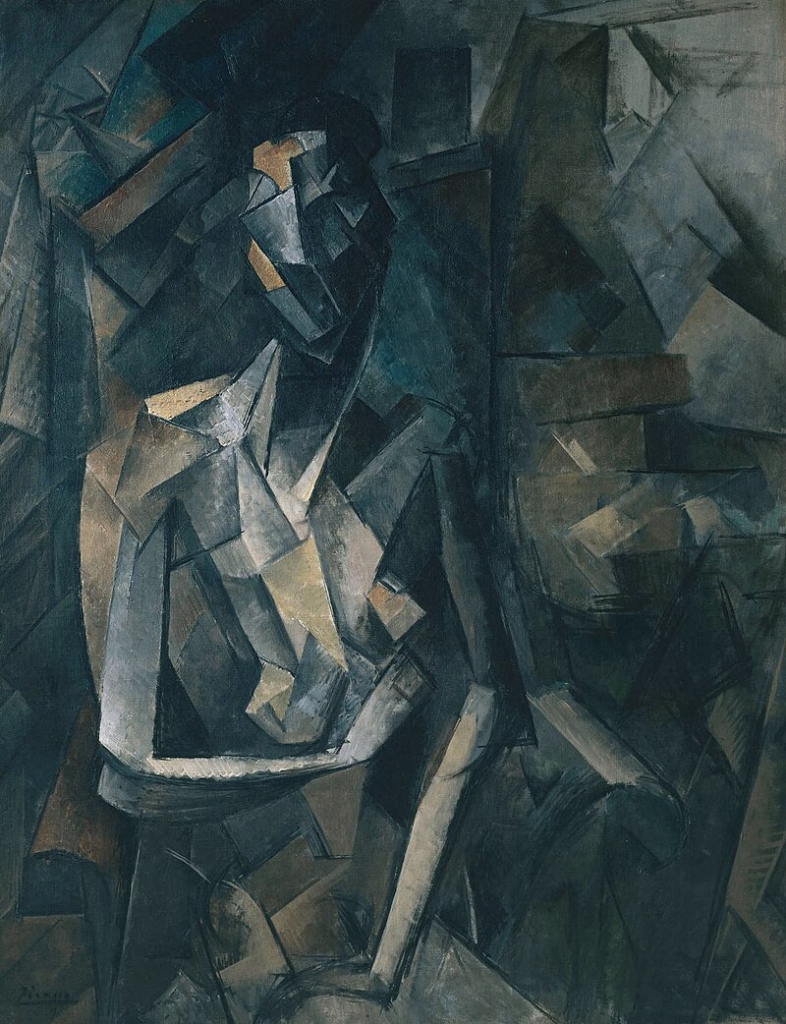
Above: Figure dans un Fauteuil (Seated Nude, Femme nue assise), Pablo Picasso (1910), Tate Modern, London, England
“One cannot condemn tendencies in art.
One can only condemn works of art.
To be categorically against a current art tendency or style means, in effect, to pronounce on works of art not yet created and not yet seen.
It means inquiring into the motives of artists instead of into results.
Yet we all know — or are supposed to know — that results are all that count in art.“
Clement Greenberg
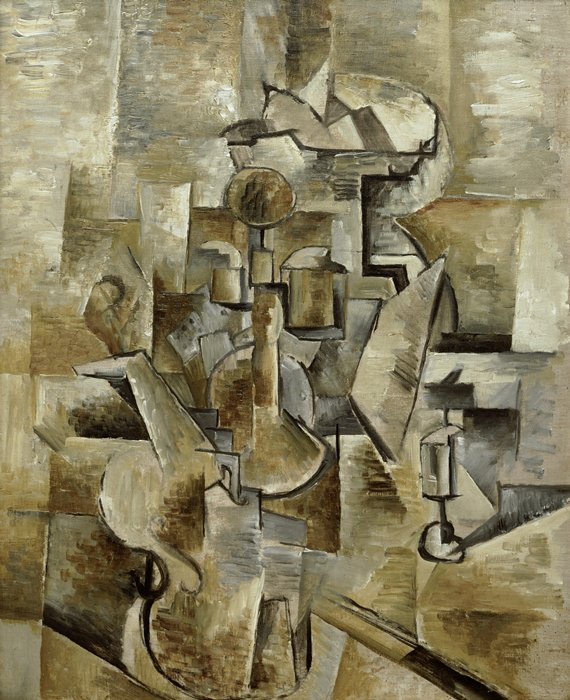
Above: Violin and Candlestick, Georges Braque (1910), San Francisco Museum of Art
In Paris, Picasso entertained a distinguished coterie of friends in the Montmartre and Montparnasse quarters, including André Breton, poet Guillaume Apollinaire, writer Alfred Jarry and Gertrude Stein.
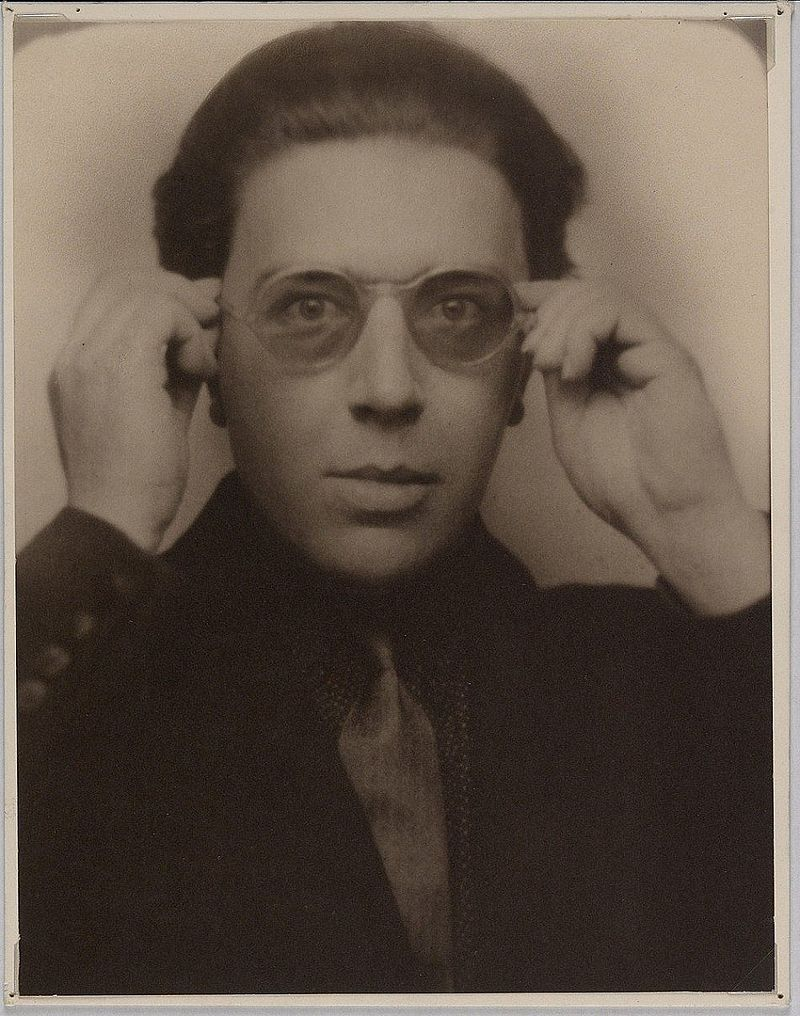
Above: French writer André Breton (1896 – 1966)
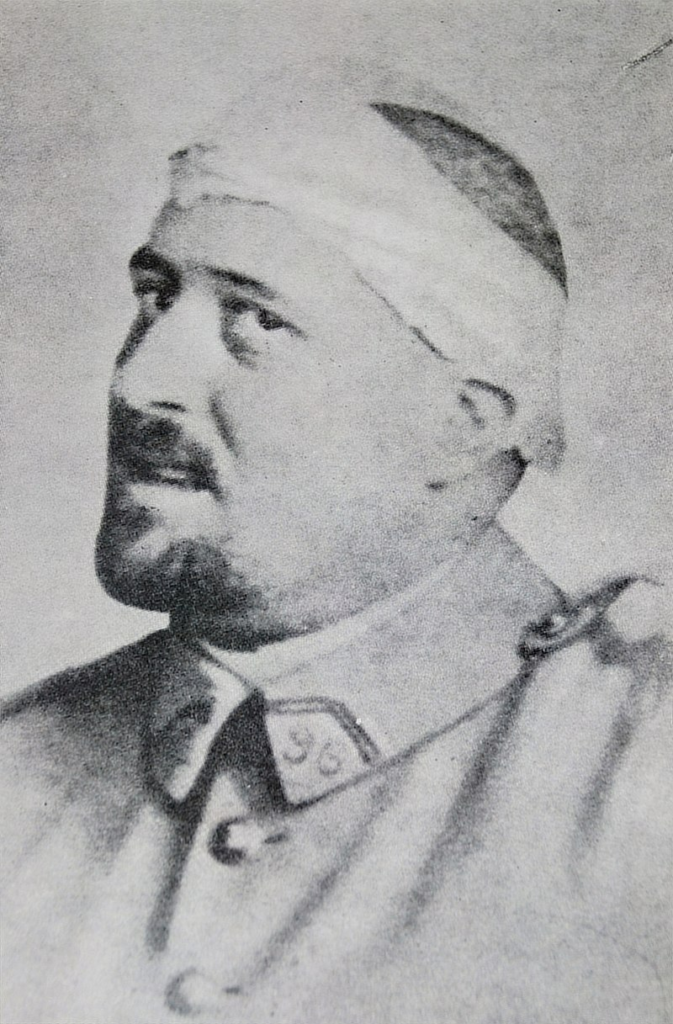
Above: French writer Guillaume Apollinaire (1880 – 1918)
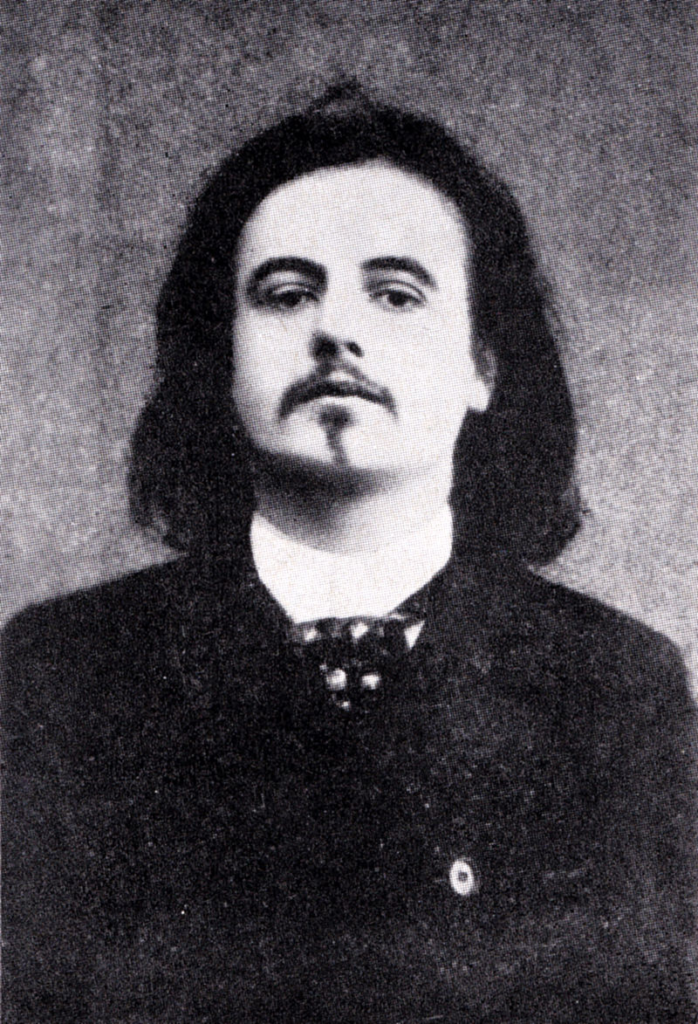
Above: French writer Alfred Jarry (1873 – 1907)
“To find ourselves spoken for in art gives dignity to our pain, our anger, our losses.“
Joy Harjo
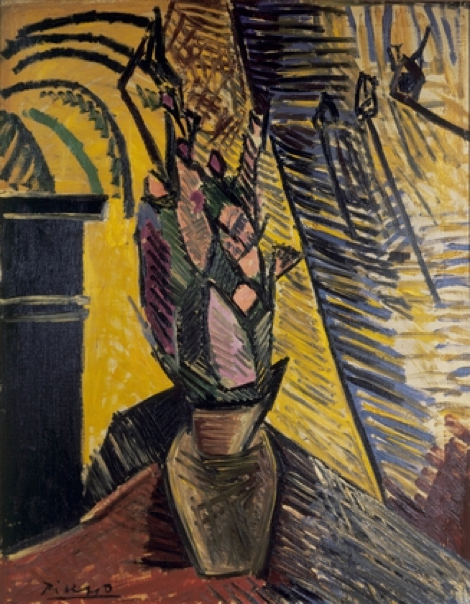
Above: Vase of Flowers, Pablo Picasso (1908), Museum of Modern Art, New York City
In 1911, Picasso was arrested and questioned about the theft of the Mona Lisa from the Louvre.
Suspicion for the crime had initially fallen upon Apollinaire due to his links to Géry Pieret, an artist with a history of thefts from the gallery.
Apollinaire in turn implicated his close friend Picasso, who had also purchased stolen artworks from the artist in the past.
Afraid of a conviction that could result in his deportation to Spain, Picasso denied having ever met Apollinaire.
Both were later cleared of any involvement in the painting’s disappearance.
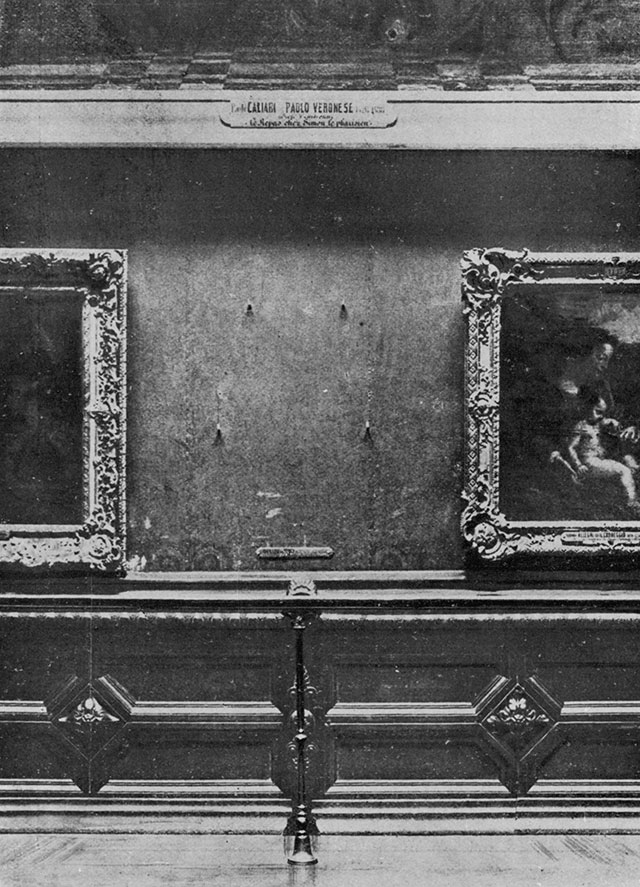
Above: The Mona Lisa‘s vacant place in the Salon Carré, Louvre Museum, Paris, after having been stolen, 1 August 1911
“The artistic decline we are seeing culturally is very prominent, very clear right now if you just look at what people are accepting as art.
It affects me personally because art culture is something so important to me.
Art affects me and it means so much to me whether it be music, literature, fashion, design, fine art — it’s all so important.
I think it’s really what, at least for me, it’s what life is about, it’s what’s important, it’s what’s moving, it’s what inspires you, it’s what life is about.
So when we’re seeing such decline in that art culture right now it’s heartbreaking to me.“
Davie Havok
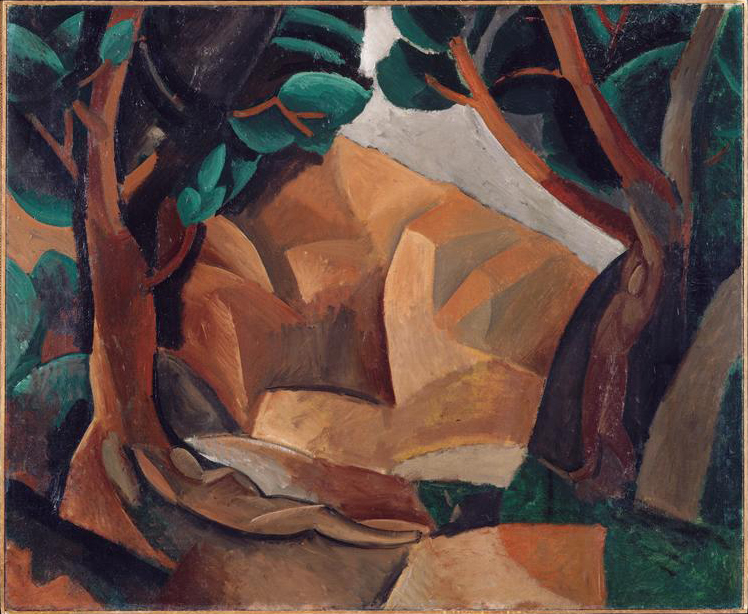
Above: Paysage aux deux figures (Landscape with Two Figures), Pablo Picasso (1908), Musée Picasso, Paris
Synthetic cubism (1912 – 1919) was a further development of the genre of cubism, in which cut paper fragments – often wallpaper or portions of newspaper pages – were pasted into compositions, marking the first use of collage in fine art.
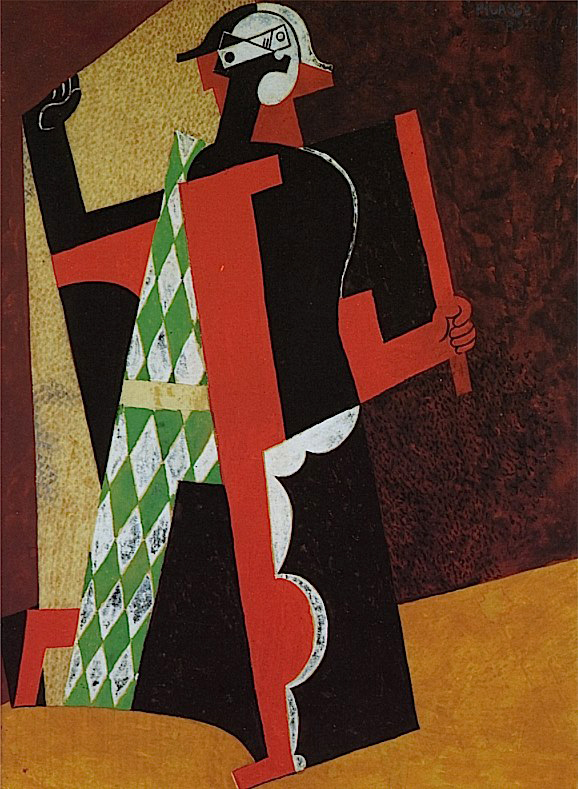
Above: Arlequin (Harlequin), Pablo Picasso (1917)
Between 1915 and 1917, Picasso began a series of paintings depicting highly geometric and minimalist Cubist objects, consisting of either a pipe, a guitar or a glass, with an occasional element of collage.
“Hard-edged square-cut diamonds“, notes art historian John Richardson, “these gems do not always have upside or downside“.
“We need a new name to designate them,” wrote Picasso to Gertrude Stein.
The term “Crystal Cubism” was later used as a result of visual analogies with crystals at the time.
These “little gems” may have been produced by Picasso in response to critics who had claimed his defection from the movement, through his experimentation with classicism within the so-called return to order following the war.
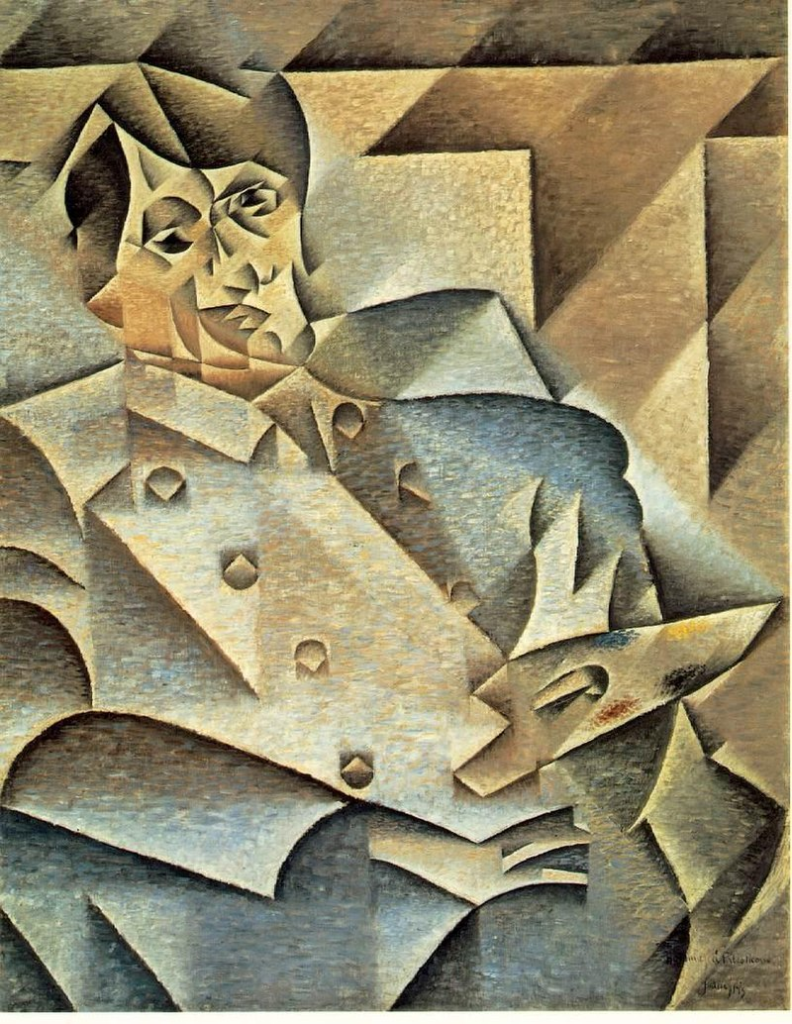
Above: Portrait of Picasso, Juan Gris (1912), Art Institute of Chicago
“If the subject of art
will be a broken jug
a small broken soul
with a great self-pity
what will remain of us
will be like tears of lovers
in a small dirty hotel
when wallpapers dawn“
Zbigniew Herbert
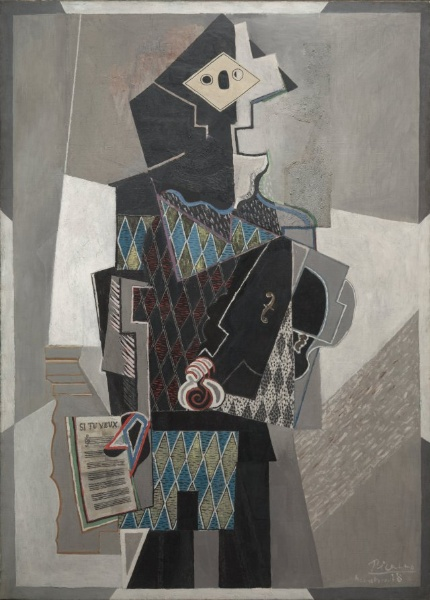
Above: Arlequin au violin (Harlequin with Violin), Pablo Picasso (1918), Cleveland Museum of Art
After acquiring some fame and fortune, Picasso left Olivier for Marcelle Humbert, also known as Eva Gouel.
Picasso included declarations of his love for Eva in many Cubist works.
Picasso was devastated by her premature death from illness at the age of 30 in 1915.
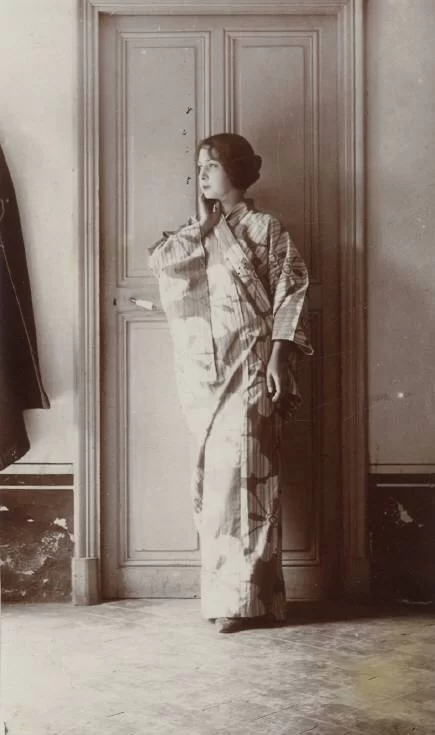
Above: Eva Gouel (née Marcelle Humbert)
(She was the daughter of conservative Polish immigrants.
Eva had different dreams from her parents.
They only wanted their daughter to marry early.
However, Eva shocked them by running away to Montmartre to be part of the vibrant art scene.
She found work at the glitzy and very famous Moulin Rouge cabaret as a seamstress.
It was here where she encountered Pablo Picasso for the very first time.
Eva, although unassuming, quickly captivated the heart of the Spanish artist.
Eventually both of them broke away from their respective partners in order to be together.
Their love affair was intense but not smooth sailing.
Eva Gouel adored Picasso and was totally devoted to him.
However, being with Picasso was a challenge.
Eva continually doubted Picasso’s love and sincerity.
She also felt inadequate and insecure around his intellectual and artistic friends.
It is a well known fact that Picasso was a womanizer.
He had many affairs and marriages.
But Eval Gouel captivated his heart and was the love of his life.
Picasso loved Eva so much that he wrote hidden messages to her in his paintings.
In later interviews, way long after his period with Eva, Picasso always felt emotional when he spoke of her.)
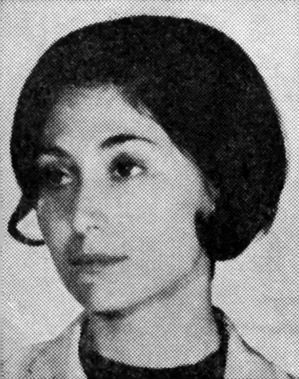
Above: Eva Goual (1885 – 1915)
“Art [of healing] is long, but life is fleeting.”
Hippocrates
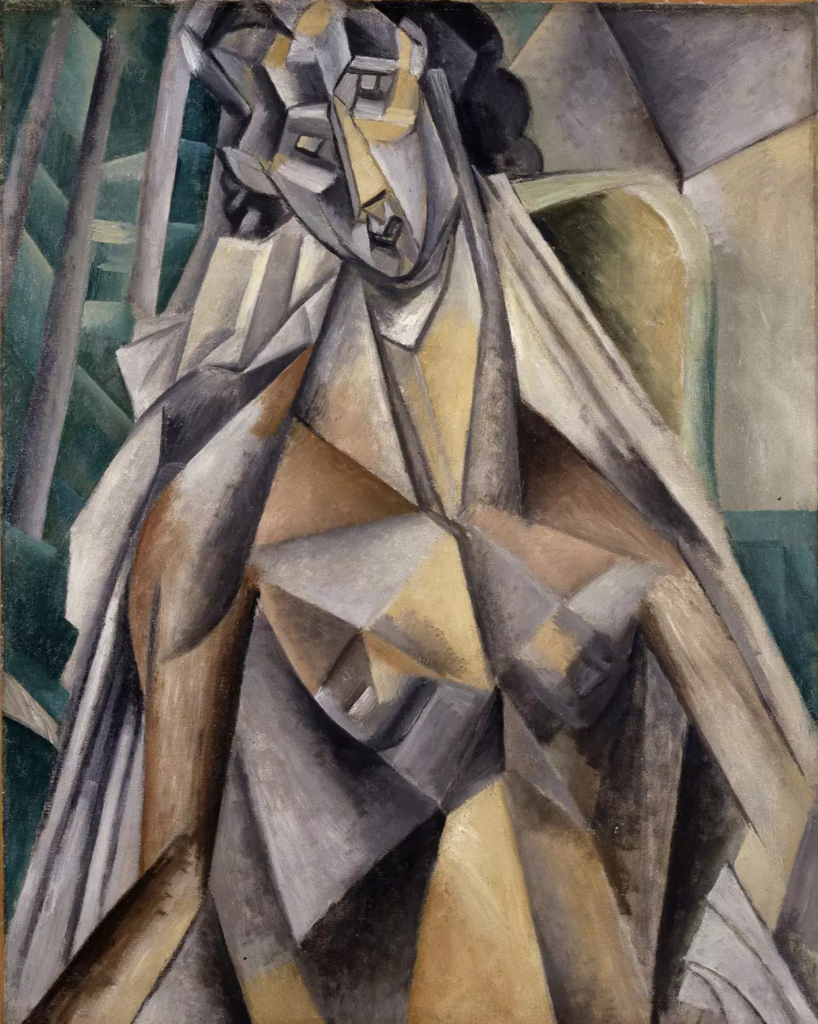
Above: Nude woman in an armchair (Eva), Pablo Picasso (1913)
At the outbreak of World War I in August 1914, Picasso was living in Avignon.
Braque and Derain were mobilized and Apollinaire joined the French artillery, while the Spaniard Juan Gris remained from the Cubist circle.
During the war, Picasso was able to continue painting uninterrupted, unlike his French comrades.
His paintings became more sombre and his life changed with dramatic consequences.
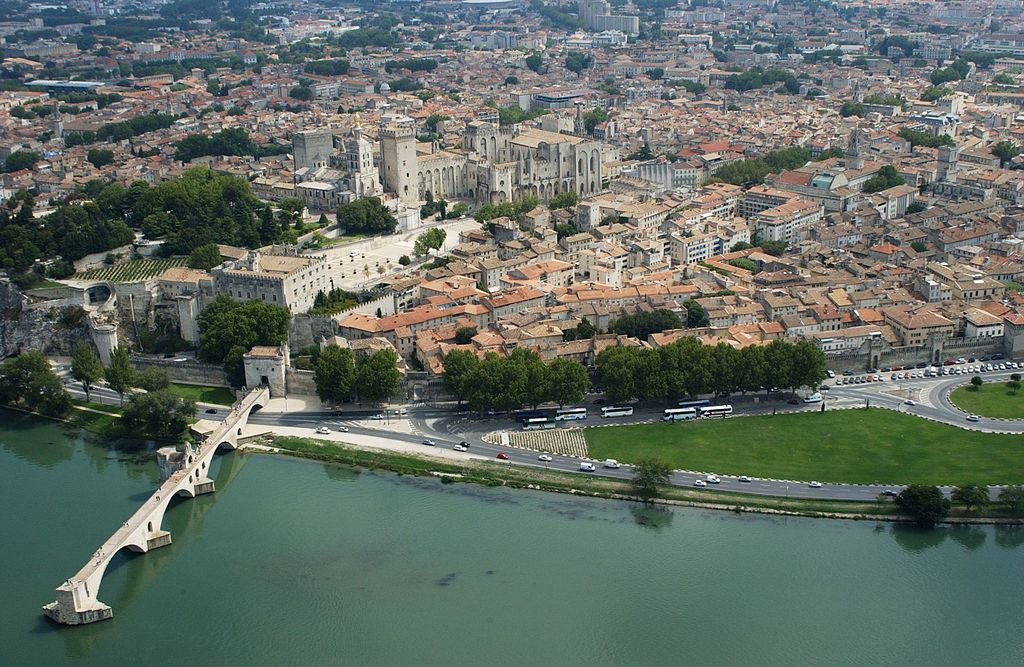
Above: Avignon, France
After the loss of Eva Gouel, Picasso had an affair with Gaby Lespinasse.
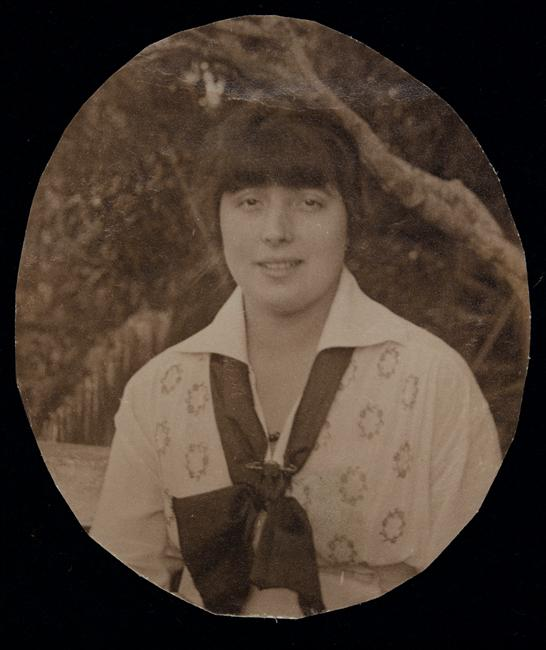
Above: Gabrielle Lespinasse (née Gabrielle Depeyre)(1888 – 1970)
The exact circumstances by which Lespinasse and Pablo Picasso met are in doubt, but the romance between the 27-year-old Parisian and the 34-year-old artist appears to have begun in the autumn of 1915 while Picasso’s previous partner, Eva Gouel, was fatally ill with tuberculosis.
Lespinasse lived on the top floor of a house on Boulevard Raspail, near the painter’s Paris studio.
“Gaby“, as Picasso called her, was a “ravishing girl“, “a great beauty, especially in profile, with her fluffy bangs, big moody eyes and a beautiful, upturned nose.
One of those relaxed, cat-like girls, as she dreamed of Colette.” according to biographer, art critic and Picasso confidante John Richardson.
There were two reasons for secrecy.
First was Eva Gouel’s deadly illness (she died in 1915).
Another was the well-established relationship between Gaby and a Franco-American artist and poet, Herbert Lespinasse (1884 – 1972), whose name she had already adopted, even before her marriage to him.
The wealthy Herbert Lespinasse was one of the first artists to settle in the small French port of Saint-Tropez on the Mediterranean Sea and his house there became a gathering place for Parisian bohemians.
Apparently, Picasso and Gaby used it as a place to stay, as did many other artists and intellectuals who had fled Paris during World War I.
In November and December 1915, Picasso was almost always there to see Gabrielle.
Picasso wooed Lespinasse with naturalistic drawings and watercolors, more to flatter her than to advance his art.
On some drawings and on many wooden frames, he left compromising messages of love that were only meant for the two of them.
Most of Picasso’s messages in the drawings were later blurred out before they were sold.
In many cases, only the dedication de tout mon cœur (“from my whole heart“) and Picasso’s signature were preserved.
On one passe-partout (mat) of the collage of a rectangular text (Je t’aime Gaby) with an ornamental border, surrounded by four oval miniatures and two oval miniature photographs, there is a short note from Picasso:
J’ai demandé ta main au Bon Dieu. Paris 22 Fevrier 1916
(“I asked God for your hand. Paris, 22 February 1916“).
On examination, John Richardson opined that the document was the first serious marriage intention of the Picasso, a self-declared atheist who had previously strictly denied his faith and had never shown any interest in marriage.
In addition to the portraits Picasso painted for her, he also made watercolors Provencal Interiors (bedroom, dining room, kitchen), presumably interior views of Herbert Lespinasse’s house in Saint-Tropez, and made a necklace of painted wooden balls with different geometric motifs.
The four miniature masterpieces on the marriage proposal (Richardson called them “whimsical“) were three oval cubist still lifes and an allegorical portrait of the Gaby but concluded “the many portrait sketches he made of her – while charming – are too slight to be considered a major part of his work.”
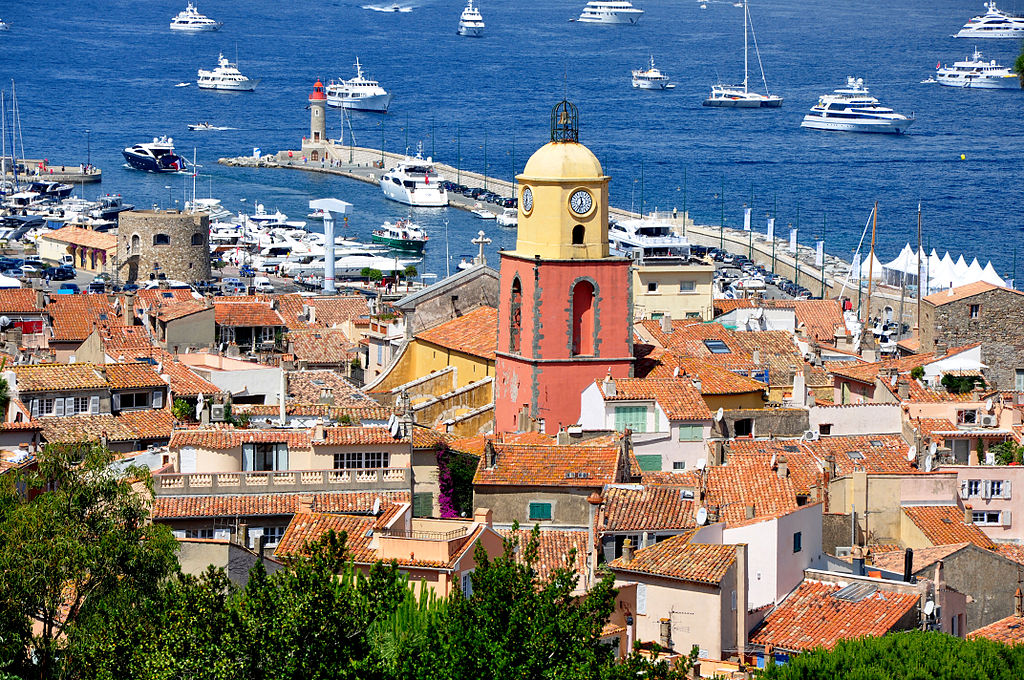
Above: Saint Tropez, France
During the spring of 1916, Apollinaire returned from the front wounded.
They renewed their friendship, but Picasso began to frequent new social circles.
Towards the end of World War I, Picasso became involved with Serge Diaghilev’s Ballets Russes.
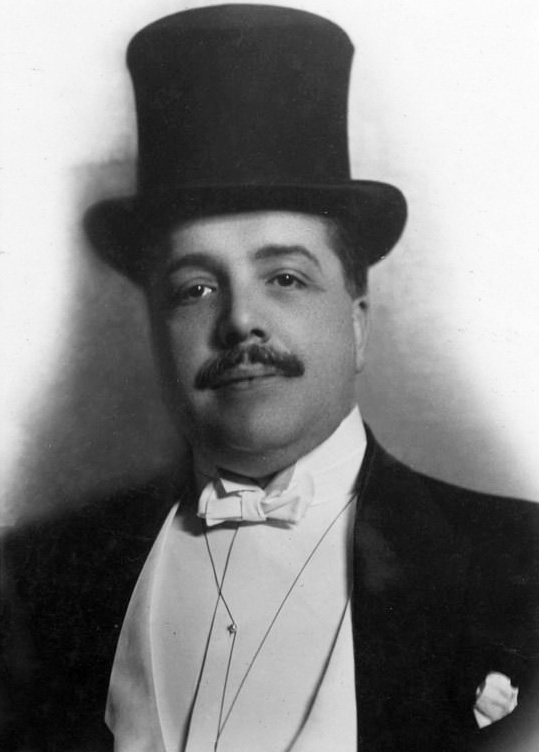
Above: Art critic / ballet impresario Sergei Diaghilev (1872 – 1929)
(The Ballets Russes was an itinerant ballet company begun in Paris that performed between 1909 and 1929 throughout Europe and on tours to North and South America.
The company never performed in Russia, where the Revolution disrupted society.
After its initial Paris season, the company had no formal ties there.
Originally conceived by impresario Sergei Diaghilev, the Ballets Russes is widely regarded as the most influential ballet company of the 20th century, in part because it promoted ground-breaking artistic collaborations among young choreographers, composers, designers, and dancers, all at the forefront of their several fields.
Diaghilev commissioned works from composers such as Igor Stravinsky, Claude Debussy, Sergei Prokofiev, Erik Satie, and Maurice Ravel, artists such as Vasily Kandinsky, Alexandre Benois, Pablo Picasso, and Henri Matisse, and costume designers Léon Bakst and Coco Chanel.
The company’s productions created a huge sensation, completely reinvigorating the art of performing dance, bringing many visual artists to public attention, and significantly affecting the course of musical composition.
It also introduced European and American audiences to tales, music, and design motifs drawn from Russian folklore.
The company’s employment of European avant-garde art went on to influence broader artistic and popular culture of the early 20th century, not least the development of Art Deco.
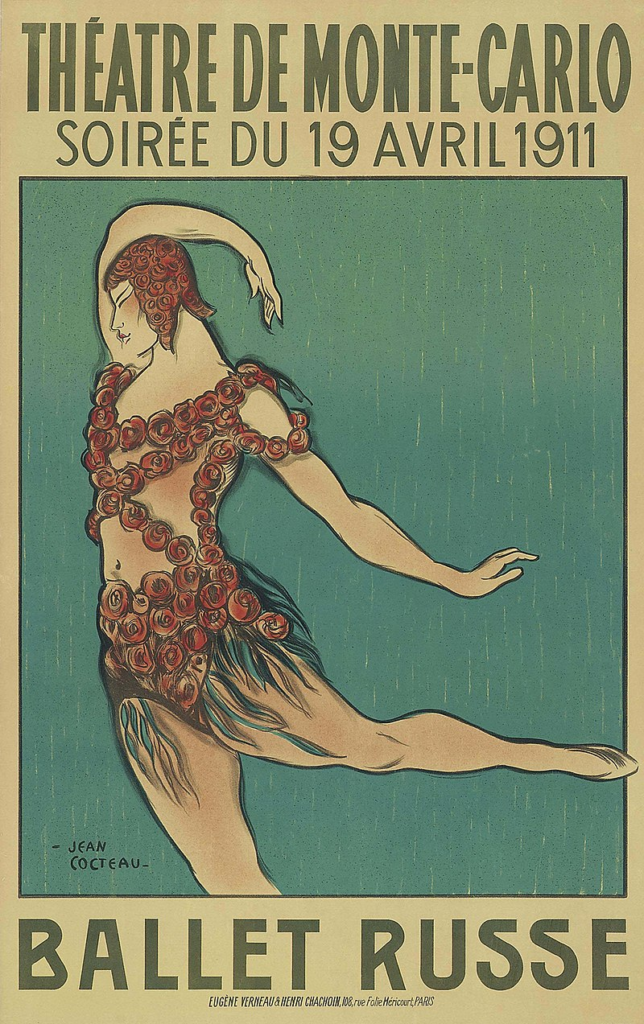
Among Picasso’s friends during this period were Jean Cocteau, Jean Hugo, Juan Gris, and others.
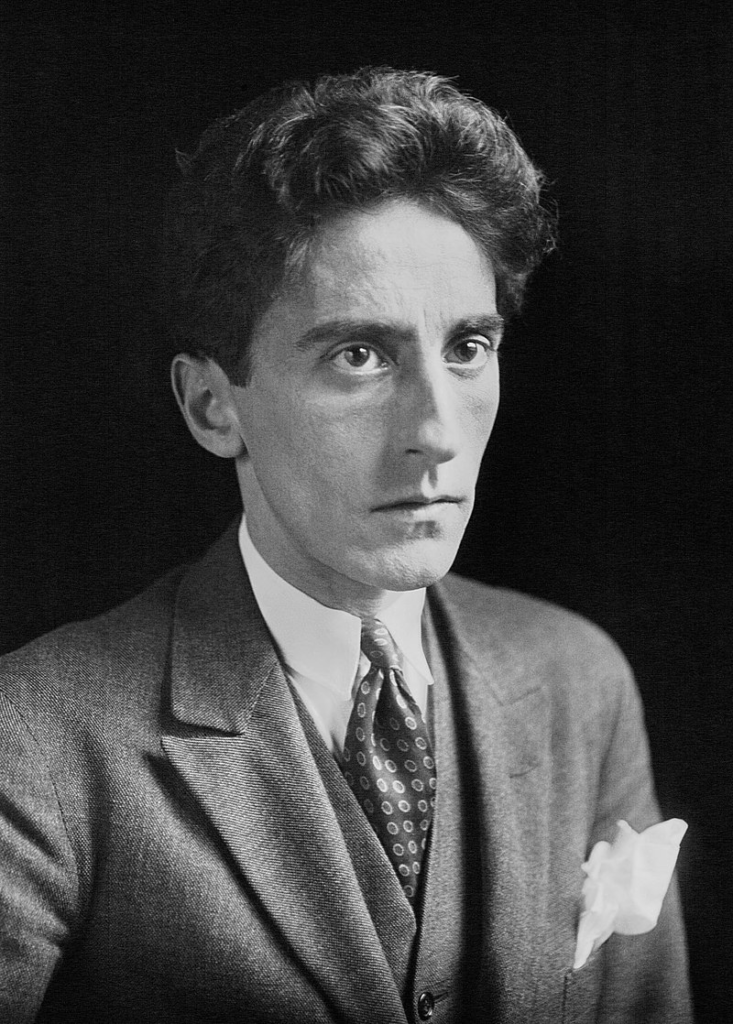
Above: French artist / writer Jean Cocteau (1889 – 1963)
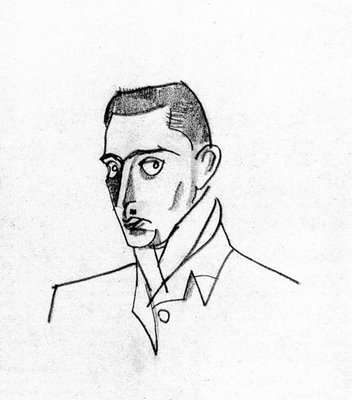
Above: Self portrait, French artist Jean Hugo (1894 – 1984)
“I do believe that our lives and our art go together.
Who I am and what I write are the same.“
Maxine Hong Kingston
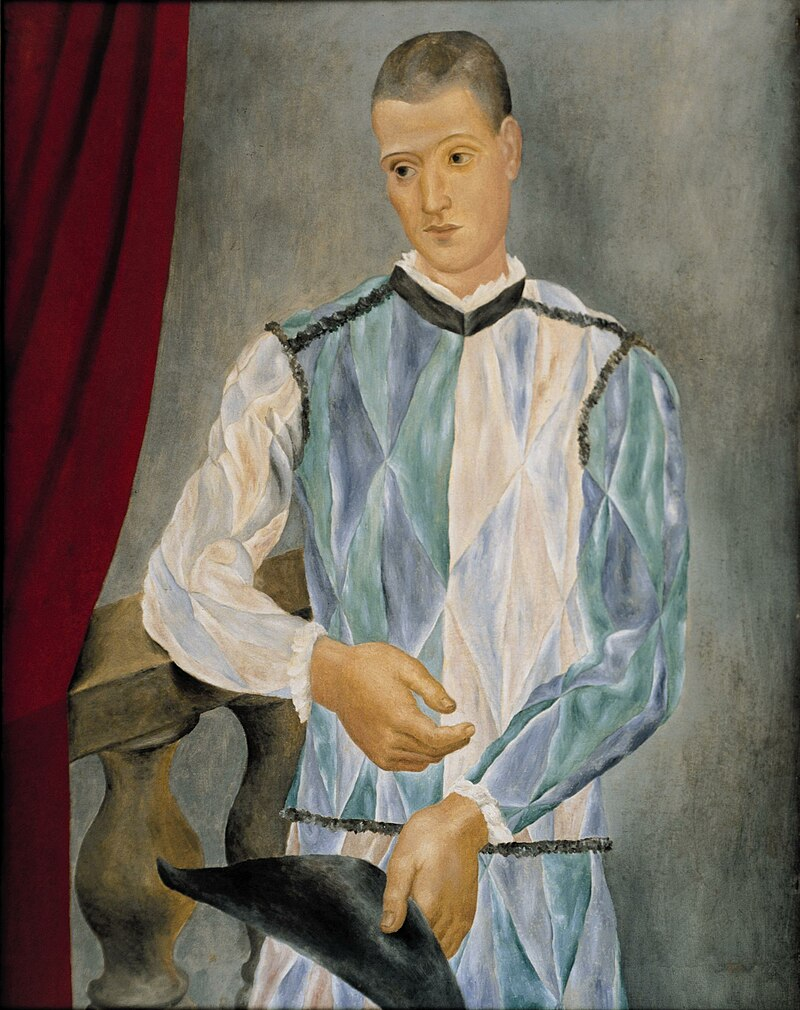
Above: Harlequin, Pablo Picasso (1917), Museo Picasso, Barcelona
In the summer of 1918, Picasso married Olga Khokhlova, a ballerina with Sergei Diaghilev’s troupe, for whom Picasso was designing a ballet, Erik Satie’s Parade, in Rome.
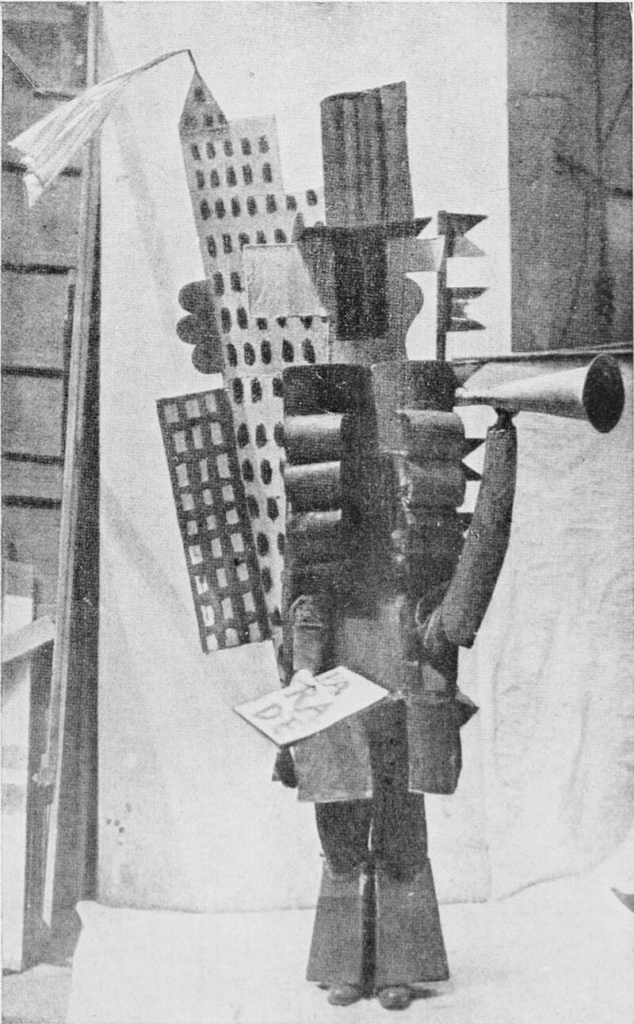
Above: Costume design by Pablo Picasso representing skyscrapers and boulevards, for Serge Diaghilev’s Ballets Russes performance of Parade at Théâtre du Châtelet, Paris 18 May 1917
They spent their honeymoon near Biarritz in the villa of glamorous Chilean art patron Eugenia Errázuriz.
Khokhlova introduced Picasso to high society, formal dinner parties, and other dimensions of the life of the rich in 1920s Paris.
The two had a son, Paulo Picasso, who would grow up to be a motorcycle racer and chauffeur to his father.
Khokhlova’s insistence on social propriety clashed with Picasso’s bohemian tendencies and the two lived in a state of constant conflict.
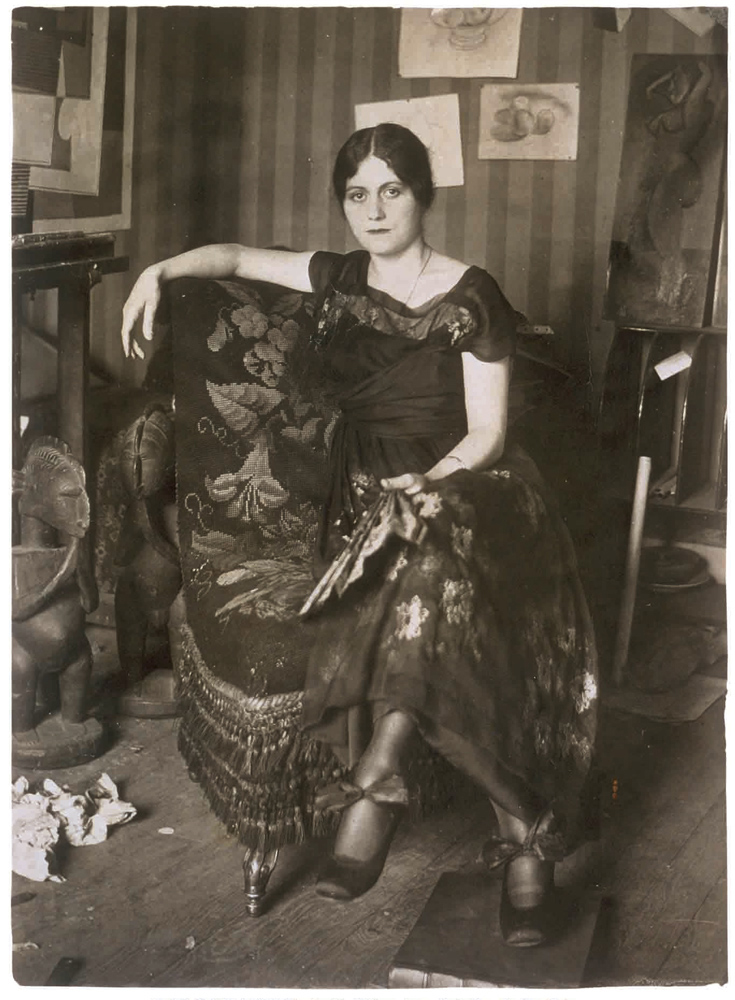
Above: Russian ballet dancer Olga Khokhlova (1891 – 1955)
Khokhlova was born in the town of Nizhyn, Ukraine on 17 June 1891.
Her father Stepan Khokhlov was a Colonel in the Russian Imperial Army.
Her mother Lydia Zinchenko was of Ukrainian descent.
The Khokhlov family had three sons and two daughters.
Olga decided to be a ballerina after being encouraged by a friend’s sister who had joined the Diaghilev ballet.
She studied in Saint Petersburg at a private ballet school and successfully auditioned to join the Ballets Russes of impresario Sergei Diaghilev, based in Paris as a member of the ballet company.
She performed in Europe and later America as a member of the company.
In 1917, Pablo Picasso became involved in Parade, a ballet produced by Sergei Diaghilev, to music by Erik Satie and plot by Jean Cocteau.
The ballet premiered on 18 May 1917 at the Théâtre du Châtelet in Paris.
Picasso had designed the costumes and set for the ballet.
After seeing Khokhlova dance in rehearsals for a ballet named Les Femmes de Bonne Humeur in Italy, he fell in love with her.
After meeting Picasso, Khokhlova left the dance company, which toured South America.
She stayed in Barcelona with him.
He introduced her to his family.
At first, his mother disapproved of the idea of having Khokhlova as a daughter-in-law.
However, Khokhlova was intent on marrying Picasso.
They maintained a long engagement, in which she initially resisted sleeping with him.
Khokhlova was isolated and reliant on Picasso, having become trapped in Spain without a passport.
At this time, Picasso painted his first portrait of her as a Spanish girl (Olga Khokhlova in Mantilla).
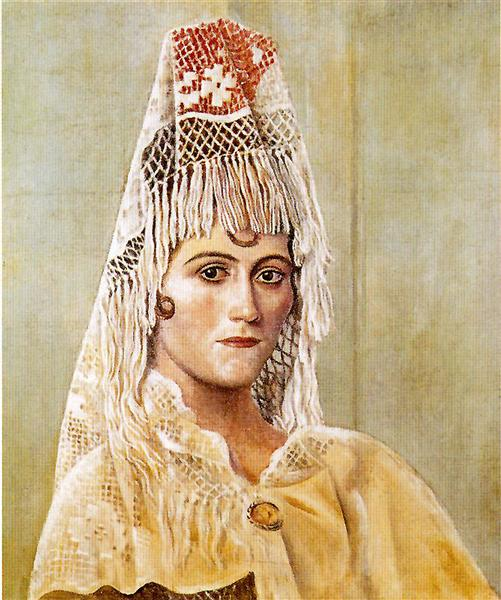
Above: Olga Khokhlova in Mantilla, Pablo Picasso (1917)
After waiting six months for a visa, Khokhlova returned with Picasso to Paris.
They lived apart for six months, with Khokhlova living at Hôtel Lutétia and Picasso living at his rented villa in Montrouge, a Parisian suburb.
To celebrate their engagement, Picasso painted Olga in an Armchair, a traditional portrait of Khokhlova in the style of Ingres, which depicts her wearing a black dress and holding a fan.
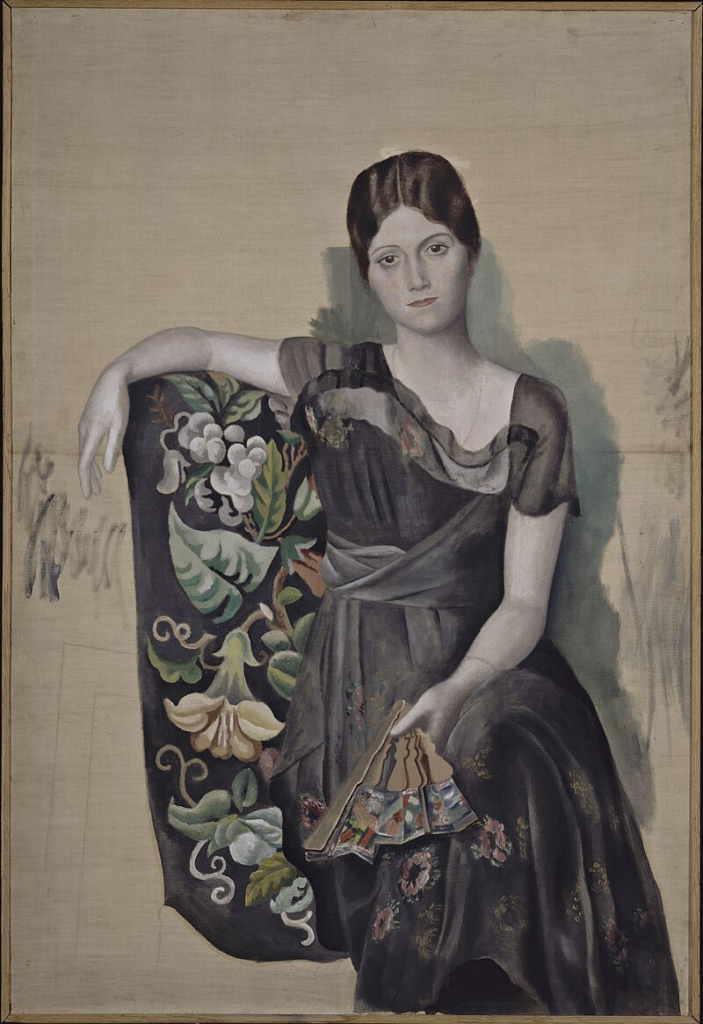
Above: Portrait d’Olga dans un fauteuil(Olga in the Armchair), Pablo Picasso (1918), Musée Picasso, Paris
Khokhlova married Picasso on 12 July 1918, at the Russian Orthodox Cathedral at the Rue Daru in Paris.
Jean Cocteau and Max Jacob were witnesses to the marriage.
The wedding had been postponed from May 1918, due to Khokhlova experiencing pain from a foot injury.
The injury forced her to undergo an operation that resulted in having to wear plaster encasing her right leg.
It was only when the leg had healed that the marriage could take place.
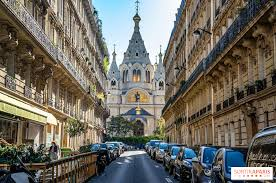
Above: Cathédrale Saint-Alexandre-Nevsky de Paris
After the wedding, the Picassos spent their honeymoon at the villa of Eugenia Errázuriz in Biarritz, where Picasso made drawings of his wife.
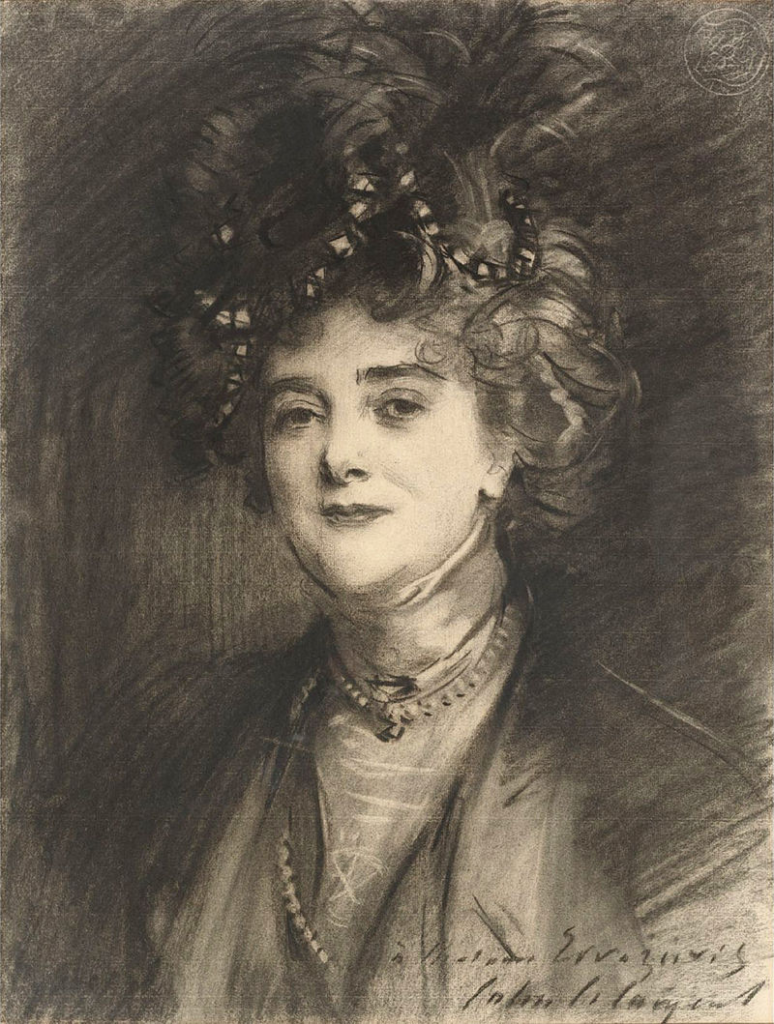
Above: Chilean interior designer Eugenia Errázuriz (1860 – 1951), John Singer Sargent (1905)

Above: Biarritz, France
The Picassos spent their honeymoon in Biarritz, where Olga was confined most of the time to an armchair or chaise longue.
This is exactly how Picasso painted her:
Serious, melancholic, always a bit detached and never smiling.
That is how she was seen and perceived by the public.
That is how she was seen by Picasso’s friends, who took restraint for snobbery and haughtiness.
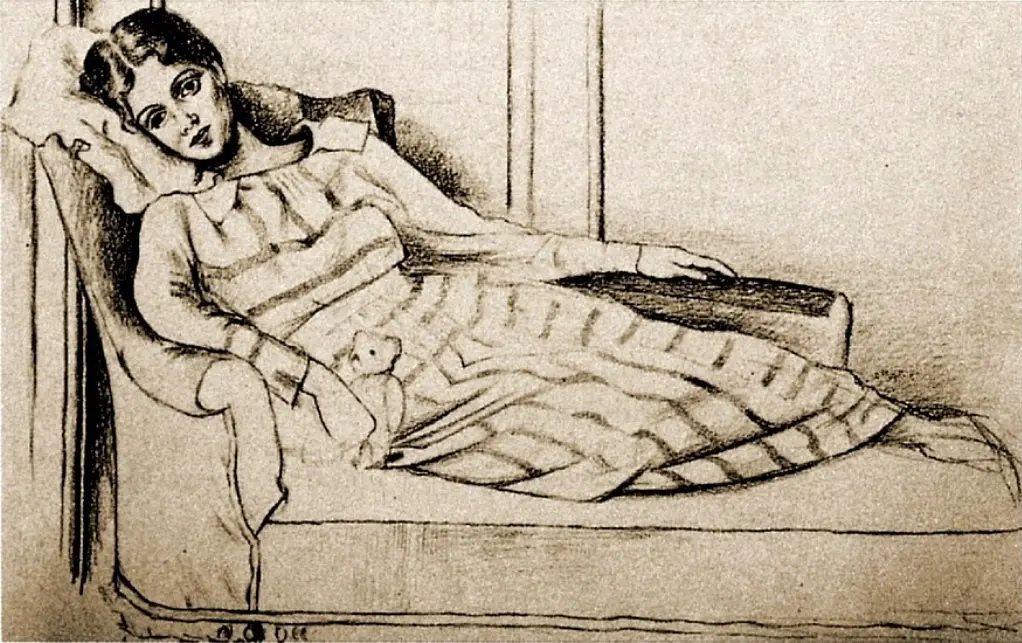
Above: Portrait of Olga Khokhlova, Pablo Picasso (1918)
By September 1918, Khokhlova had recovered from her injury, but required rehabilitation.
She never danced again in public.
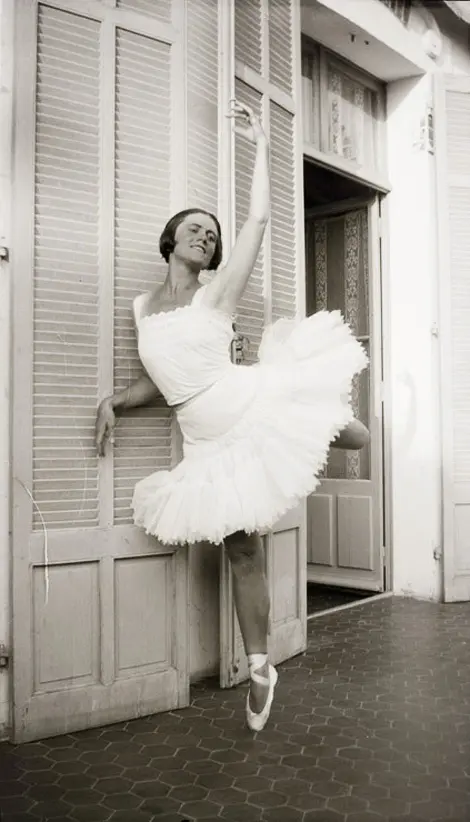
Above: Olga at Juan les Pins, 1925
By October 1918, the couple returned to Paris in search of an apartment.
Picasso’s art dealer, Paul Rosenberg, found a suitable apartment next to his own home, at 23, Rue La Boétie, into which the Picassos moved the week before Christmas 1918.
The Picassos’ apartment consisted of a single, spacious floor divided into his and her realms.
Olga furnished her (or rather, their) part elegantly and stylishly and kept things tidy there (scrupulousness was on the list of features the artist’s bohemian friends did not like about his wife).
This is how Brassaï described their accommodation:
“There was a large dining room with a round table extended with leaves in the middle of the room, a sideboard and pedestal tables in every corner, a parlour, decorated all in white, and a bedroom with brass twin beds.
No clutter, not a speck of dust.
Polished, gleaming wood floors and furniture.“
Pablo domineered in the other part of the house: there was his workshop, in which reigned chaos, corresponding to the artist’s temperament.
It was there where Picasso kept a box with different things in memory of his first big love Fernande Olivier.
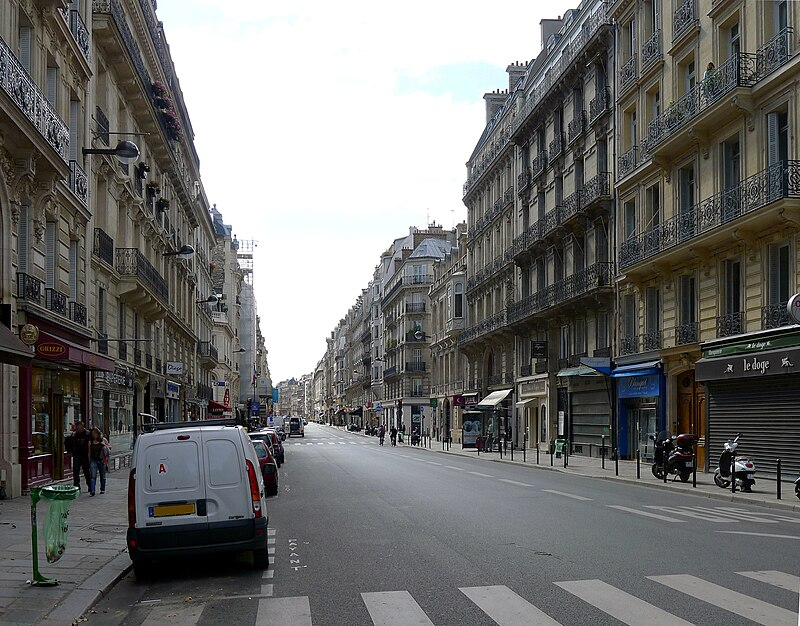
Above: rue La Boétie, Paris
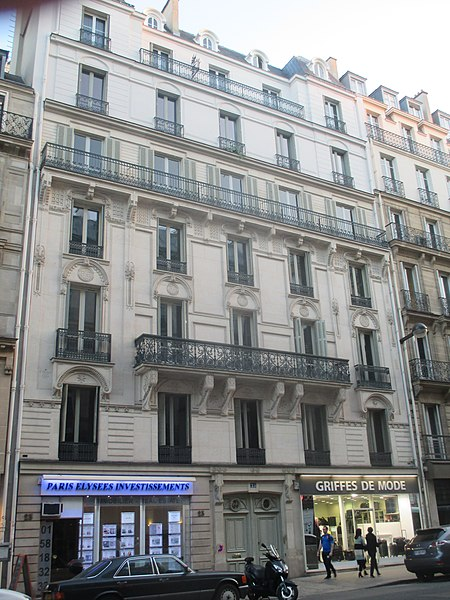
Above: 23, rue la Boétie, Paris
On 4 February 1921, Khokhlova gave birth to a boy Paul Joseph Picasso usually known as ‘Paulo‘.
From then on, Khokhlova and Picasso’s relationship deteriorated.
Picasso was proud of Khokhlova and his son, but she became obsessively protective of the boy.
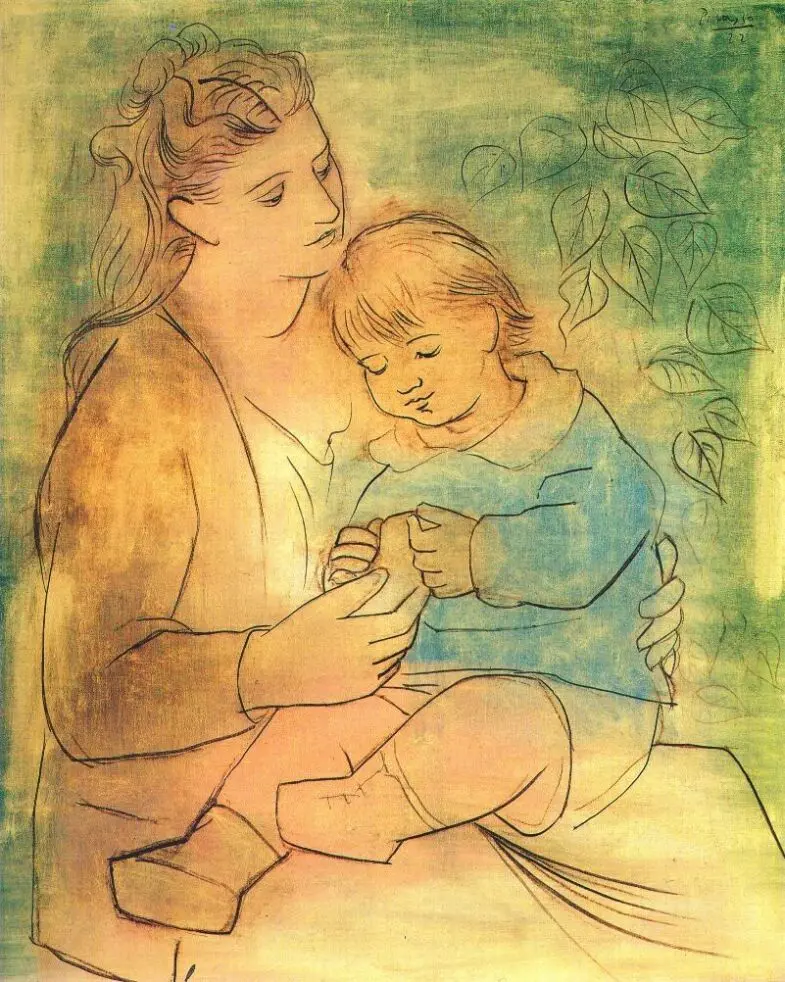
Above: Mother and Son, Pablo Picasso (1922)
She enjoyed the prestige of being Picasso’s wife and the idea of a celebrity lifestyle.
When this drew criticism from Picasso’s friends, he would blame Khokhlova for her refined tastes.
Picasso’s bohemian friends and colleagues criticized him for turning into a real bourgeois.
Of course, it was his wife who was blamed for it.
However, the artist himself willingly began to play the role of a respectable gentleman and a right-minded husband.
He began to wear expensive suits, accompanied Olga at the balls, and received the Parisian beau-monde.
His former friends were, as they would say now, too “casual” and did not fit well into the interior of his living room.
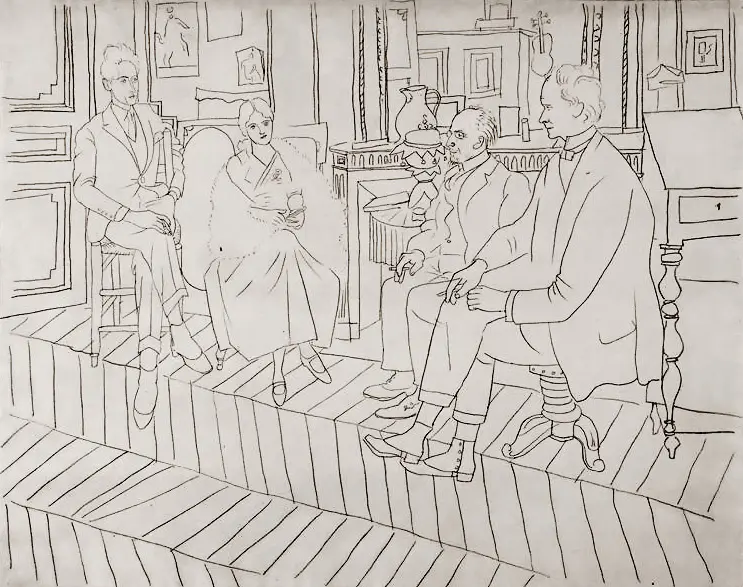
Above: In the lounge on rue La Boétie: Jean Cocteau, Olga, Eric Satie, Clive Bell, Pablo Picasso (1919)
At first Picasso was delighted to have a son.
Paintings and drawings of the baby in his mother’s arms testify to paternal pride and love.
However, Olga became an obsessively overprotective parent, and, according to the biographer John Richardson, got into the role of the socialite, the wife of the world’s foremost painter, and now also the mother of the family.
A bohemian at heart, Picasso would try to adjust to her notion of how a celebrated artist should live.
He was proud of Olga and the ambience she provided, but this enjoyment would come under increasing attack from erstwhile friends.
“You see, Olga likes tea, caviar, pastries, and so on,” Picasso told one of his models.
“Me, I like sausage and beans.“
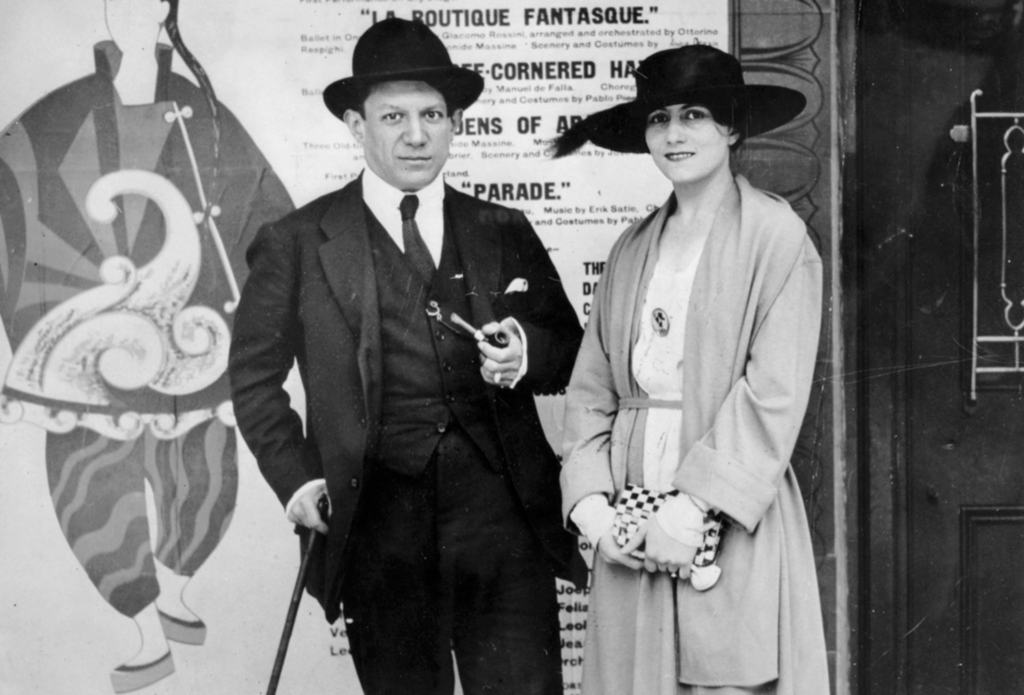
Above: Pablo and Olga Picasso
In summer 1922, she became seriously ill while the Picassos were staying at the resort of Dinard.
In mid-September, she was rushed to hospital in Paris for an emergency operation.
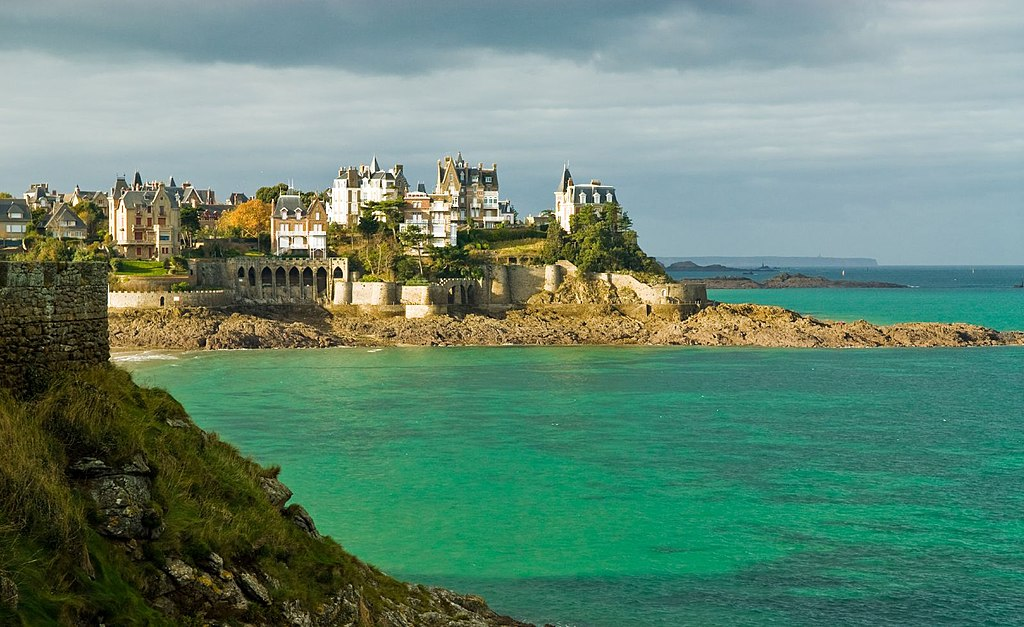
Above: Promenade du Moulinet, Vue sur la Pointe de la Malouine, Dinard, Bretagne, France
The Picassos continued being pillars of the Parisian beau monde.
Countless dinners and social events worn Pablo down, but he used them to acquire useful acquaintances.
At that time, Olga’s attitude to her son became another bone of contention between the spouses.
The artist was not happy at the way she pampered and monitored the boy.
Picasso’s constant irritation found a way out in his paintings.
By the end of the summer of 1923, Picasso’s passion for Khokhlova had cooled, as he took possession of the floor above his apartment and began to frequent the brothels in Paris.
No maids were allowed up there.
Even Olga had to ask permission if she wanted to visit him.
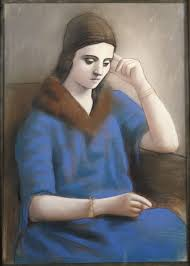
Above: Olga Lost in Thought, Pablo Picasso (1923)
In 1927, Picasso began an affair with a 17-year-old French girl, Marie-Thérèse Walter.
He continued to play the part of the conventional husband and father but continued his affair with his new mistress in secret.
On 8 January 1927, Walter first met Picasso in front of the Galeries Lafayette in Paris.
At the time, she was living with her mother and sisters at Maisons-Alfort, a suburb southeast of Paris.
Picasso approached her and said:
“You have an interesting face.
I would like to do a portrait of you.
I am Picasso.”
Walter was unfamiliar with his name but was flattered by the attention.
The relationship began after Picasso invited Walter to visit his studio on 11 January 1927, which was situated on the floor above his apartment on Rue La Boétie.
He studied her face and body and invited her to return the next day.
The visits continued daily causing Walter to tell her mother that she had a job.
She said:
“He told me that I had saved his life, but I had no idea what he meant.”
A week after they first met, they were in a sexual relationship.
At the time, Picasso was married to Olga Khokhlova, a Ukrainian ballerina, with whom he had a five-year-old son.
He and Walter, then 17 years old, began a relationship which was kept secret from his wife until 1935.
Walter reinvigorated Picasso’s artwork.
He began to draw her portrait repeatedly, inspired by her fresh, athletic appearance, curves and oval face.
Walter was very active and involved in rowing, gymnastics and cycling.
Walter commented:
“My life with him was always secret, calm, and peaceful.
We said nothing to anyone.
We were happy like that.
We did not ask anything more.”
In the summer of 1928, the Picasso family stayed at Dinard, where Picasso also installed Walter at a summer camp for girls and arranged to see her in secret at his rented beach cabana.
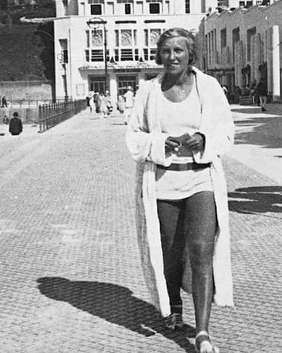
Above: French model Marie-Thérèse Walter (1909 – 1977) at Dinard (1928)
The artist soon found himself leading two separate lives, and this bifurcated pattern would be reflected in Picasso’s bifurcated imagery.
Marie-Thérèse’s images would be suffused with rampant sexuality, whereas those of Olga would reek of rage.
But for quite a long time, Picasso managed to make sure that those parallel lives never met.
Even when the artist was staying in Dinard with his family, he used every opportunity to visit Marie-Thérèse, whom he kept secreted in a pension nearby.
During that vacation, Olga’s haemorrhages started up again, more seriously than ever.
She had to return to Paris on 5 September 1928, where she would undergo another operation.
She again underwent an operation that required convalescence and, despite leaving the clinic on 10 October, was forced to return for a second operation before returning home in early December.
She was back at the clinic by Christmas.
In total, she spent almost five months in the hospital, only occasionally returning home.
All that time, Picasso could easily meet with Marie-Thérèse.
Of course, at some point, Olga figured out that she had a rival.
And although she did not seem to perceive Marie-Thérèse as a serious threat to their marriage with Pablo, she also didn’t want to be humiliated.
But his wife’s tears and exhortations caused only Picasso’s anger and remorse.
In 1929, he created his Large Nude in a Red Armchair.
Without mentioning the name of the heroine directly, the artist put into his painting all his growing hatred for Olga.
Broken limbs, mouth opened in agony…
Unable to remove her from his life, Picasso used his canvas to mercilessly disfigure a woman whom he lovingly painted in another armchair only 10 years ago.
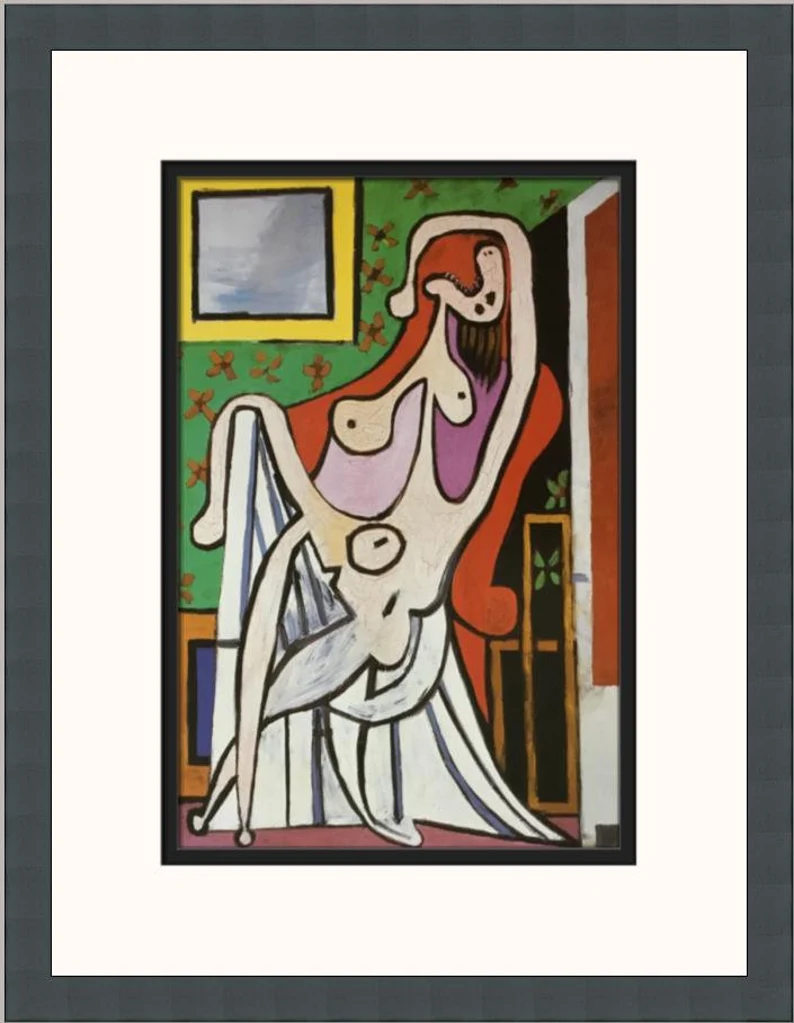
Above: Large nude in a red armchair, Pablo Picasso (1929)
In 1930, Picasso purchased a château located an hour northwest of Paris named Boisgeloup, where Walter spent the week with him and Khokhlova would visit with Paulo on weekends.
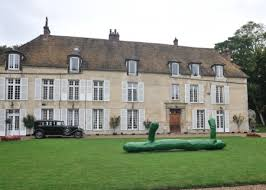
Above: Château de Boisgeloup, Gisor, Normandie, France
At Picasso’s first major retrospective at the Galeries Georges Petit in 1932, he blatantly displayed numerous works of his mistress.
Khokhlova had become obsessively jealous and suspicious.
Picasso’s grandson, Bernard Ruiz-Picasso, considered that by this time, Olga knew about the affair.
The scales did not fall from Olga’s eyes until Picasso’s major retrospective in 1932.
Her husband’s passion for another woman appeared to her in its entirety — from one shameless picture to another.
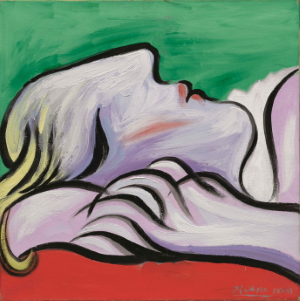
Above: Le repos (Rest), Pablo Picasso (1932)
Picasso’s depictions of his wife were now reflective of her perturbed state.
Over Christmas in 1931, he painted Woman with a Stiletto, a harrowing caricature of his unhappy wife.
Amazingly, Olga continued living with Picasso.
The last straw became Marie-Thérèse’s pregnancy.
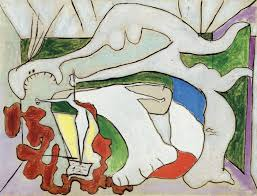
Above: Woman with a stiletto, Pablo Picasso
In 1935, Khokhlova learned of the affair from a friend, who also informed her that Walter was pregnant.
She was devastated, filed for divorce, and immediately moved to the Hôtel California with Paulo.
She spent the next 20 years living in Parisian hotels, Boisgeloup and the South of France.
Paulo. Picasso and Khokhlova never divorced, and although Picasso was intent on it and explored the legal possibilities, Khokhlova was “bitterly opposed to the whole thing“.
Instead, she impounded his work until he came to terms eventually paying her a large allowance.
Picasso refused to divide his property evenly with her, as required by French law, so Khokhlova stayed legally married to him until her death from cancer in Cannes on 11 February 1955.
She was mistakenly buried in an English rather than a Russian cemetery.
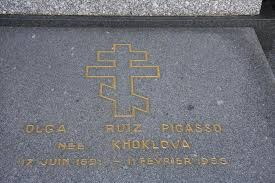
Above: Olga Picasso’s final resting place, Cannes, France
“For art to be art it has to cure.“
Alejandro Jodorowsky
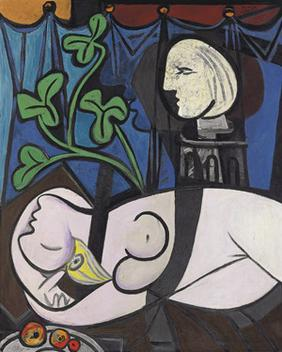
Above: Nude, green leaves and bust, Pablo Picasso (1932), Tate Modern, London, England
During the same period that Picasso collaborated with Diaghilev’s troupe, he and Igor Stravinsky collaborated on Pulcinella in 1920.
Picasso took the opportunity to make several drawings of the composer.
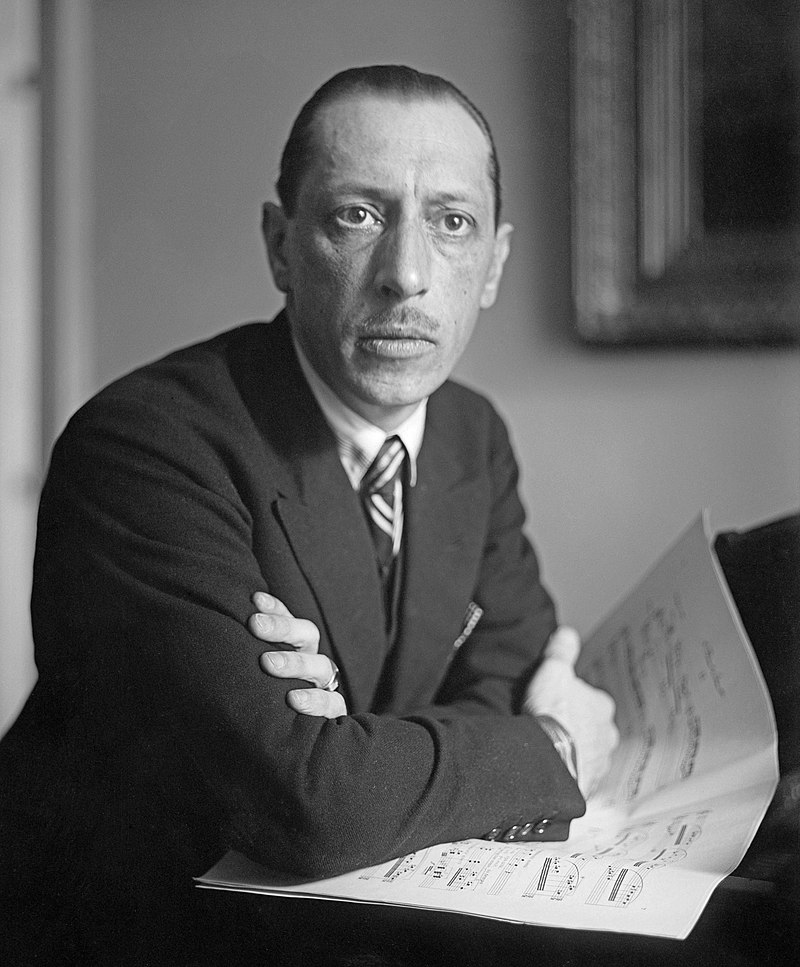
Above: Russian composer Igor Stravinsky (1882 – 1971)
“A work of art wastes away and becomes lustreless in surroundings where it has a price but not a value.
It radiates only when surrounded by love.
It is bound to wilt in a world where the rich have no time and the cultivated no money.
But it never harmonizes with borrowed greatness.“
Ernst Jünger
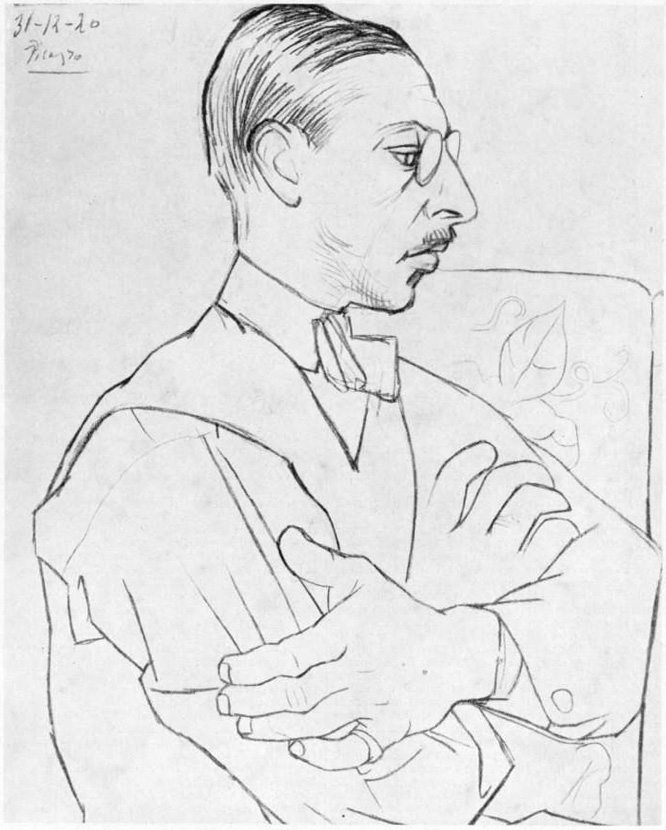
Above: Igor Stravinsky, Pablo Picasso (1920), Program for the 14th season of the Ballets Russes at the Théâtre de la Gaîté-Lyrique in Paris
In 1934, Walter became pregnant.
She informed Picasso on Christmas Eve 1934.
Khokhlova had already left the family apartment on Rue La Boétie that year, but rather than moving in with Walter, Picasso rented a neighbouring house for her.
On 5 September 1935, Picasso and Walter’s daughter, María de la Concepción, called “Maya“, was born in Boulogne-Billancourt.
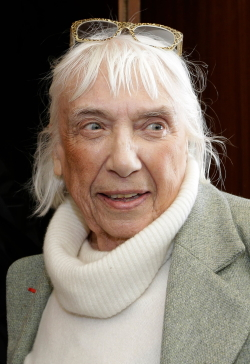
Above: French art expert Maya Ruiz-Picasso (née María de la Concepción “Maya” Widmaier-Picasso)(1935 – 2022)
Walter and Maya stayed with Picasso at Juan-les-Pins in the South of France from 25 March to 14 May 1936.

Above: Juan-les-Pins, France
They then moved to Le Tremblay-sur-Mauldre, 25 kilometres (16 mi) from Versailles, in autumn 1937.
Ambroise Vollard (1866 – 1939), a great art dealer and gallery owner, had a residence in Tremblay.
Picasso lived in Tremblay in 1936 in an old farm, offered by Ambroise Vollard, where he had set up his studio and where he produced a series of paintings.
Picasso visited on the weekends and some weekdays to play with his daughter.
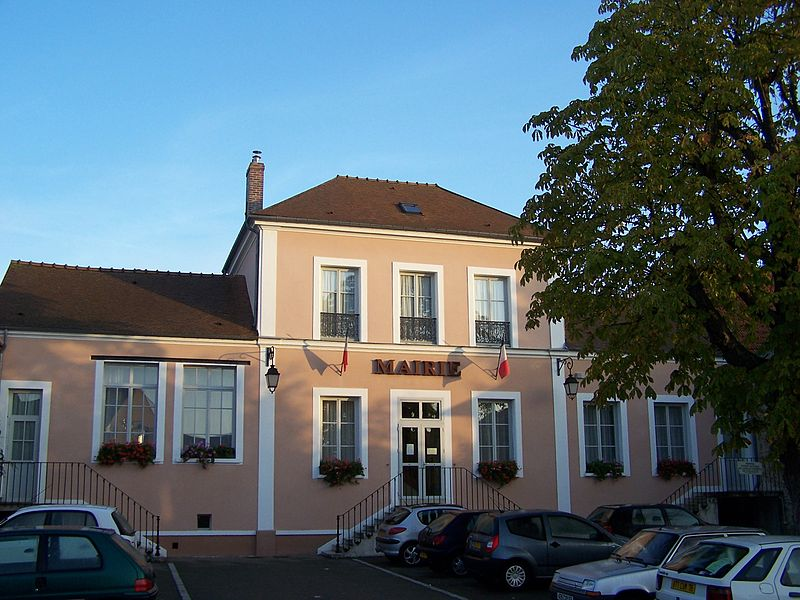
Above: Town Hall, Le Tremblay-sur-Mauldre, Yvelines, France
Maya also modeled for some of his paintings, including Maya with Doll (1938).
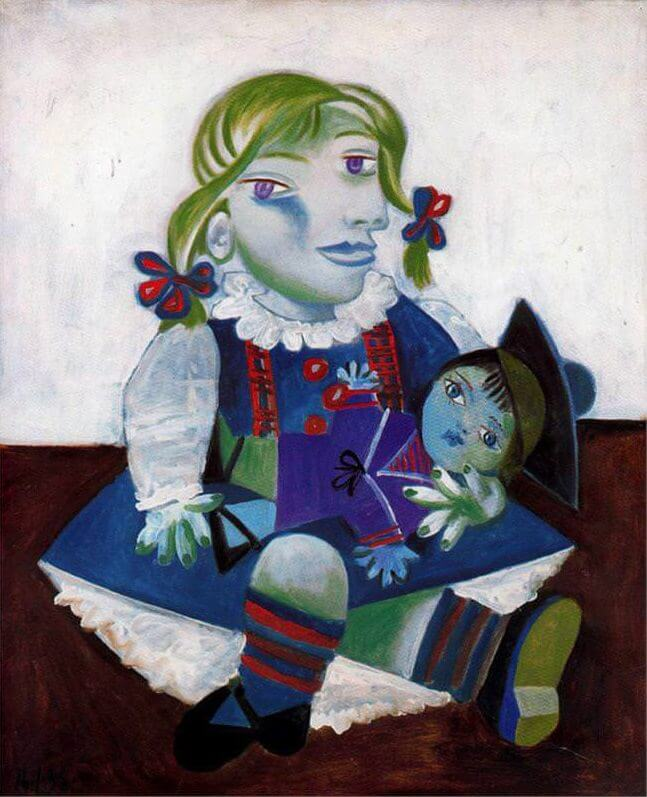
Above: Maya with Doll, Pablo Picasso (1938)
By the time of Maya’s birth, Picasso had already been seeing several other women including Alice Paalen and Valentine Hugo.
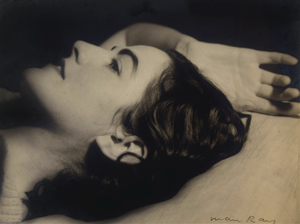
Above: French-born Mexican poet / artist Alice Rahon (1904 – 1987)
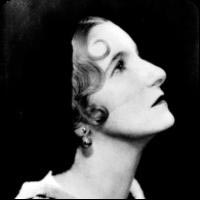
Above: French artist / writer Valentine Hugo (1887 – 1968)
Several months after the birth of Maya, he began a relationship with Dora Maar, a surrealist photographer and model for Picasso, in 1936.
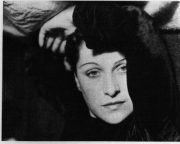
Above: French photographer / painter / poet Dora Maar (1907 – 1997)
He maintained relationships with both women and combined their portraits in the 1937 artwork Girl with a Red Beret and Pompom.
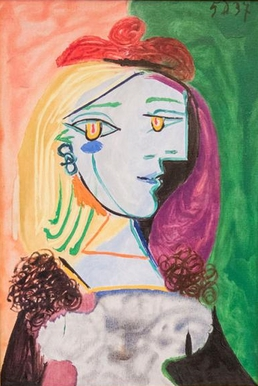
Above: Girl with a Red Beret and Pompom, Pablo Picasso (1937)
Picasso installed Walter, her sister and mother at Villa Gerbier de Jonc in Royan, where he spent time with her on weekends away from Maar.
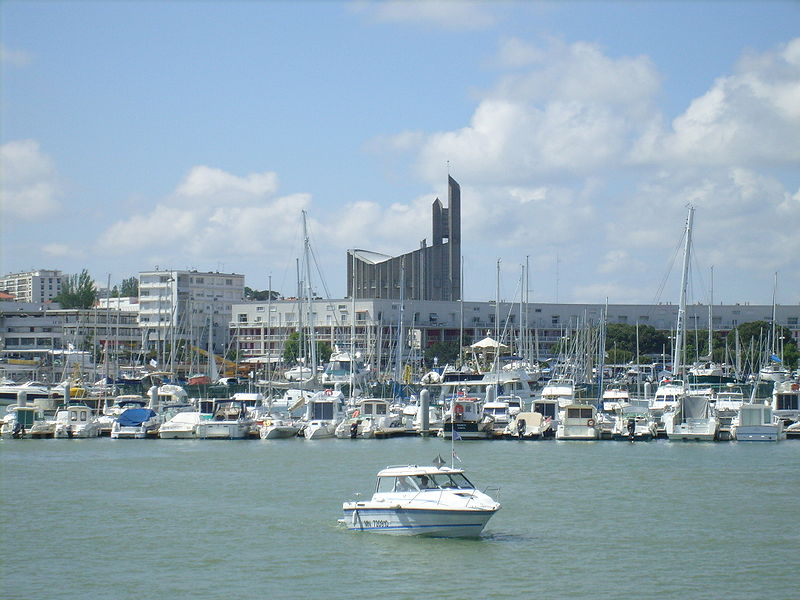
Above: Port, Royan, France
Once, Walter and Maar met accidentally in Picasso’s studio when he was painting Guernica.
Asked about this in later life, Picasso allegedly remarked that he had been quite happy with the situation and that when they demanded that he choose between them, he told them that they would have to fight it out themselves, at which point the two women began to wrestle.
The art historian and friend of Picasso, John Richardson, said this story was not true and both Maar and Picasso told him it never happened.
He said it is more likely that the event is imagined from the pictorial representation of Walter and Maar who appear as if in battle at opposite ends of the composition of Guernica.
His daughter Maya later recalled unexpectedly encountering Maar on a visit to the studio with her mother:
“One day we turned up and she was there, standing next to Guernica.
I started crying and said to my father:
‘I don’t want to see the dribbly lady.’
I was talking about Dora Maar, who licked her lips a lot.
I never saw her again.”
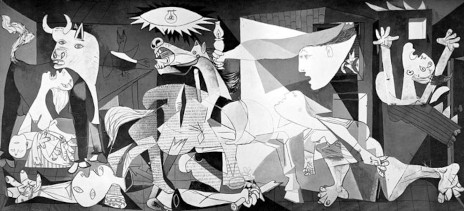
Above: Guernica, Pablo Picasso (1937), Museo Reina Sofia, Madrid
On 4 December 1937, Picasso painted Femme au béret et à la robe quadrillée (Marie-Thérèse Walter), which depicts the fused portraits of Walter and Maar using the angular lines of Cubism and expresses his shifting affection from Walter to his new love, Maar.
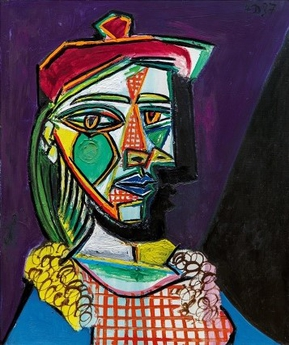
Above: Femme au béret et à la robe quadrillée (Marie-Thérèse Walter), Pablo Picasso (1937)
Walter’s relationship with Picasso ended in 1940.
In September 1939, when World War II was declared, Walter and Maya were in Royan and stayed there until the spring of 1941.
They then moved back to Paris to live in an apartment on Île Saint-Louis.
Walter was now aware of Picasso’s relationship with Maar.
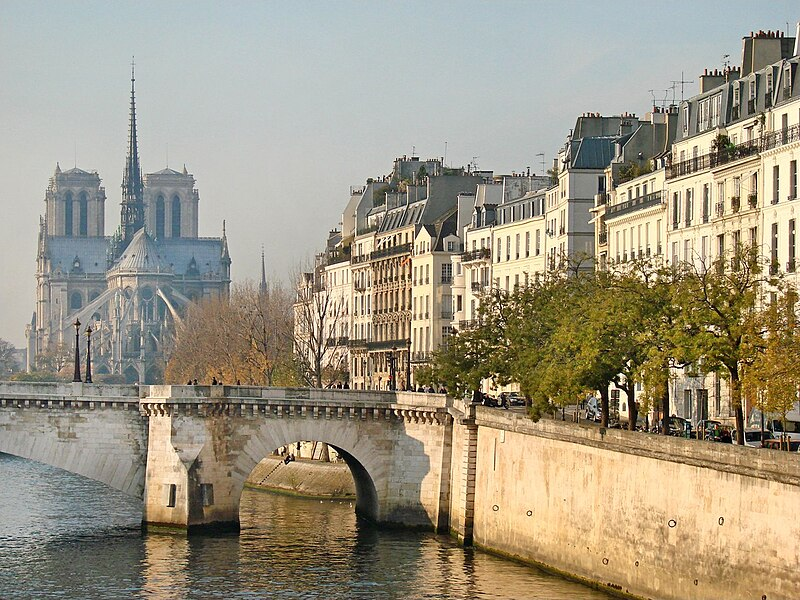
Above: Le quai de Béthune dans l’île St Louis, le pont de la Tournelle et la Seine. Au fond, le chevet de Notre-Dame de Paris.
Françoise Gilot later said that Maya lived with “the fiction that her father worked a long way away“.
Picasso continued to visit Walter and Maya on Thursdays and Sundays for the next ten years.
After the end of World War II, he moved to the South of France with Françoise Gilot.
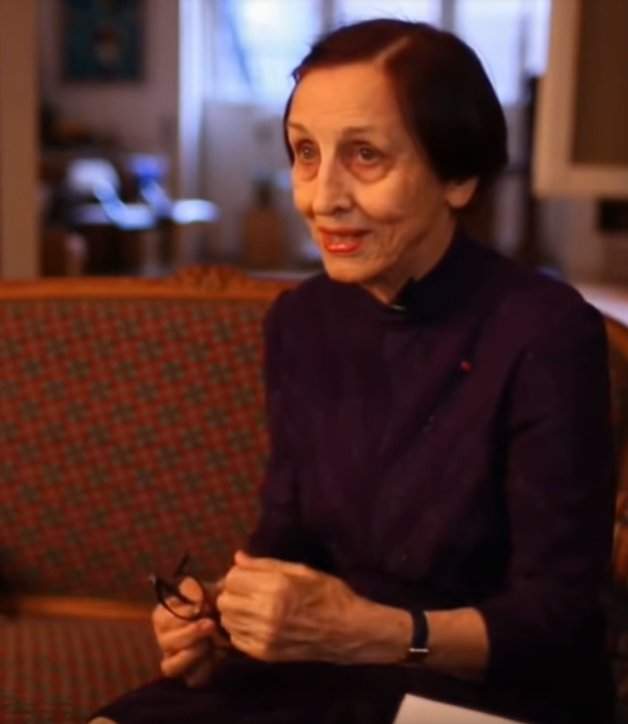
Above: French painter Françoise Gilot (1921 – 2023)
Walter only saw him on occasion but continued to write letters to him for a while.
In 1955, when Khokhlova died, Picasso called Walter by phone and asked her to marry him, but she refused.
Picasso did not see her again and Walter moved to the South of France.
Upon the death of Picasso in 1973, Picasso’s grandson Pablito was prevented from attending his funeral and consequently swallowed a bottle of bleach.
Walter contacted the Minister of Health to arrange for a helicopter to transport him to the American Hospital in Paris.
His brother-in-law, who was an art dealer, took the call and Walter sold him two of Picasso’s paintings to pay for his medical bills.
Marie-Thérèse lived in the vain hope that Picasso would one day marry her.
She hanged herself four years after Picasso’s death.
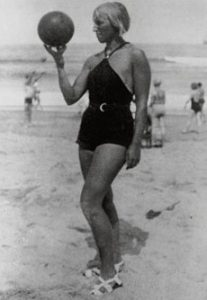
Above: Marie-Thérèse Walter
“When the world would sink under your feet, art shall remain the sole island on which you will stand.”
Eyran Katsenelenbogen
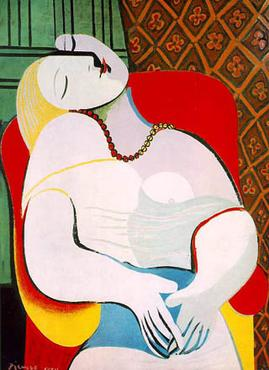
Above: Le Rêve (The dream), Pablo Picasso (1932)
In February 1917, Picasso made his first trip to Italy.
In the period following the upheaval of World War I, Picasso produced work in a neoclassical style.
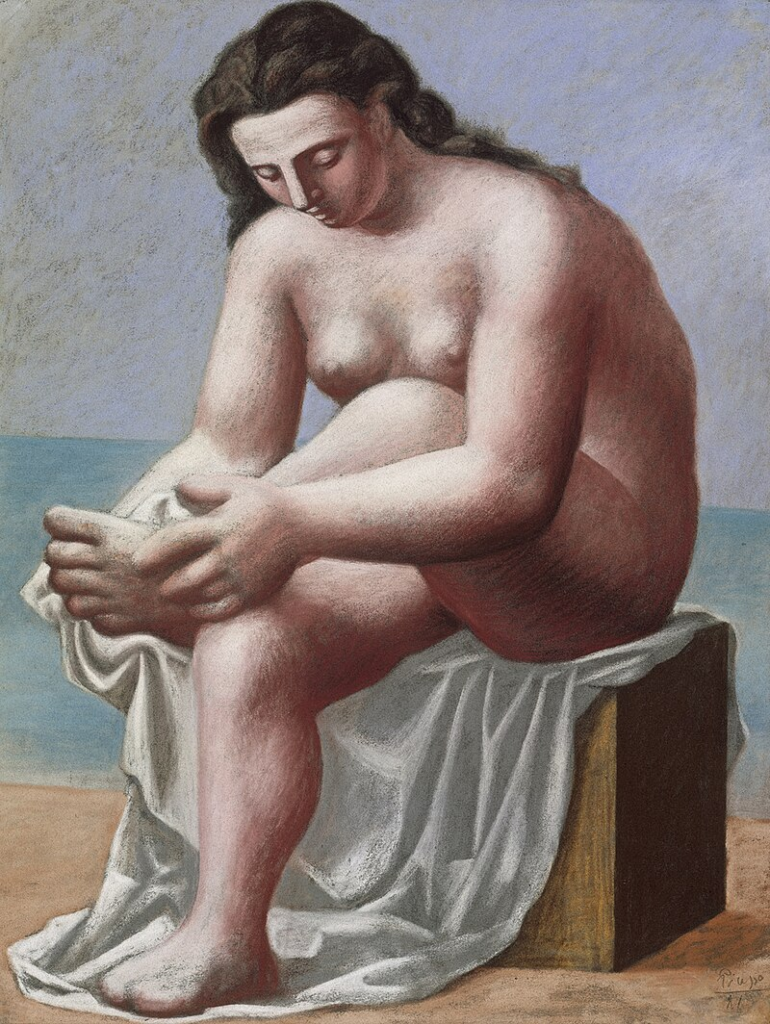
Above: Nu assis s’essuyant le pied (Seated Nude Drying her Foot), Pablo Picasso (1921), Berggruen Museum, Berlin
This “return to order” is evident in the work of many European artists in the 1920s, including André Derain, Giorgio de Chirico, Gino Severini, Jean Metzinger, the artists of the New Objectivity movement and of the Novecento Italiano movement.
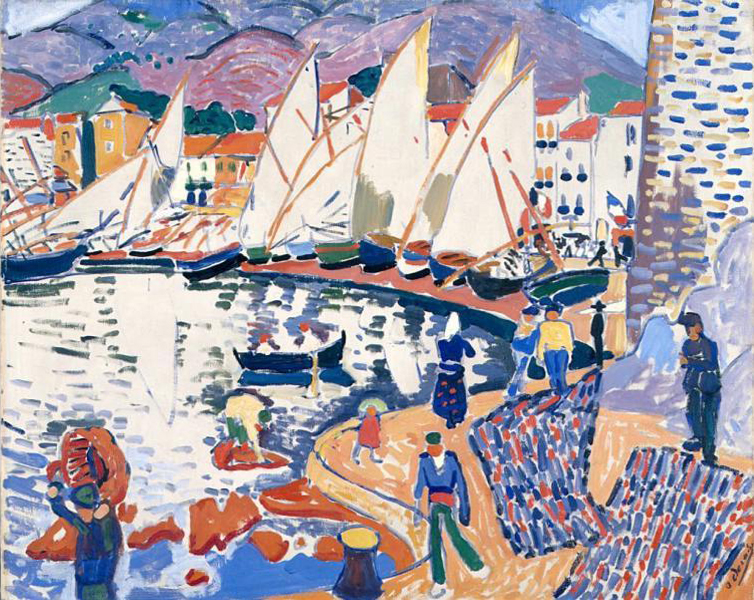
Above: Le séchage des voiles (The Drying Sails), Pablo Picasso (1905), Pushkin Museum, Moscow, Russia
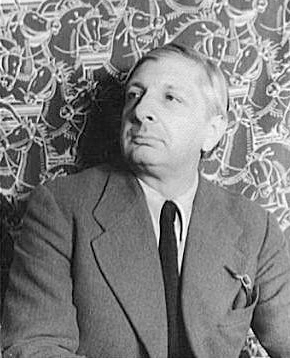
Above: Italian artist Giorgio de Chirico (1888 – 1978)
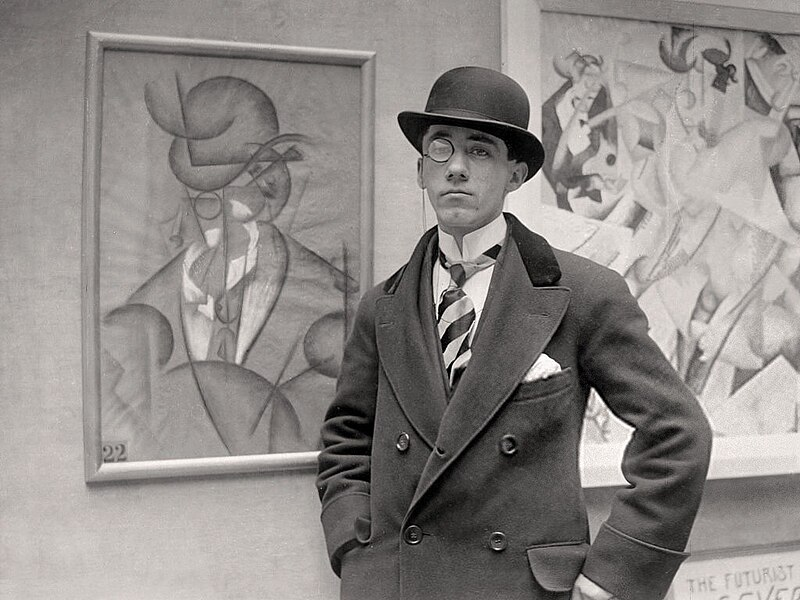
Above: Italian painter Gino Severini (1883 – 1966)
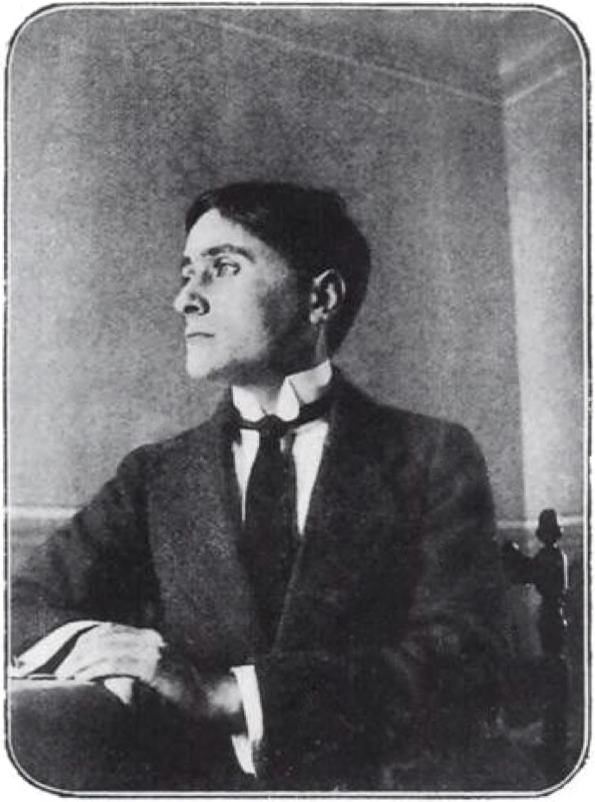
Above: French painter Jean Metzinger (1883 – 1956)
(The New Objectivity (Neue Sachlichkeit) was a movement in German art that arose during the 1920s as a reaction against expressionism.
The term was coined by Gustav Friedrich Hartlaub, the director of the Kunsthalle in Mannheim, who used it as the title of an art exhibition staged in 1925 to showcase artists who were working in a post-expressionist spirit.
As these artists — who included Max Beckmann, Otto Dix, George Grosz, Christian Schad, Rudolf Schlichter and Jeanne Mammen —rejected the self-involvement and romantic longings of the expressionists, Weimar intellectuals in general made a call to arms for public collaboration, engagement, and rejection of romantic idealism.
Although principally describing a tendency in German painting, the term took a life of its own and came to characterize the attitude of public life in Weimar Germany as well as the art, literature, music, and architecture created to adapt to it.
Rather than some goal of philosophical objectivity, it was meant to imply a turn towards practical engagement with the world — an all-business attitude, understood by Germans as intrinsically American.
The movement essentially ended in 1933 with the end of the Weimar Republic and the beginning of the Nazi dictatorship.)
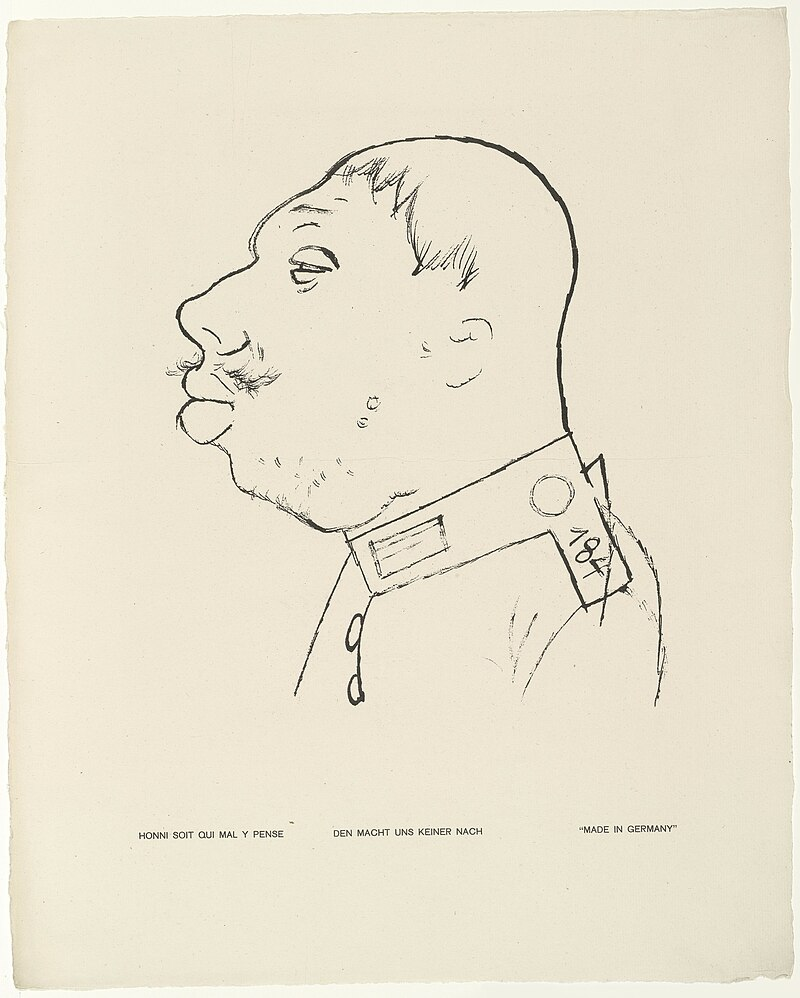
Above: Made in Germany (Den macht uns keiner nach), George Grosz (1919)
(Novecento Italiano (‘Italian 1900s‘) was an Italian artistic movement founded in Milano in 1922 to create an art based on the rhetoric of the fascism of Mussolini.)
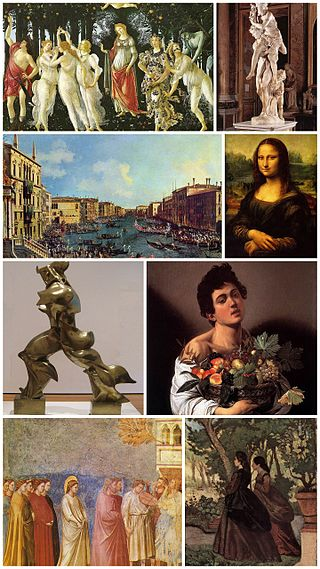
Above: College arte italiana
Picasso’s paintings and drawings from this period frequently recall the work of Raphael and Ingres.
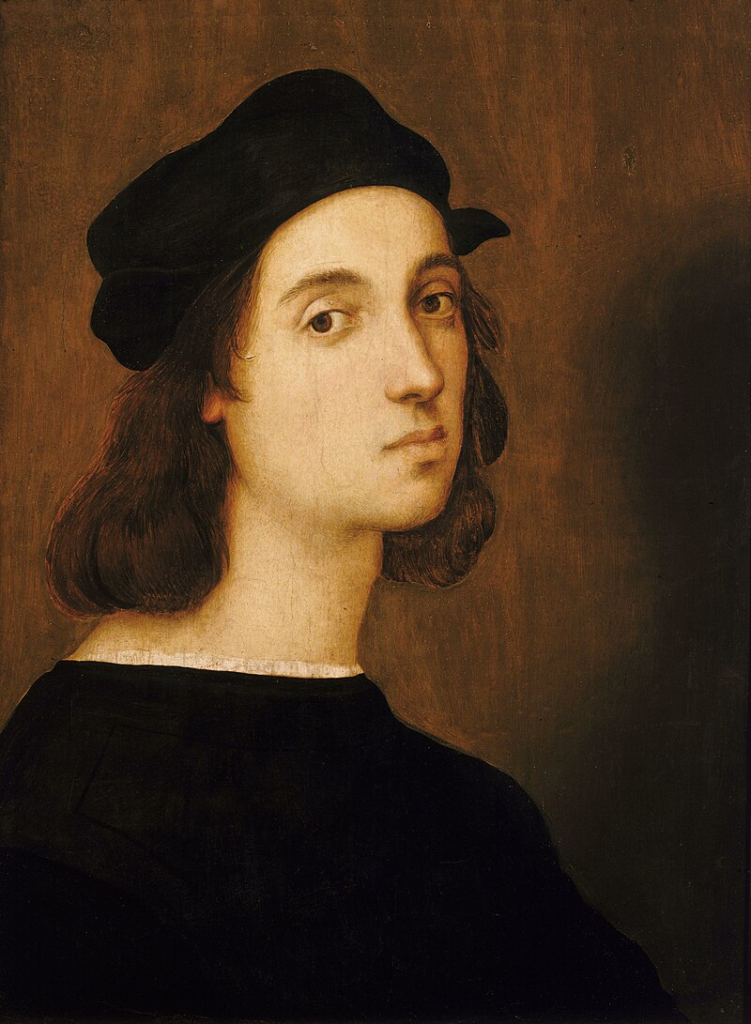
Above: Italian artist Raffaello Sanzio (aka Raphael)(1483 – 1520)
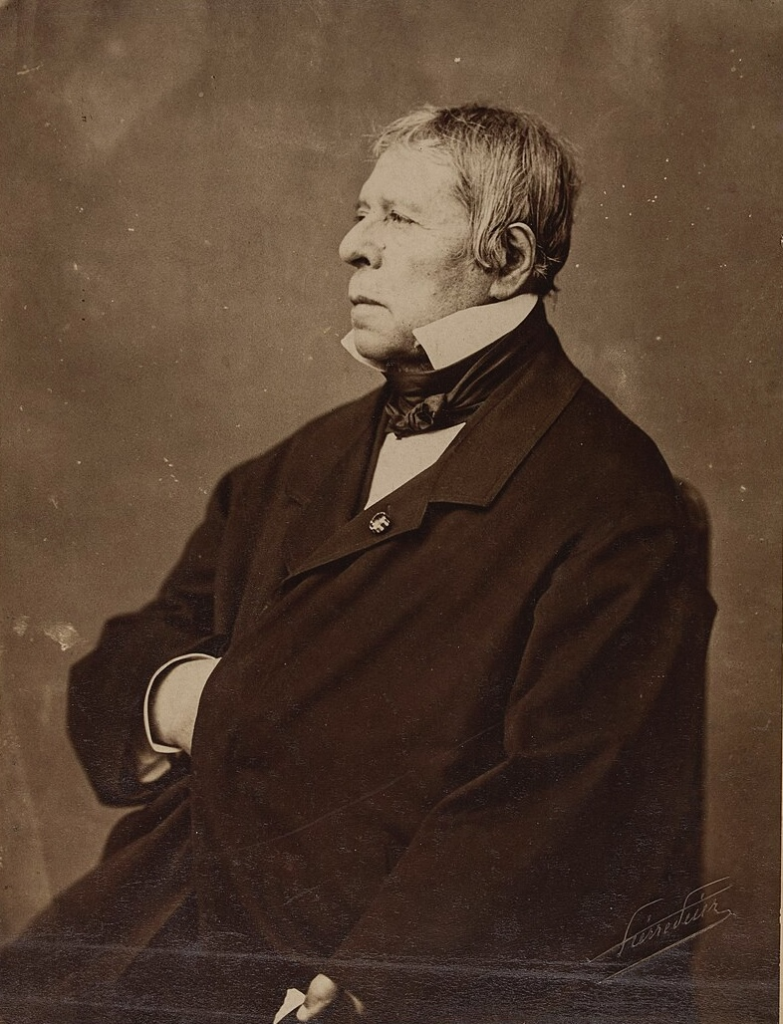
Above: French painter Jean Auguste Dominique Ingres (1780 – 1867)
““We tend to shy away from that grief,” she explains. “But I think that that’s the role of art: to help us into grief, and through grief, for each other, for our values, for the living world.“
Robin Wall Kimmerer
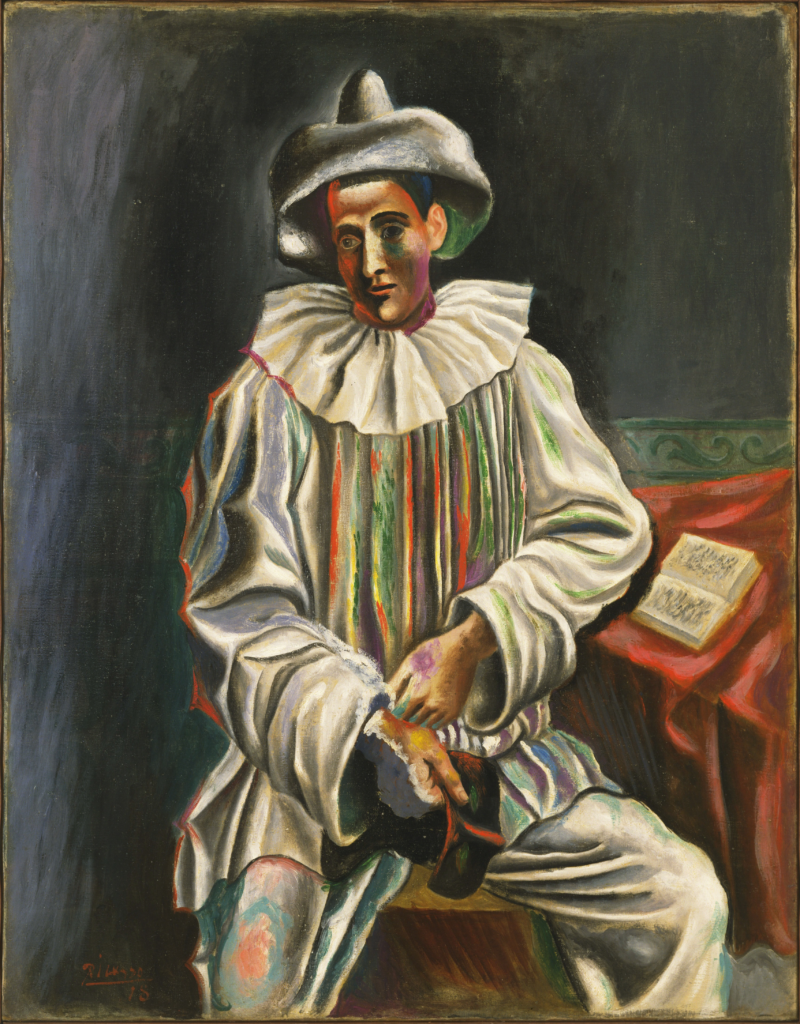
Above: Pierrot, Pablo Picasso (1918), Museum of Modern Art, New York City
In 1925 the Surrealist writer and poet André Breton declared Picasso as ‘one of ours‘ in his article Le Surréalisme et la peinture, published in Révolution surréaliste.
Les Demoiselles was reproduced for the first time in Europe in the same issue.
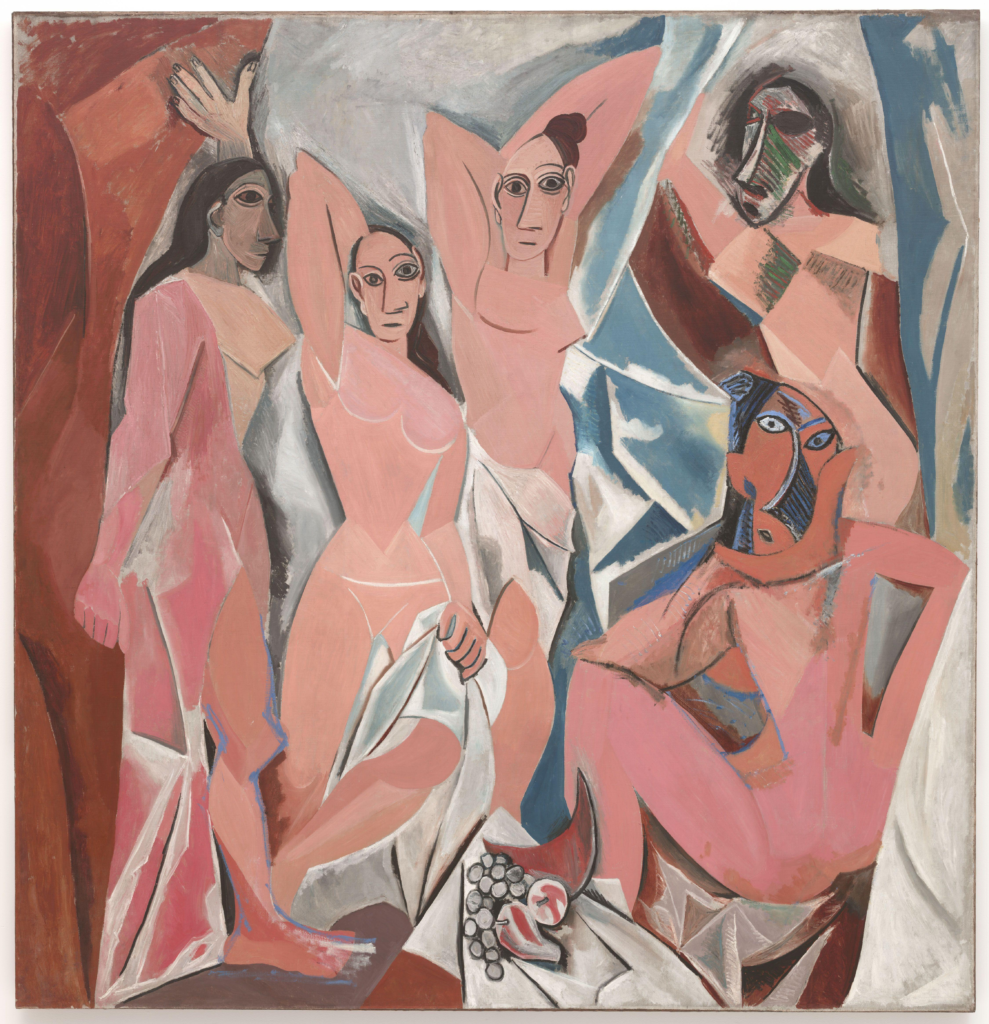
Above: Les Demoiselles d’Avignon, Pablo Picasso (1907)
Yet Picasso exhibited Cubist works at the first Surrealist group exhibition in 1925.
The concept of ‘psychic automatism in its pure state’ defined in the Manifeste du surréalisme never appealed to him entirely.
He did at the time develop new imagery and formal syntax for expressing himself emotionally, “releasing the violence, the psychic fears and the eroticism that had been largely contained or sublimated since 1909“, writes art historian Melissa McQuillan.
Although this transition in Picasso’s work was informed by Cubism for its spatial relations, “the fusion of ritual and abandon in the imagery recalls the primitivism of the Demoiselles and the elusive psychological resonances of his Symbolist work“, writes McQuillan.
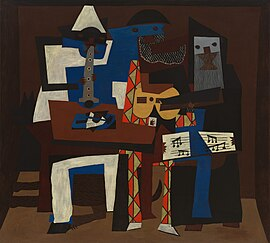
Above: Three Musicians, Pablo Picasso (1921), Museum of Modern Art, New York City
“Three men riding on a bicycle which has only one wheel, I guess that’s surrealist.“
Dong Kingman
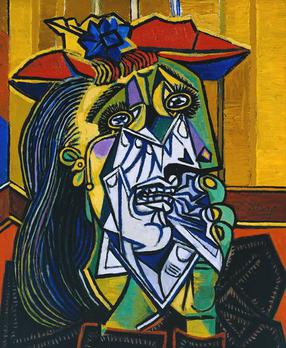
Above: The Weeping Woman, Pablo Picasso (1937), Tate Modern, London, England
Surrealism revived Picasso’s attraction to primitivism and eroticism.
During the 1930s, the minotaur replaced the harlequin as a common motif in his work.
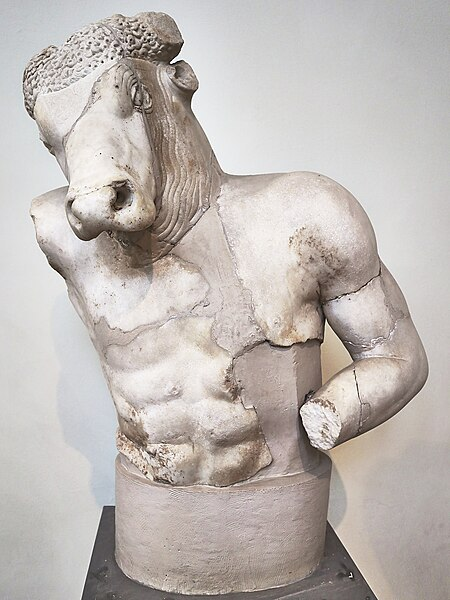
Above: Minotaur statue, National Archaeological Museum, Greece
His use of the minotaur came partly from his contact with the surrealists, who often used it as their symbol, and it appears in Picasso’s Guernica.
The minotaur and Picasso’s mistress Marie-Thérèse Walter are heavily featured in his celebrated Vollard Suite of etchings.
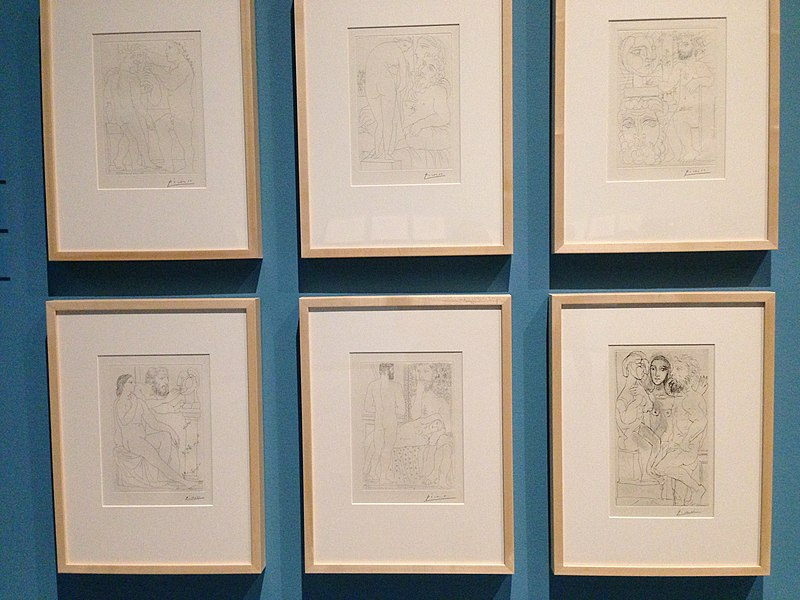
Above: Vollard Suite, in two special exhibitions: Picasso in Canada and Picasso: Man & Beast, Winnipeg Art Gallery, Manitoba
“Most artists are surrealists. … always dreaming something and then they paint it.“
Dong Kingman
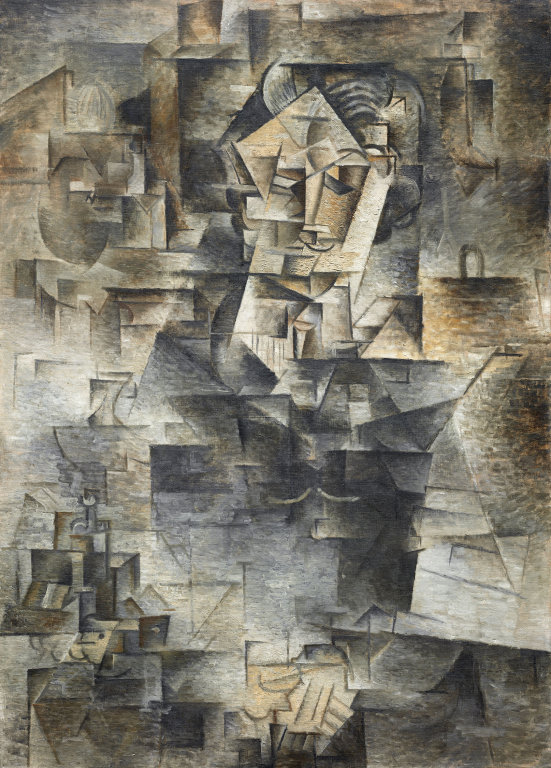
Above: Portrait of Daniel-Henry Kahnweiler, Pablo Picasso (1910), Art Institute of Chicago
Arguably Picasso’s most famous work is his depiction of the German bombing of Guernica during the Spanish Civil War –Guernica.
This large canvas embodies for many the inhumanity, brutality and hopelessness of war.
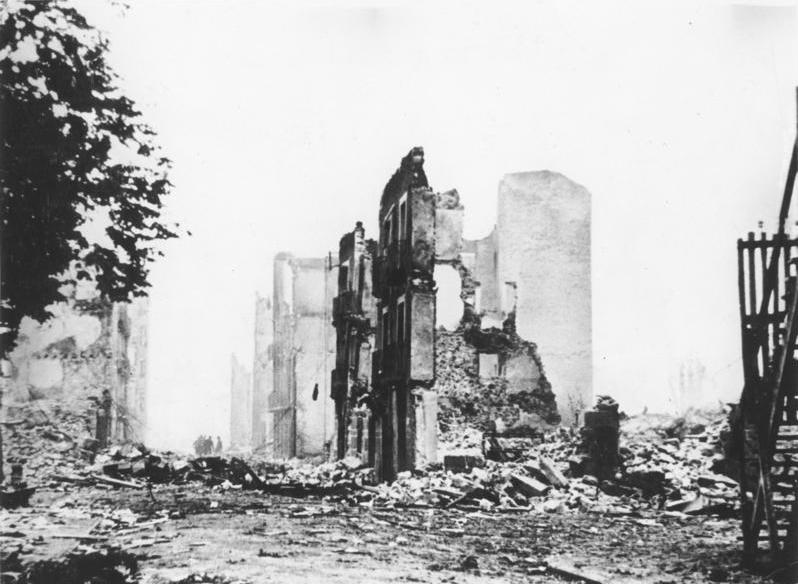
Above: Guernica in ruins, 1937
Asked to explain its symbolism, Picasso said:
“It isn’t up to the painter to define the symbols.
Otherwise it would be better if he wrote them out in so many words!
The public who look at the picture must interpret the symbols as they understand them.“
Guernica was exhibited in July 1937 at the Spanish Pavilion at the Paris International Exposition.
It then became the centrepiece of an exhibition of 118 works by Picasso, Matisse, Braque and Henri Laurens that toured Scandinavia and England.
After the victory of Francisco Franco in Spain, the painting was sent to the United States to raise funds and support for Spanish refugees.
Until 1981 it was entrusted to the Museum of Modern Art (MoMA) in New York City, as it was Picasso’s expressed desire that the painting should not be delivered to Spain until liberty and democracy had been established in the country.
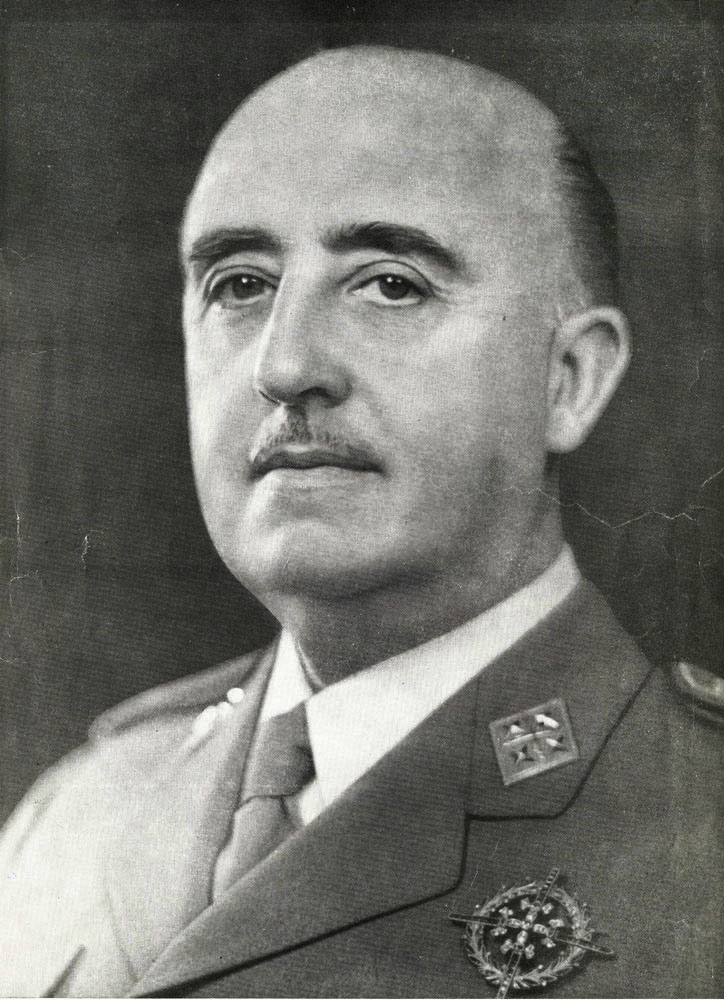
Above: Spanish dictator Francisco Franco (1892 – 1975)
“Art and anti-Fascism are synonymous.“
John Langdon-Davis
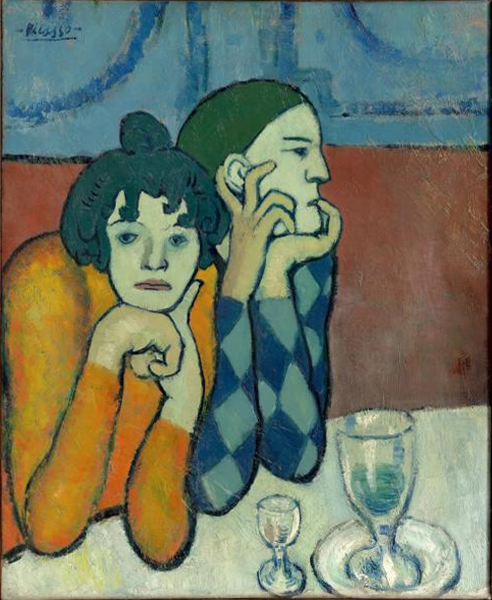
Above: Les deux saltimbanques (Harlequin and his Companion), Pablo Picasso (1910), Pushkin Museum, Moscow, Russia
Before Guernica, Picasso had never addressed political themes in his art.
The politicized nature of the work is largely attributed to his romantic relationship at the time with the French anti-fascist activist and surrealist photographer, Dora Maar.
In addition, her black and white photographs are likely to have influenced the black and white scheme of Guernica, in stark contrast to Picasso’s usual colorful paintings.
“Maar’s practice of photography influenced the art of Picasso – she had a great influence on his work,” said Antoine Romand, a Dora Maar expert.
“She contested him.
She pushed him to do something new and to be more creative politically.”
Maar had exclusive access to Picasso’s studio to observe and photograph the creation of Guernica.
At Picasso’s request, Maar painted parts of the dying horse.
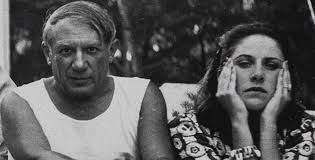
Above: Pablo Picasso and Dora Maar
“Every vital social movement immediately begins to generate art – songs, poetry, posters, murals, novels – an outpouring of the creativity that people will create from even the smallest crumbs of hope.”
Aurora Levins Morales
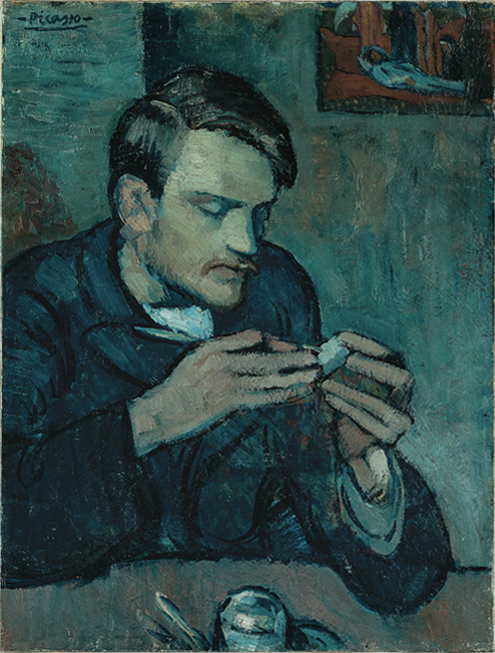
Above: Portrait de Mateu Fernández de Soto, Pablo Picasso (1901), Bundesmuseen, Wien (Vienna)
In 1939 and 1940, the Museum of Modern Art in New York City, under its director Alfred Barr, a Picasso enthusiast, held a major retrospective of Picasso’s principal works until that time.
This exhibition lionized Picasso, brought into full public view in America the scope of his artistry, and resulted in a reinterpretation of his work by contemporary art historians and scholars.
According to Jonathan Weinberg:
“Given the extraordinary quality of the show and Picasso’s enormous prestige, generally heightened by the political impact of Guernica, the critics were surprisingly ambivalent.”
Picasso’s “multiplicity of styles” was disturbing to one journalist; another described him as “wayward and even malicious“.
Alfred Frankenstein’s review in ARTnews concluded that Picasso was both charlatan and genius.
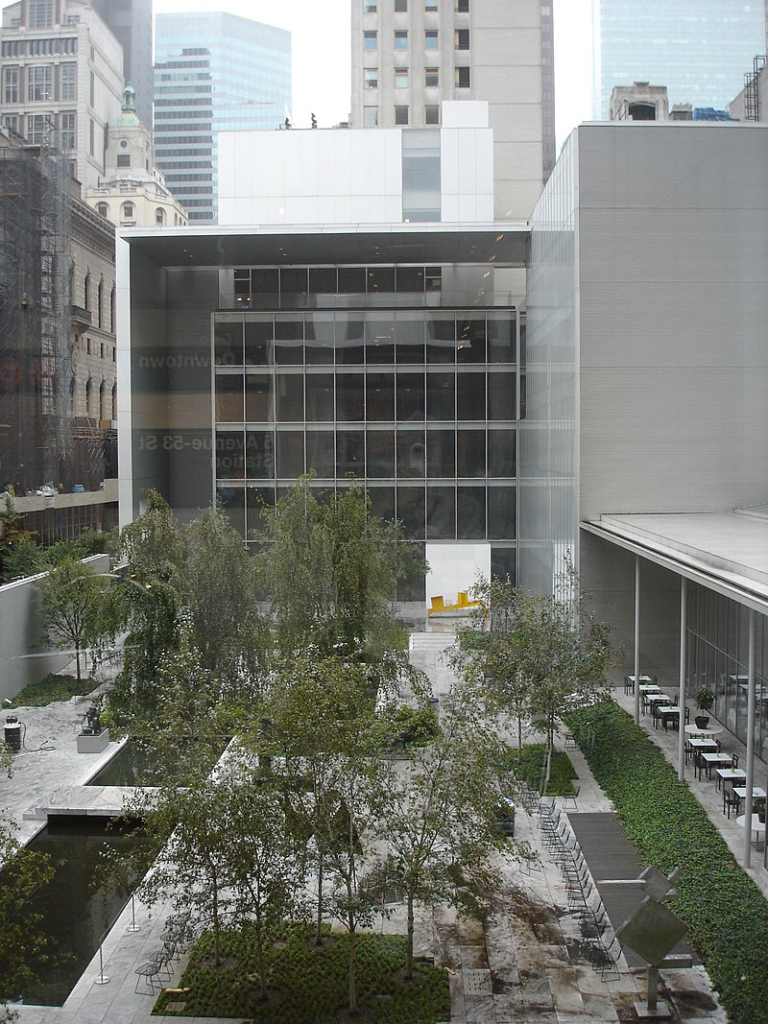
Above: Museum of Modern Art, New York City
“Creation always involves building upon something else. There is no art that doesn’t reuse.
And there will be less art if every reuse is taxed by the appropriator.“
Lawrence Lessig
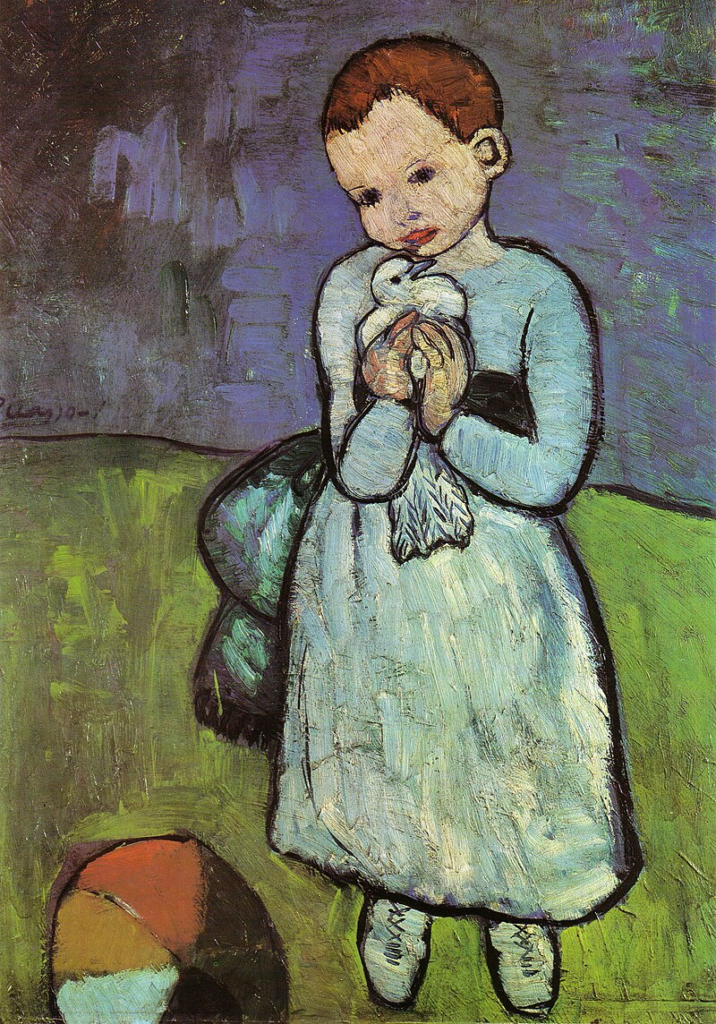
Above: Child with a Dove, Pablo Picasso (1901), Qatar Museums Authorities
During World War II, Picasso remained in Paris while the Germans occupied the city.
Picasso’s artistic style did not fit the Nazi ideal of art, so he did not exhibit during this time.
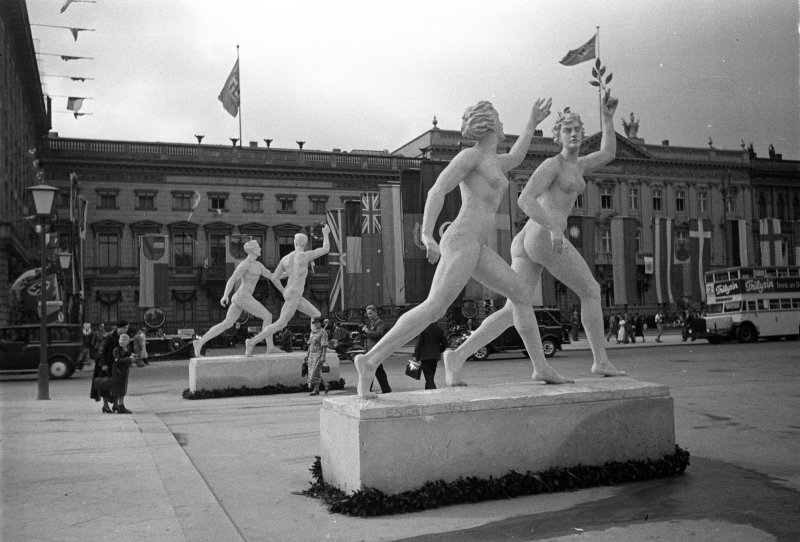
Above: Nude statues of the ideal female and male bodies, installed in the streets of Berlin on the occasion of the 1936 Summer Olympics. Berlin won the bid in April 1931, two years before the NSDAP (Nazis) came to power. It was the last time ever that the International Olympic Committee (IOC) gathered to vote in a city bidding as the host.
He was often harassed by the Gestapo.
During one search of his apartment, an officer saw a photograph of the painting Guernica.
“Did you do that?“, the German asked Picasso.
“No,” he replied, “You did.“

Above: Reichsadler (symbol of the Geheimne Staatspolizei)(aka the Gestapo) (Secret State Police)
“The artist is not the transcriber of the world.
He is its rival.“
André Malraux
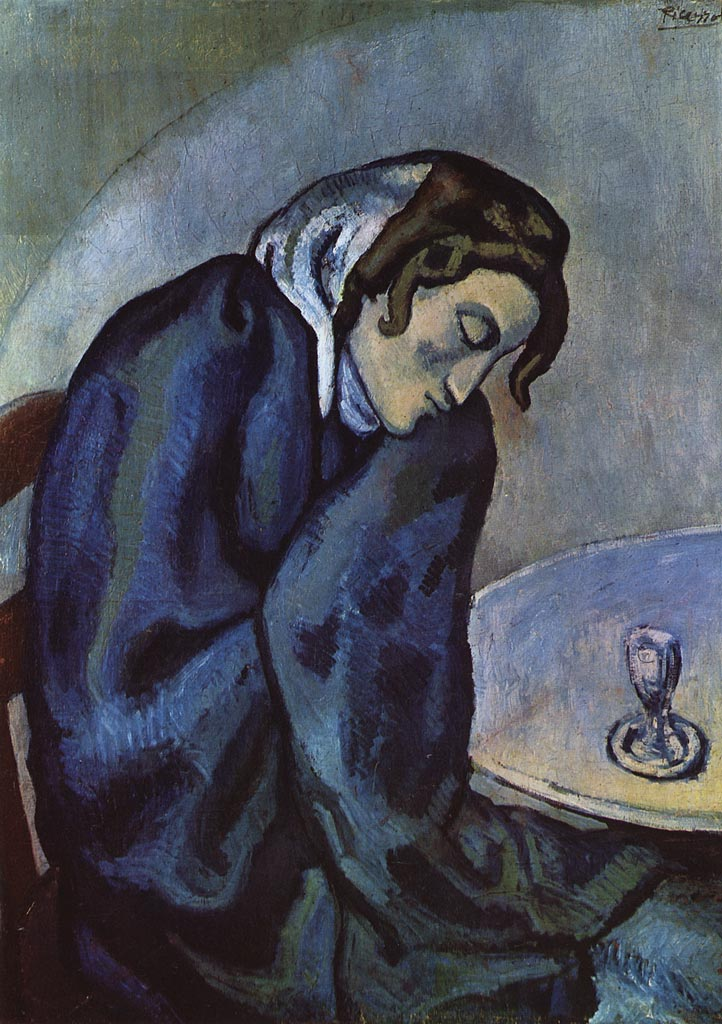
Above: La buveuse assoupie (The Absinthe drinker), Pablo Picasso (1902), Kunstmuseum, Basel, Switzerland
Retreating to his studio, he continued to paint, producing works such as the Still Life with Guitar (1942) and The Charnel House (1948).
Although the Germans outlawed bronze casting in Paris, Picasso continued regardless, using bronze smuggled to him by the French Resistance.
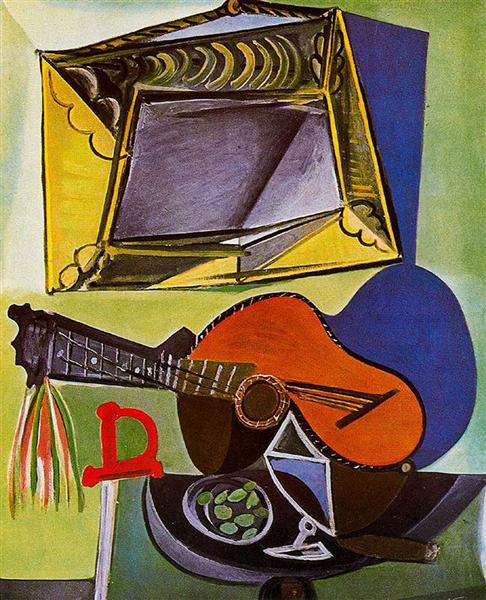
Above: Still Life with Guitar, Pablo Picasso (1942)
“Art can speak its own language only as long as the images are alive which refuse and refute the established order.“
Herbert Marcuse
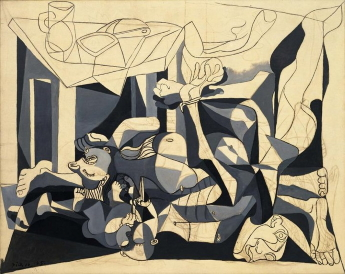
Above: The Charnel House, Pablo Picasso (1945), Museum of Modern Art, New York City
Around this time, Picasso wrote poetry as an alternative outlet.
Between 1935 and 1959 he wrote more than 300 poems.
Largely untitled except for a date and sometimes the location of where they were written (for example “Paris 16 May 1936“), these works were gustatory, erotic, and at times scatological, as were his full-length plays, Desire Caught by the Tail (1941), The Four Little Girls (1949) and The Burial of the Count of Orgaz (1959).
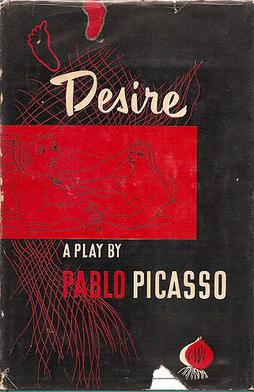
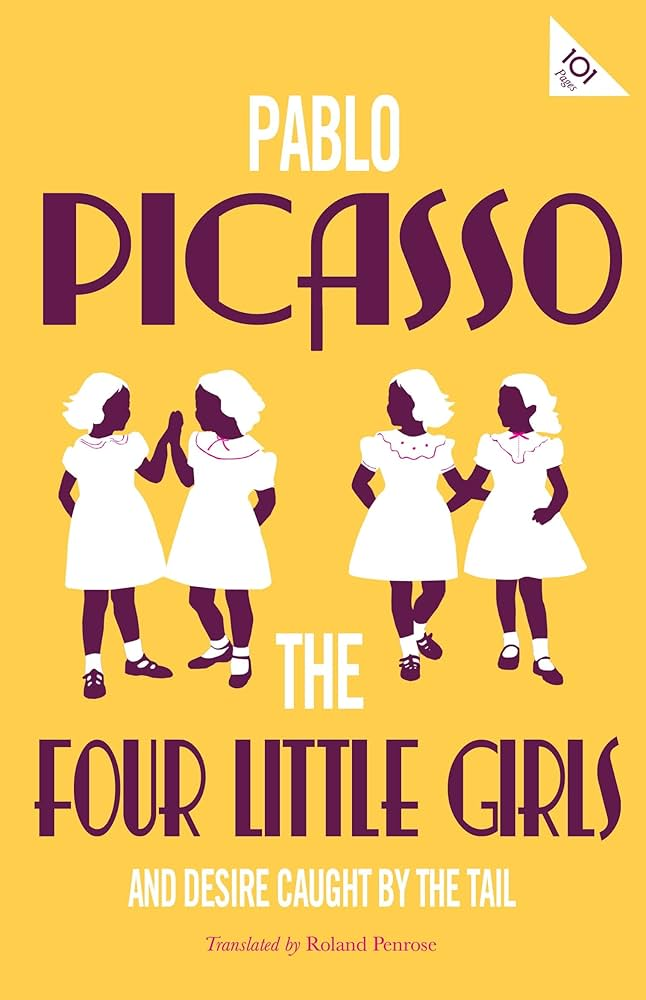
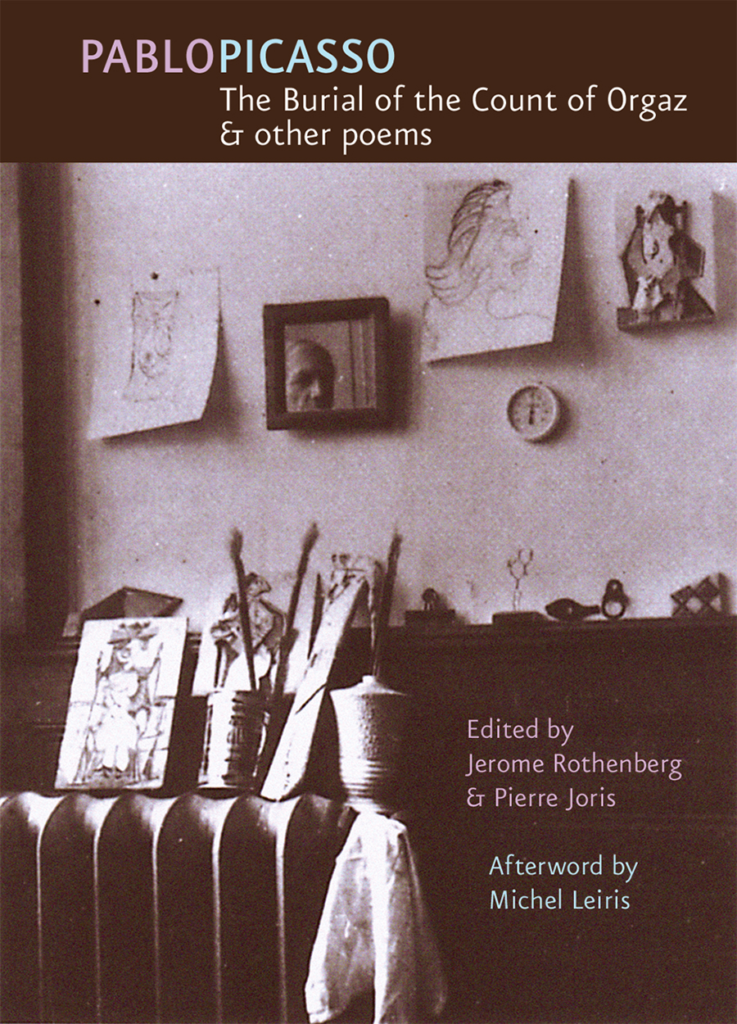
“We all know that Art is not truth.
Art is a lie that makes us realize truth, at least the truth that is given us to understand.
The artist must know the manner whereby to convince others of the truthfulness of his lies.
If he only shows in his work that he has searched, and re-searched, for the way to put over lies, he would never accomplish anything.“
Pablo Picasso
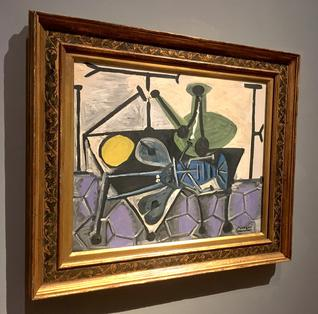
Above: Nature Morte au Poron (Still life with porrón), Welsh National Museum of Art, Cardiff, Wales
In 1944, after the liberation of Paris, Picasso, then 63 years old, began a romantic relationship with a young art student named Françoise Gilot.
She was 40 years younger than he was.
Picasso grew tired of his mistress Dora Maar.
Picasso and Gilot began to live together.
Eventually, they had two children:
Claude Picasso, born in 1947, and Paloma Picasso, born in 1949.
In her 1964 book Life with Picasso, Gilot describes his abusive treatment and myriad infidelities which led her to leave him, taking the children with her.
This was a severe blow to Picasso.
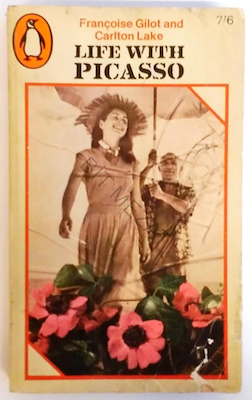
“It is my misfortune – and probably my delight – to use things as my passions tell me.
What a miserable fate for a painter who adores blondes to have to stop himself putting them into a picture because they don’t go with the basket of fruit!“
Pablo Picasso
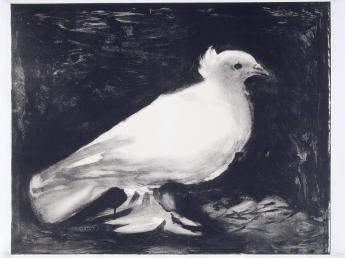
Above: Dove, Pablo Picasso (1949)
Picasso had affairs with women of an even greater age disparity than his and Gilot’s.
While still involved with Gilot, in 1951 Picasso had a six-week affair with Geneviève Laporte, who was four years younger than Gilot.
By his 70s, many paintings, ink drawings and prints have as their theme an old, grotesque dwarf as the doting lover of a beautiful young model.
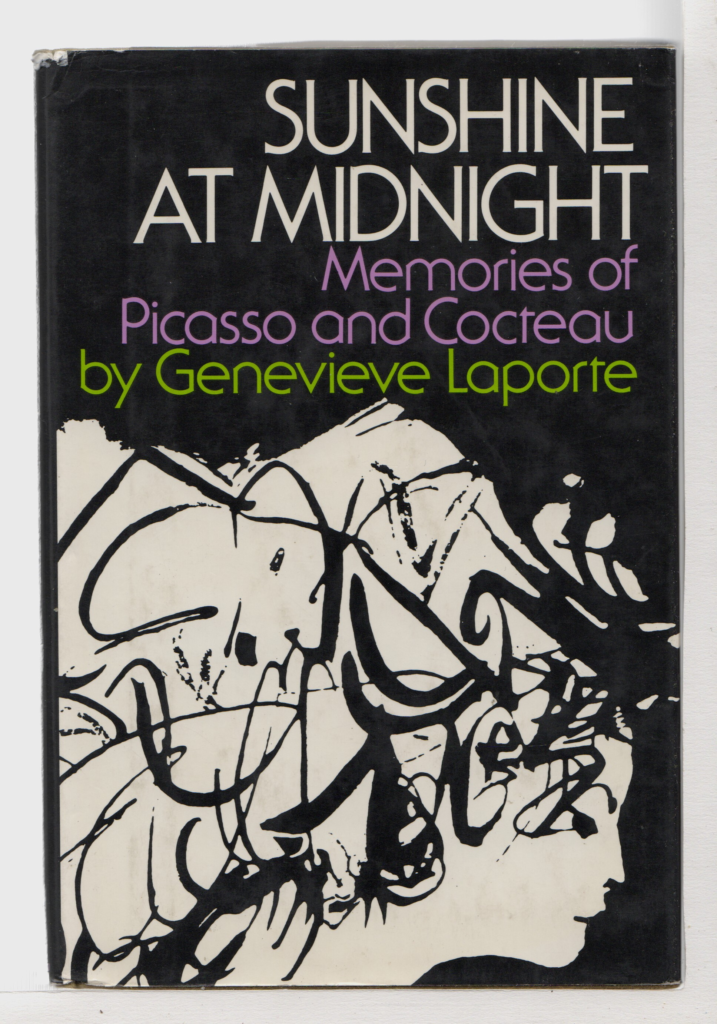
“It is not what the artist does that counts.
But what he is.
Cézanne would never have interested me if he had lived and thought like Jacques-Emile Blanche, even if the apple he had painted had been ten times more beautiful.
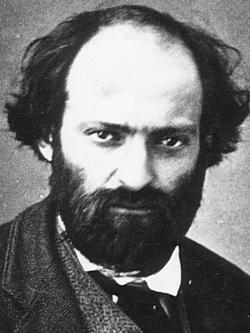
Above: French artist Paul Cézanne (1839 – 1906)
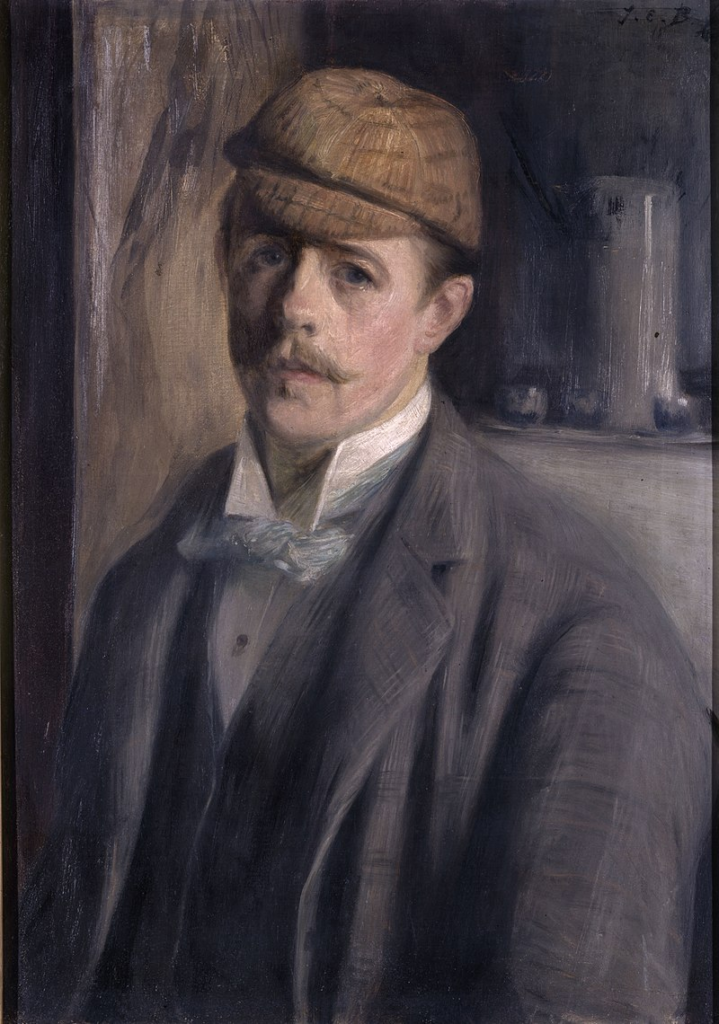
Above: Self-portrait (1890), Jacques-Émile Blanche (1861 – 1942)
What interests us is the anxiety of Cézanne, the teaching of Cézanne, the anguish of Van Gogh, in short the inner drama of the man.
The rest is false.“
Pablo Picasso
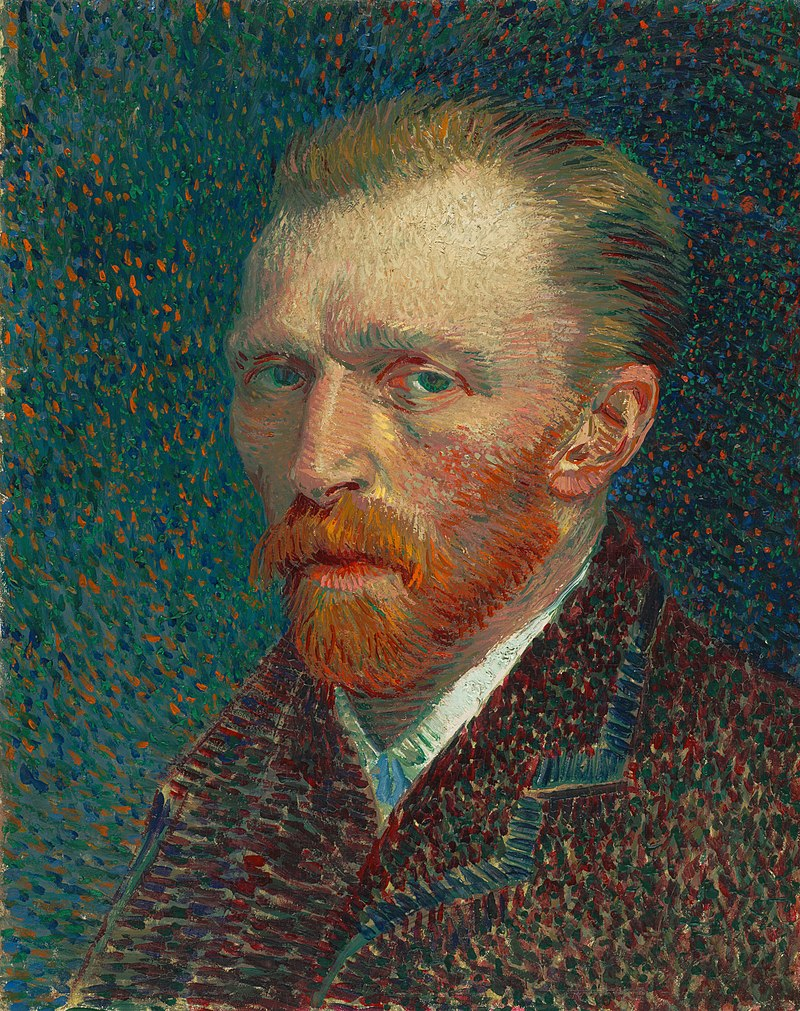
Above: Self-portrait (1887), Vincent van Gogh (1853 – 1890)
Jacqueline Roque (1927 – 1986) worked at the Madoura Pottery in Vallauris on the French Riviera, where Picasso made and painted ceramics.
She became his lover, and then his second wife in 1961.
The two were together for the remainder of Picasso’s life.
His marriage to Roque was also a means of revenge against Gilot.
With Picasso’s encouragement, Gilot had divorced her then-husband, Luc Simon, with the plan to marry Picasso to secure the rights of her children as Picasso’s legitimate heirs.
Picasso had already secretly married Roque, after Gilot had filed for divorce.
His strained relationship with Claude and Paloma was never healed.
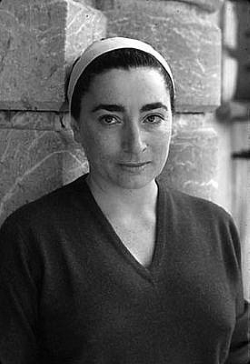
Above: Jacqueline Picasso (née Jacqueline Roque)(1927 – 1986)
“Everyone wants to understand painting.
Why don’t they try to understand the song of the birds?
Why do they love a night, a flower, everything which surrounds man, without attempting to understand them?
Whereas where painting is concerned, they want to understand.
Let them understand above all that the artist works from necessity, that he, too, is a minute element of the world to whom one should ascribe no more importance than so many things in nature which charm us but which we do not explain to ourselves.
Those who attempt to explain a picture are on the wrong track most of the time.
Gertrude Stein, overjoyed, told me some time ago that she had finally understood what my picture represented:
Three musicians.
It was a still life!!“
Pablo Picasso
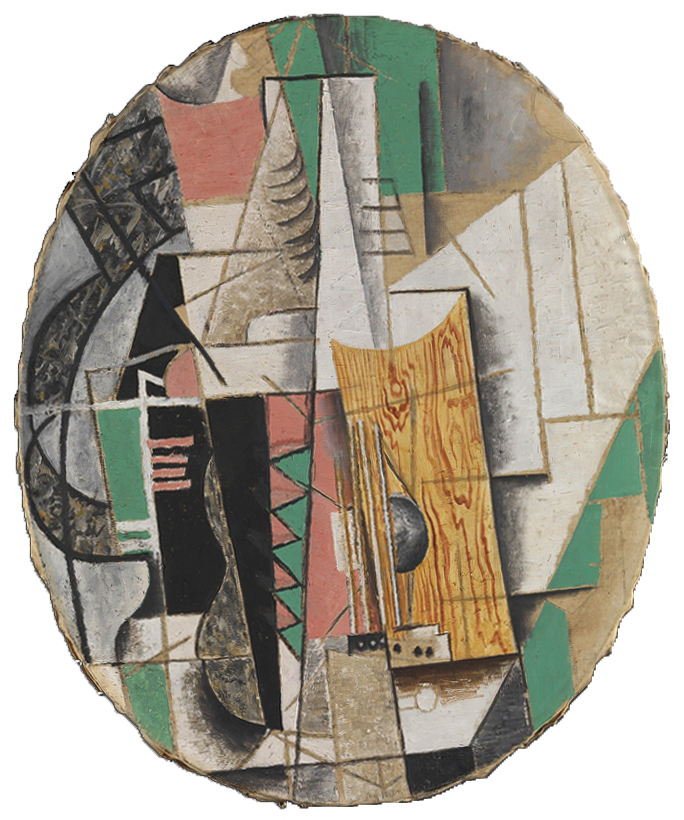
Above: Guitare (Guitar), Pablo Picasso (1913), National Museum of Art, Architecture and Design, Oslo, Norway
By this time, Picasso had constructed a huge Gothic home, and could afford large villas in the south of France, such as Mas Notre-Dame-de-Vie on the outskirts of Mougins, and in the Provence-Alpes-Côte d’Azur.
He was an international celebrity, with often as much interest in his personal life as his art.
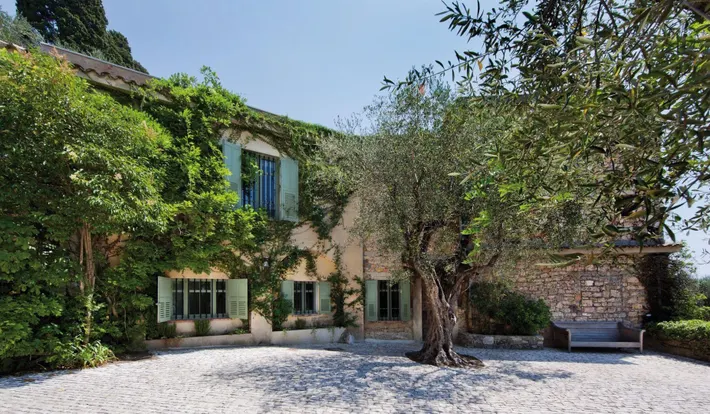
Above: Picasso Home, Notre Dame de Vie, France
“How can you expect a beholder to experience my picture as I experienced it?
A picture comes to me a long time beforehand.
Who knows how long a time beforehand, I sensed, saw, and painted it and yet the next day even I do not understand what I have done.
How can anyone penetrate my dreams, my instincts, my desires, my thought, which have taken a long time to fashion themselves and come to the surface, above all to grasp what I put there, perhaps involuntary.”
Pablo Picasso
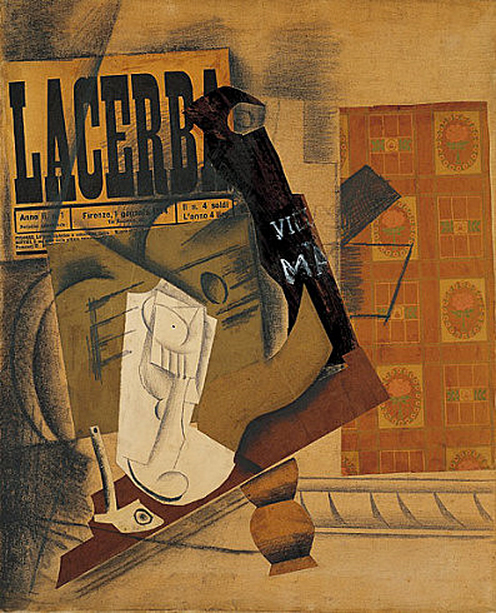
Above: Pipe, verre, bouteille de Vieux Marc (Pipe, Glass, Bottle of Vieux Marc), Pablo Picasso (1914), Peggy Guggenheim Collection, Venezia (Venice), Italia
Picasso was one of 250 sculptors who exhibited in the 3rd Sculpture International held at the Philadelphia Museum of Art in mid-1949.
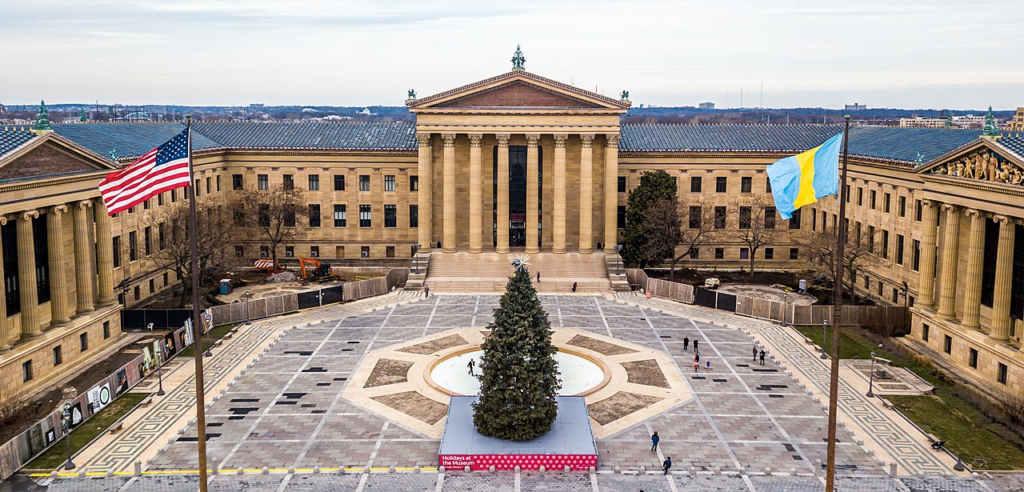
Above: Philadelphia Museum of Art
In the 1950s, Picasso’s style changed once again, as he took to producing reinterpretations of the art of the great masters.
He made a series of works based on Velázquez’s painting of Las Meninas.
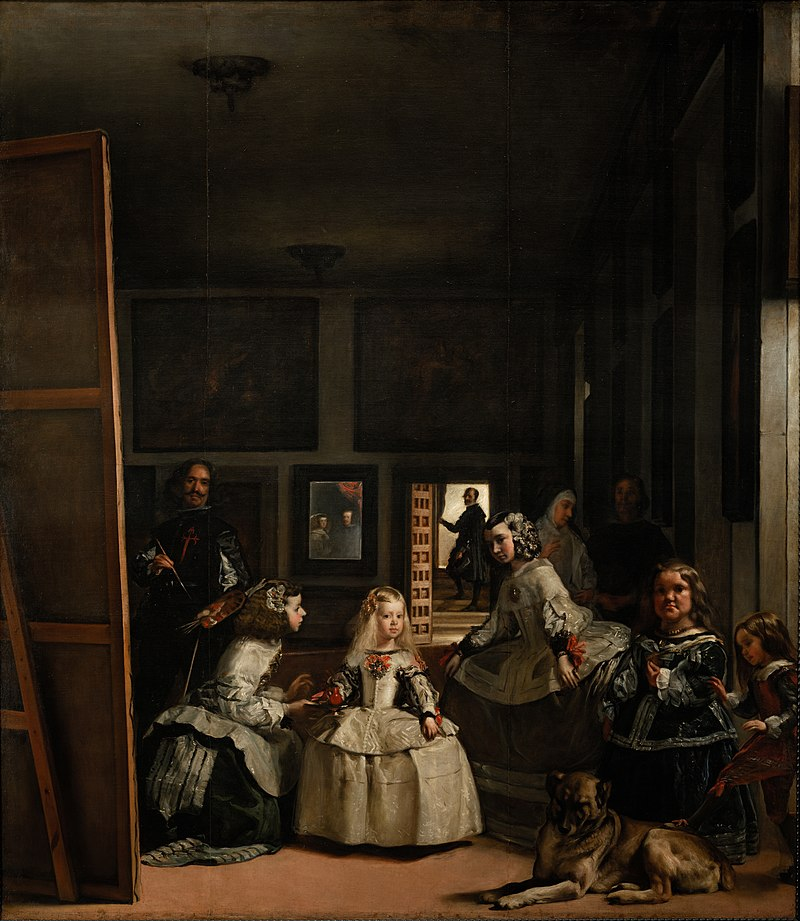
Above: Las Meninas, Diego Velázquez (1656), Museo del Prado, Madrid
He also based paintings on works by Goya, Poussin, Manet, Courbet and Delacroix.
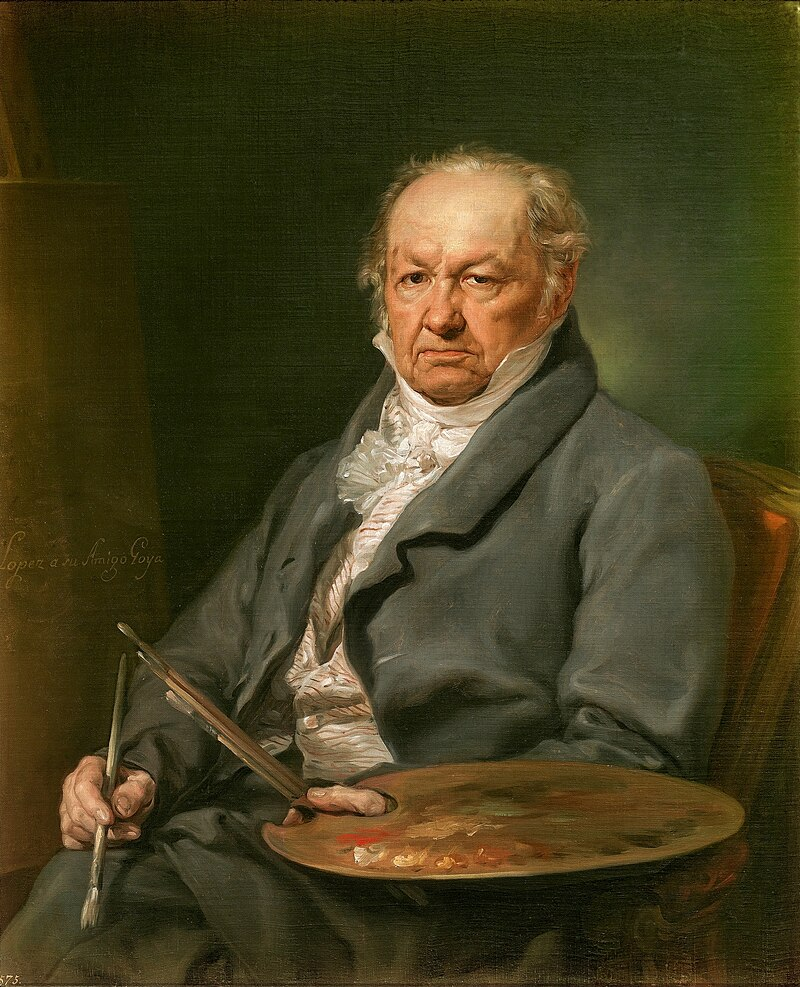
Above: Spanish artist Francisco de Goya (1746 – 1828)
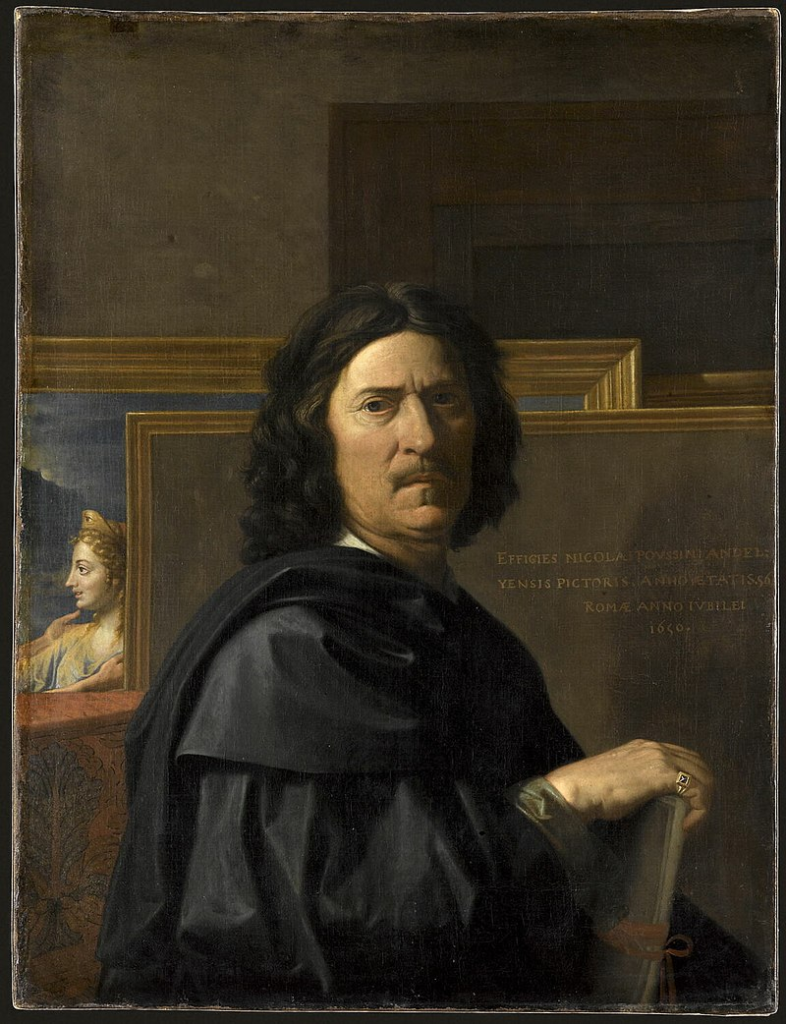
Above: French painter Nicholas Poussin (1594 – 1665)
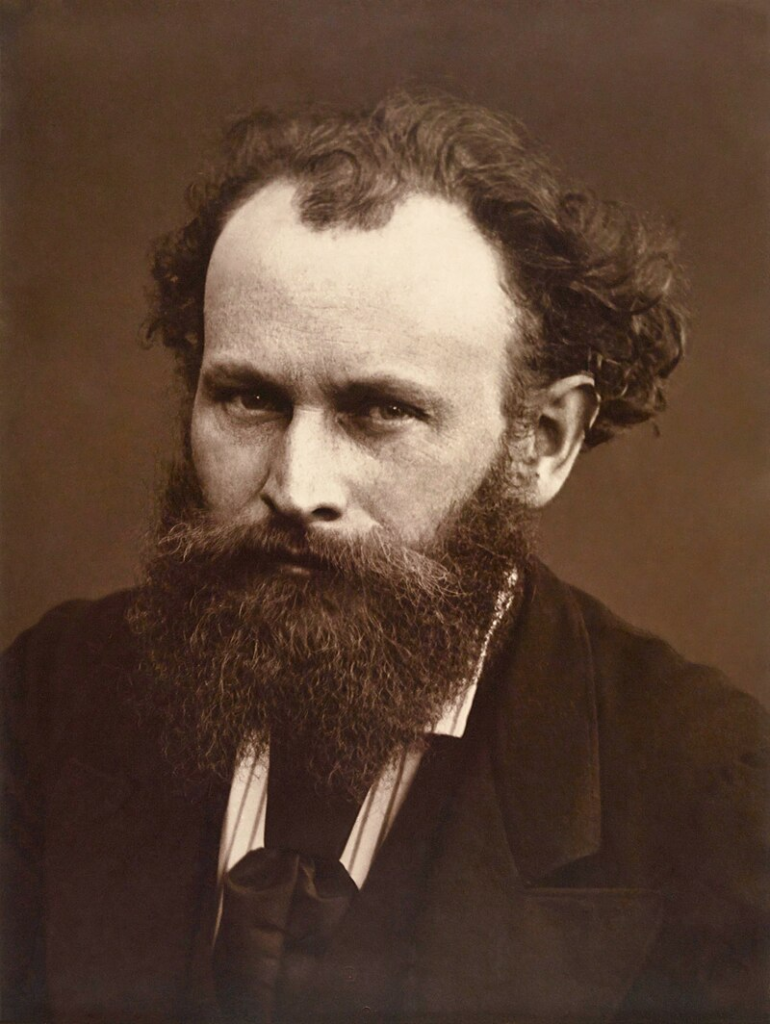
Above: French painter Édouard Manet (1832 – 1883)
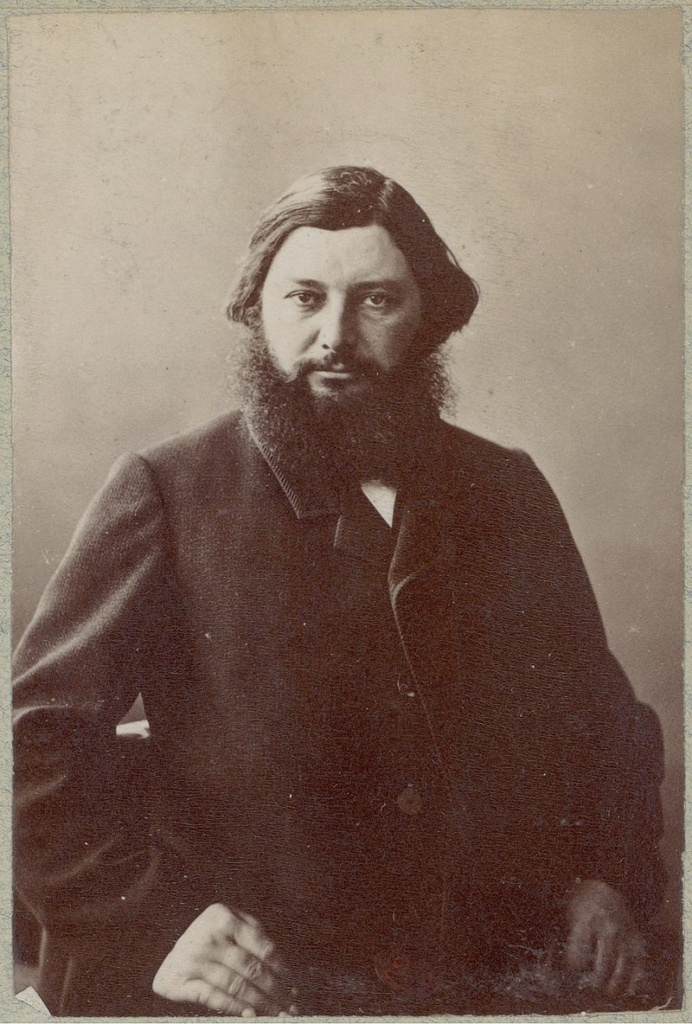
Above: French painter Gustave Courbet (1819 – 1877)
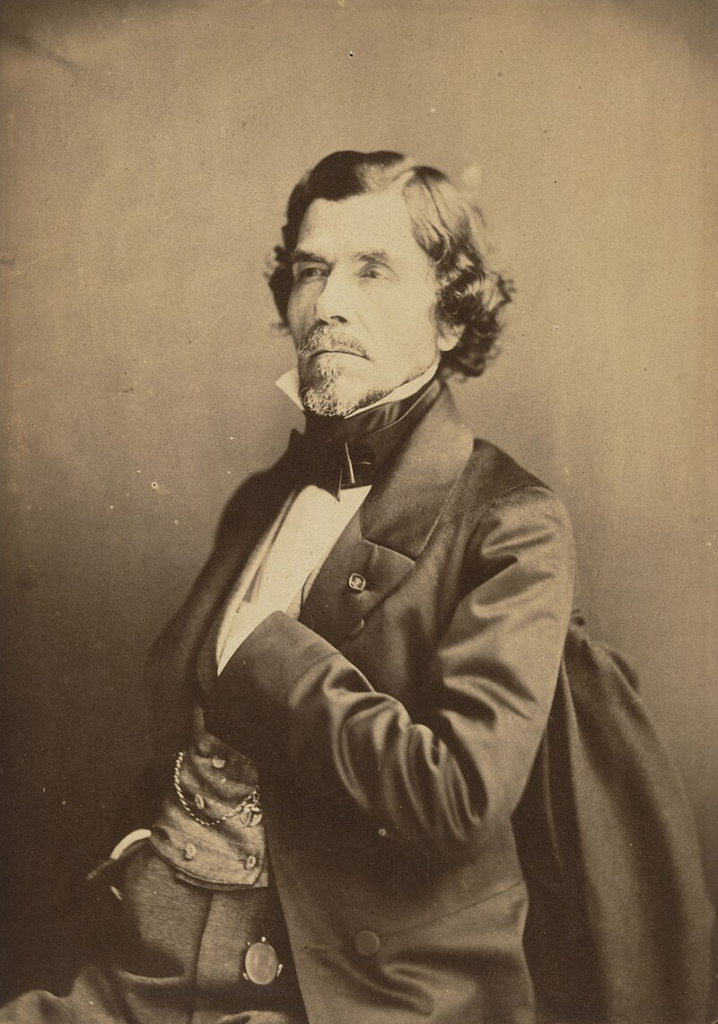
Above: French painter Eugène Delacroix (1798 – 1863)
“The painter goes through states of fullness and evacuation.
That is the whole secret of art.
I go for a walk in the forest of Fontainebleau.
I get ‘green’ indigestion.
I must get rid of this sensation into a picture.
Green rules it.
A painter paints to unload himself of feelings and visions.
People seize on painting to cover up their nakedness.
They get what they can wherever they can.
In the end I don’t believe they get anything at all.
They’ve simply cut a coat to the measure of their own ignorance.
They make everything, from God to a picture, in their own image.
That is why the picture hook is the ruination of a painting.“
Pablo Picasso
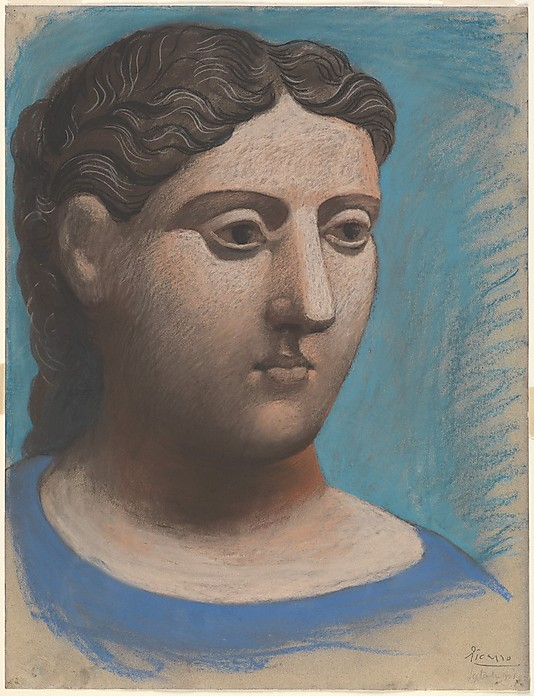
Above: Head of a Woman, Pablo Picasso (1921), Metropolitan Museum of Art, New York City
In addition to his artistic accomplishments, Picasso made a few film appearances, always as himself, including a cameo in Jean Cocteau’s Testament of Orpheus (1960).
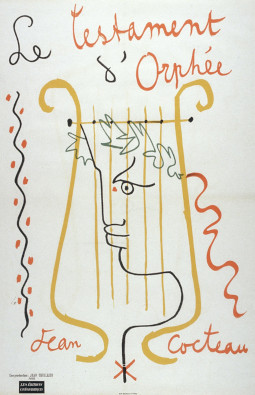
In 1955, he helped make the film Le Mystère Picasso (The Mystery of Picasso) directed by Henri-Georges Clouzot.
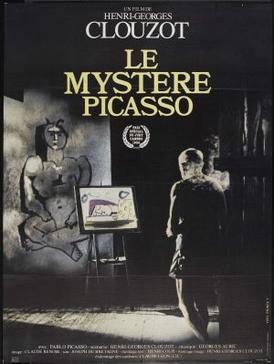
“When I was a child my mother said to me:
‘If you are a soldier, you will become a general.
If you are a monk, you will become the Pope.‘
Instead, I was a painter, and became Picasso.“
Pablo Picasso
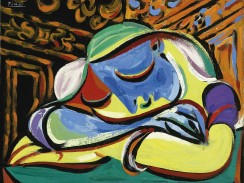
Above: Jeune fille endormie, Pablo Picasso (1935)
He was commissioned to make a maquette for a huge 50-foot (15 m)-high public sculpture to be built in Chicago, known usually as the Chicago Picasso.
He approached the project with a great deal of enthusiasm, designing a sculpture which was ambiguous and somewhat controversial.
Picasso said the figure represented the head of an Afghan hound named Kabul.
The sculpture, one of the most recognizable landmarks in downtown Chicago, was unveiled in 1967.
Picasso refused to be paid $100,000 for it, donating it to the people of the city.
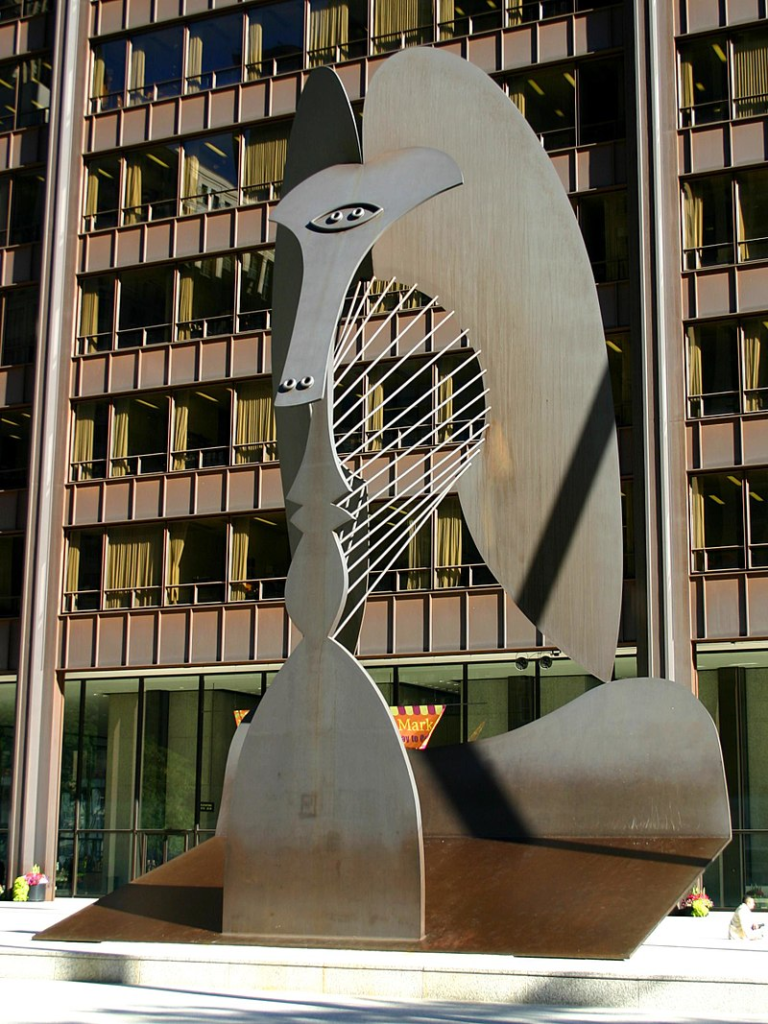
Above: Picasso sculpture in Daley Plaza, Chicago, Illinois
“Success is dangerous.
One begins to copy oneself and to copy oneself is more dangerous than to copy others.“
Pablo Picasso
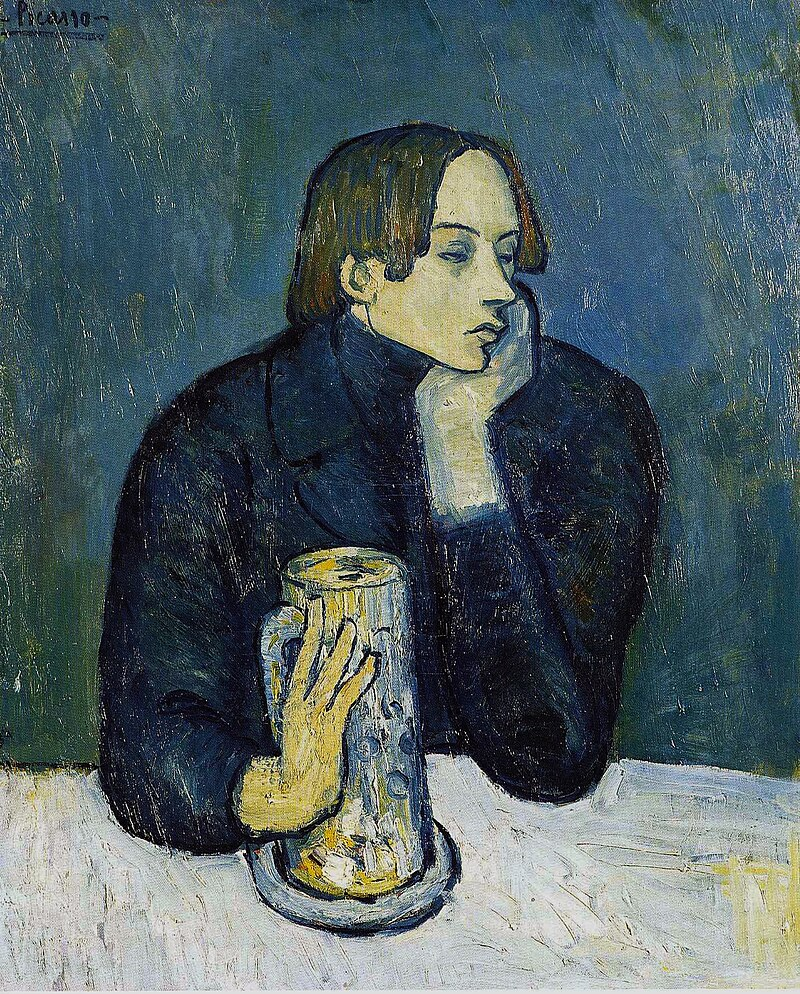
Above: Le bock (Portrait de Jaime Sabartes), Pablo Picasso (1902), Pushkin Museum, Moscow
Picasso’s final works were a mixture of styles, his means of expression in constant flux until the end of his life.
Devoting his full energies to his work, Picasso became more daring, his works more colourful and expressive.
From 1968 to 1971 he produced a torrent of paintings and hundreds of copper plate etchings.
At the time these works were dismissed by most as pornographic fantasies of an impotent old man or the slapdash works of an artist who was past his prime.
Only later, after Picasso’s death, when the rest of the art world had moved on from abstract expressionism, did the critical community come to see the late works of Picasso as prefiguring Neo-Expressionism.
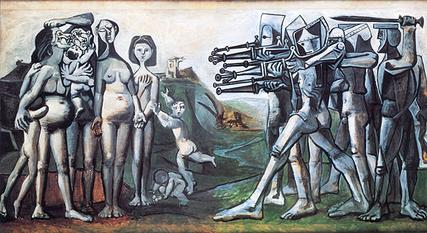
Above: Massacre in Korea, Pablo Picasso (1951)
“For me, art has neither past nor future.
All I have ever made was for the present.”
Pablo Picasso
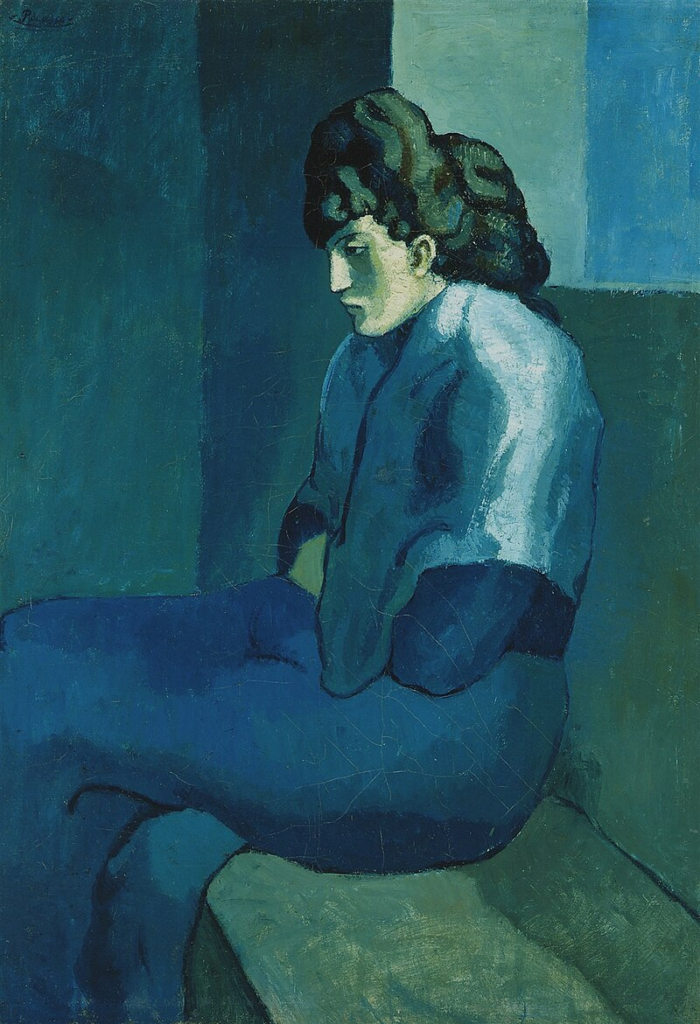
Above: Femme assise (Melancholy Woman), Pablo Picasso (1903), Detroit Museum of Art
Pablo Picasso died on 8 April 1973 in Mougins, France, from pulmonary edema and a heart attack, the morning after he and his wife Jacqueline entertained friends for dinner.
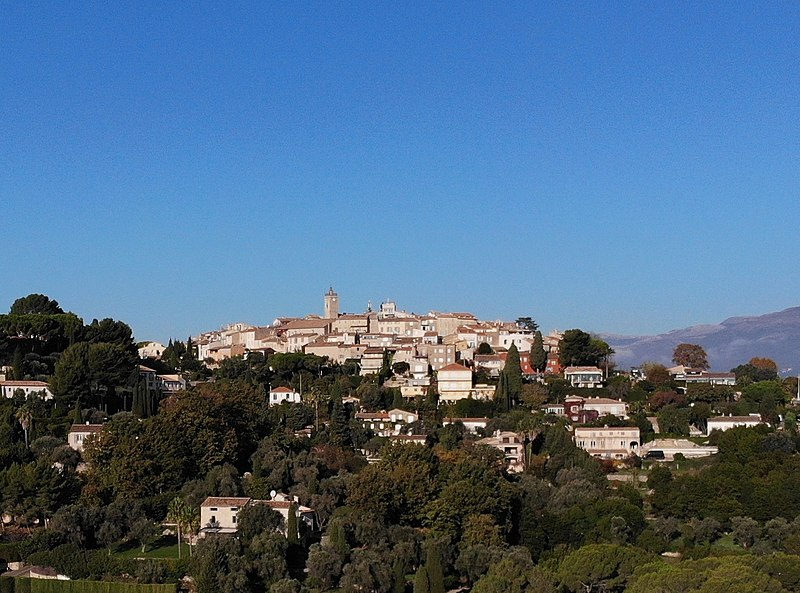
Above: Mougins, France
“It was a spirited dinner and Picasso a cheerful, genial host.
After the meal, while pouring wine into a friend’s glass, Picasso said:
“Drink to me.
Drink to my health.
You know I can’t drink any more.”
A little later, about 11:30 P.M., he left his guests, saying:
“And now I must go back to work.”
He was up painting until 3:00 a.m.
That morning Picasso woke at 11:30, unable to move.
By 11:40 he was dead.“.
Scott Slater and Alec Solomita
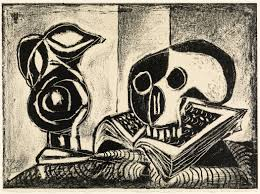
Above: Le pichet noir et la tête de mort (Black pitcher and death’s head), Pablo Picasso (1946), Buffalo AKG Art Museum
He was interred at the Château of Vauvenargues near Aix-en-Provence, a property he had acquired in 1958 and occupied with Jacqueline between 1959 and 1962.
Jacqueline prevented his children Claude and Paloma from attending the funeral.
Devastated and lonely after the death of Picasso, Jacqueline killed herself by gunshot in 1986 when she was 59 years old.
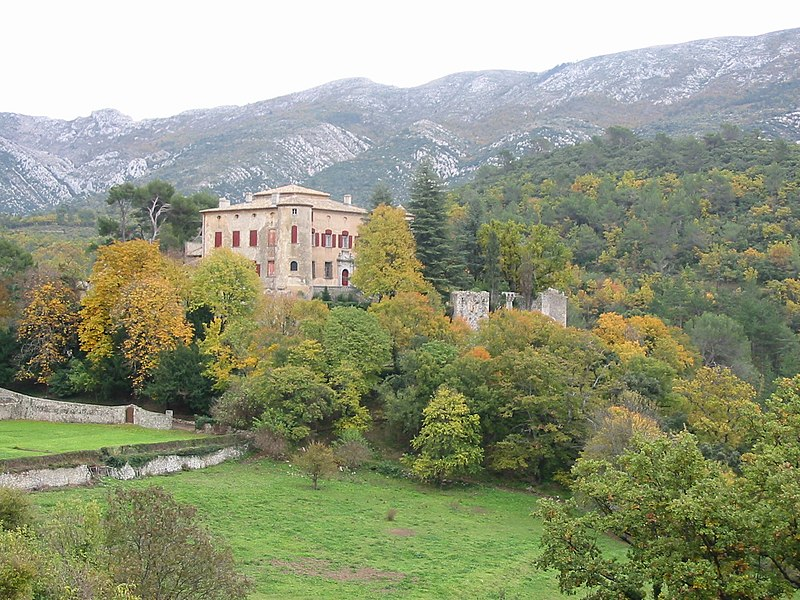
Above: Château Vauvenargues, Vauvenargues, France
“But woman’s grief is like a summer storm,
Short as it violent is.“
Joanna Baillie
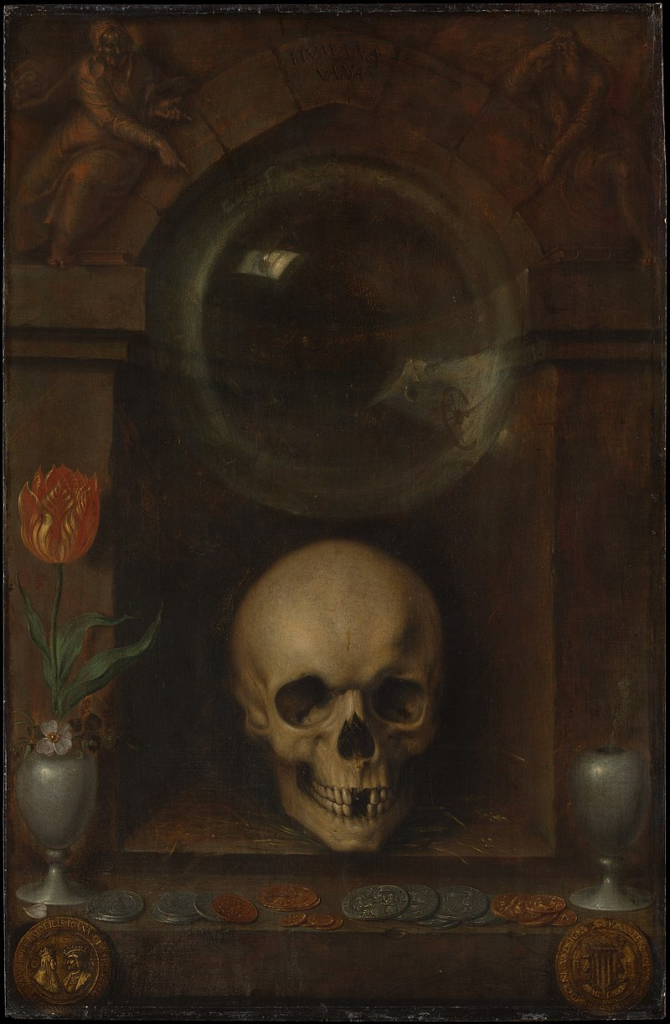
Above: Vanitas, Jacob de Gheyn (1603), Metropolitan Museum of Art, New York City
There are other museums worth investigating in Málaga, but time did not permit us to visit them:
- the Museo de Málaga (Fine Arts and Archaeology)
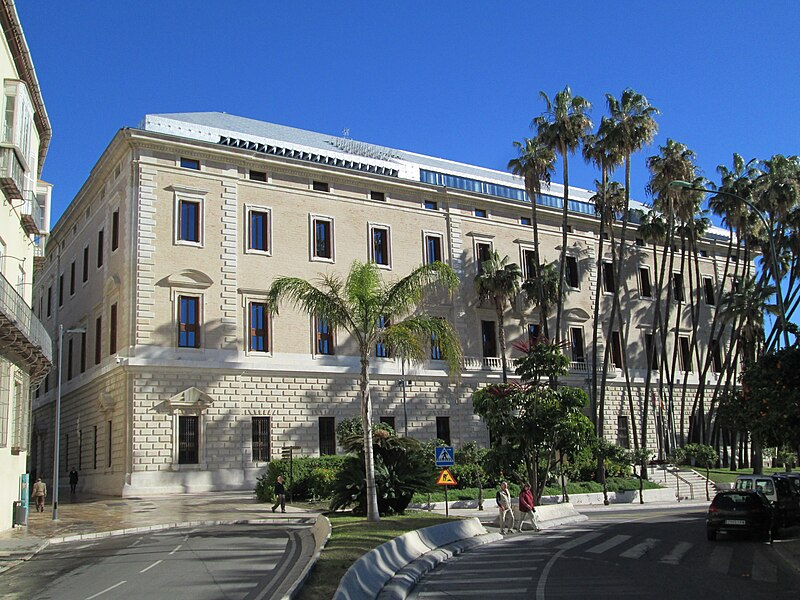
Above: Palacio de la Aduana, Museo de Málaga
- the Centre Pompidou Málaga
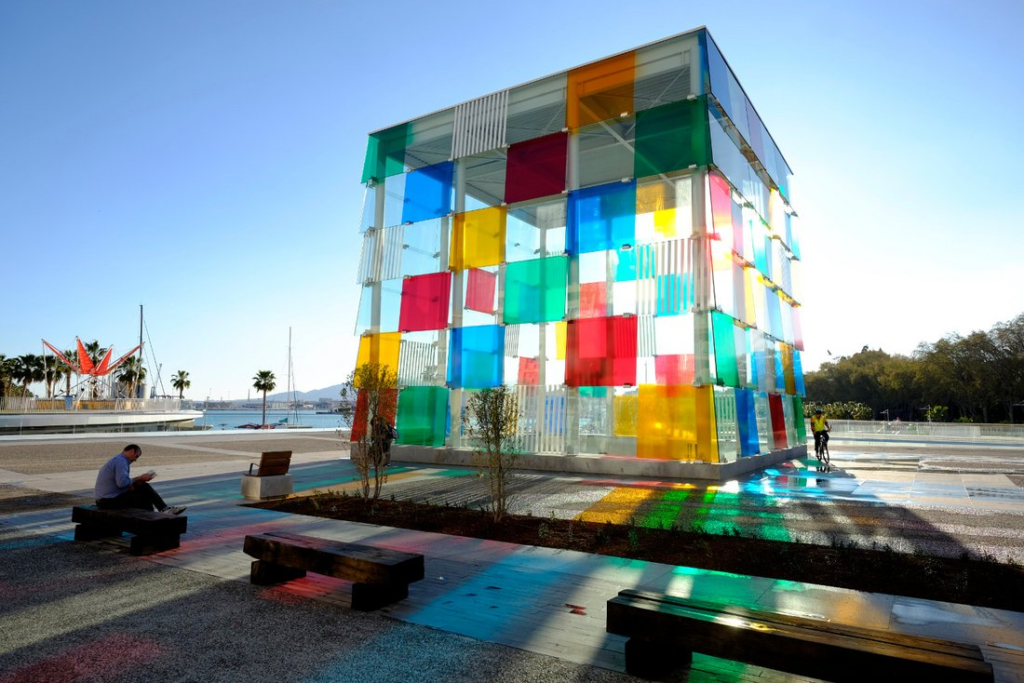
Above: Centre Pompidou Málaga
- the Colección del Museo Ruso Saint Petersburg / Málaga
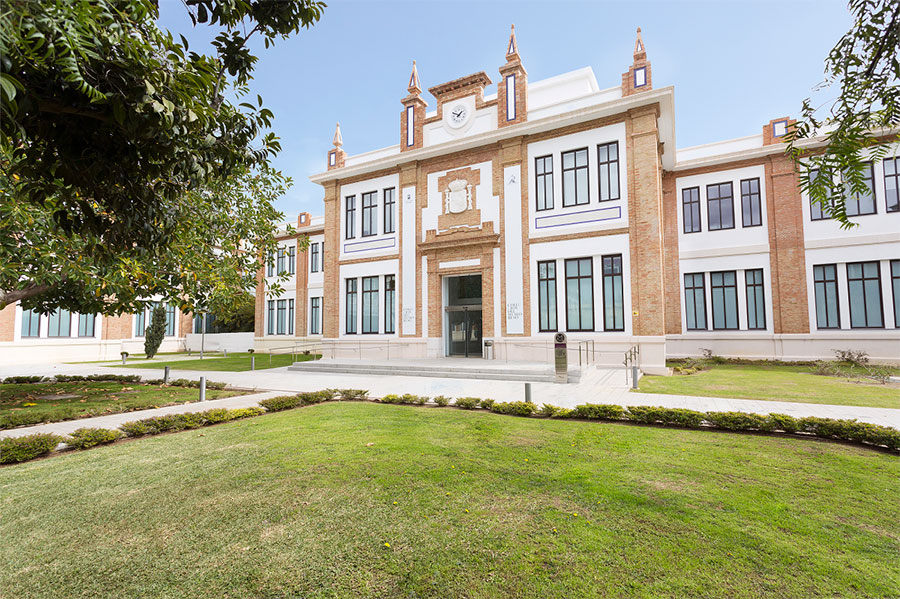
Above: Colección del Museo Ruso Saint Petersburg / Málaga
- the Museo de Artes y Costumbres Populares (Museum of Arts and Popular Traditions)
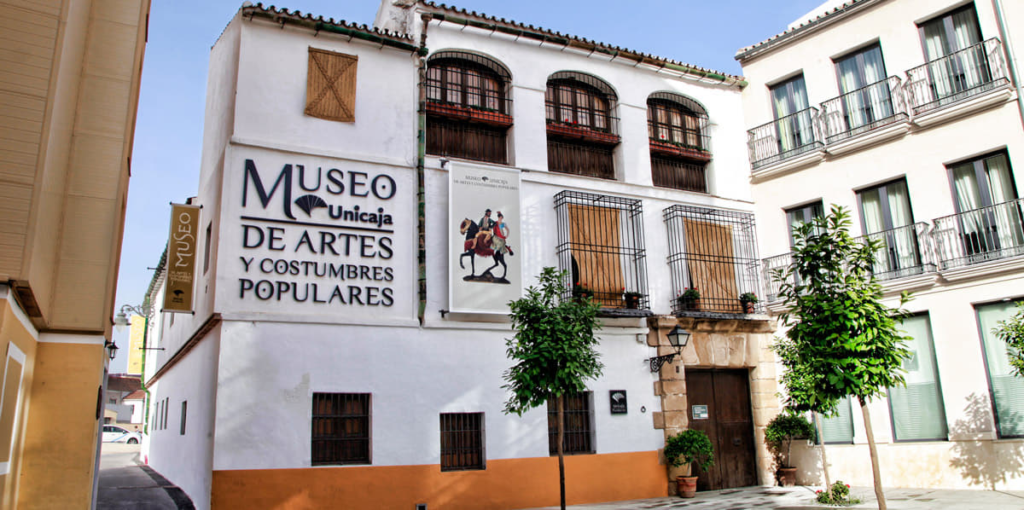
Above: Museo de Artes y Costumbres Populares, Málaga
- the Centro de Arte Contemporáneo (CAC) de Málaga
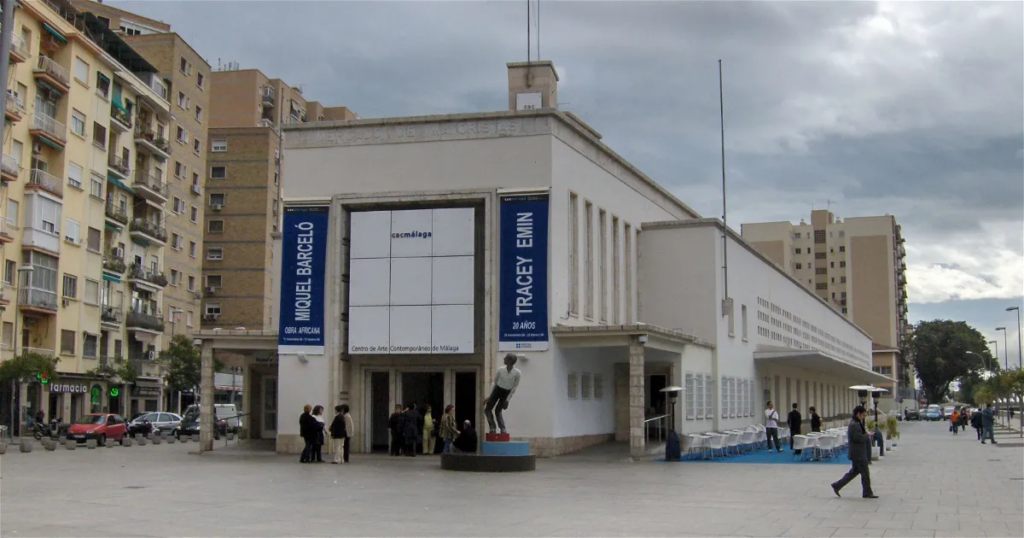
Above: Centro de Arte Contemporáneo (CAC) de Málaga
- the Gibralfare Castle Interpretation Centre
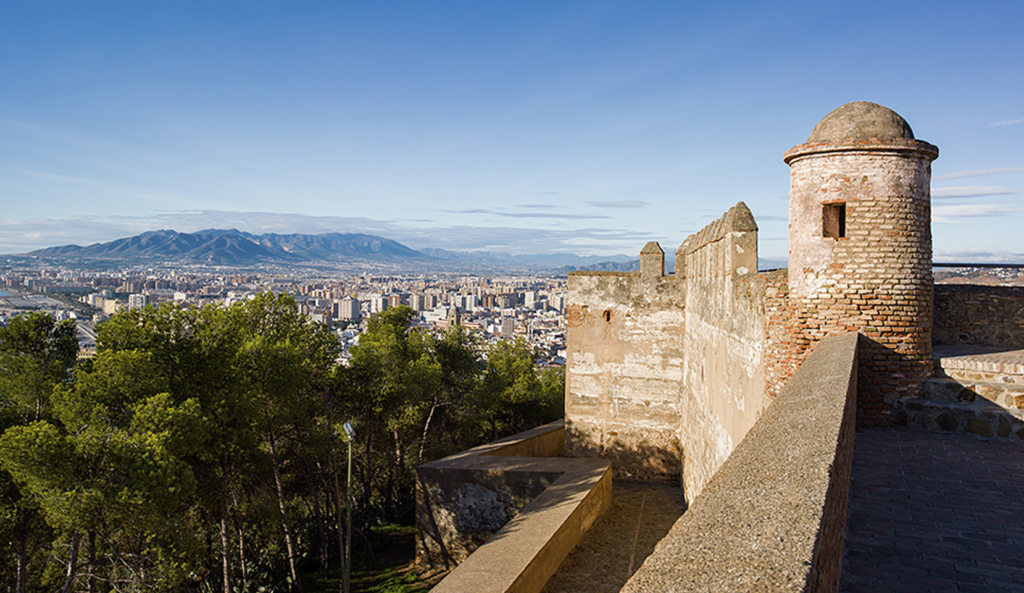
Above: Gibralfare Castle, Málaga
- the Málaga Cathedral Museum
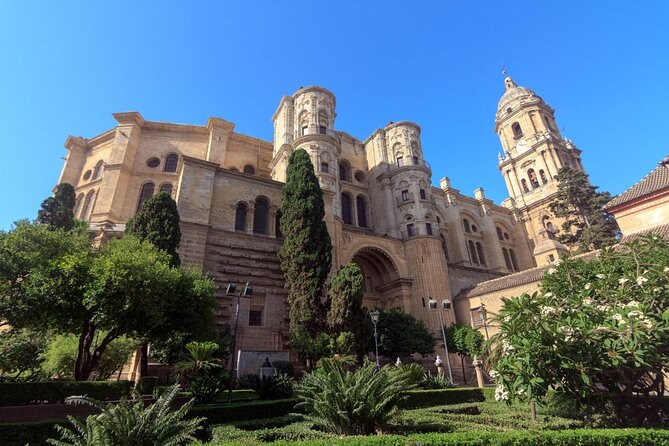
Above: Málaga Cathedral
- the Picasso Foundation Birthplace Museum
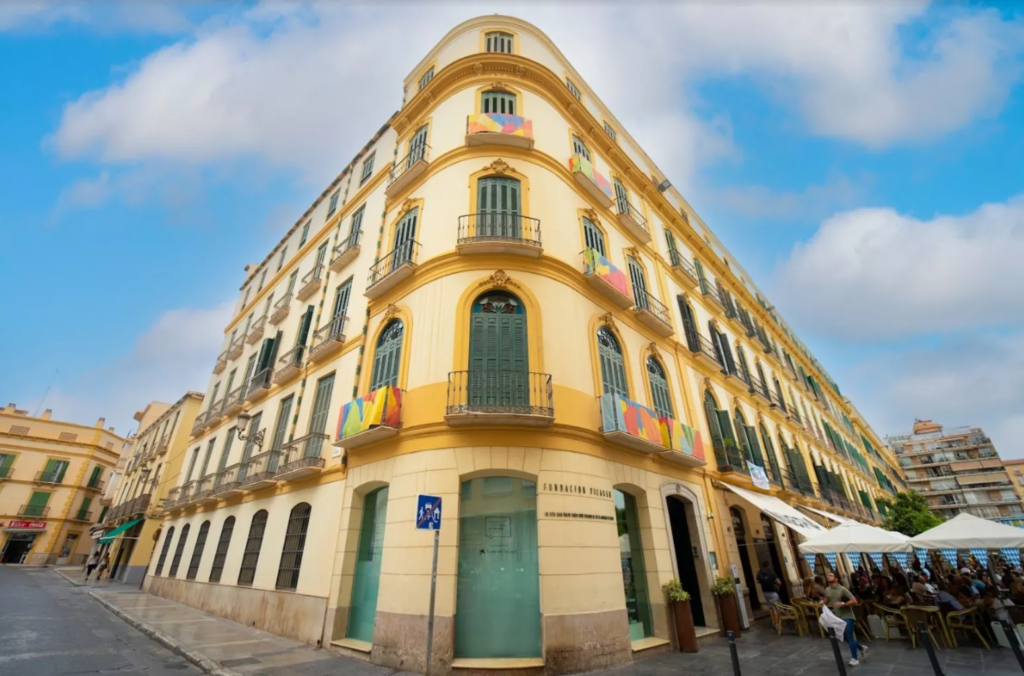
Above: Picasso Foundation Birthplace Museum, Málaga
- the Museo Automovilico de Málaga (Málaga Automobile Museum) (cars/engines/luggage)
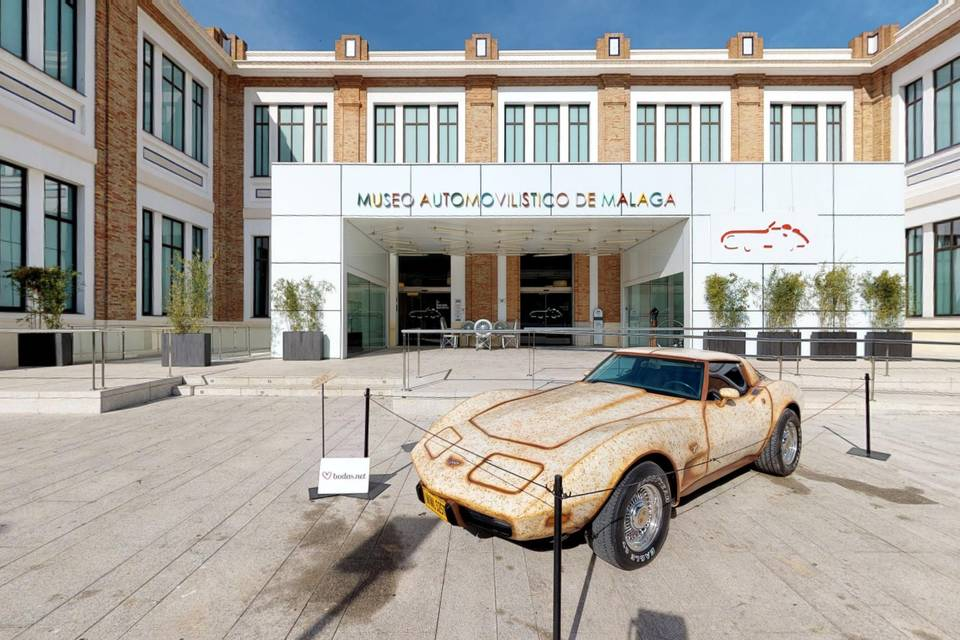
- the Museo del Patrimonio Municipal (Municipal Heritage Museum) (MUPAM)(city history: 17th to 20th centuries)
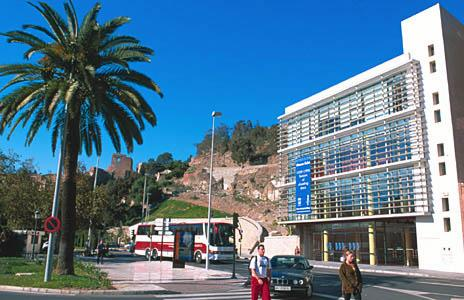
Above: Museo del Patrimonio Municipal, Málaga
- the Museo del Vidrio y Cristal (Museum of Glass and Crystal)
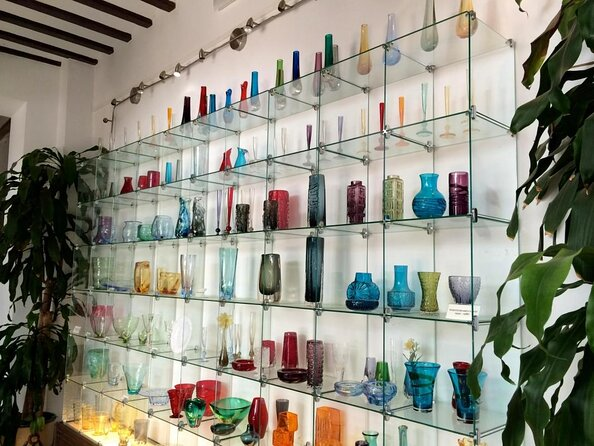
Above: Museo del Vidrio y Cristal, Málaga
- the Museo Loringiano (Loringian Museum)(archaeology)
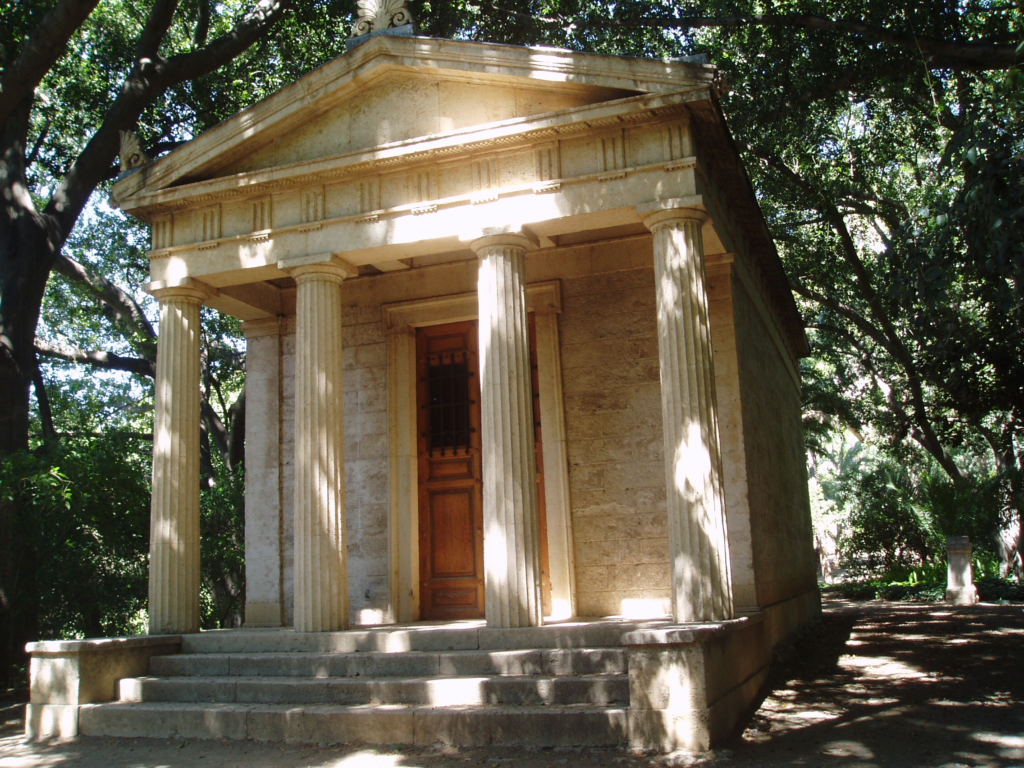
Above: Museo Loringiano, Málaga
- the Romano Teatro Interpretation Centre
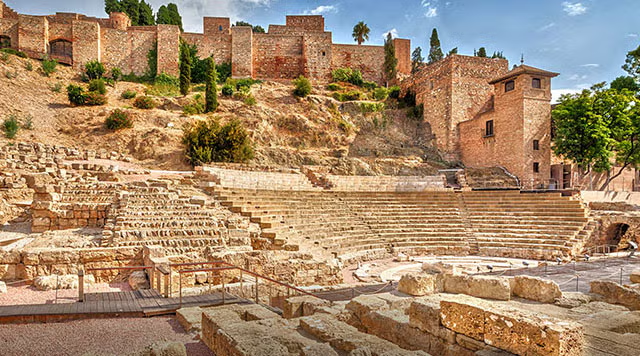
Above: Teatro Romano de Málaga
- the Museo Alborania (marine life)
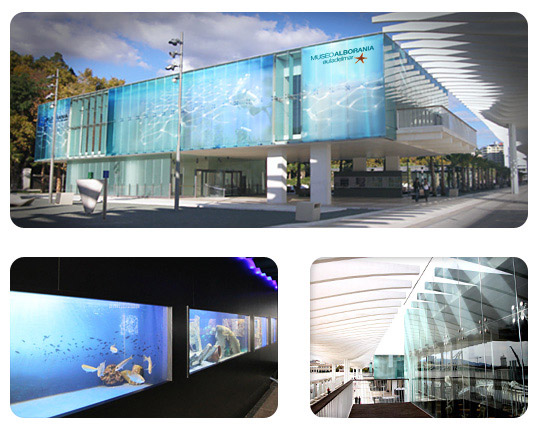
Above: Museo Alboania de Málaga
- the Museo de Palacio Episcopal de Málaga (religious art)
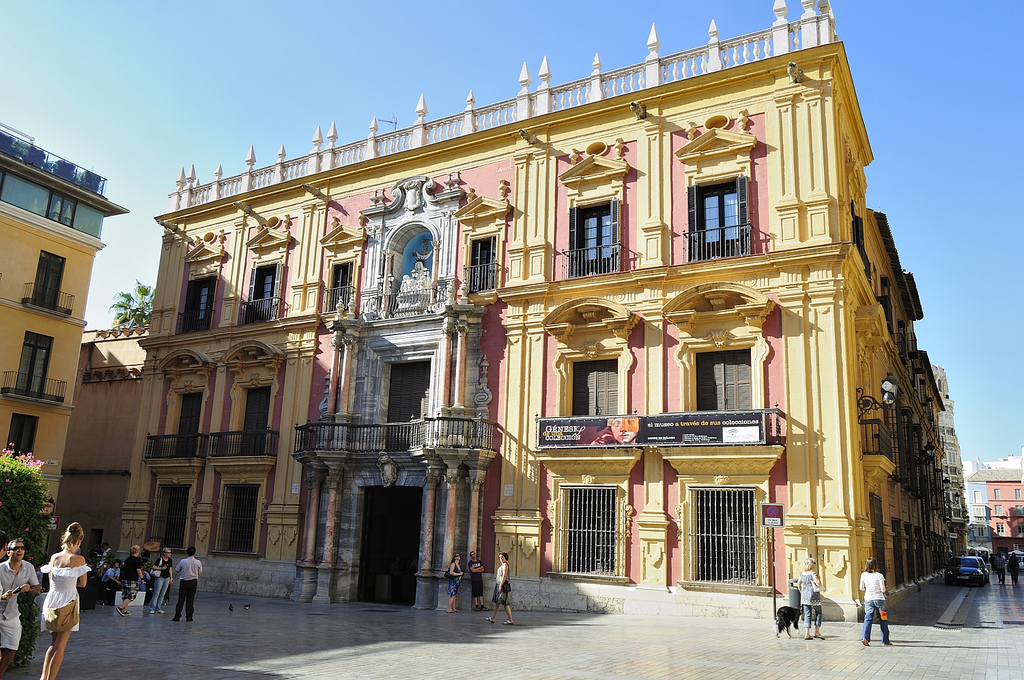
Above: Palacio Episcopal de Málaga
- the Museo Aeronautico de Málaga (airplanes / airports)

Above: Museo Aeronautico de Málaga
- the Centro de Ciencia Principia (Principia Science Centre)
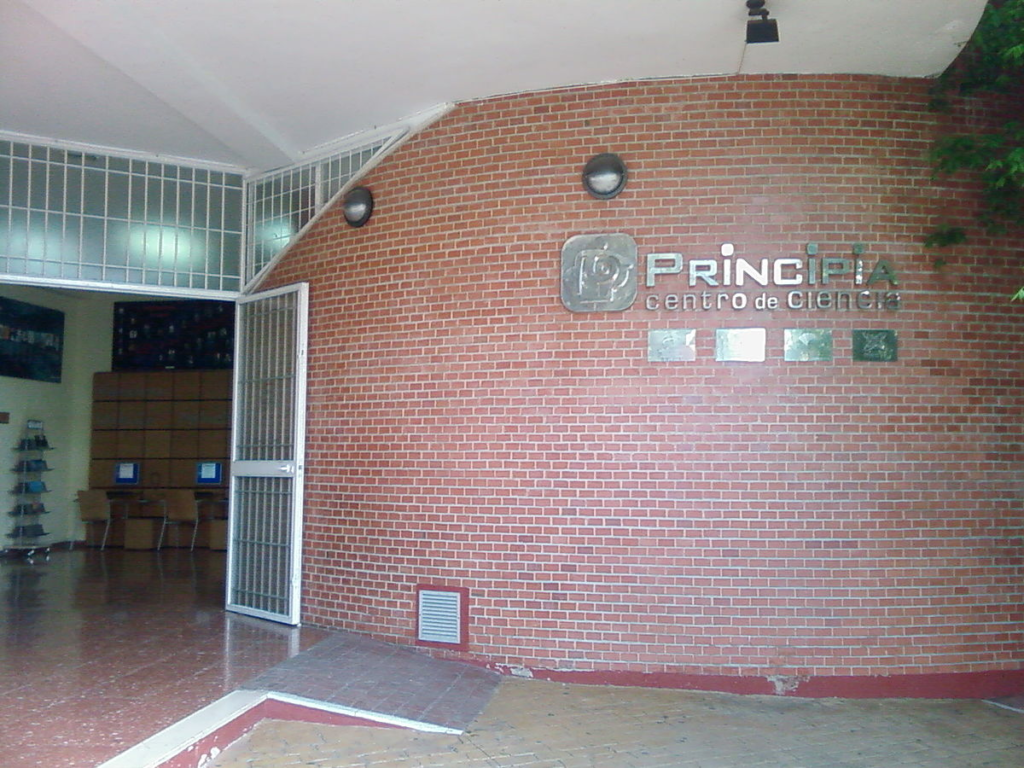
- the OXO Video Game Museum
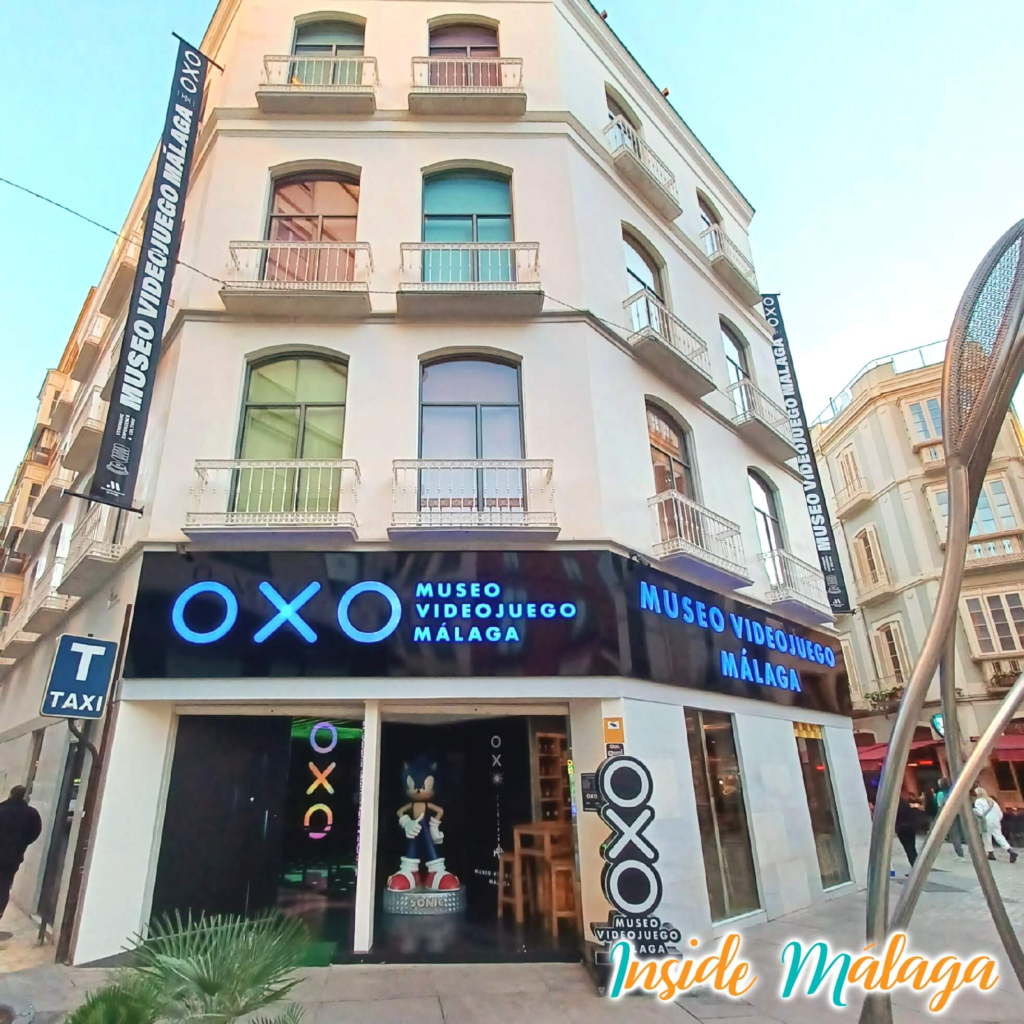
- the Museo Interactivo de la Musica de Málaga (MIMMA) (Interactive Museum of Music of Málaga)(music history)
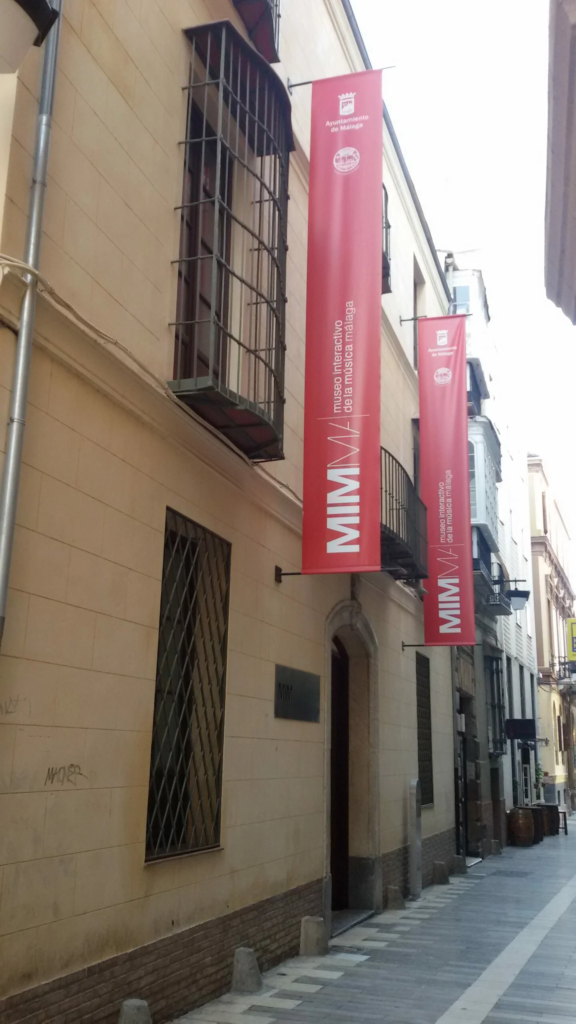
Above: Museo Interactivo de la Musica de Málaga
- the Museo del Vino de Málaga (Málaga Wine Museum)
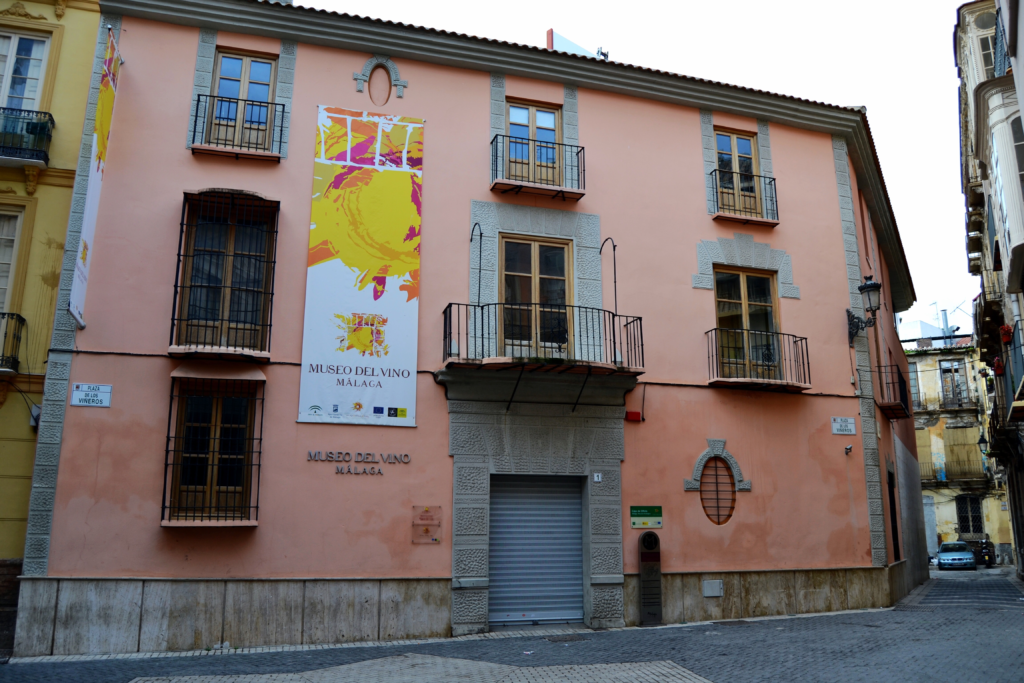
Above: Museo del Vino de Málaga
- the Museo de la Semana Santa de Málaga (Holy Week processional paraphernalia)
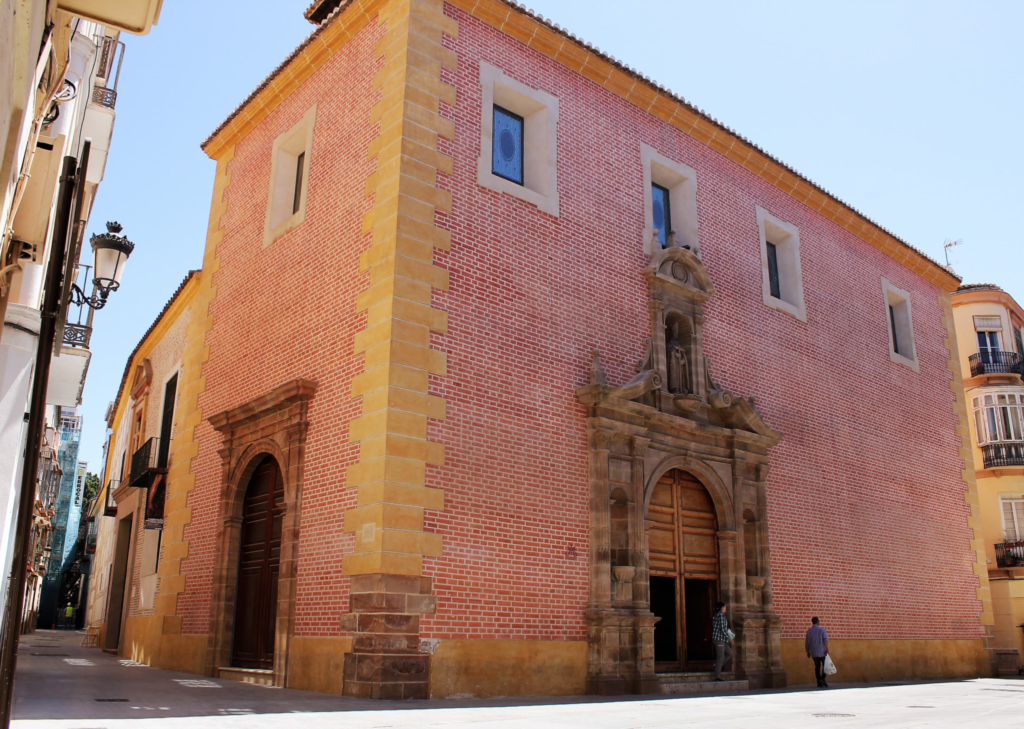
Above: Museo de la Semana Santa de Málaga
- the Antonio Ordonez Bullfighting Museum
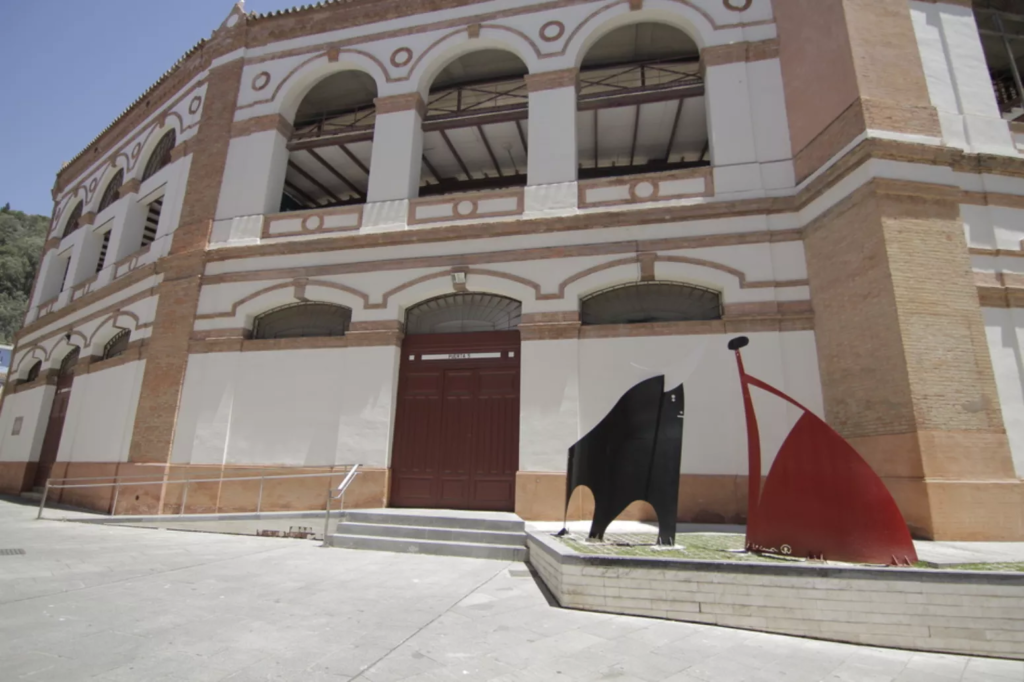
Above: Antonio Ordonez Bullfighting Museum
- the Juan Breva Peña Flamenco Museum
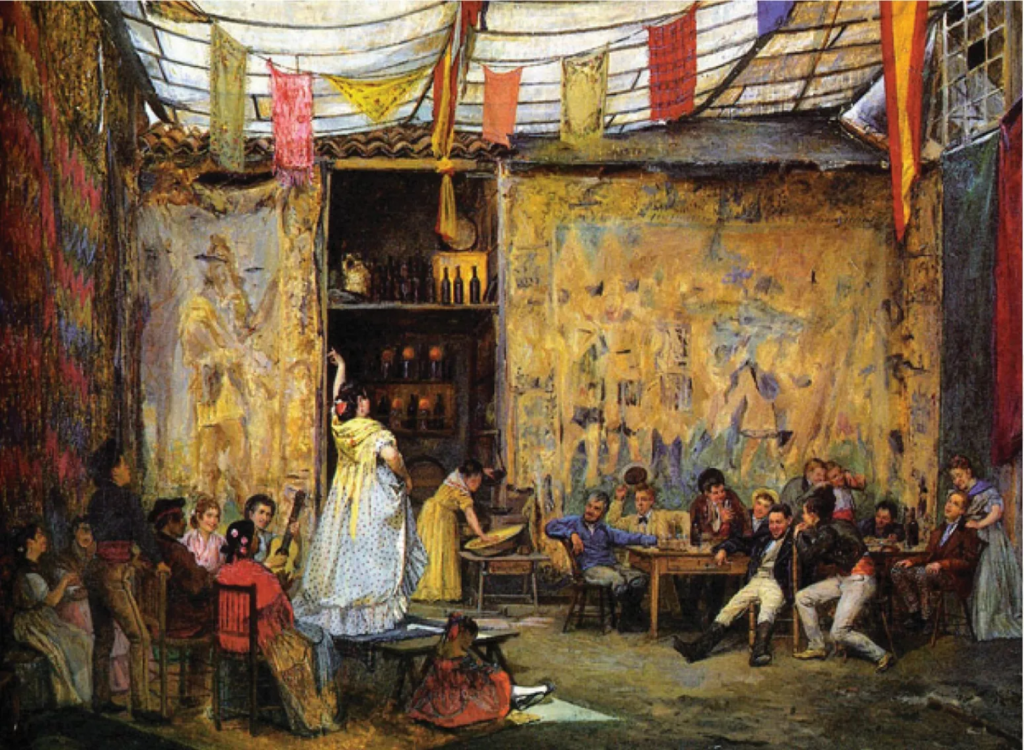
Above: Museo Arte Flamenco Málaga
- the Málaga CF Museum (Málaga Football Club)
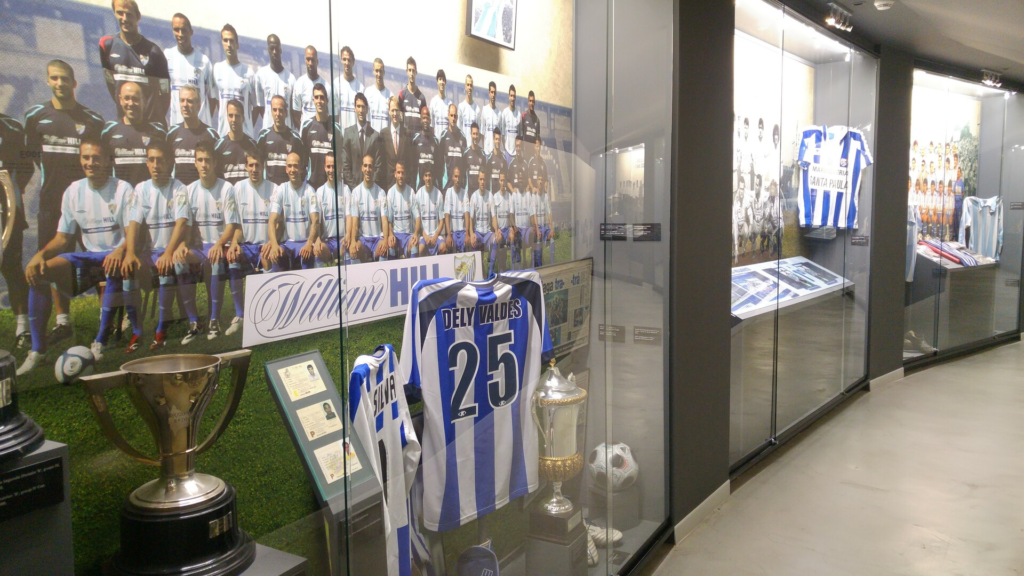
Above: Museo Málaga CF
- the Torrijos Winery Ecomuseum (north of the city in the Montes de Málaga National Park)
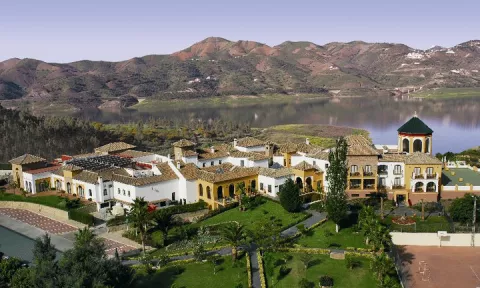
Above: Torrijos Winery Ecomuseum
- the Iphergan Collection (archaeology)
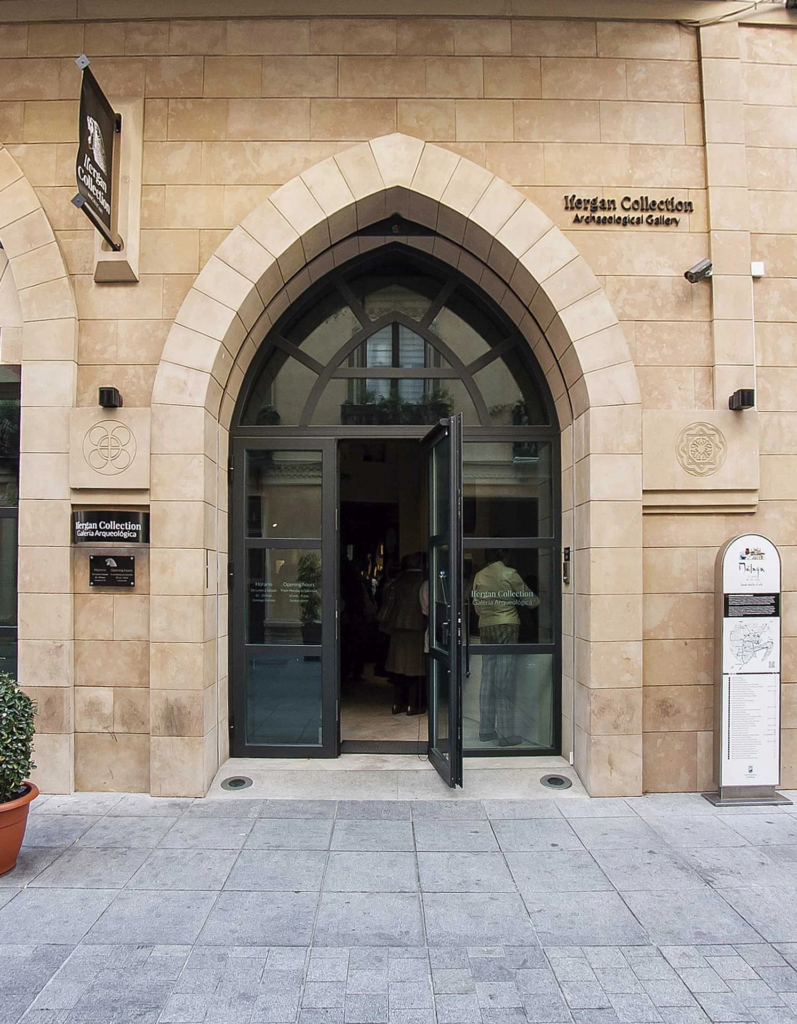
- the Museum of the Archconfraternity of Hope (Holy Week processional paraphernalia)
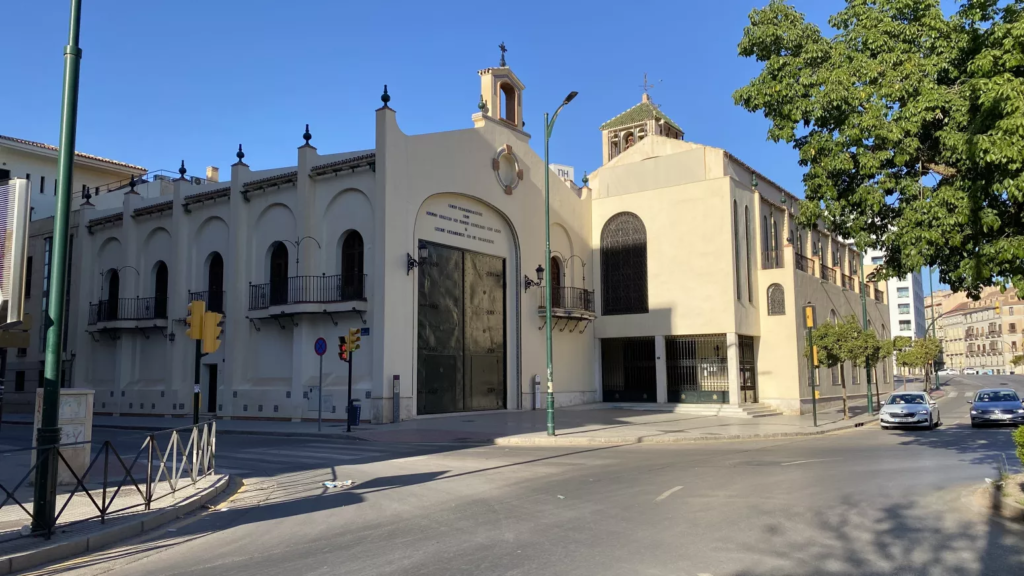
Above: Museum of the Archconfraternity of Hope
- the Museum of the Brotherhood of Students (Holy Week processional paraphernalia)
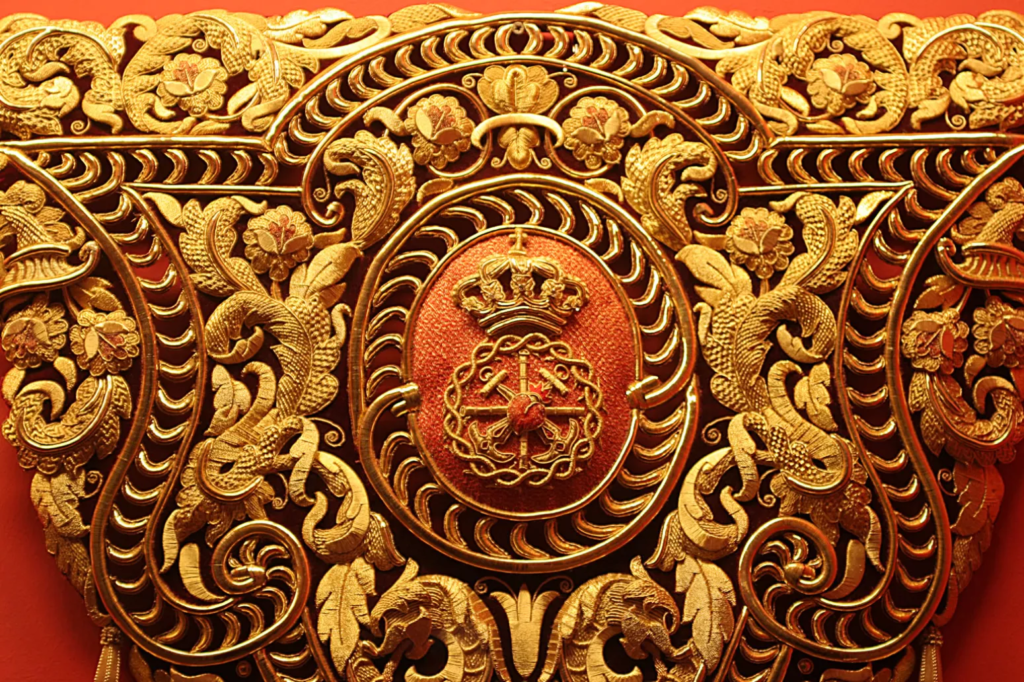
- the Museum of the Brotherhood of the Holy Sepulchre (Holy Week processional paraphernalia)
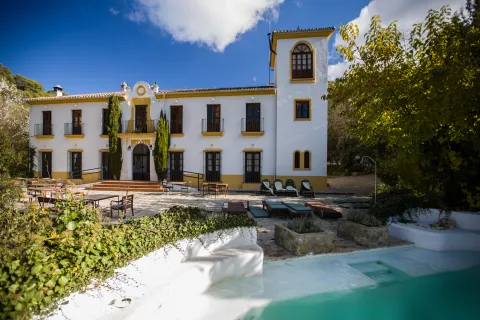
Above: Museum of the Brotherhood of the Holy Sepulchre
- the Museum – Treasure of the Brotherhood of the Expiration (Holy Week processional paraphernalia)
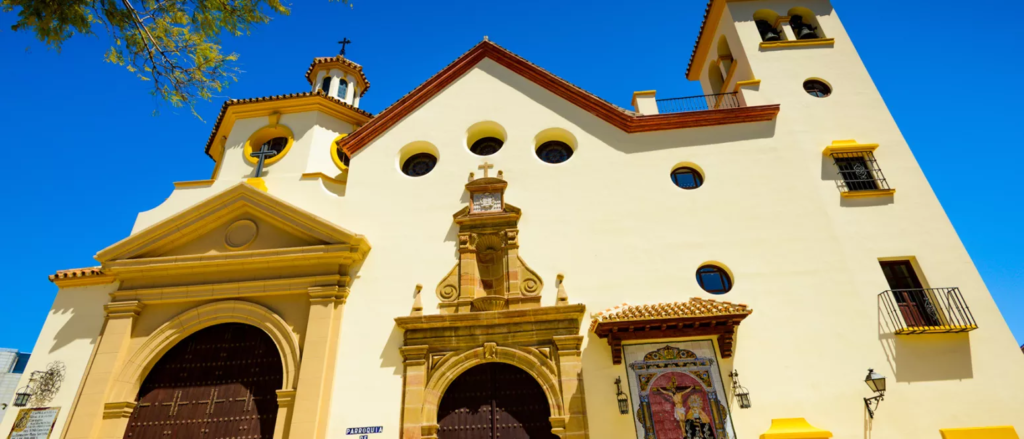
Above: Museum – Treasure of the Brotherhood of the Expiration
- the Museum of the Brotherhood of El Rocío (Holy Week processional paraphernalia)
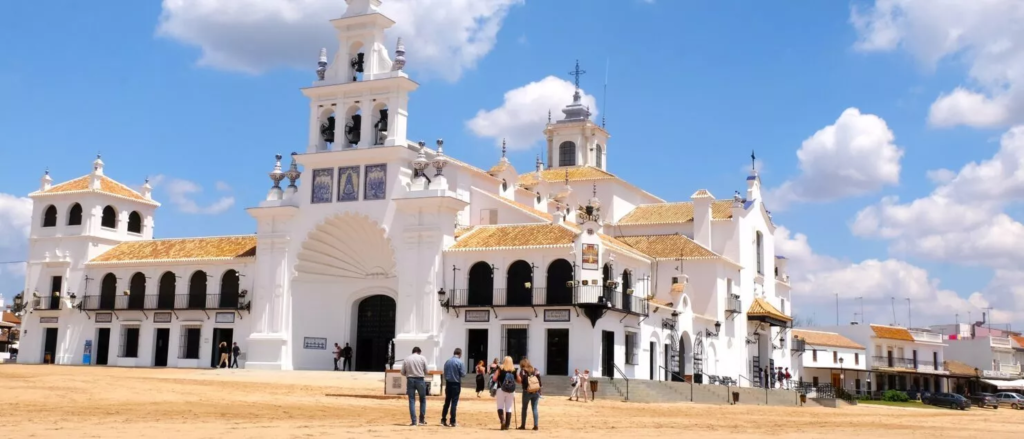
Above: El Rocio, an absolutely unique village in Andalucia
- the Museum of the Brotherhood of El Cautivo (Holy Week processional paraphernalia)
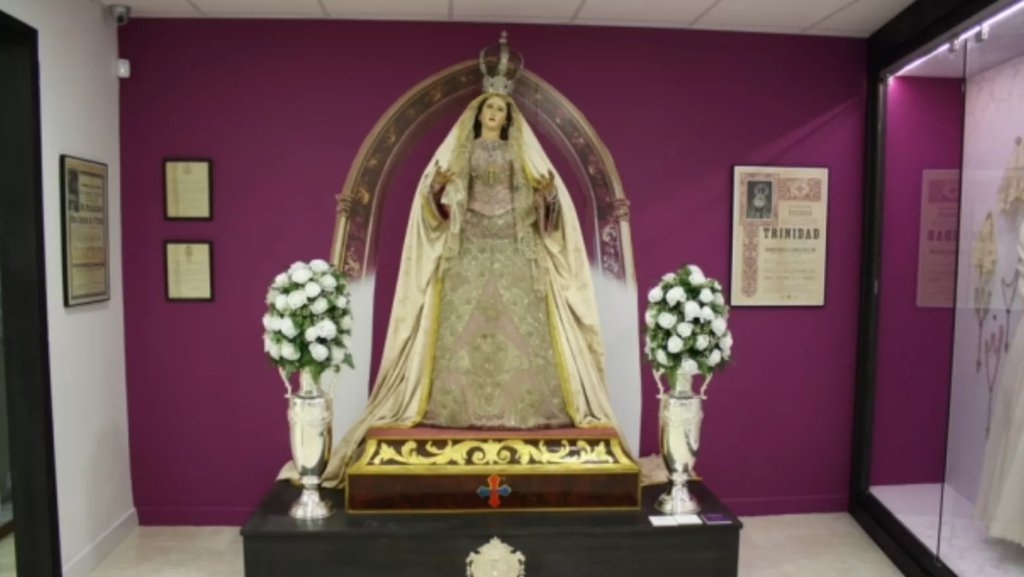
- the Ben Gabirol Centre (interpretation centre of the Jewish Quarter of Málaga and the life / works of Jewish philosopher – poet Solomon Ben Gabriol / tourist information centre)(Málaga City Hall)
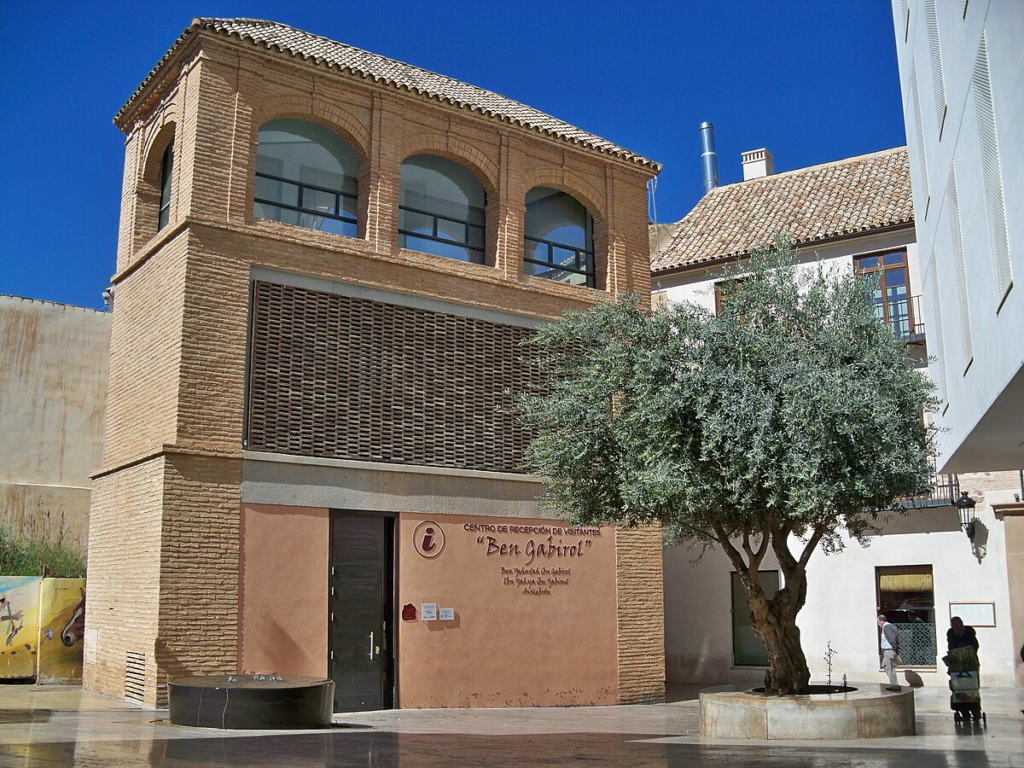
Above: Ben Gabirol Centre
- the Gaia Museum (prehistory)
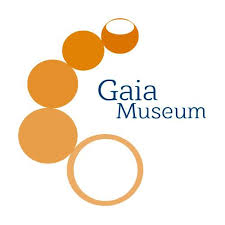
- the Yacimientos Arqueologicos de la Araña (Prehistoric Park of Málaga)
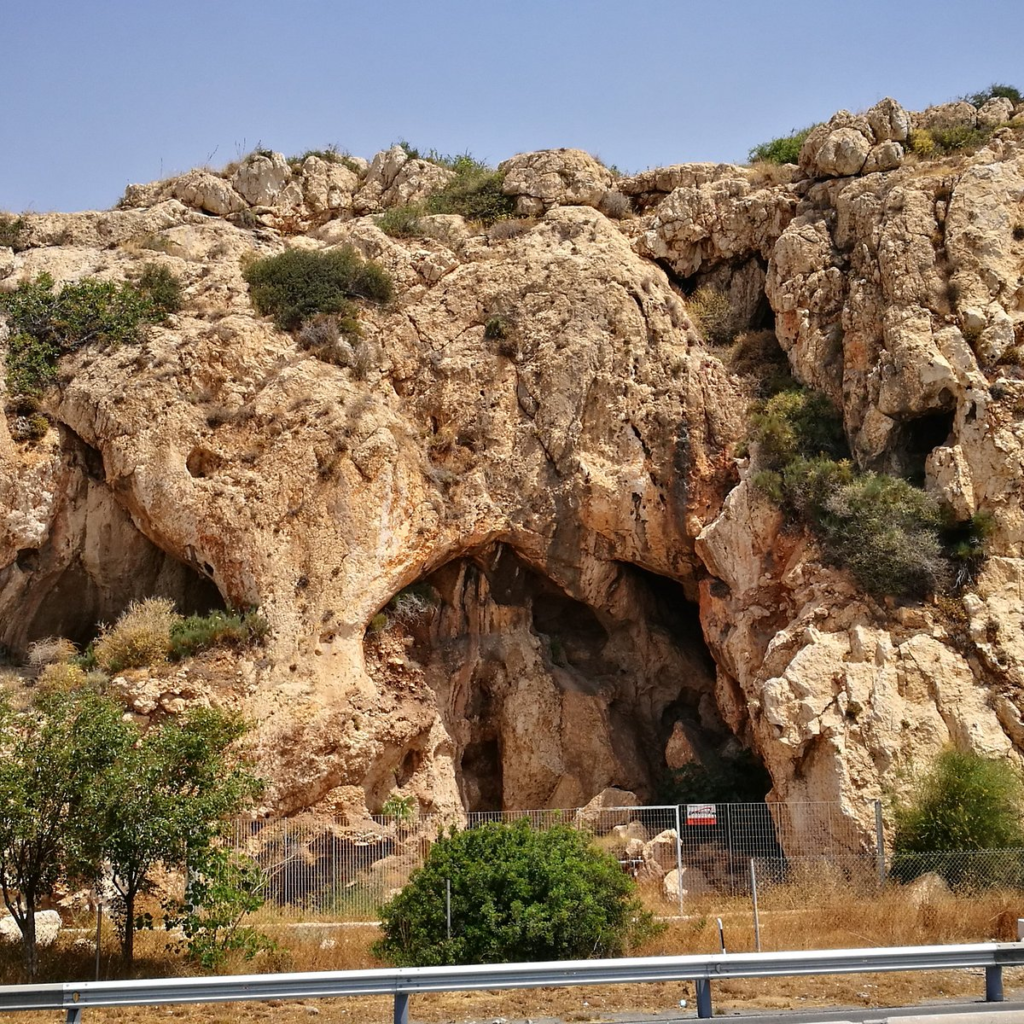
Above: Yacimientos Arqueologicos de la Araña
- the Antigua Imprenta Sur (the Old Southern Printing Press)(a “functional museum“)
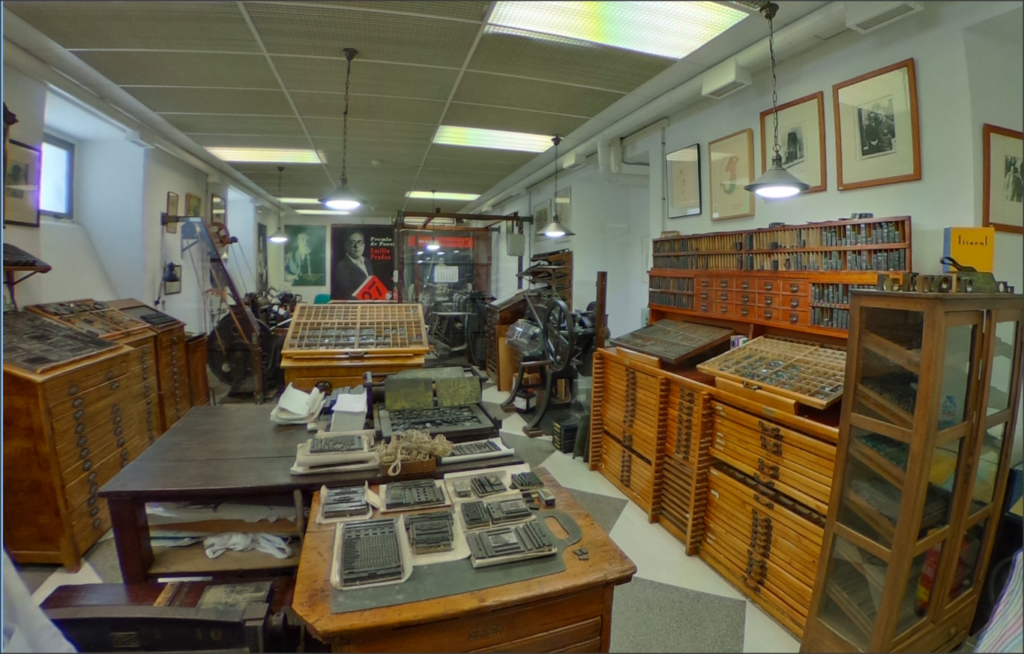
Above: Antigua Imprenta Sur
- the José María Torrijos Historical Interpretation Centre
(Jose Maria Torrijos y Uriarte (1791 – 1831), Count of Torrijos, a title granted posthumously by the Queen Governor, also known as General Torrijos, was a Spanish Liberal soldier.
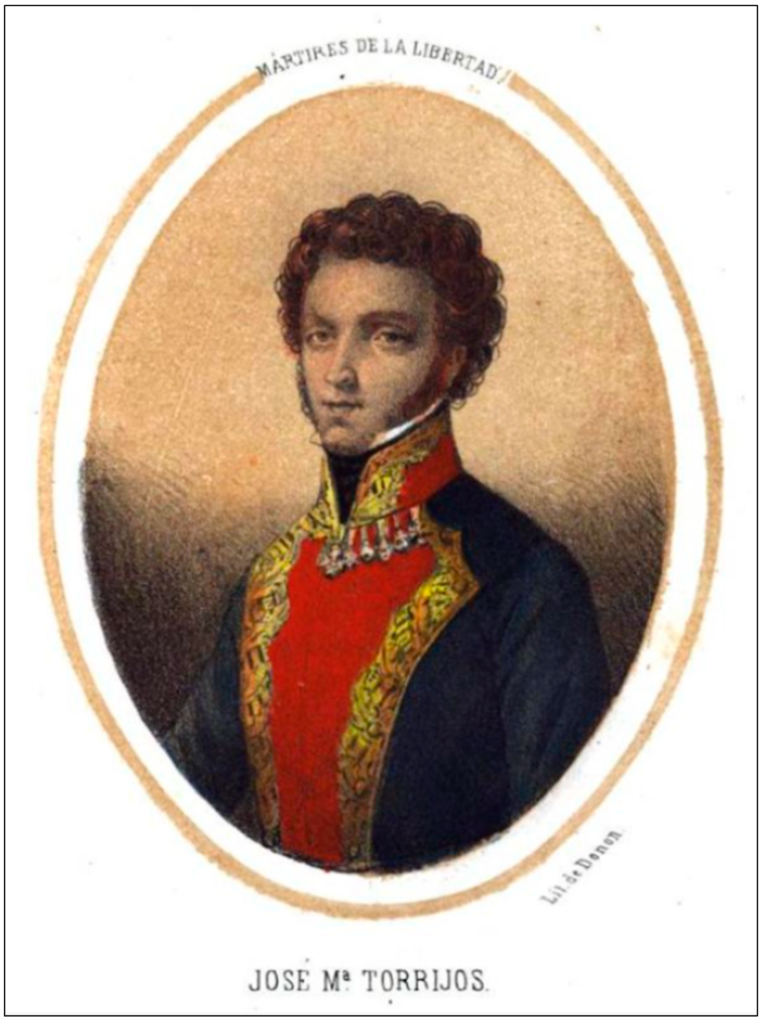
He fought in the Spanish War of Independence / the Peninsular War (1807 – 1814) and after the restoration of absolutism by Ferdinand VII (1784 – 1833) in 1814 he participated in the pronouncement of John Van Halen (1788 – 1864) of 1817 that sought to restore the Constitution of 1812, for which he spent two years in prison until he was released after the triumph of the Riego Uprising in 1820.
He returned to fight the French when the Hundred Thousand Sons of Saint Louis invaded Spain to restore the absolute power of Ferdinand VII and when those triumphed ending the liberal triennium exiled to England.
There he prepared a statement which he himself led, landing on the coast of Málaga from Gibraltar on 2 December 1831, with sixty men accompanying him, but they fell into the trap that had been laid before him by the absolutist authorities and were arrested.
Nine days later, on 11 December 1831, Torrijos and 48 of his fellow survivors were shot without trial on the beach of San Andres de Málaga, a fact that was immortalized by a sonnet of José de Espronceda entitled To the death of Torrijos and his Companions, Enrique Gil y Carrasco’s A la memoria del General Torrijos, and by the well-known 1888 painting (Fusilamiento de Torrijos y sus compañeros en las playas de Málaga) by Antonio Gisbert (1834 – 1901).
“The tragic outcome of his life explains what has happened to history, in all fairness, as a great symbol of the struggle against despotism and tyranny, with the traits of epic nobility and serenity typical of the romantic hero, eternalized in the famous painting by Antonio Gisbert.”
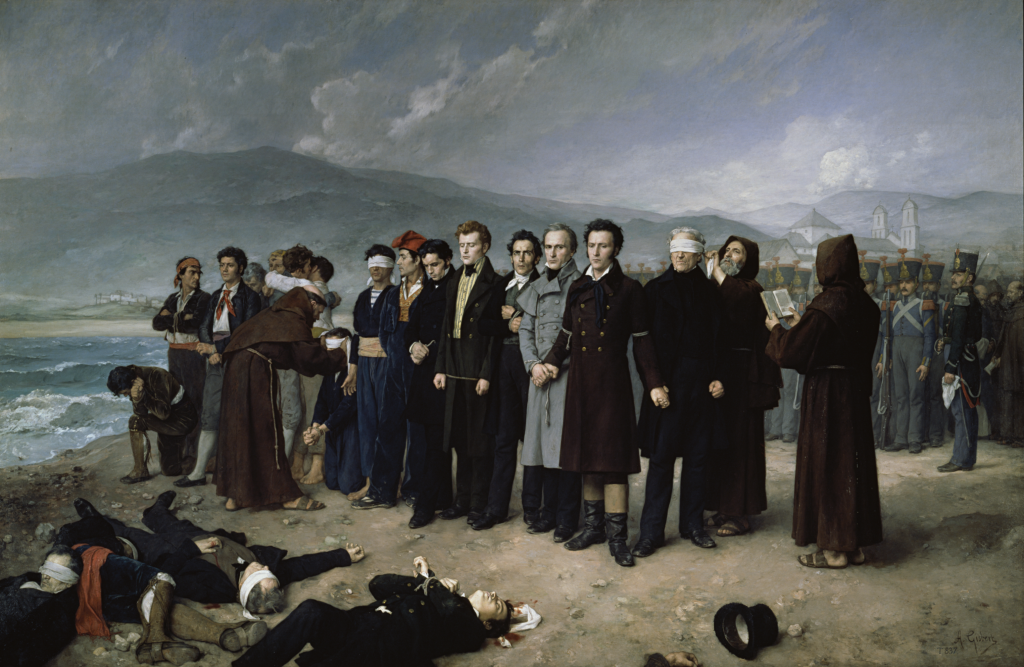
Above: Fusilamiento de Torrijos y sus compañeros en las playas de Málaga (Execution of Torrijos and his Companions on the Beach at Málaga), Antonio Gisbert Pérez (1888), Museo del Prado, Madrid
The city of Málaga erected a monument to Torrijos and his companions in the Plaza de la Merced, next to the birthplace of the painter Pablo Picasso.
Under the monument to Torrijos in the middle of the square are the tombs of 48 of the 49 men shot.
One of them, British, was buried in the English Cemetery of Málaga.)
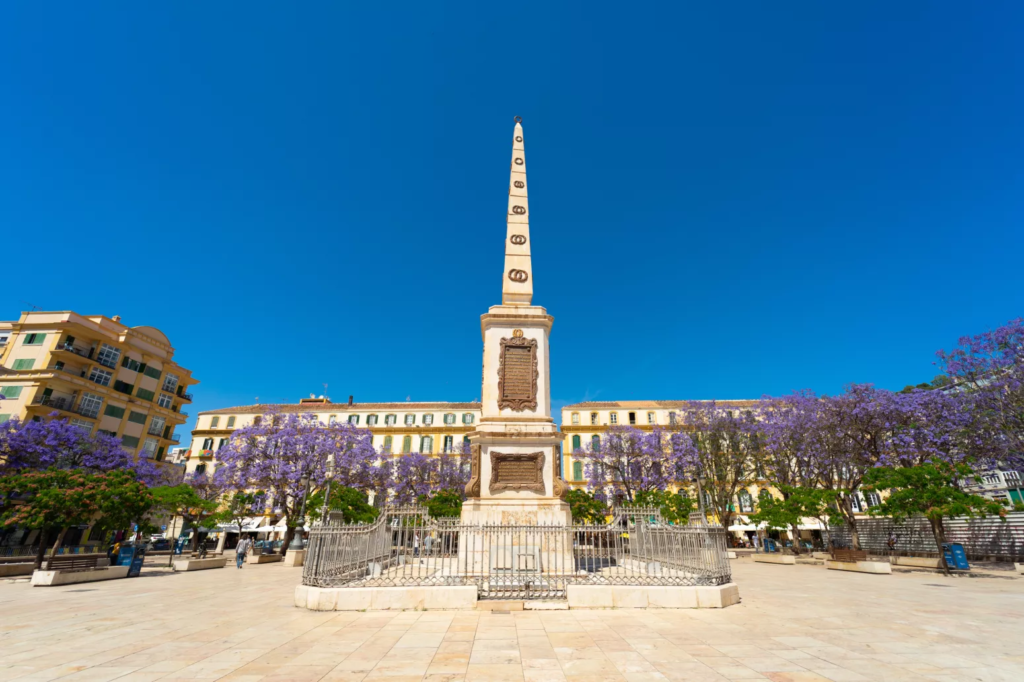
Above: Torrijos Monument
In the works are:
- the Yabal Faruh Necropolis (archaeology)
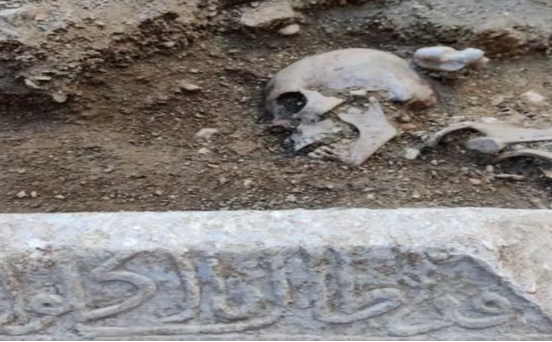
- the Port of Málaga Museum
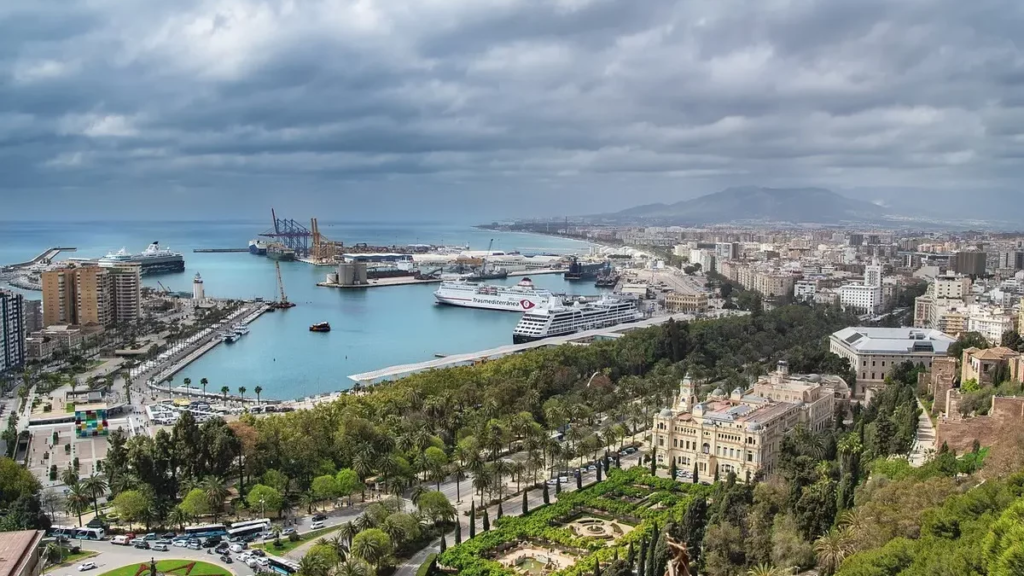
Above: The port of Málaga
- the Sephardic Cultural Centre (Sephardic: Spanish Jews)
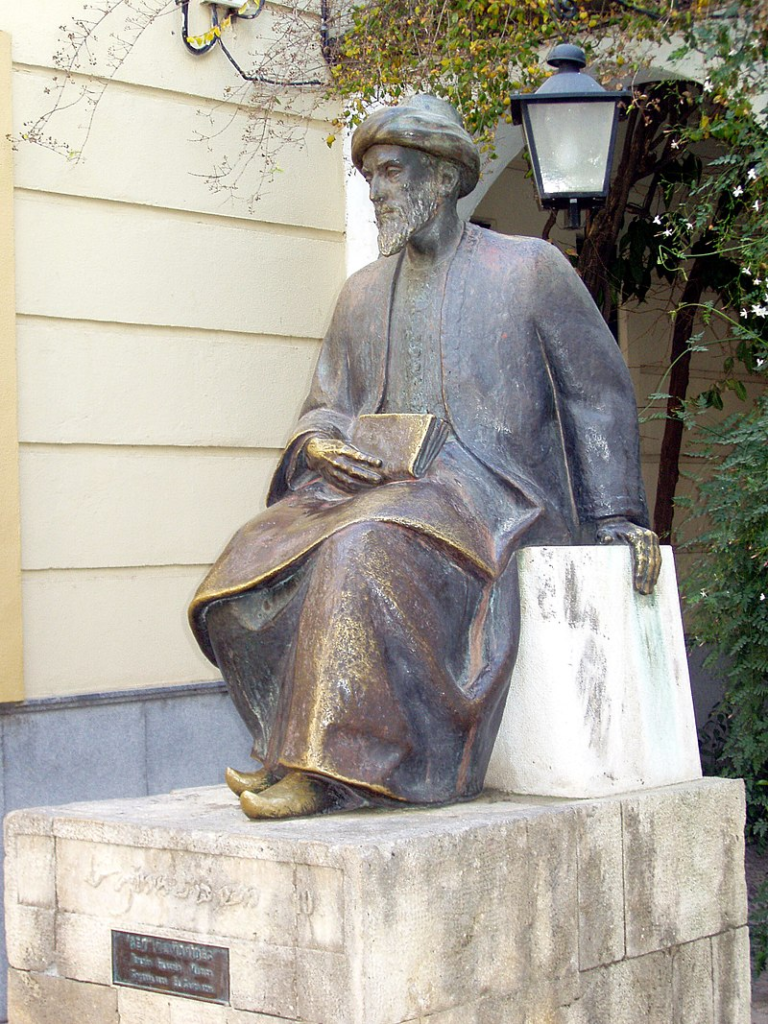
When will they open?
I know not when.

Former museums now closed:
- the Dollhouse Museum (2003 – 2013)
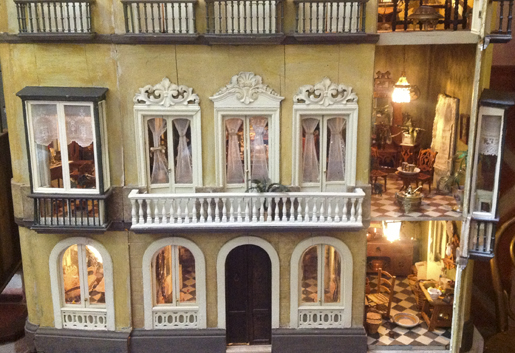
- the Museo del Cister (Cistercian Museum)(next to the Abbey of Santa Ana)(Catholic monastic order)(2007 – 2010)
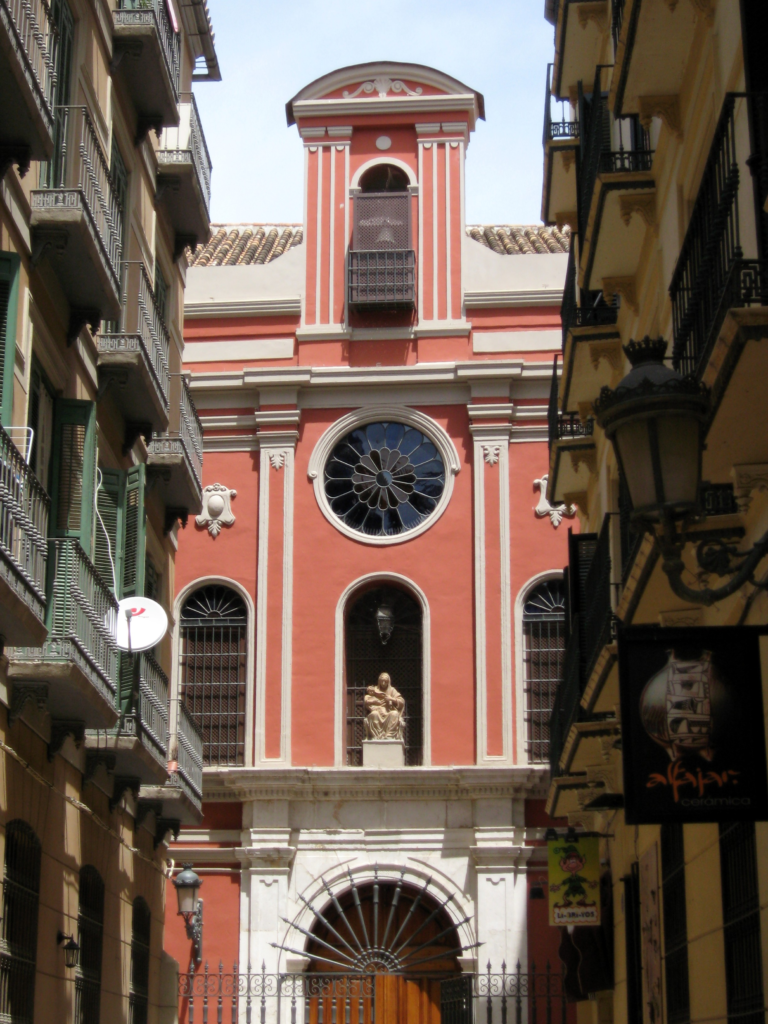
- the Málaga Bullfighting Art Centre (2015 – 2017)
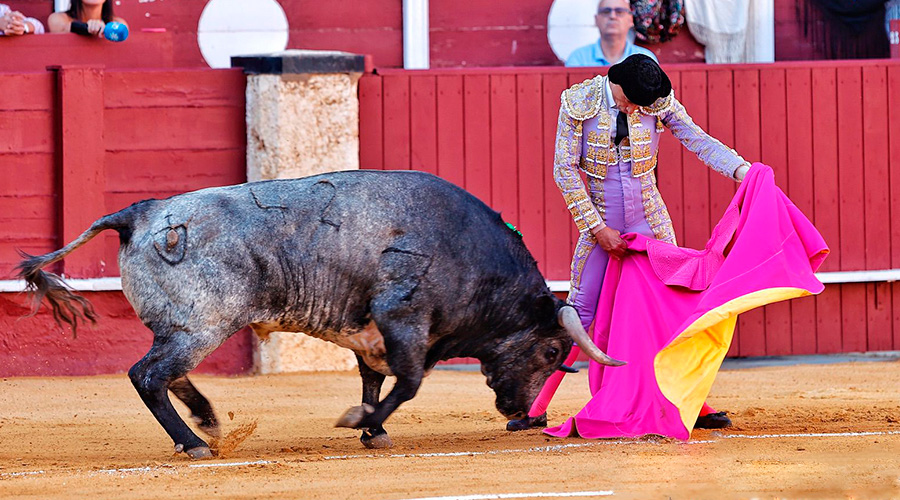
Why did they close?
I know not why.

José Denis Belgrano (1844 – 1917) was a Spanish painter, notable exponent of the Málaga School of Painting.
He was the favourite painter of the Málaga bourgeoisie of the 19th and early 20th centuries.
His work of manners reaches great mastery.
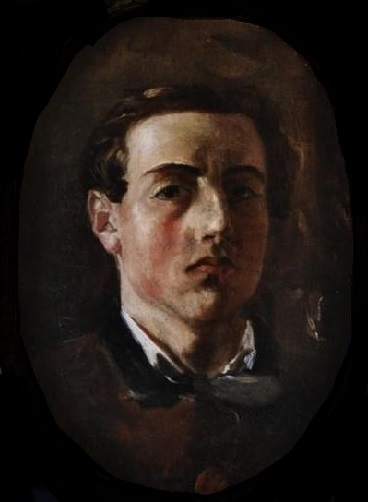
Above: Self portrait, José Denis Belgrano (1864), Museo de Málaga
Thanks to the help of Carlos Larios, Marquis of Guadiaro, he was able to travel to Rome in 1862, where he studied for two years and received the decisive influence of the work of Mariano Fortuny, whom however he did not meet.
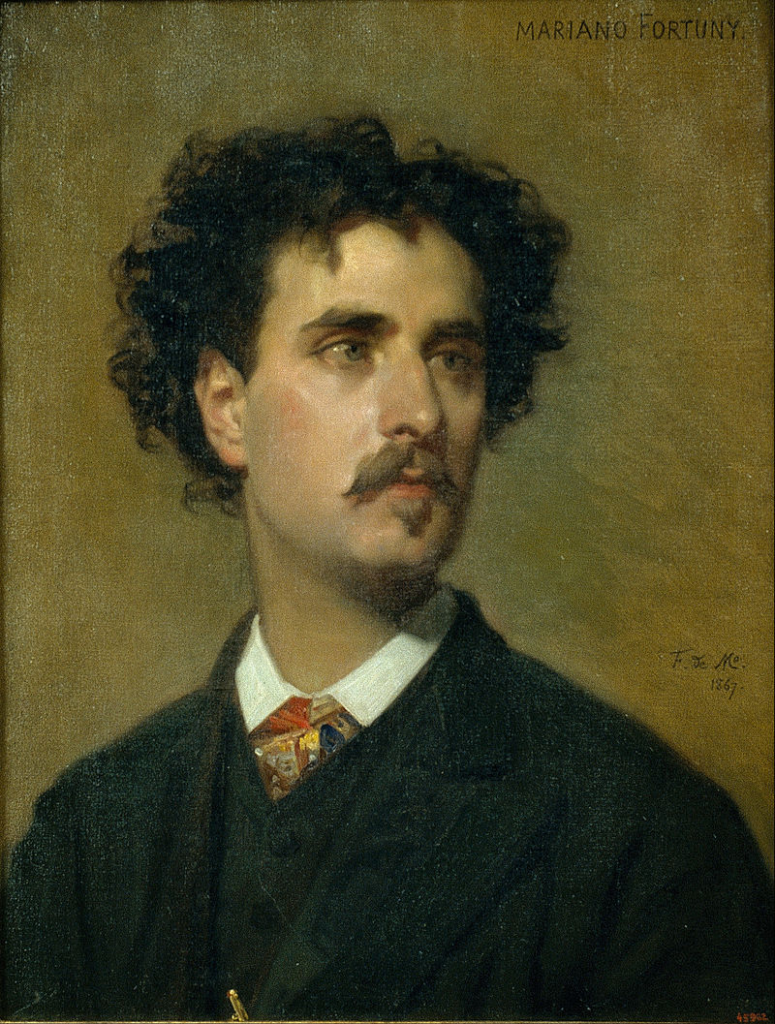
Above: Spanish painter Mariano Fortuny (1838 – 1874)
Later, in Málaga, he enrolled in the School of Fine Arts (1868), where he was a student of Bernardo Ferrándiz.
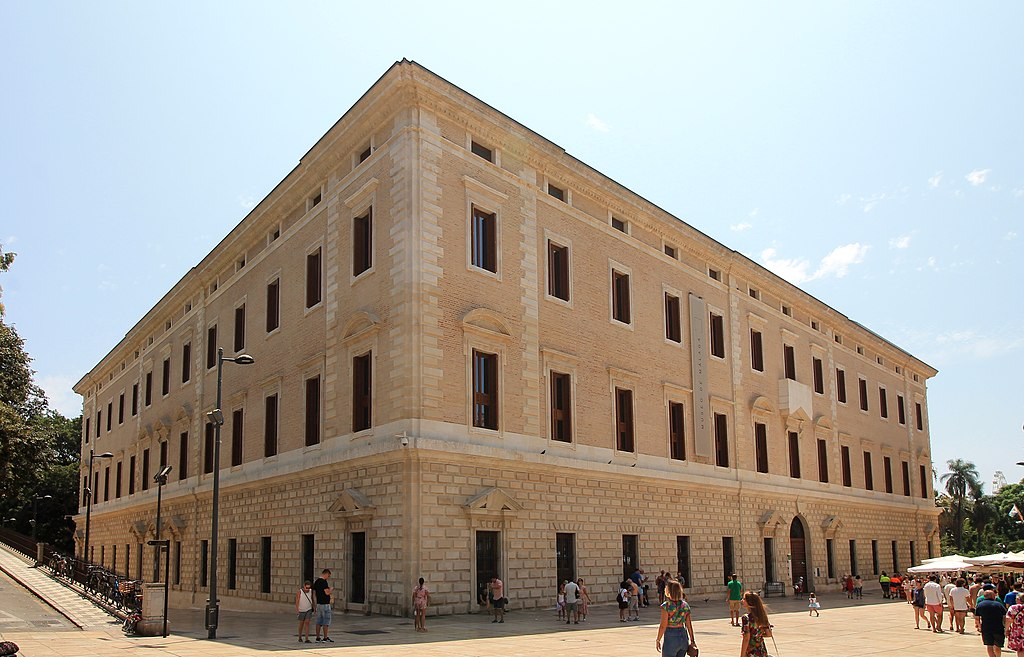
Above: Real Academia de Bellas Artes de San Telmo, Málaga
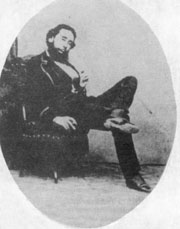
Above: Spanish painter Bernardo Ferrándiz (1835 – 1885)
In 1875 he returned to Rome where he stayed two years.
Upon his return to Málaga he was already an established painter:
He decorated the Palacio Heredia (Palace of Heredia), exhibited his paintings (drawings, watercolors, oil paintings) with great success and taught classes as a teacher at the School from 1887.
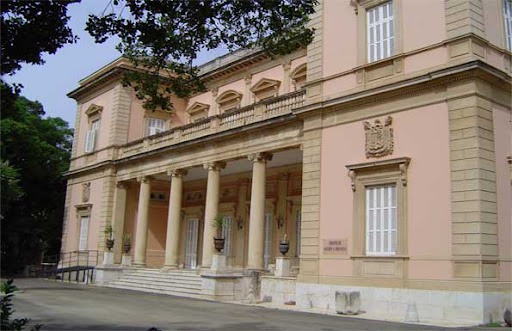
Above: Hotel Palacio Duque de Heredia, Málaga
He died in his hometown and is buried in the San Miguel Cemetery.
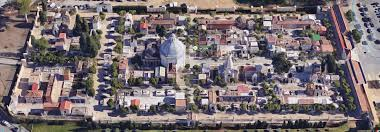
Above: Cementerio de San Miguel, Málaga
The Museum of Fine Arts of Málaga preserves some of his works.
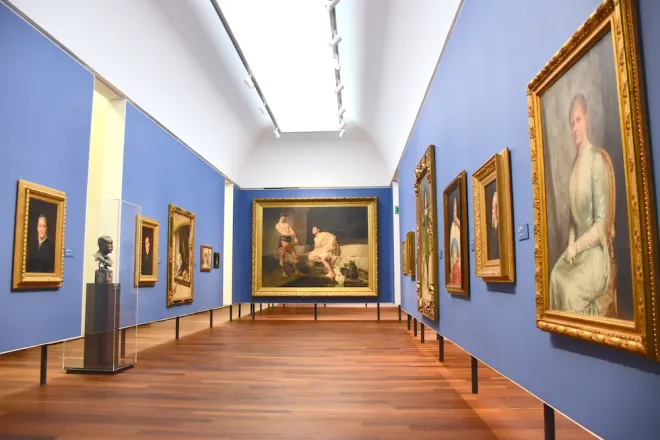
A street and a public education center in Málaga are named after him.
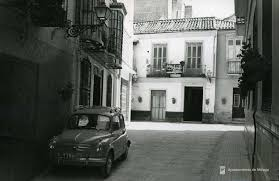
Above: Calle José Denis Belgrano, Málaga
“The coming extinction of art is prefigured in the increasing impossibility of representing historical events.“
Theodoro Adorno
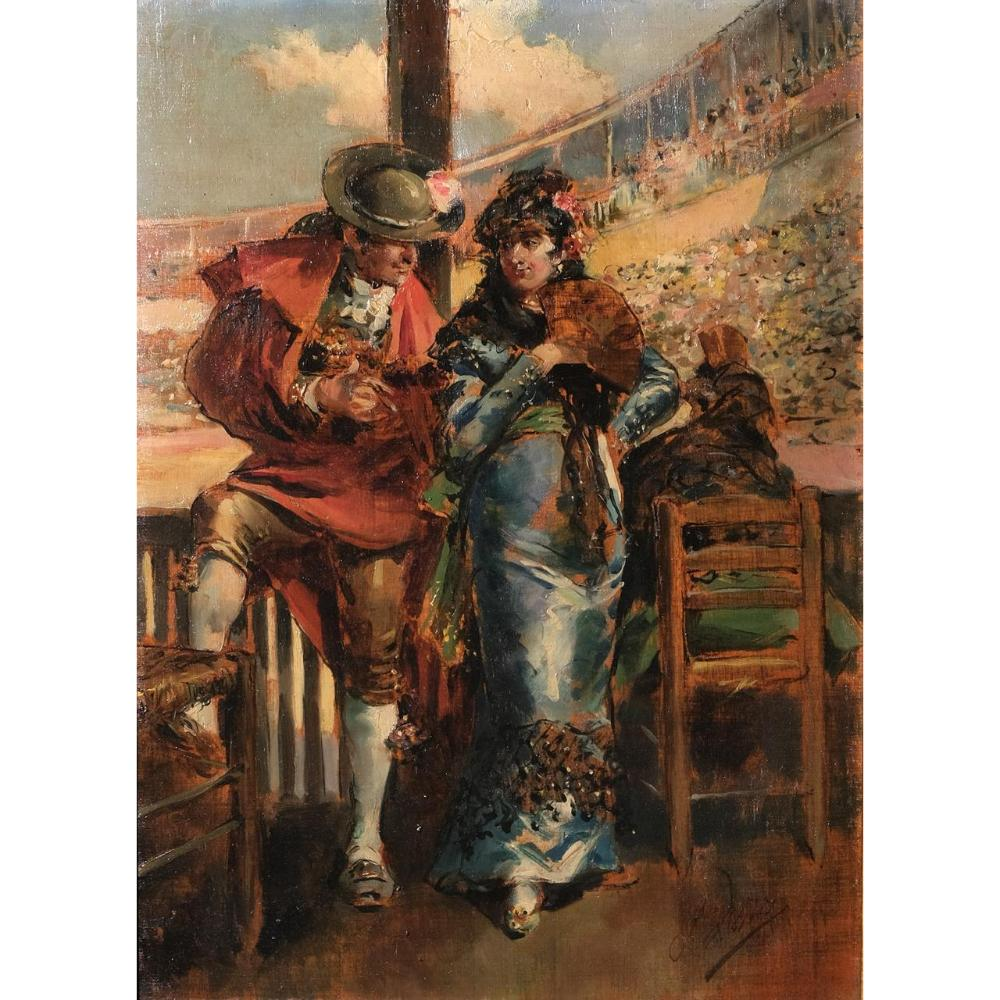
Above: Galanteo, José Denis Belgrano
There are times when we learn a lesson from something that happened to us or reach a conclusion about something we have been pondering.
The very effort of trying to compose a few lines about the art of Málaga might be my best path to understanding it.
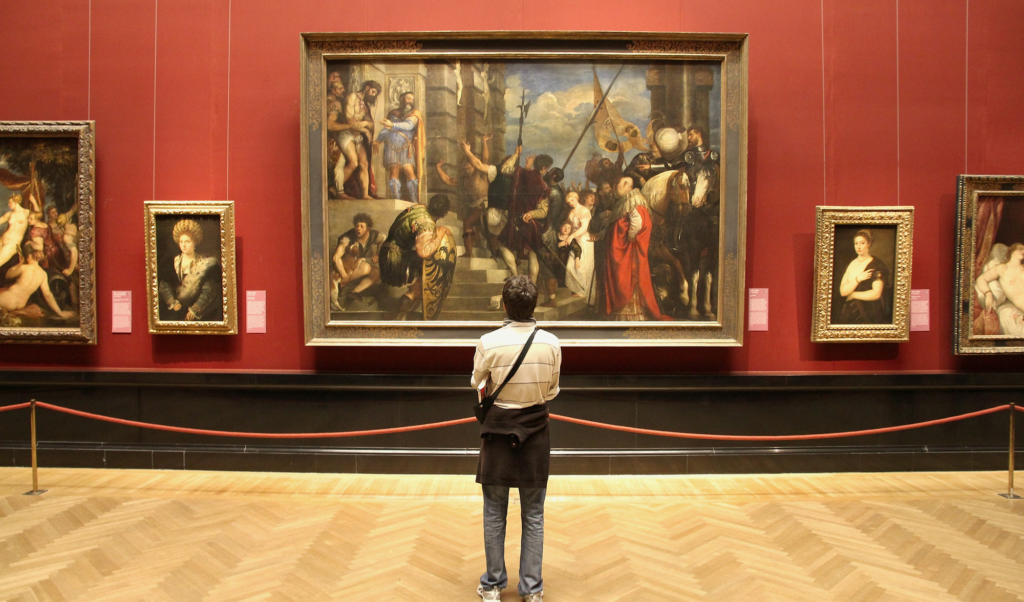
To study the art is to examine the artist.
Each acquired expertise by applying what they learned through experience.
I think of Picasso who like his compatriots and predecessors showed curiosity in the world, though where he failed on a personal level was forgetting the humility that life’s lessons tried to impart.
He failed to manage his personal life despite how good his performance was as an artist.
He achieved world fame but whether he was truly happy in his private life seems uncertain.
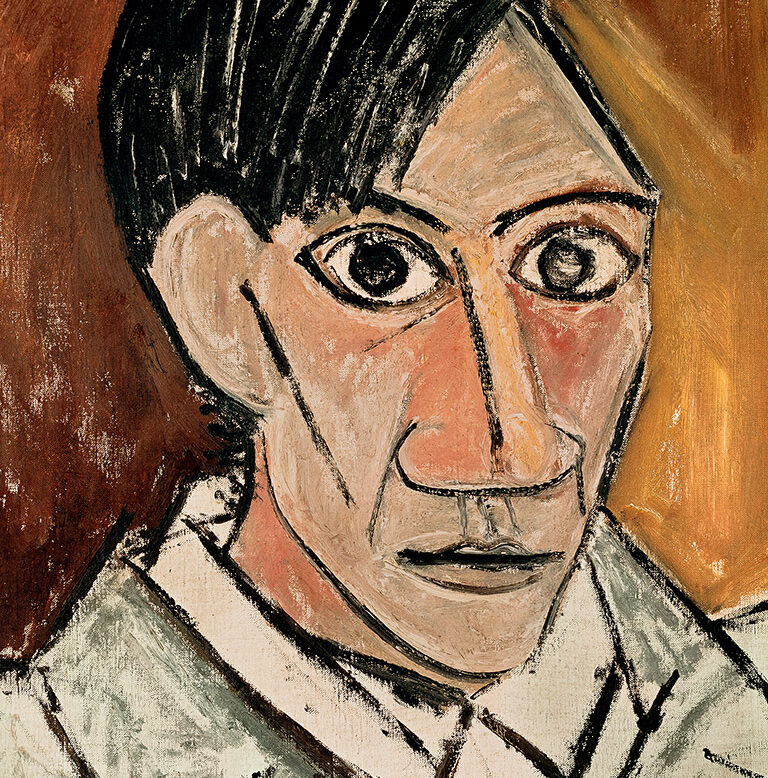
Picasso, like the other artists of Málaga mentioned here, had two qualities that I respect regardless of the kind of private man he may have been.
They had perseverance:
The drive to advance resolutely towards a goal in mind,
They faced failure fearlessly.
They pushed forward no matter what.
They were stopped by nothing.
They maintained their courage.
They pursued their goals with patience and strength of purpose.
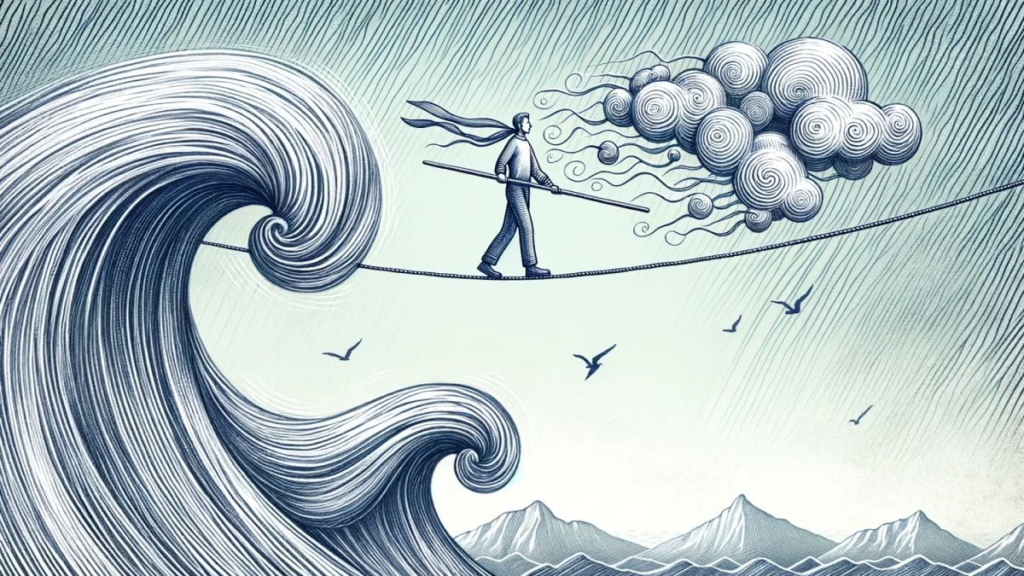
Passion is what made them pursue their goals with perseverance.
Their drive to do, to create, something new, was a deep desire within them.
They worked work and persevered.
Perseverance was their sails.
Passion was their wind.
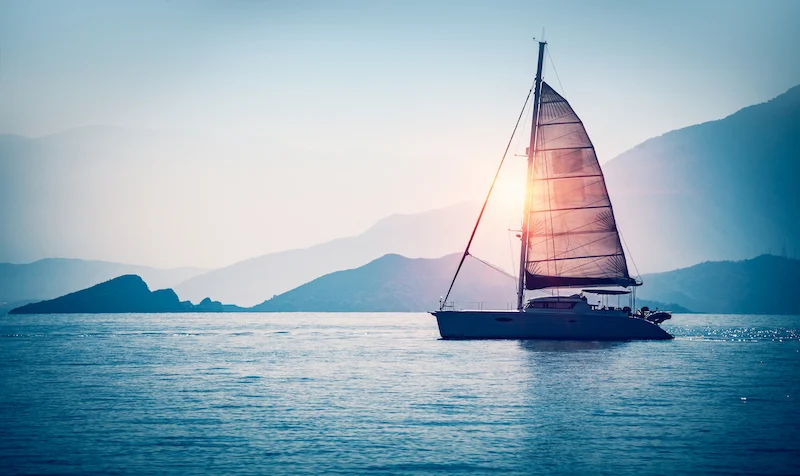
To honour the artist is to become an artist in the manner in which we honour him.
I cannot claim to fully understand all the art that I have seen.
I can only say that seeing art makes me glad I am alive to see it.
By travelling, by reading and through writing, I discover my passion.
By being curious, by believing and living as though everything around me merits my curiosity, my discovery, my analysis and study.
Let the world teach me as I humbly try to teach the world.
Let us leave the final word to Albert Einstein:
“I have no speacial talents.
I am only passionately curious.“
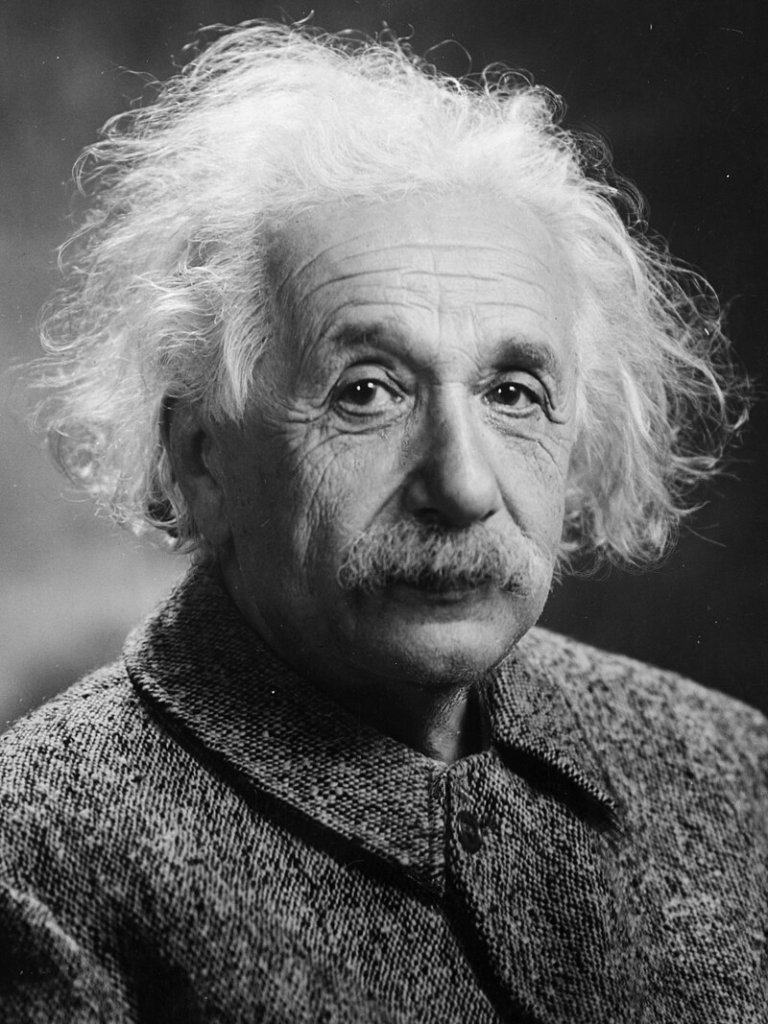
Above: German physicist Albert Einstein (1879 – 1955)
Sources
- Wikipedia
- Wikiquote
- Google Images
- Bulent Eczacibaşi, Just to Keep in Mind
- Lonely Planet, Andalucia
- Thomas Schröder, Andalusien
- The Rough Guide to Spain
- Art Day by Day, edited by Alex Johnson